13 things to know before visiting Italy

May 16, 2023 • 9 min read

Make the most of your trip to Italy with our top insider tips © Westend61 / Getty Images
With an unmatched abundance of Unesco World Heritage sites, diverse scenery ranging from some of Europe’s highest peaks to the turquoise waters of the southern coasts, and an endless list of regional cuisines to taste, planning an Italian adventure can easily get overwhelming.
Add a variety of dialects – both spoken and hand-gestured – and hard-to-decipher etiquette rules into the mix and attempting to dive into the local culture can quickly turn into feeling like a fish out of water.
Returning to Italy after years of living abroad has made many of the odd rules that dictate social interactions more evident to me – even I, as an Italian, find myself often questioning why things work as they do. While clear answers are not always available, I’ve done my best to compile a list of rules, customs and habits that will make every visitor's time in my homeland a little easier. Here's everything you need to know before visiting Italy.

1. Italians all go on holiday at the same time (more or less)
For some reason, we Italians have collectively decided that August is the best month to go on holiday. It's understandable – with temperatures regularly surpassing 35C (95F), expecting people to do anything other than lie on the beach is simply too far-fetched.
During the weeks surrounding the holiday of Ferragosto , on August 15, Italians migrate to the coast en masse, leaving humid cities half empty. Many businesses in the country’s interior close, prices rise significantly, and crowds are the norm on popular beaches. If you choose to travel in the high season , make sure to book your accommodation well in advance.

2. Italy was built for driving, but it’s not the only option
While the public transport infrastructure is cheap and mostly reliable , Italy remains devoted to driving. Recent stats have shown that the country is second in Europe after tiny Luxemburg when it comes to cars per capita – nearly 40 million vehicles are currently roaming around the country with 59 million inhabitants.
Part of this has to do with the mountainous, uneven geography of the peninsula. Trains cannot reach the more remote corners of the country and the low population of rural areas does not justify frequent bus services. There is also a cultural aspect to Italy’s love for driving – huge investments were put toward motorways in the post-war era, which made mobility increasingly car-centric and Italians more used to relying on cars.
Does this mean that a car is essential for visiting Italy? No. Renting a car will give you the most freedom, but trains and buses connect most urban centers and are a great, sustainable way to visit cities, medieval hamlets and coastal towns without worrying about traffic rules and limiting your intake of vino and spritzes. Train tickets can be bought online at Trenitalia or Italo – tickets for slow, regional trains can be purchased on the spot without price increases, while high-speed train tickets are much cheaper when bought in advance.
3. If you do rent a car, be aware there's a shortage of vehicles
Among the many inconveniences the pandemic has brought upon travelers is a lack of available cars for hire. As the world went into lockdown and traveling became impossible, many rental companies sold their vehicles. Meanwhile, people got increasingly used to avoiding public transport and the demand for rental cars has grown.
During peak holiday season, prices skyrocket and in popular destinations, cars for hire can simply run out. If you are planning a road trip , make sure to book your car well in advance.
4. Card payments are now widely accepted, but carrying some cash is a good idea
For a long time, Italy has been a cash-first country. But in 2022, a new law introduced a fine for businesses not accepting card payments. Technically, paying by card should now be possible everywhere, although you can still encounter merchants frowning upon small electronic transfers or shops where the POS machine is mysteriously not working – having some cash on you is a wise move.
Apart from such (rare) exceptions, card payments will not be an issue. Most major networks are widely accepted, American Express is the only card provider that might be rejected by smaller businesses.
5. Regional pride is worth embracing
Moving abroad or to a different city has become increasingly common for members of the younger generations, but a sense of pride for one’s place of birth continues to pervade the consciousness of many Italians. You won’t have to wait long before meeting someone who will exalt the food, traditions, and landmarks they grew up surrounded by, often at the expense of neighboring regions or cities.
Such an intense form of pride – known in Italian as campanilismo – translates into endless opportunities to taste carefully guarded flavors, participate in events rooted in the local folklore, and experience a different facet of the country each time you come back.

6. Learn the language of sarcasm
On the one hand there is local pride, on the other is the art of breaking down barriers by making fun of ourselves. Italian humor has long been reliant on a self-inflicted form of sarcasm and the exaggeration of those very stereotypes you’d think we’d rather forget about.
Self-deprecation is only one shade of it, however. When jokes are directed at others, they can be ferocious. In regions such as Veneto or Tuscany, blasphemy is considered part of the local lingo, while Romans are unchallenged when it comes to sharp irony. To the uninitiated, such wit may feel like crossing a line, but it’s usually well meant.
7. Imitate hand gestures 🤌 at your own risk
Italians are globally known for talking with their hands, but they don’t particularly enjoy having their body language mocked by foreigners who are not aware of the meaning behind physical communication. Hand gesturing does not happen randomly; while a burst of anger or excitement may get people moving more intensely than usual, each signal has a specific meaning that – like in any language – should be learned before being inserted into a conversation.
Shaking your hand while pinching your fingers, for instance, is typically used in combination with a puzzled look to mean “What are you talking about?” or “What are you doing?” with a tone that can range from the confused to the aggressive. Use at your own risk.

8. Don’t be overwhelmed by restaurant menus
Enter any osteria and you’ll find yourself deciphering a list of dishes split into categories such as antipasti (starters), primi (first courses), secondi (second courses), contorni (side dishes), dolci (desserts), vini (wines), amari (digestives). Yes, a full Italian meal is composed of all these elements.
You are not expected, however, to order a dish from each section of the menu every time you sit down. It’s perfectly fine to order a pasta course followed by a dessert, or a starter and a second course. Mix and match as you like.
9. Tipping is not expected unless the service is especially personalized
Leaving a tip is always a nice gesture, but you should not feel obliged to do so in every bar or restaurant you enter. Most people in the service industry do not rely on tips to get by. However, when someone is particularly attentive to your needs and actively trying to improve your experience, it's a welcome gesture to thank them with a tip.
Note that you will be charged for “coperto” in many restaurants – a cover charge of around 2€ per person. This is neither a scam nor a tip that goes to the staff. It is simply a flat fee that Italians are used to paying when sitting down at a table.
10. When it comes to eating and drinking, there is a time for everything
Everyone has heard of the “no cappuccino past 11 AM” rule – you should know that this is not the only dieting constraint Italian culture is attempting to force upon you. Milky coffee is considered a breakfast-only drink, just like an Aperol Spritz is considered a pre-dinner cocktail and limoncello is considered a post-prandial liqueur. Lunch happens around 1pm and dinner hardly ever starts before 8pm.
Such habits are often described as commandments set in stone, but know that the emphasis on their importance is often exaggerated. Not following the etiquette might be looked down upon at a formal gathering, but in cities where tourists are a permanent presence, exiting the boundaries of social conventions won't raise many eyebrows.

11. Drinking outside is allowed – and fun
While there are some municipalities that restrict drinking alcohol on the street in certain areas, this is not an issue in most of the country. On the contrary, many public squares fill up during summer evenings with people having a beer or a glass of wine in the open-air.
12. Cheek kisses can cause some awkward situations
Imagine meeting up with your Italian friends for an aperitivo and finding yourself lip-to-lip with your new acquaintance’s spouse – this is only one of the embarrassing situations you could fall prey to by underestimating the cheek kissing etiquette.
Italians often greet each other by giving two light cheek kisses. This happens almost exclusively in informal situations with people you’ve already met in the past – you are not expected to kiss your Italian language teacher or someone you’re being introduced to for the first time. People will typically start on the left side, although this is not a strict rule. If unsure, let the other person take the lead and go with the flow. Not comfortable in having your personal space invaded? A simple handshake is perfectly fine.
13. Political polarization is on the rise
Contrasting political views have always played a central role in the animated conversations of Italians, both in the private sphere and in the media. In recent years, however, polarization has become more evident. Part of this has to do with political conversations moving onto social media platforms where nuances and context fade away, favoring stark opinions over constructive debates. But this is far from the only reason.
A 2022 study showed that Italy is the only European nation where salaries have decreased compared to 30 years ago and conflicting opinions on issues related to migration flows, energy supplies, housing and workers’ rights have contributed to splitting the public opinion. In 2022, Italy elected Giorgia Meloni as its Prime Minister – the first woman to hold power and the first far-right leader since Fascist-era dictator Benito Mussolini. The ability to read the room is a useful skill to have if you choose to talk politics.
Explore related stories

Tips & Advice
Aug 13, 2024 • 9 min read
With homemade pasta, every type of pizza, wines aplenty and cheese (lots of it), Italy is a whole world of as–mamma-would’ve-made-it yum.

Aug 7, 2024 • 10 min read

Jul 31, 2024 • 5 min read

Jul 25, 2024 • 13 min read

Jul 16, 2024 • 5 min read

Jul 10, 2024 • 7 min read

Jun 13, 2024 • 8 min read

May 28, 2024 • 9 min read

May 24, 2024 • 4 min read
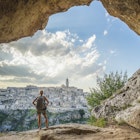
May 4, 2024 • 4 min read
9 tips for beginners visiting Italy for the first time

Planning your first vacation to Italy ? Not only is this beautiful country one of the top culinary destinations in the world, but it's also home to some seriously iconic tourist attractions to boot. With over 55 UNESCO World Heritage sites, three active volcanoes and over 1,500 lakes, you'll never get bored. And if you are, well, there's always pizza!
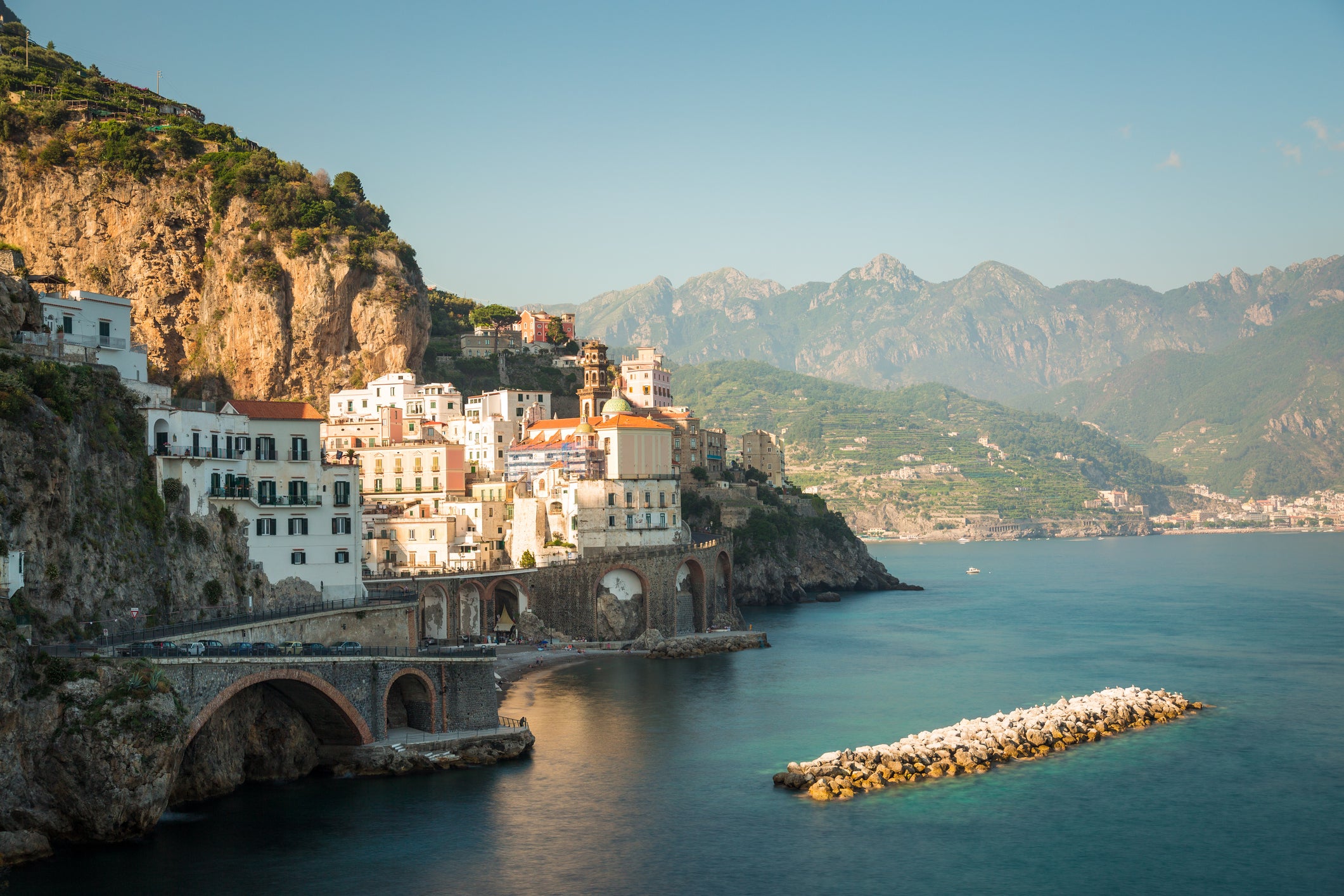
When organizing a vacation to Italy, there are a few things you should know in order to have a safe and enjoyable getaway. First-time travelers take note: these are some of the things you consider for your Italian adventure.
1. Figure out what kind of trip you want to have
Italy's got it all: 4,600 miles of coastline lined with hundreds of gorgeous beaches , numerous tourist attractions, lively cities, charming villages and sprawling vineyards. From low-cost to luxury, Italy has accommodation, restaurants and activities to fit every budget, whether it's renting a yacht off the coast of Capri, staying in an affordable hostel in Rome or enjoying a Sicilian farmhouse getaway.
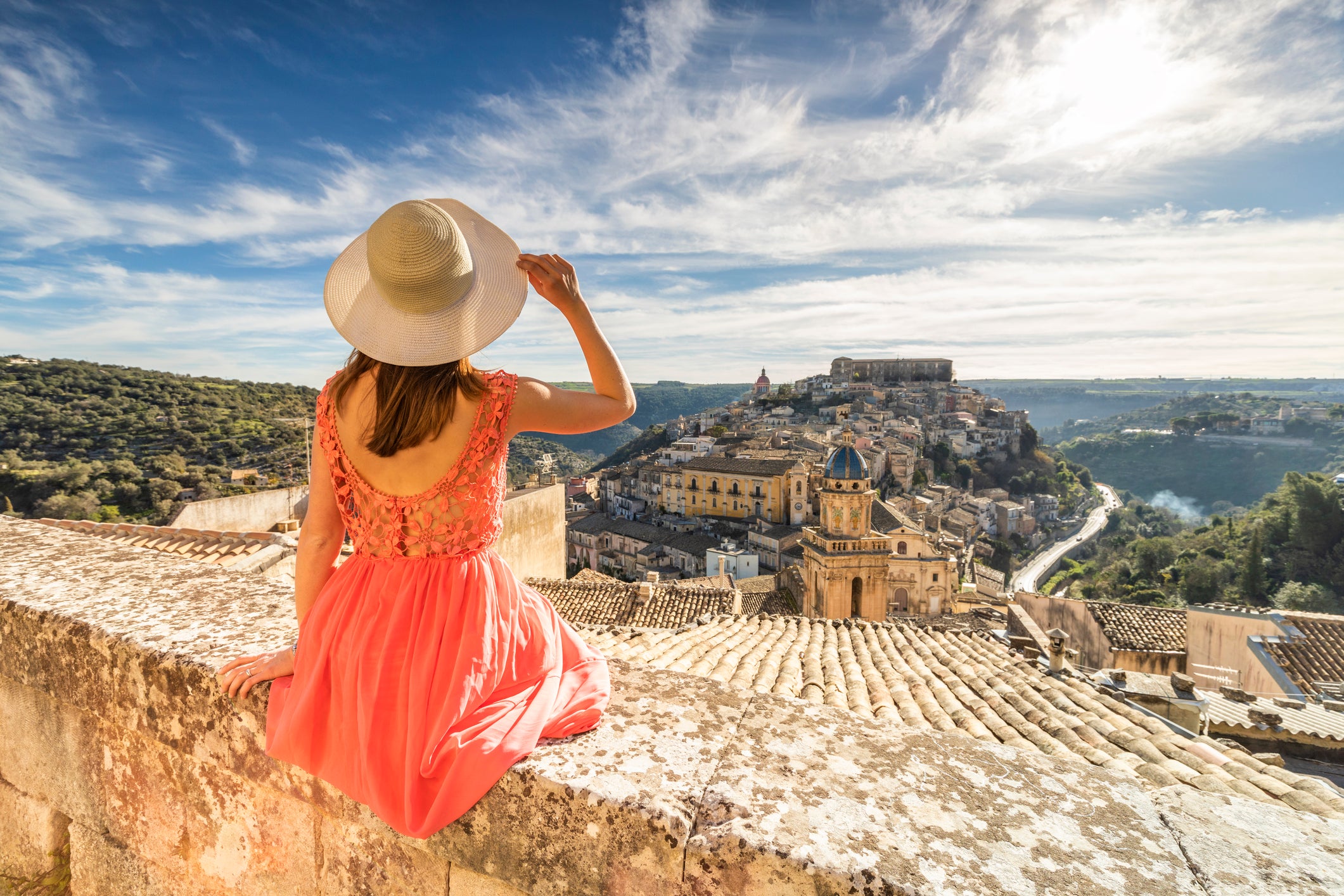
Consider your interests, as well as some of the things Italy is famous for, like gastronomy (you could build a trip around dining out or cooking classes), art (Italy has some of the top museums in the world) or exploring a wine region (drive through the hills of Prosecco or Tuscany's wine country).
Related: How to have a budget vacation in Italy
Or, think about destinations. For each week you have of vacation , you can comfortably squeeze in two destinations (maybe more if you're a very active traveler).
- If you love art and tourist attractions, consider Rome and Florence.
- If you love fashion but also want to relax, consider Milan and one of the northern lakes.
- If you want pizza, cityscape and coastal charm, consider Nap les and the Amalfi coast.
- If you want to dig into Italy's food and wine scene, consider a road trip through Tuscany or Piedmont.
- If you love skiing , consider a visit to Milan and the Italian Alps.
- If you're looking for romance, consider exploring Verona and Venice.
- If you need a beach vacation, consider exploring an island like Sardinia or Sicily.
- If you have 10 days or more and want to enjoy the most typical tourist circuit, consider a trip to the big three: Rome, Florence and Venice -- some of the country's most popular spots for visitors.
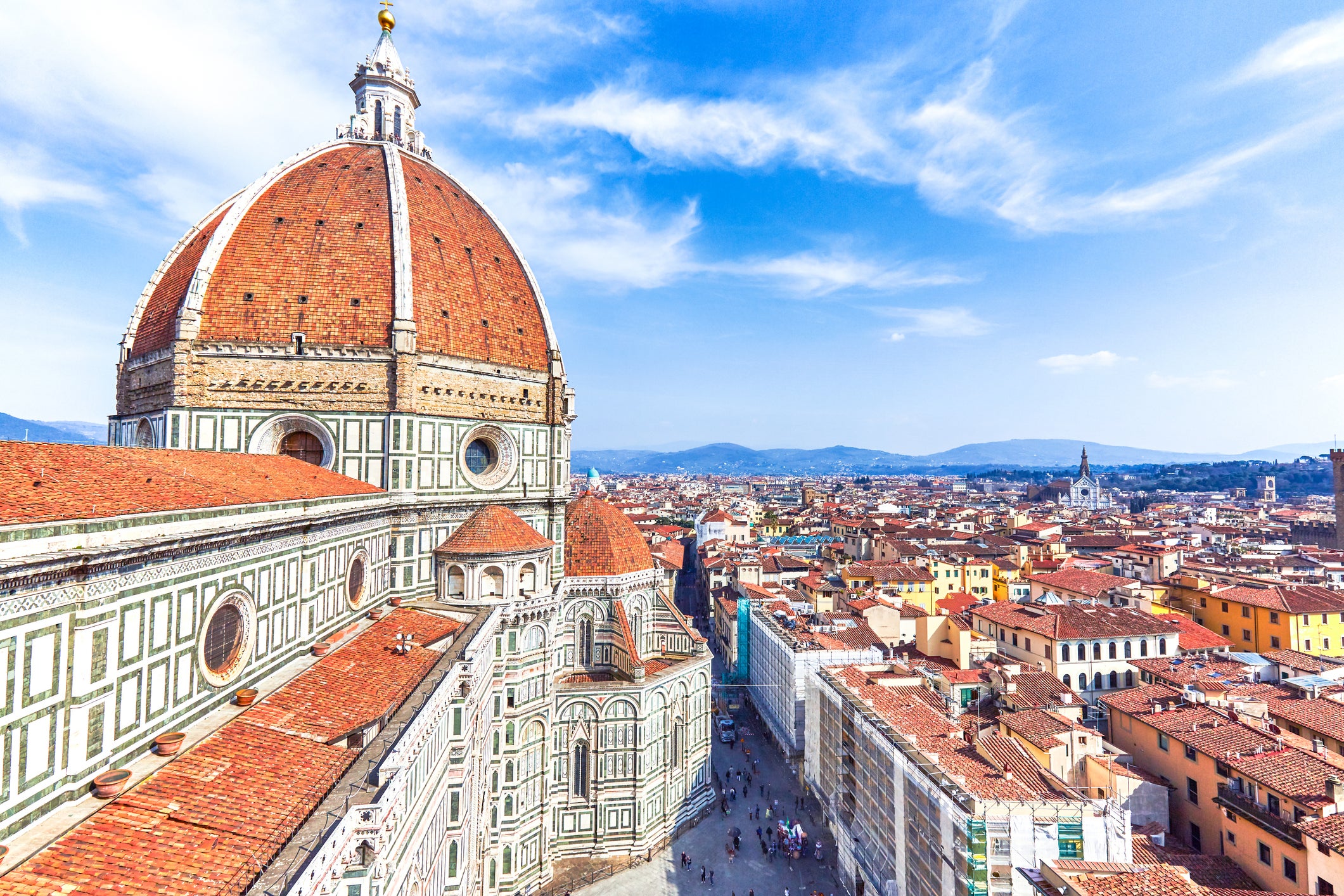
Note that while you can find various price points around the country for lodging, dining and activities, typically, costs are lower in southern Italy than in northern Italy.
Related: Northern or southern Italy: Which is right for your vacation?
2. Pick the right season
In general, Italy has wonderful weather. Many areas of the country see lots of sunshine and temperatures are mild even in winter, though summers can be steamy. Depending on what you plan to do, make sure to consider the season. Beach visits are best in the summer, though months like May and September see fewer crowds and still have great weather.
Related: These are the best times to visit Italy
Avoid larger, crowded cities like Rome in the heart of summer, unless you're prepared for extreme heat. Harvest season/autumn is the ideal time to visit the wine region, and southern Italy can be mild throughout the winter. Many deals can be found in the low season, but know that winter in the north can be cold and rainy.
If you do go to Italy between March and October, bring sunblock and a hat -- don't underestimate those Mediterranean rays.
3. Do your research when it comes to tourism
Although Covid-19 has put a dampener on tourism, during busier times, attractions like the Vatican may see up to 30,000 visitors per day. That means you may have to wait a long time in line to buy a ticket and enter. Add Rome's scorching sunshine to the mix and you may end up sunburned, exhausted from queuing all day and never get the chance to step foot in the Sistine Chapel.
If visiting big-name tourist attractions is important to you, buy tickets online. Skip-the-line tickets or guided tours may also be worth the price: evaluate your options and decide.
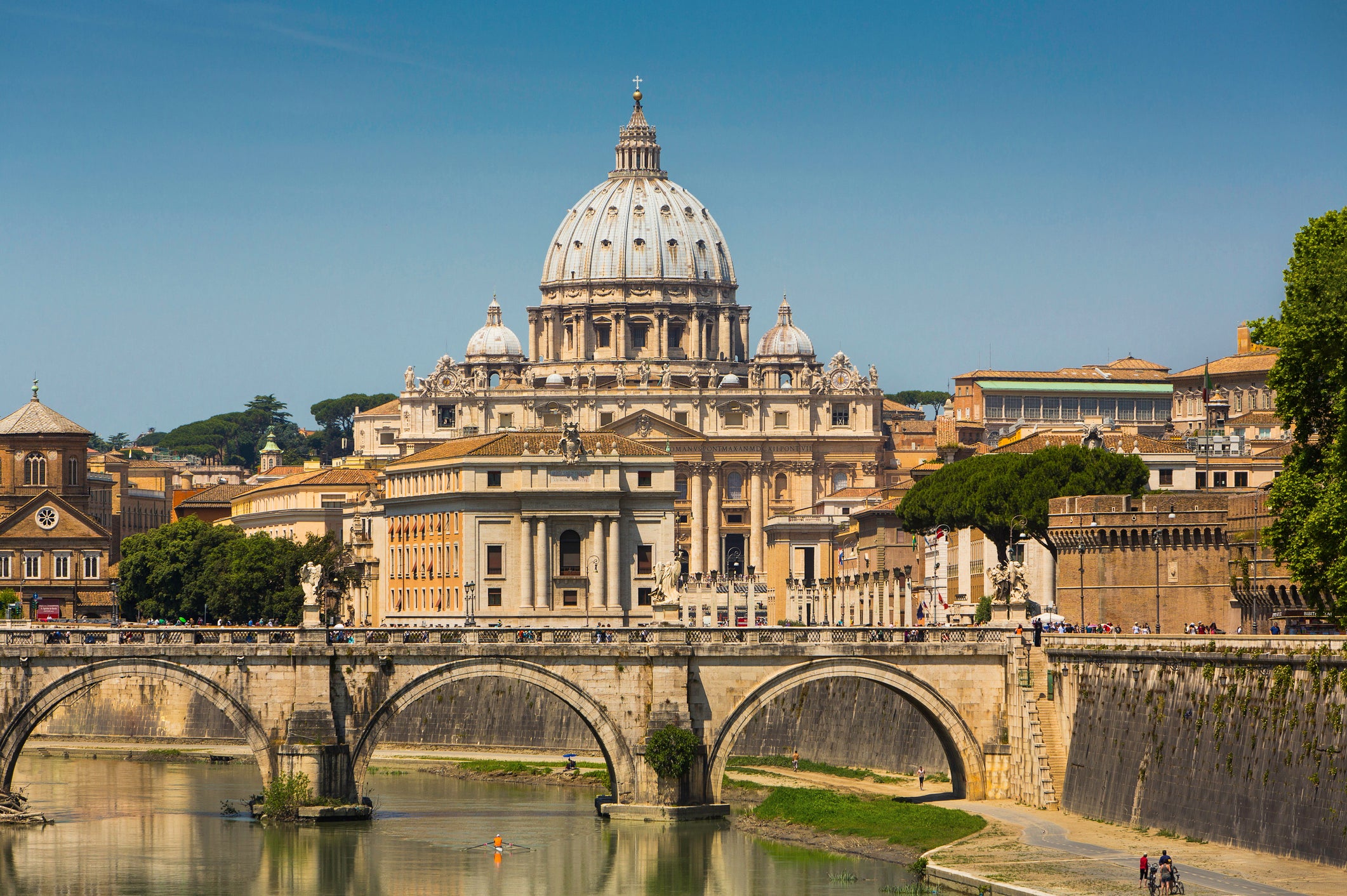
City passes are another alternative. The Milan city pass offers things like discounts on popular attractions, free Milan public transport and a free drink at a local Milanese bar. The Rome tourist card has fast-track entry benefits and free access to the Vatican and the Colosseum. Florence's city pass includes skip-the-line entry to Galleria degli Uffizi and Galleria dell'Accademia, plus tickets for the hop-on, hop-off bus tour.
So, think about what you want to do and see, do the maths and purchase ahead.
4. But don't forget about local spots too
Visiting Italy's most famous attractions should hold a firm spot on your bucket list. That being said, plan to take some time to get off the tourist track a bit. Consider exploring more local neighborhoods or visiting a small village or a less-popular spot like Lake Maggiore instead of Lake Como. Seeing all the big-name hotspots is a must, but experiencing the beauty of true Italian culture and cuisine may be even better.
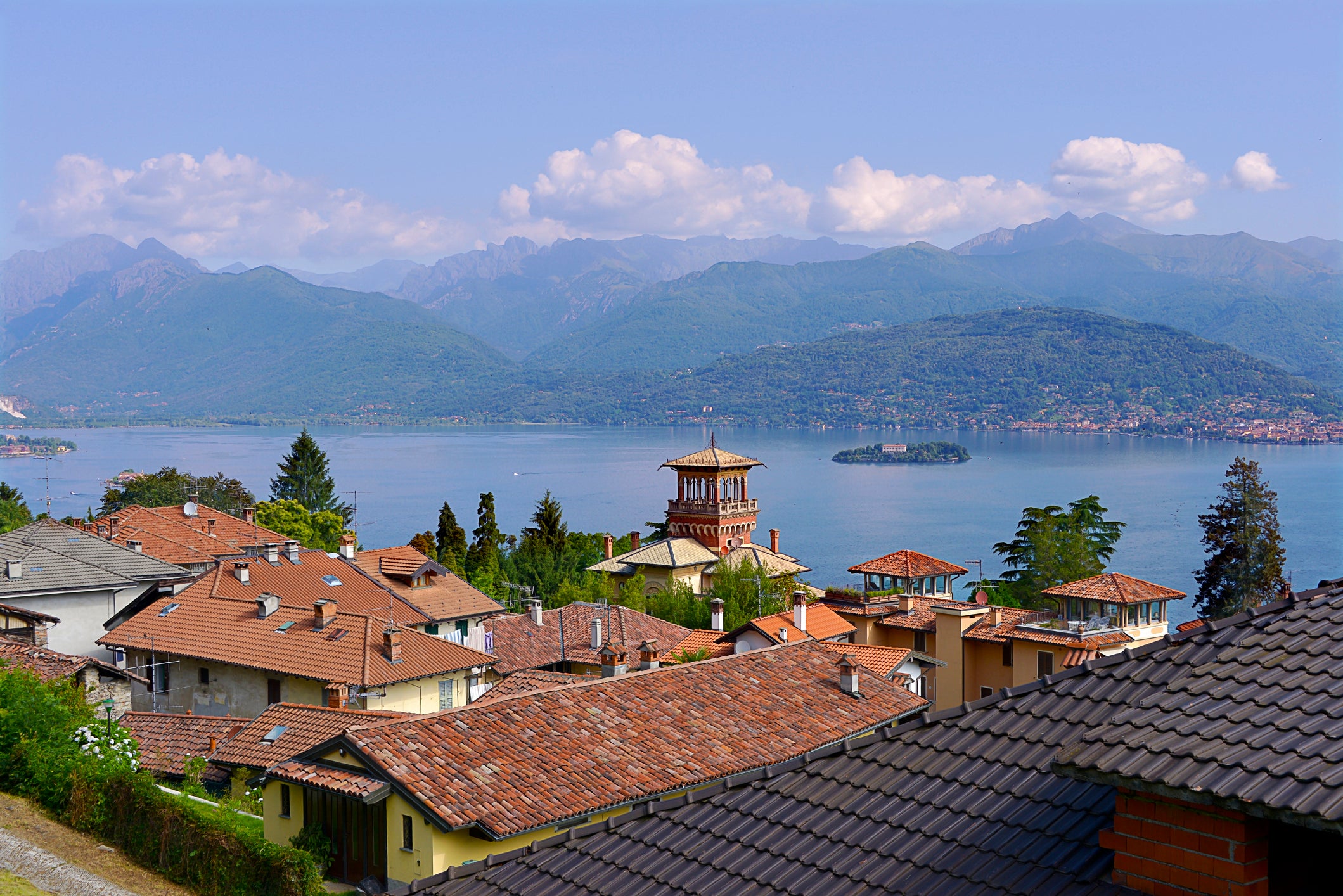
Related: 5 of Italy's best-hidden gem cities
5. Take the train
The Freeciarossa runs between some of Italy's best destinations. These high-speed trains from company Trenitalia are affordable, fast and comfortable. Traveling up to about 180 miles per hour, trains are one of the best and quickest ways to get from A to B. And, you won't have to deal with learning the Italian rules of the road or the hassle of car rental agencies. Taking the train is easy: You can purchase tickets easily online ahead of time or last minute depending on your travel style. You can visit spots like Milan, Rome , Florence, Venice, Turin and Naples on the Frecciarossa trains.
6. Don't discount the islands
Italy's island culture goes beyond just the beach. And, there are over 450 of them! Sicily has a whole sub-culture of its own, and far-flung spots like the Tremiti islands or the Aeolian islands will ensure you get sufficiently off-the-beaten-path . If it's luxury you desire, Sardinia's Costa Smeralda is a hotspot and nothing looks sexier on an Instagram feed than Capri.
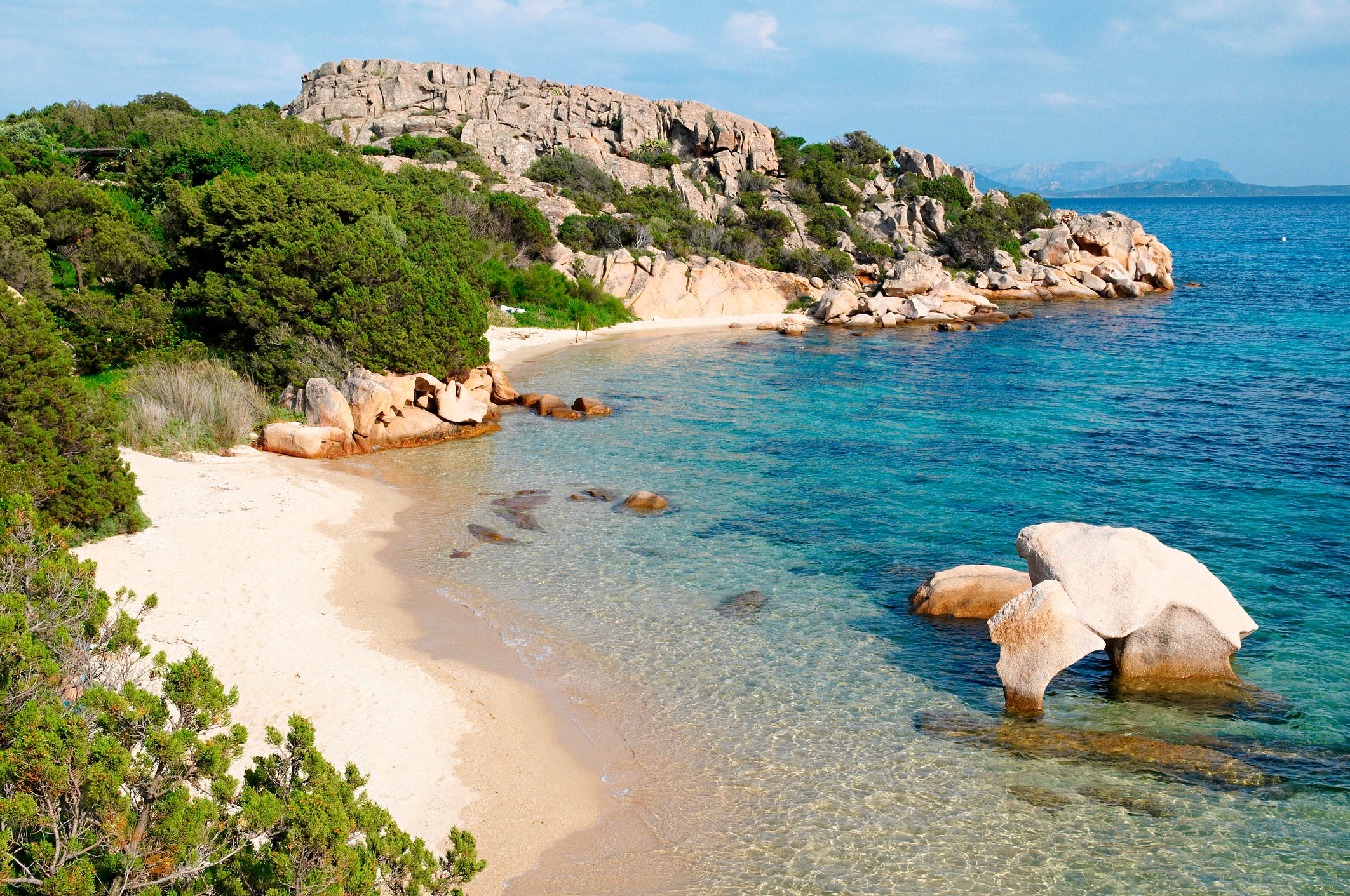
Related: Which of the Italian islands is best for your vacation ?
7. Familiarize yourself with the language and culture
You might get lucky when it comes to a larger city like Rome, where many locals speak English.
Southern Italy or smaller villages are a different story. Luckily, Italians are a friendly bunch and will do their best to communicate with you despite any language barriers. Come prepared with a few key phrases and your favorite translation app downloaded.
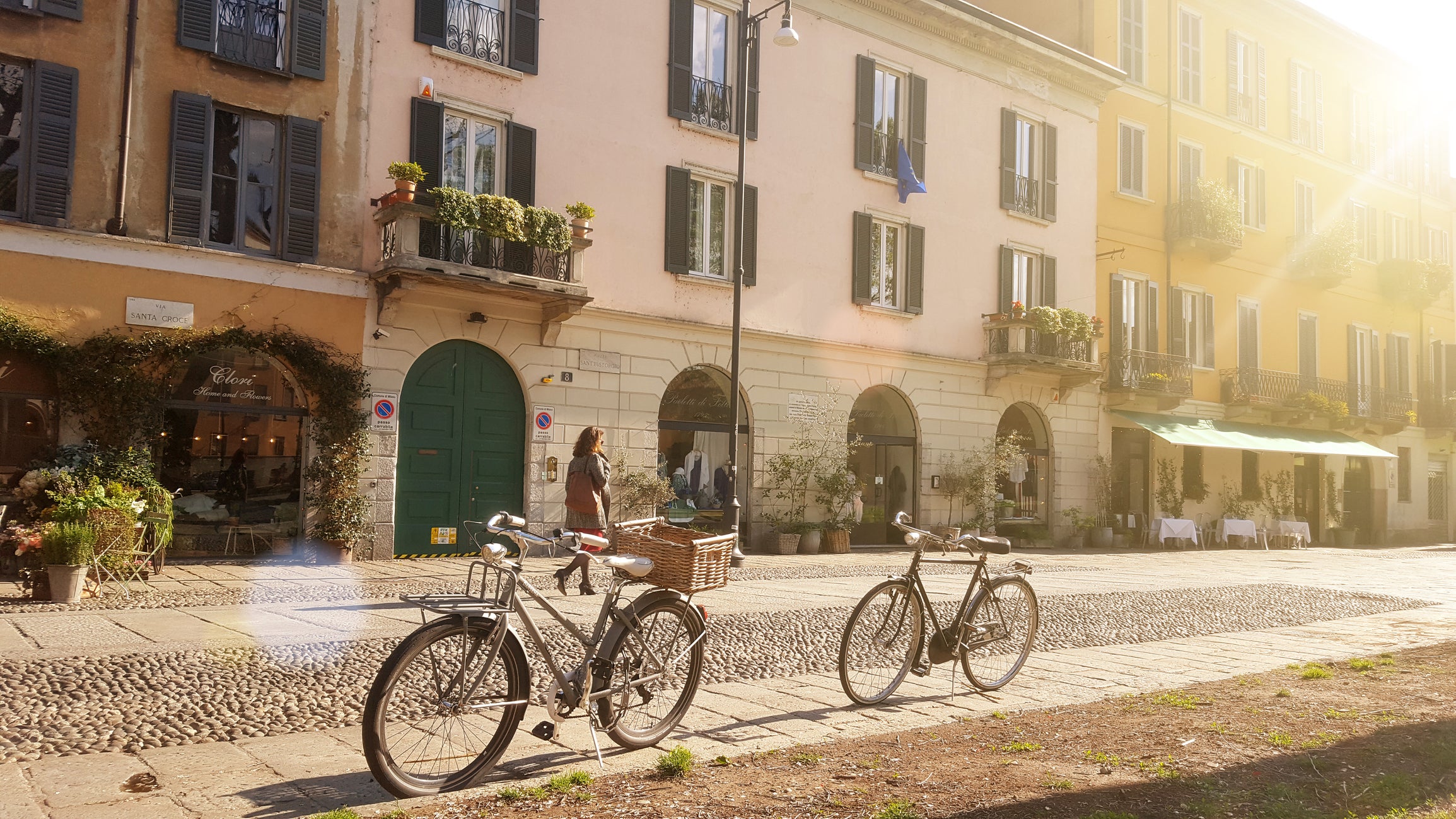
Italy is old, and so are its streets. Many are made of cobblestone. While locals (Milan, here's looking at you) may jog by in designer stilettos, you should wear comfortable footwear. Make sure to dress modesty, especially when visiting churches. You won't be allowed into spots like Vatican City if your knees and shoulders aren't covered.
While mealtimes aren't quite as late as Spain's, Italians tend to eat slightly later. Expect lunch around 1:00 p.m., and dinners around 8:30 p.m. or 9:00 p.m.
8. Money-saving tips
While it's normal to make a tourist faux pas or two (especially on your first trip), here are some things you should avoid:
- Tipping at restaurants if it's already included on your bill (many spots add in a 10% service charge).
- Heavily tipping taxi drivers (rounding up to the nearest euro is normal).
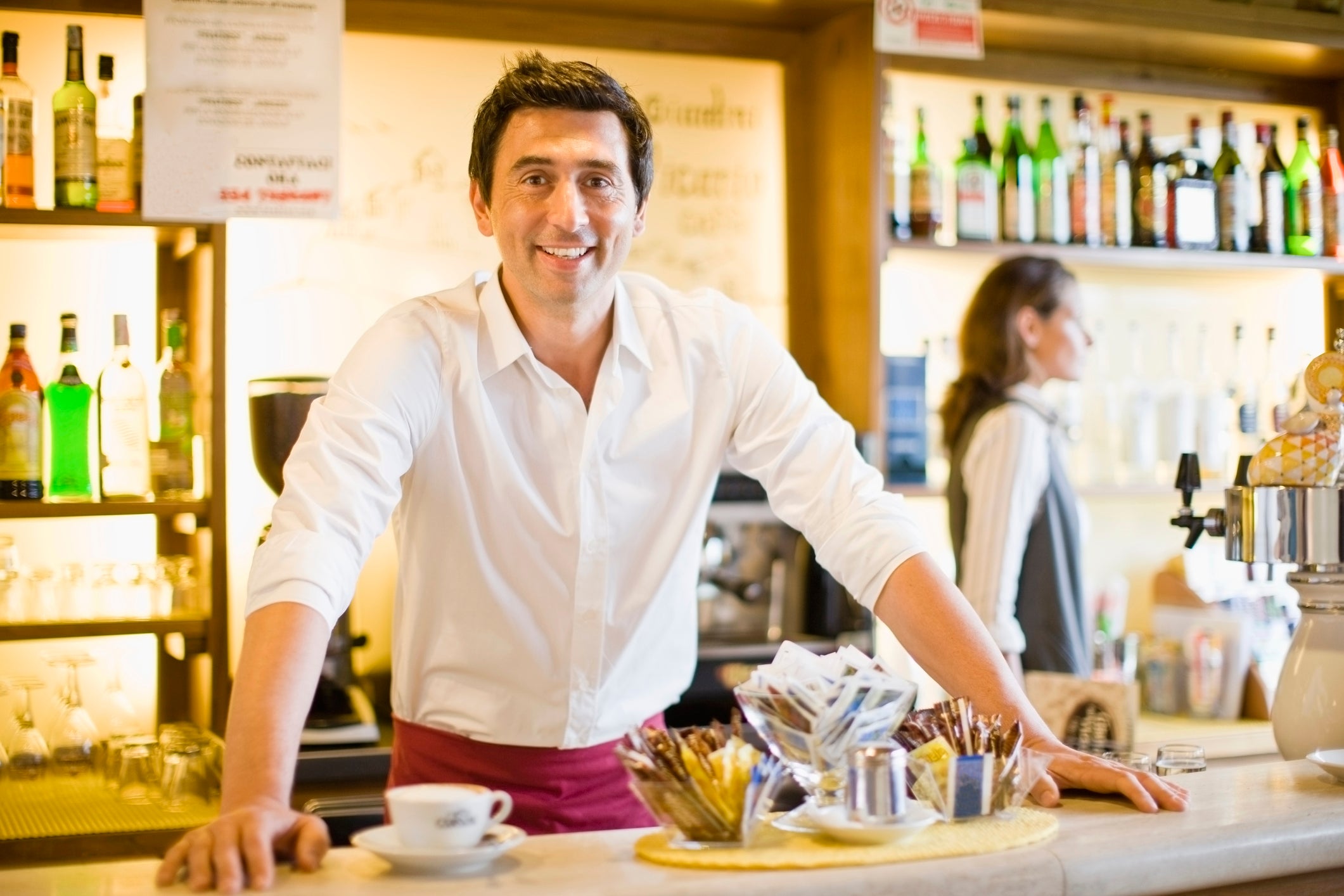
Save even more money with the following:
- Take advantage of apertivo hours in northern Italy. These are happy hours that offer free buffet food for a few hours pre-dinner time in the early evening. Order a drink or two to gain access to the snacks.
- Stand at the bar to drink your espresso. Table seating at breakfast has an additional charge, and even more if you want to eat outside.
- Beware of the "coperto." This is a service charge for simply eating at the restaurant , usually a euro or two per person.
- Don't eat or drink in the main city square. These spots are usually overpriced tourist traps.
Related: 7 underrated regions in Italy for food and wine
9. Be alert for travel scams
Watch out for those trying to take advantage of unsuspecting tourists with scams :
- Pickpockets;
- Gladiators: If you take a photo of or with them, they'll expect a tip;
- Taxi scams: Insist the meter be turned on, or make sure you're aware of any flat-rate pricing;
- Unauthorized tour guides or ticket helpers at train stations; and
- Anyone who approaches you with lavender, flowers or a pizza box. Just walk the other way.
Bottom line
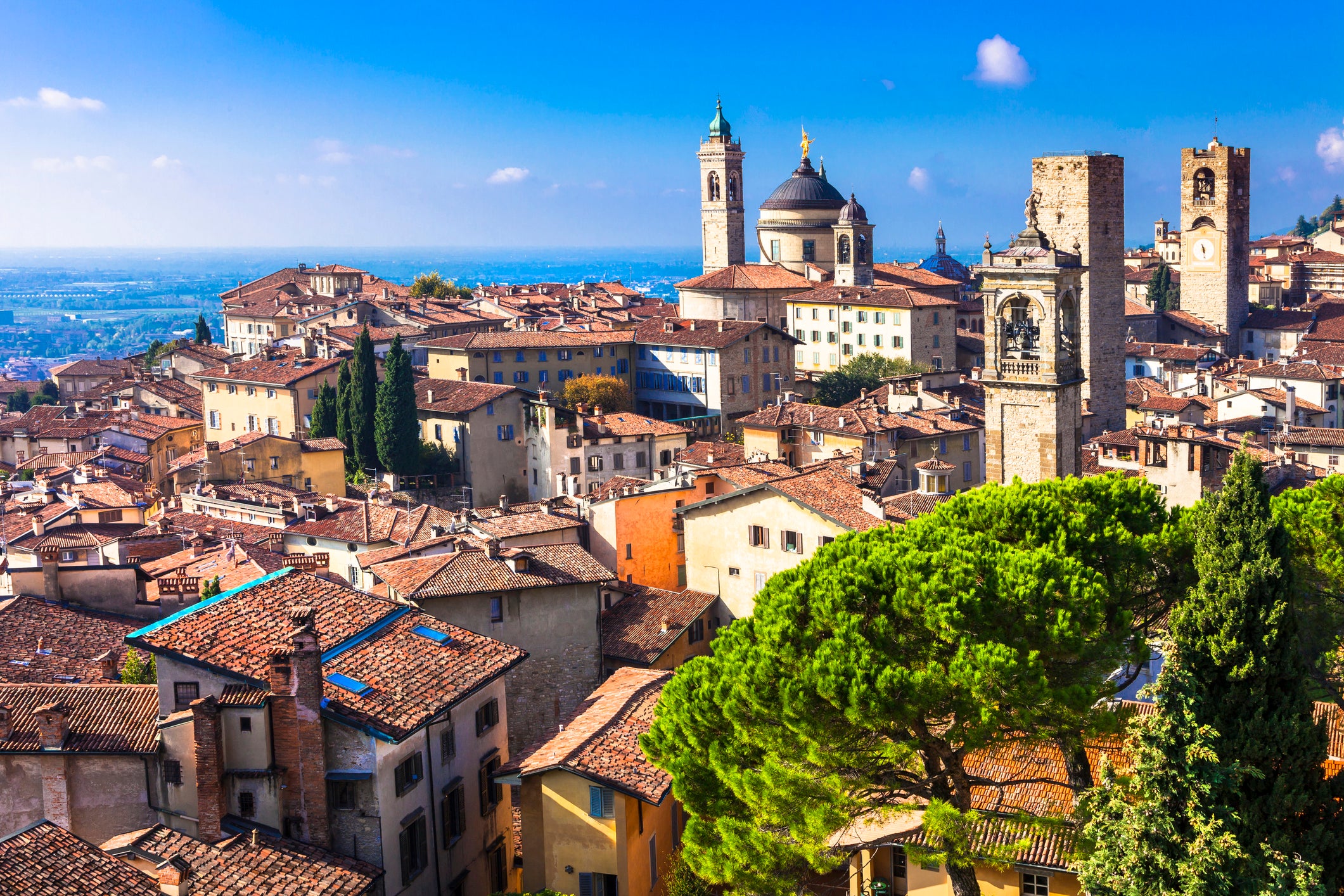
Armed with these tips and tricks, planning a trip to Italy will be easy. You can sit back, relax and enjoy all the delights Italy has to offer, knowing that you've picked the right destinations, will skip the line to see those bucket-list tourist attractions, avoid scams and save a little money on meals.
Cookies on GOV.UK
We use some essential cookies to make this website work.
We’d like to set additional cookies to understand how you use GOV.UK, remember your settings and improve government services.
We also use cookies set by other sites to help us deliver content from their services.
You have accepted additional cookies. You can change your cookie settings at any time.
You have rejected additional cookies. You can change your cookie settings at any time.
Warnings and insurance
This travel advice also covers Vatican City.
Volcanic activity
Due to volcanic activity, local authorities have increased the alert levels for both Etna and Stromboli in the south of Italy. In the event of a volcanic eruption, follow the advice of local authorities. See more information on volcanoes .
Airspace can be affected during eruptions. If you are travelling to or from Catania, during this period of heightened activity, check with your travel provider or with Catania airport .
Before you travel
No travel can be guaranteed safe. Read all the advice in this guide. You may also find it helpful to:
- see general advice for women travellers
- read our guide on disability and travel abroad
- see general advice for LGBT+ travellers
- read about safety for solo and independent travel
- see advice on volunteering and adventure travel abroad
Travel insurance
If you choose to travel, research your destinations and get appropriate travel insurance . Insurance should cover your itinerary, planned activities and expenses in an emergency.
About FCDO travel advice
The Foreign, Commonwealth and Development Office ( FCDO ) provides advice about the risks of travel, to help you make informed decisions. Find out more about FCDO travel advice .
Follow FCDO travel on Twitter , Facebook and Instagram . You can also sign up to get email notifications when this advice is updated.
Related content
Is this page useful.
- Yes this page is useful
- No this page is not useful
Help us improve GOV.UK
Don’t include personal or financial information like your National Insurance number or credit card details.
To help us improve GOV.UK, we’d like to know more about your visit today. Please fill in this survey (opens in a new tab) .
Travel Tips
- Attractions
- Things to do
- Food & Wine
- Art & Culture

Rest of the world
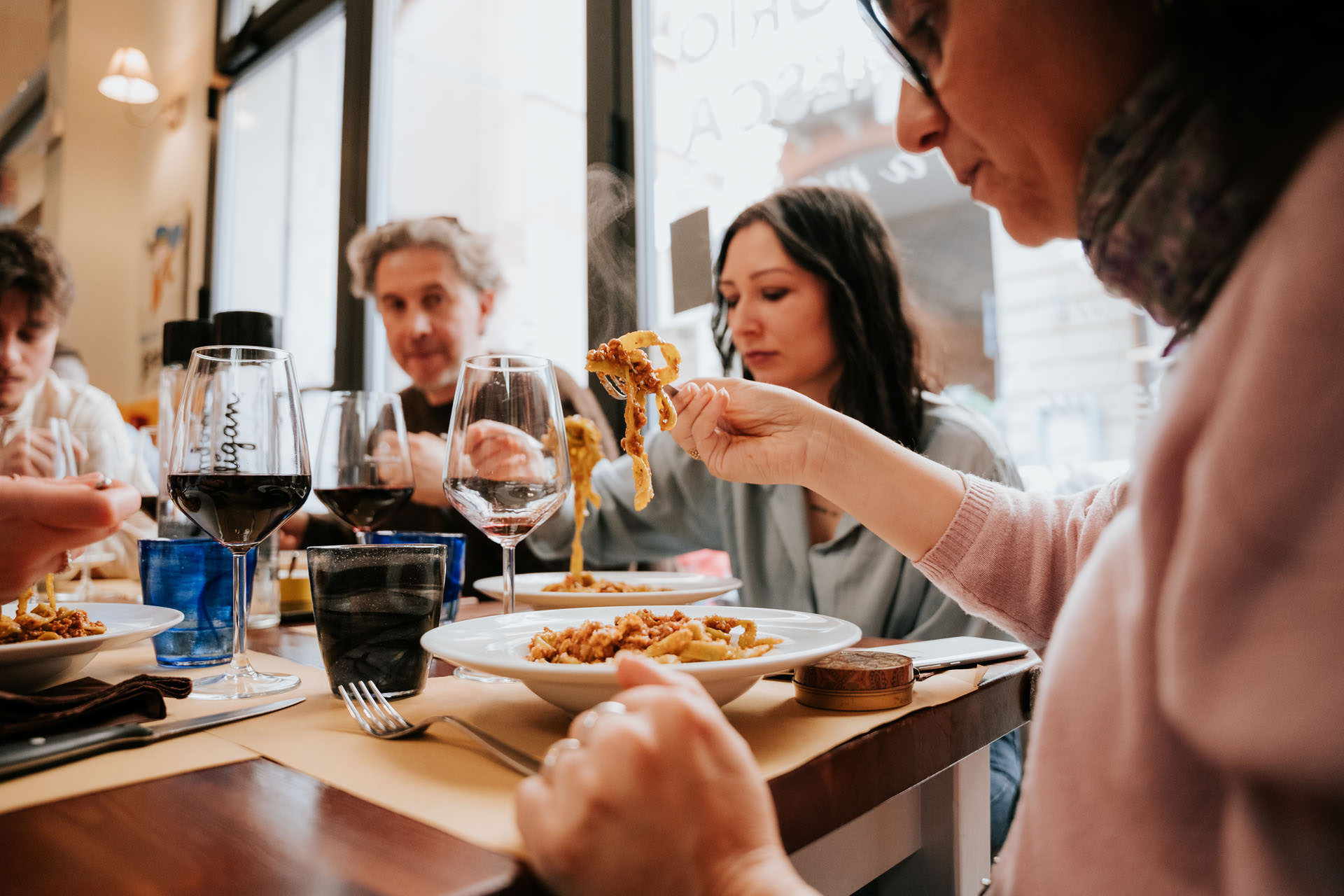
Italy Travel Tips: 7 Top Do’s & Don’ts in Italy
- Like a local
July 10, 2023
Want to get the most out traveling to Italy? Particularly if you’re planning on visiting the big cities and tourist destinations like Rome, Venice, or Florence, then check out these tips to have the best, most rewarding Italy trip possible!
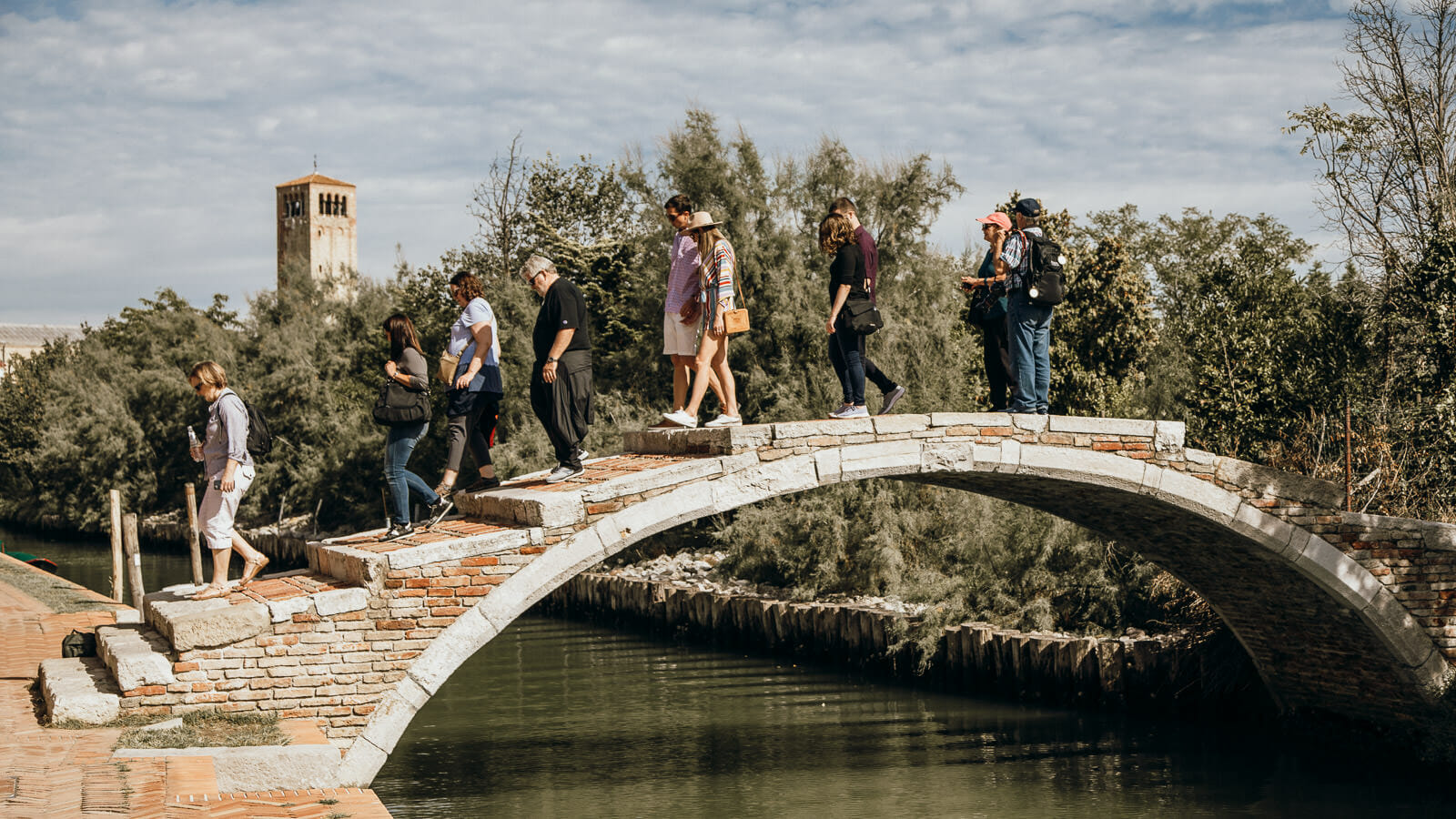
Whether you’re exploring a well-known city like Venice or getting off the beaten path in the Apennine Mountains, follow these top Italy travel tips to make the most of your trip.
Table of Contents
Best Italy travel tips
Do build in time for r&r.
No, not Raphael and Rome… rest and relaxation, of course! Believe us, we know: Coming to Italy is the trip of a lifetime, so it can be tempting to try to pack everything in. Accept that you can’t. Realize that even a lifetime of living in Italy wouldn’t mean you’d have seen all of the country’s incredible art, ancient ruins , or medieval towns.
So let go of the idea, for example, that if you’re spending two days in Rome, you “have” to see the Vatican museums, Sistine Chapel, St. Peter’s Basilica, Trevi Fountain, Piazza Navona, Spanish Steps, Pantheon, Colosseum, Forum, Palatine Hill, Castel Sant’Angelo, Capitoline Museums, Mouth of Truth, Circus Maximus, and the Borghese Gallery . Instead, choose which activities are most important to you. They might not even be the ones that everyone expects you to do.
But whether it’s tasting top-notch Italian wines , people-watching on a piazza, or going in search of local artisans, your choice is just as valid as something “everyone” does. And we promise—when you let go of the idea that you have to do “everything,” your trip will wind up being much more relaxing and rewarding!

Don’t forget to make time to relax (and enjoy the food and wine) in Italy.
Don’t annoy the locals
In Italy’s top tourist destinations, locals are used to tourists. But that doesn’t mean travelers can’t make an extra effort to be respectful and understanding of the local culture. One thing we know is a pet peeve to many city-dwellers in Rome, Venice, and Florence? Tourists blocking the narrow streets and sidewalks by slowly walking shoulder-to-shoulder and being unaware that anyone (someone late to work, let’s say) might want to pass them.
Remember that not everyone in major cities like Venice, Florence, and Rome is on vacation—an attitude that will make your interactions with Italians much more pleasant!
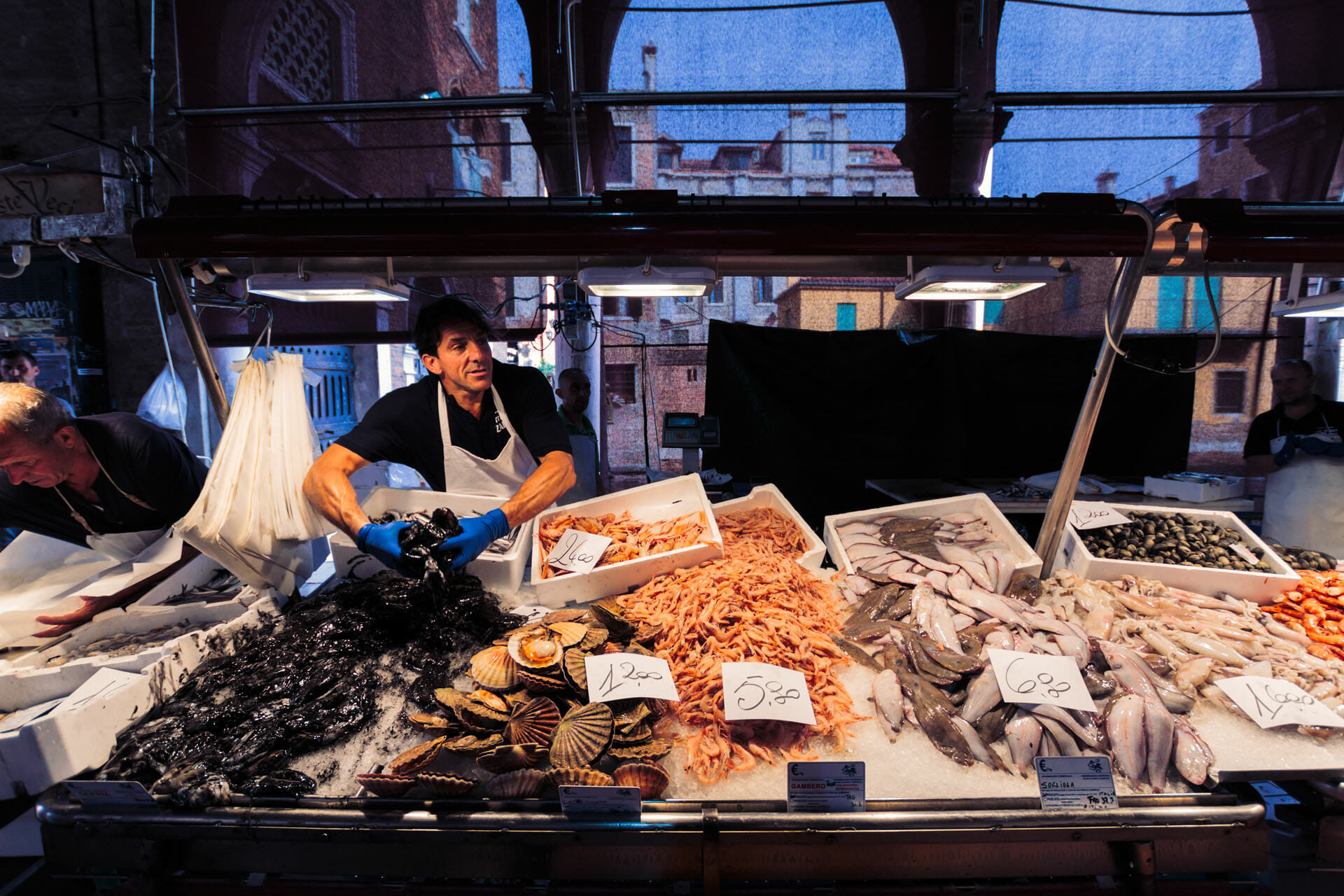
Whether you’re at a church or the local market, try to remember that not everyone you bump into is on vacation.
Do get off the beaten path
Of course, the major sights are major for a reason. But to get a real taste of “authentic” Italy, you need to head away from the crowds. We’re big fans staying in alternated destinations close to main tourist attractions, like staying in Salerno instead of Sorrento to enjoy the Amalfi Coast .
Even if you’re planning the classic Venice, Florence and Rome route in the middle of high season, you can get off the beaten path—it just takes a little more planning. Stay in the Cannaregio or Castello neighborhoods in Venice , or in the Oltrarno in Florence . Add off-the-beaten-path sights to your list of must-sees, like, in Rome, the Aventine keyhole or the Santa Priscilla catacombs .
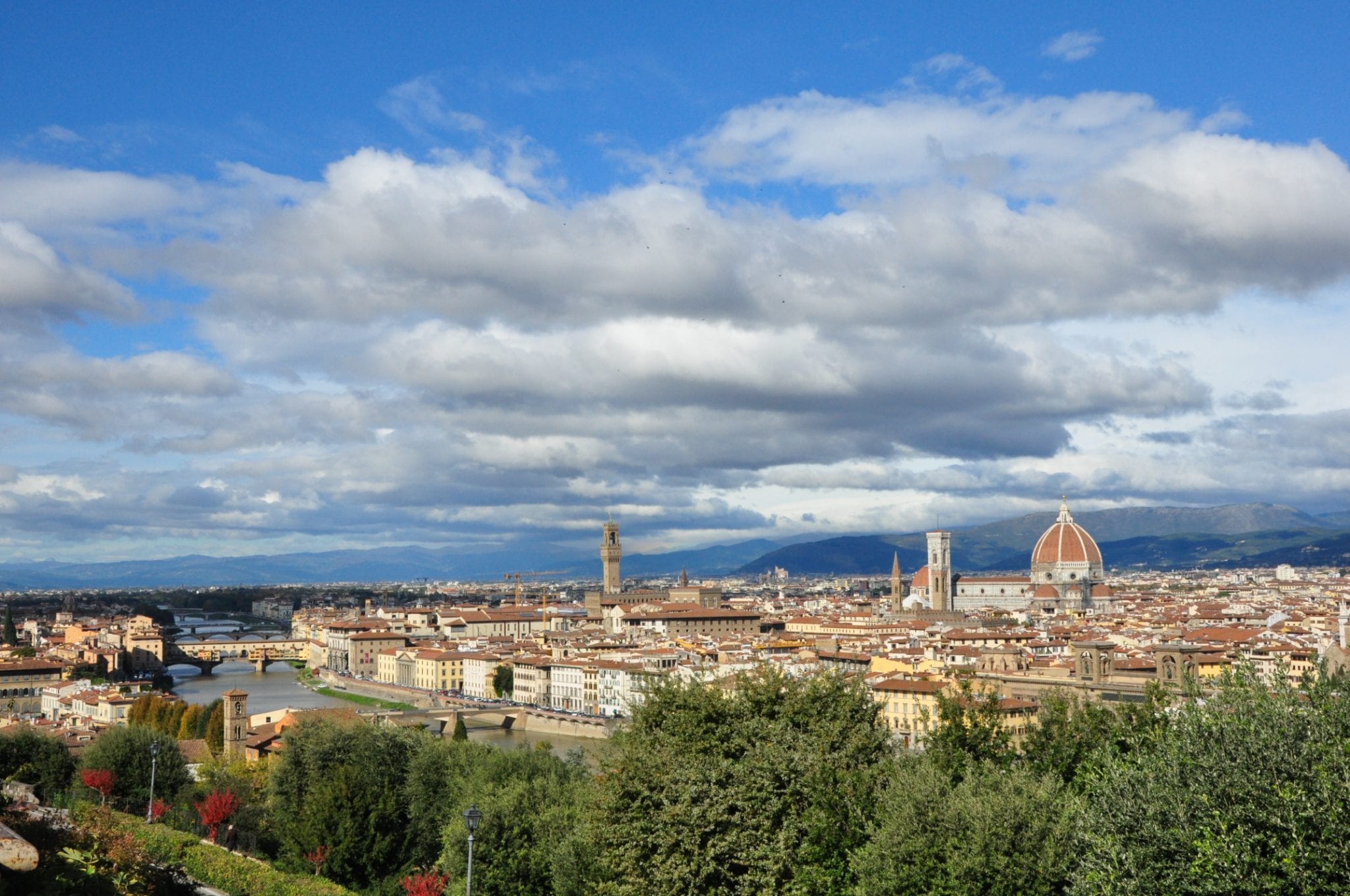
You can even get off the beaten path in Florence by crossing the Arno River!
Don’t fall into tourist traps
Easier said than done, right? But if you keep certain tips in mind, you can avoid the worst of the kinds of touristy, inauthentic, overpriced places that can make your trip go sour. Whether in terms of shopping or dining, following tip #1 and getting off the beaten path always helps.
Insider’s tip: If a store or a restaurant is a stone’s throw from Piazza Navona or the Duomo of Florence , for example, it’s generally going to be catering only to tourists… and if you want to experience the “real” Italy, that’s not what you want!
Avoid souvenir shops and consider seeking out a local artisan instead; even if the cost of your item is a little more, it’s much more lasting, and much more supportive of Italy’s locals and economy, than a made-in-China T-shirt. In terms of restaurants, steer clear of places that have hosts outside the door, places with tourist menus, and places that trumpet not having a cover charge. Here are other suggestions for how not to get ripped off eating in Italy .
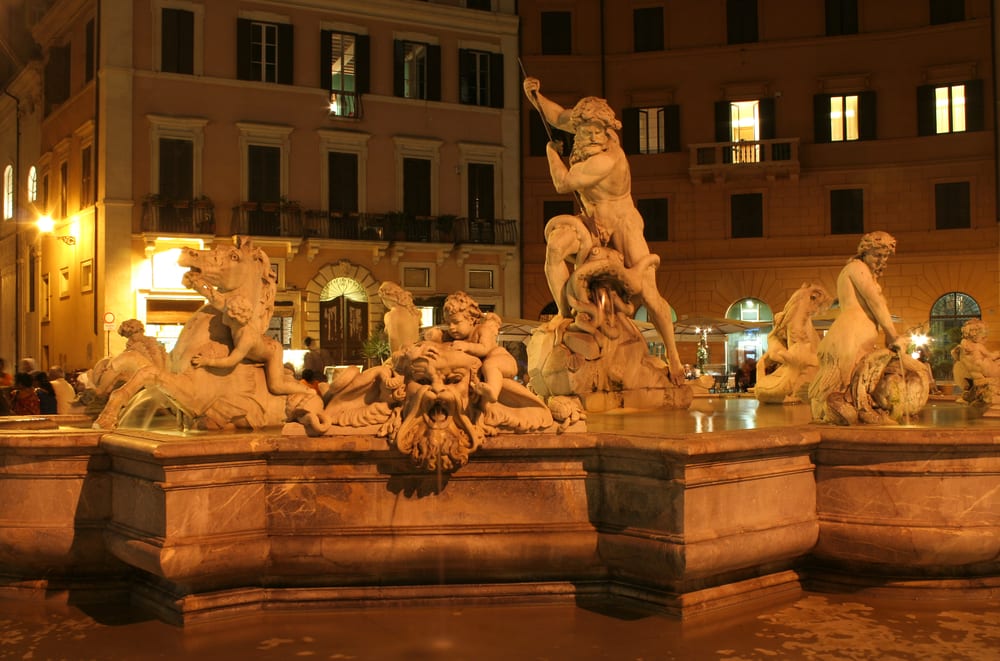
Piazza Navona is beautiful… but the restaurants on the piazza tend to be tourist traps.
Do be aware of your belongings at all times
Like anywhere else in the world that receives millions of tourists each year, certain areas in Rome, Venice, and Florence are magnets for pickpockets. Even if you walk around with your purse unzipped and your wallet hanging out, you’ll probably be fine—but it’s not a risk worth taking.
In general, be particularly aware on the metro and the bus, especially when it’s crowded. Also keep your eye out at crowded tourist sights (the Trevi Fountain , for example), where pickpockets prey on those who are thinking about getting that perfect photo op, not on the wallet in their back pocket. When sitting at a café or restaurant, especially outside, don’t simply leave your bag on the ground next to you In general, always be aware of your surroundings and know where your belongings are—even when you’re, say, trying to get that perfect shot of the Rialto Bridge.
In terms of how to carry your money, zippered, under-the-shirt pouches for carrying cash are always the safest bet. Otherwise, men should carry their wallets in their front (not back) pockets, while women should use purses that zipper and have multiple zipped compartments inside. Backpacks and “fanny packs” are particularly vulnerable, even if your waist pack is in front.
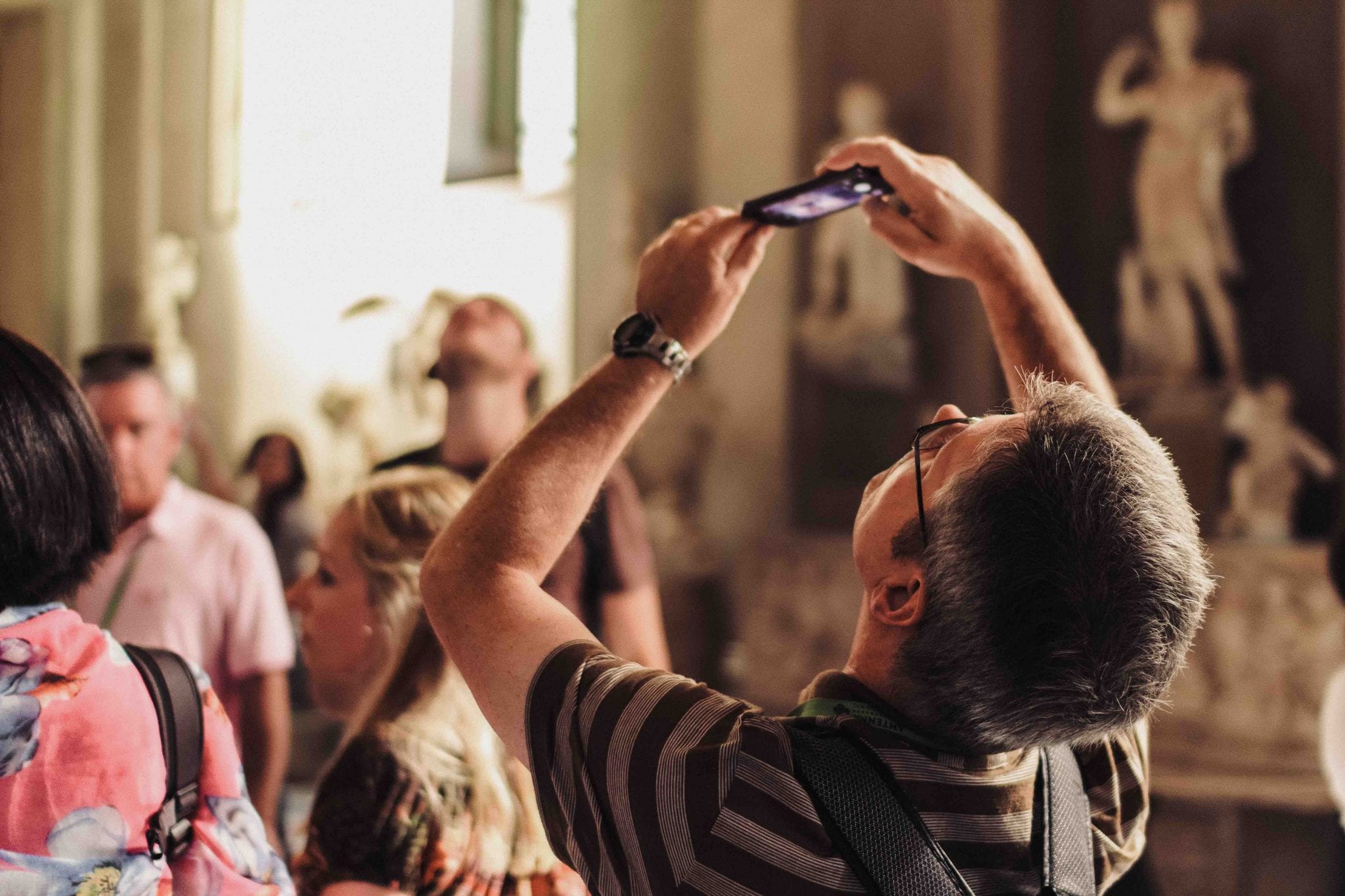
Snapping that perfect shot? Keep an eye on bags, backpacks, and other belongings!
Don’t expect Italy to work like places do back home
You came to Italy because it’s a different country. So, even if it’s sometimes different in ways that can be frustrating, embrace it! Remember that even the more negative-seeming aspects of the culture developed for a reason, even if it might not be immediately clear to you. And try to keep a flexible, positive attitude, no matter the situation.

Is your bus running late? Can you never seem to flag down the bill after a meal? Try to take things a bit slower and soak up those uniquely Italian moments!
Do dress appropriately, even if you’re not planning on visiting a church
Yes, there’s a dress code for major churches and holy places, like St. Mark’s Basilica and the Vatican . But many other churches in Italy also are gems you’ll want to check out, and you never know when you might pass one. You’ll feel silly if you can’t because you’re wearing a spaghetti-strap tank top!
In general, shoulders and knees should be covered for men and women. If it’s a boiling-hot day and you simply must wear less, make sure to throw a few scarves or a cardigan into your bag to carry around with you. Don’t try to “sneak in” in super-short shorts or a tube top; even if other tourists are “getting away” with wearing less into the churches, wearing appropriate clothing is the respectful thing to do.
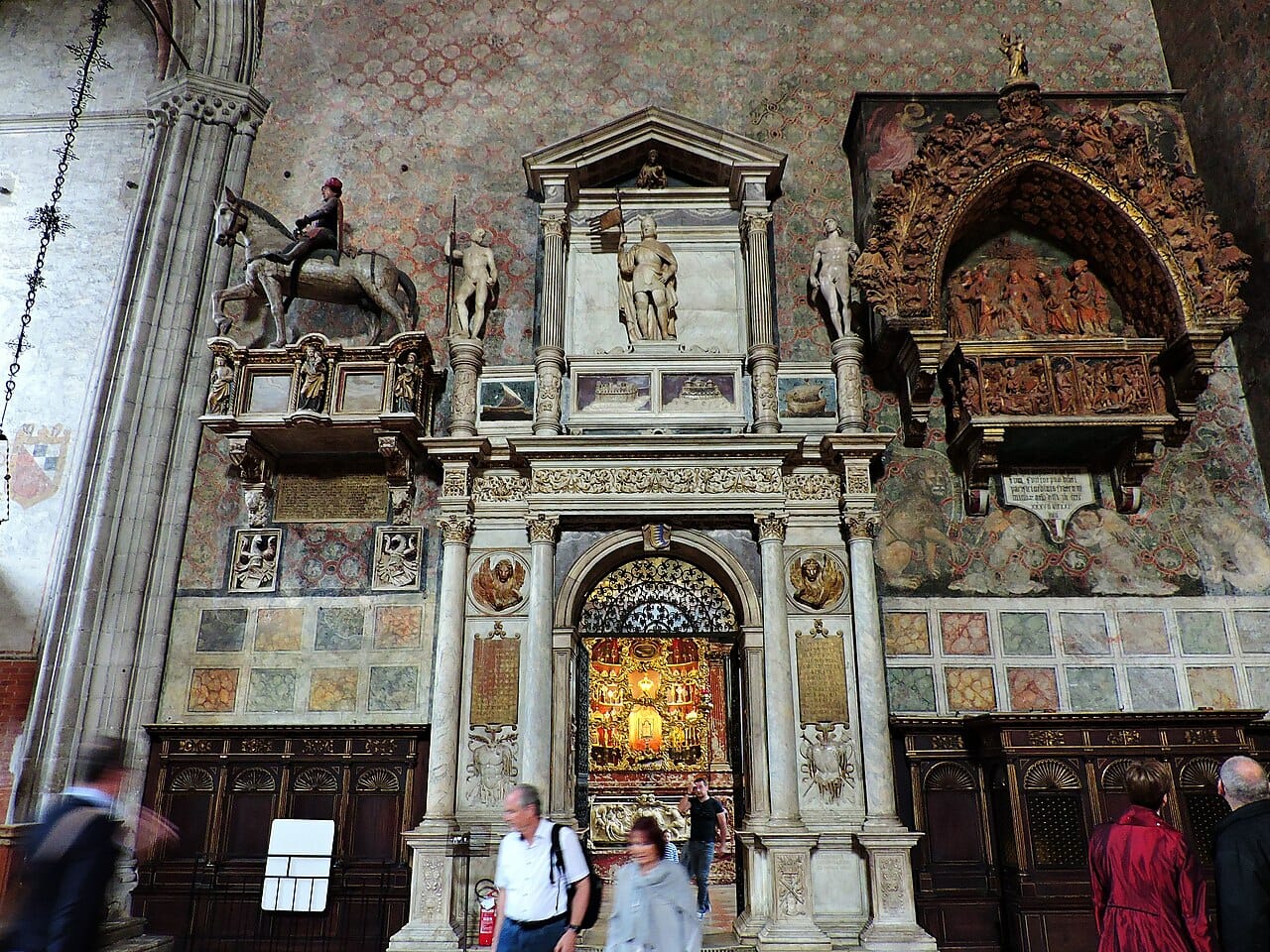
You never know when you might happen past a church you want to pop into, such as the Basilica of Santa Maria Gloriosa dei Frari in Venice. Photo credit: Dimitris Kamaras
Update notice: This article was updated on July 4, 2023.

by Cristina C.
Book a tour.

Pristine Sistine - The Chapel at its Best
1794 reviews

Premium Colosseum Tour with Roman Forum Palatine Hill
850 reviews

Pasta-Making Class: Cook, Dine Drink Wine with a Local Chef
121 reviews

Crypts, Bones Catacombs: Underground Tour of Rome
401 reviews

VIP Doge's Palace Secret Passages Tour

Legendary Venice: St. Mark's Basilica, Terrace Doge's Palace
286 reviews
Stay up to date with travel tips, local insights and all things Italy on our social channels!
Subscribe to our Newsletter
Get curated Italy travel tips delivered to your inbox!
Your browser is out-of-date!
Update your browser to view this website correctly. Update my browser now

30+ Italy Travel Tips for First Timers & Must Knows Before You Go
Last Updated: July 6, 2023
*FYI - this post may contain affiliate links, which means we earn a commission at no extra cost to you if you purchase from them. Also, as an Amazon Associate I earn from qualifying purchases. Check out our Privacy Policy and Disclosure. for more info.
Ah, Italy. I’ll never understand how a country so beautiful can be so stressful.
As one of the most romanticized countries in the world, many first time visitors are shocked to discover that Bella Italia isn’t just a non stop parade of gelato, spaghetti and Vespa rides with men named Paolo.
Pickpockets? Bone-chillingly ruthless drivers? Random fees and charges? Unspoken food rules that feel more important than actual laws?
Yes, Italy is amazing… but it also has a lot of random traps and culture shocks that stump first time visitors.
… But not you! Because you’re here. And you’re about to learn all my top Italy travel tips, assembled after a decade of frequent trips to (what is honestly) one of my favourite countries in the world.
So, read on for a list of important must knows before you visit Italy. Armed with these, you can properly enjoy your Italian dream trip just like in the movies.
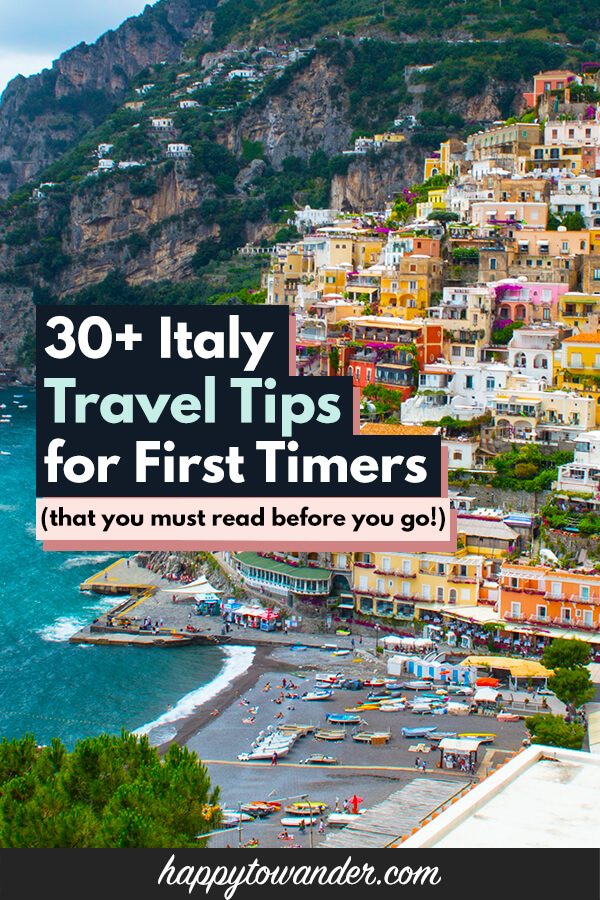
Save this list of Italy Travel Tips for later!
You’ll be very glad you did.
1. Expand your Italy itinerary beyond the best known places
Let’s get this out of the way: Italy is a popular place, and thanks to the powers of social media, droolworthy destinations like Rome , Florence, Venice, Milan , Cinque Terre and the Amalfi Coast are now firmly at the top of everybody (and their mom)’s bucket lists.
But with this popularity comes crowds, and quite ironically, many tourists find that ‘too many tourists’ can ruin their experience.
Luckily there are ways to enjoy Italy away from the crowds – the main one being to visit more offbeat places.
That’s not to say you should avoid Rome or Venice altogether, but here’s what I would suggest: pick a popular place as your base, then diversify your itinerary by adding on side trips to quieter gems nearby.
For instance…
- Going to Venice? Add on cool nearby cities like Padua and Ferrara or venture farther North to visit Trentino or South Tyrol.
- Going to Rome? Visit Tivoli! And actually Fiumicino (by the airport) is quite nice.
- Going to Florence? Add a visit to Bologna, or other tasty towns around Emilia Romagna.
- Going to Cinque Terre? Visit more towns along the Ligurian coast, or add on a day or two in Genoa – the region’s capital.
Of course, you can also simply focus your entire trip on a lesser explored part of Italy. With twenty regions and hundreds of islands off the mainland to choose from, you’re spoiled for choice.
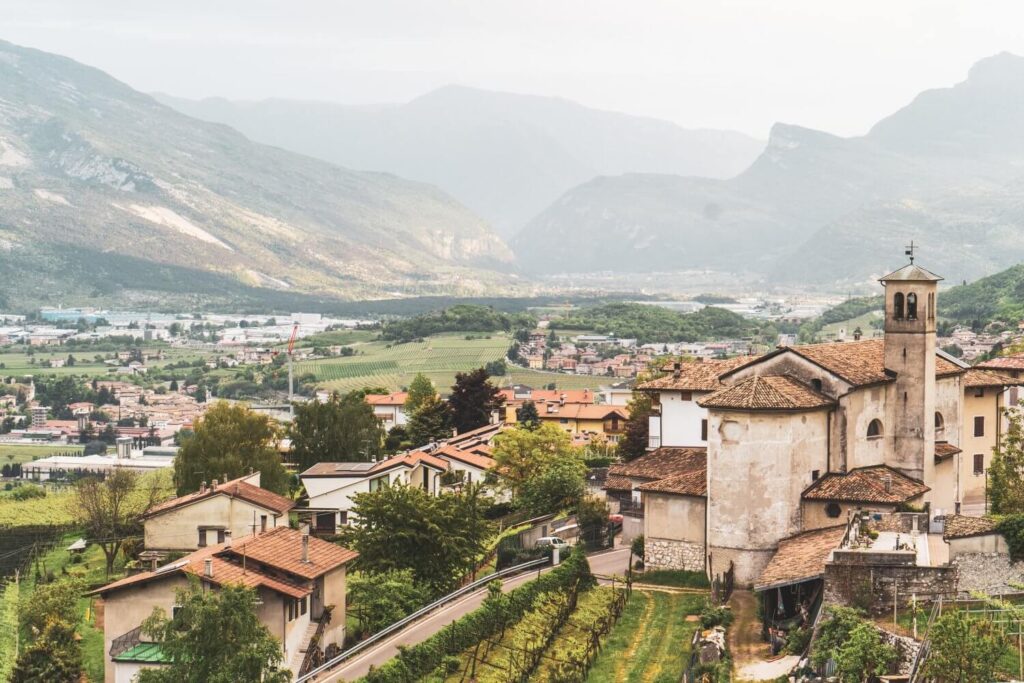
2. Avoid peak season like the plague
I know summer in Italy sounds like a dream.
… But it’s not. It’s sticky. It’s crowded. And it’s when prices are at their most eye-gouging.
So, if you have the luxury of flexibility, I’d opt for a visit in the shoulder seasons ( Spring or Fall) or, in the case of city breaks, even a visit in the winter.
I’ve done city trips to Rome, Venice and Verona in the dead of winter and while the weather was hit and miss, the lack of crowds and tolerable accommodation prices more than made up for it.
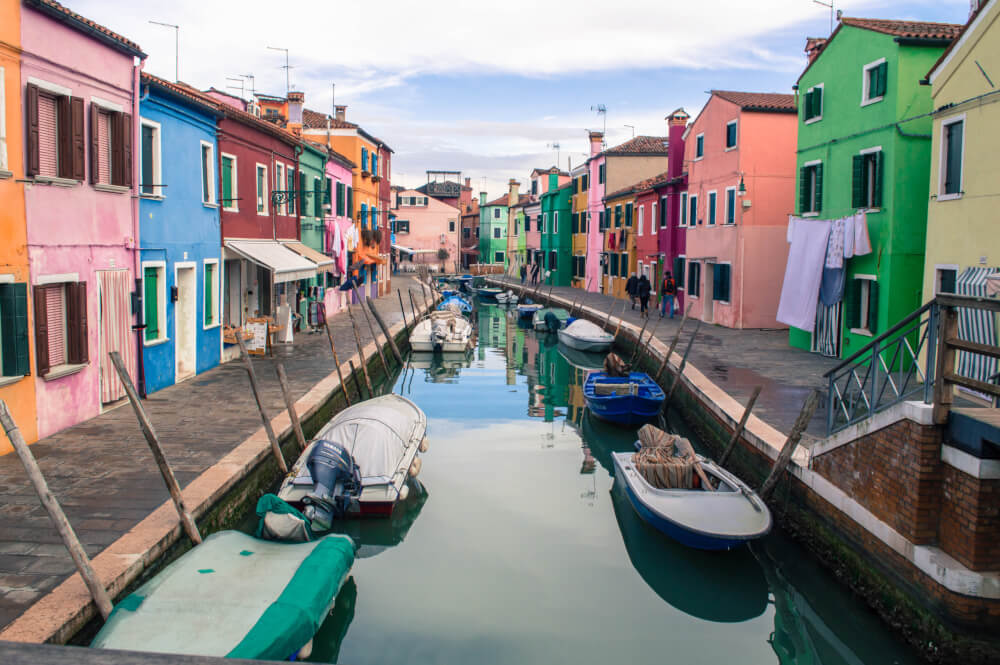
3. For city to city travel, choose public transport if possible
Driving in Italy can be a stressful endeavour and only really necessary if you plan to visit smaller villages or more remote areas.
Otherwise, city travel with trains or buses couldn’t be easier. If you’re unsure of which options make the most sense for your trip, then I’d recommend hopping on Omio to compare buses, trains and flights at a glance.
I cover more in my guide on the cheapest ways to travel Europe , so be sure to check that out for more info.

4. Beware the common mistakes when renting a car
Of course, if you’re up for the thrills of real-life Italian Mario Kart, then there are a few extra things you should know. Here are some tips for renting a car in Italy.
When renting a car in Italy, try to…
- Pick a small one because you never know when you might end up on an impossibly narrow Italian road
- Get a vignette if driving into other countries. This is a paid sticker that you must put on your car if you want to use the country’s motorways, otherwise you get fined. You don’t need them in Italy, but you do for many of Italy’s neighbours like Austria, Switzerland, and Slovenia.
- Avoid ZTLs, or Zona a Traffico Limitato. These are zones in busy cities where you can get fined for driving in them during certain hours.
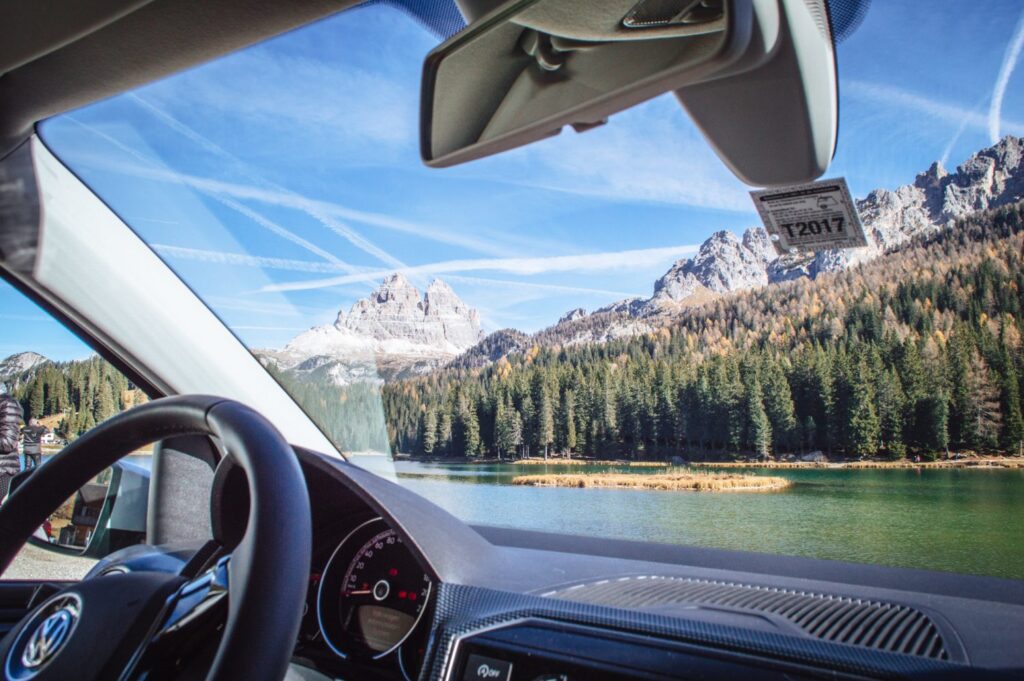
5. Buy bus tickets in advance
One of the stranger quirks of Italy travel is that bus tickets oftentimes aren’t available for purchase on the bus.
In these cases, you need to make sure you have tickets for the bus before boarding. Luckily, you can usually buy these from a Tabacchi (Tobacco Shop / Convenience Store) or newspaper stand.
NOTE: With these pre-purchased tickets, make sure you validate them through a machine once you board, or you may be fined if ticket controllers come on board.

6. Always buy train tickets in advance too
If you look up the word “stressed” in the dictionary, it’s likely you’ll encounter a photograph of a sweaty, lost tourist in an Italian train station.
I don’t know what it is. Maybe it’s the heat. Or the omni-present pickpockets. Maybe it’s the parade of quick-moving humans who all seem to know what they’re doing besides you… or the fact that you’re dragging all your bags along with you. But Italian train stations (for those new to them) can be some of the most chaotic and stressful places on Planet Earth.
SO, my best Italy travel tip for avoiding the stress and chaos of train stations is to simply book your tickets ahead of time, so you’re not awkwardly staring at a machine upon arrival, trying not to cry.
You’ll usually save money this way too!
You can check out my post about how to take trains in Europe for more info on the train taking process.
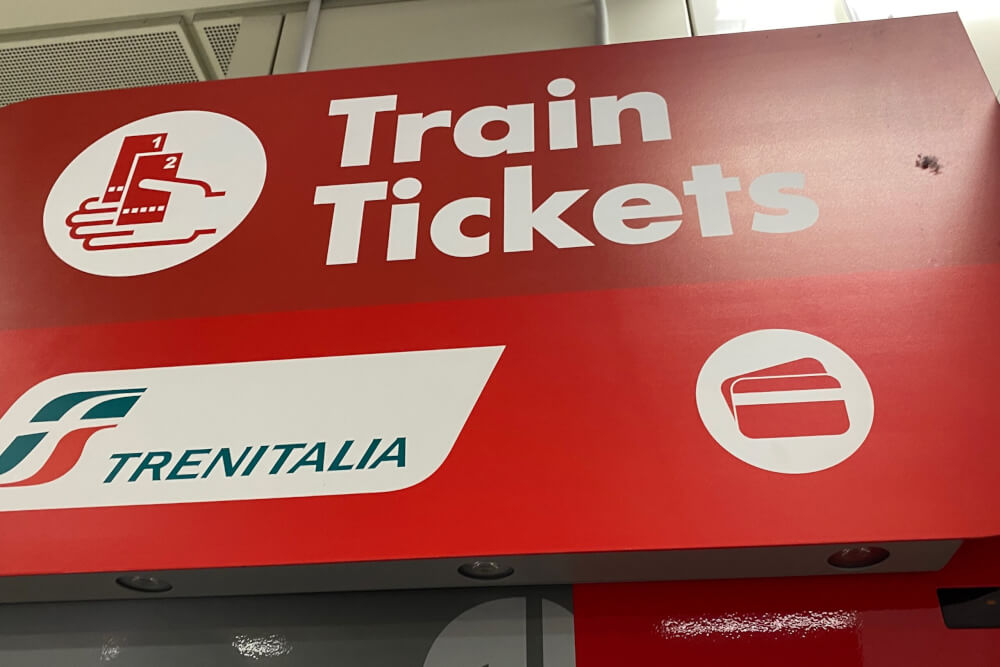
7. Always validate physical tickets when needed
In Italy, having a train ticket isn’t enough to avoid a fine. It must be properly validated too.
This is one of the top mistakes tourists make in Italy, so don’t let that be you! If you have a physical train ticket, be sure to validate it as needed at a machine like this:
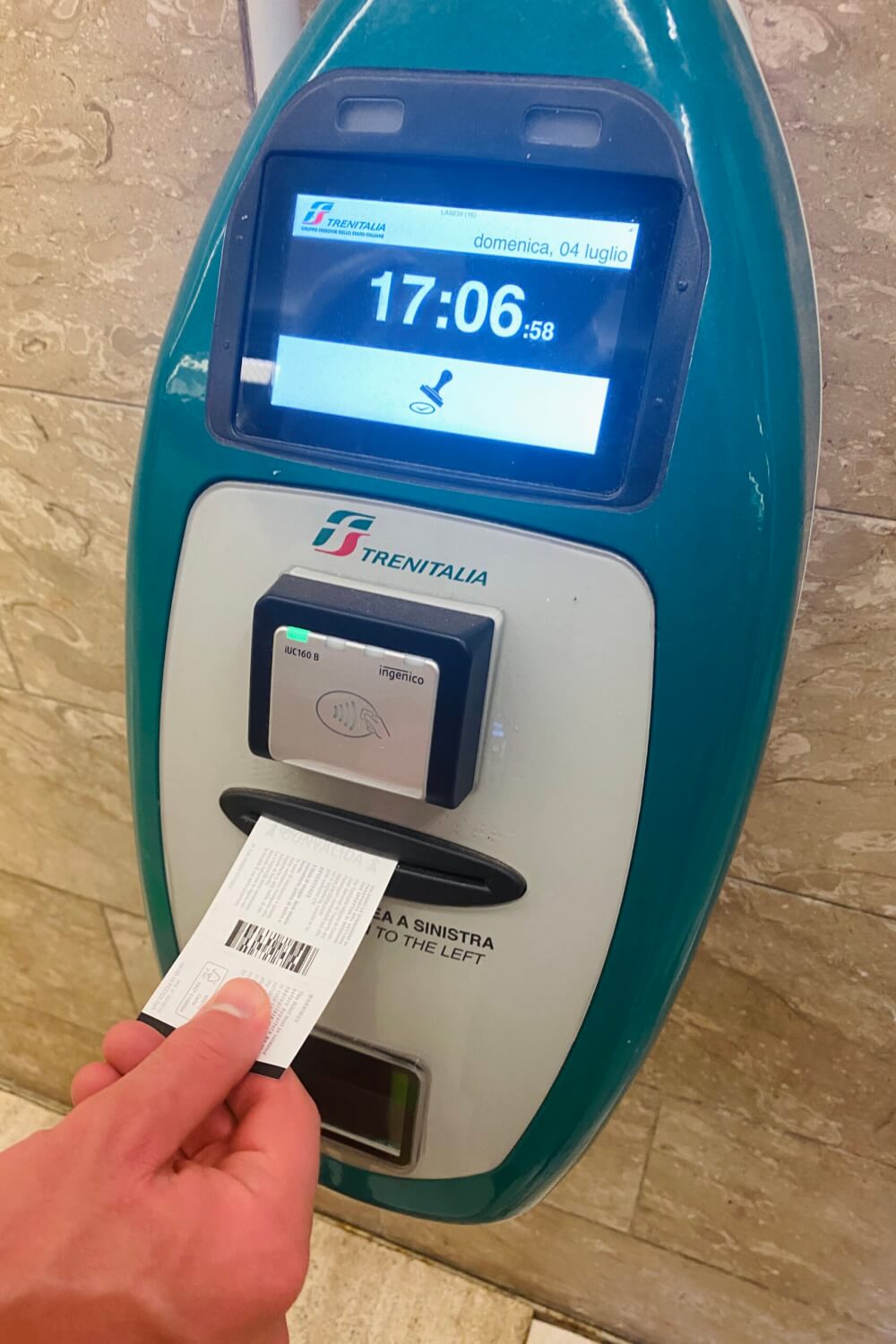
8. Remember that there’s tremendous cultural diversity within Italy
For many, Italy is a country we feel like we know a lot about thanks to its total domination in popular media and culture.
But the truth is, Italy can look VERY different depending on where you go, and all things from culinary specialties to even language can differ based on region.
For instance, there are parts of Northern Italy where German is so commonly spoken that many major destinations have both Italian and German names. (Lago di Braies and Pragser Wildsee are the same place! Who knew?)
So, anyways, before your trip, try to cleanse your brain of any random Italian stereotypes and be sure to research cultural norms appropriate for your destination.
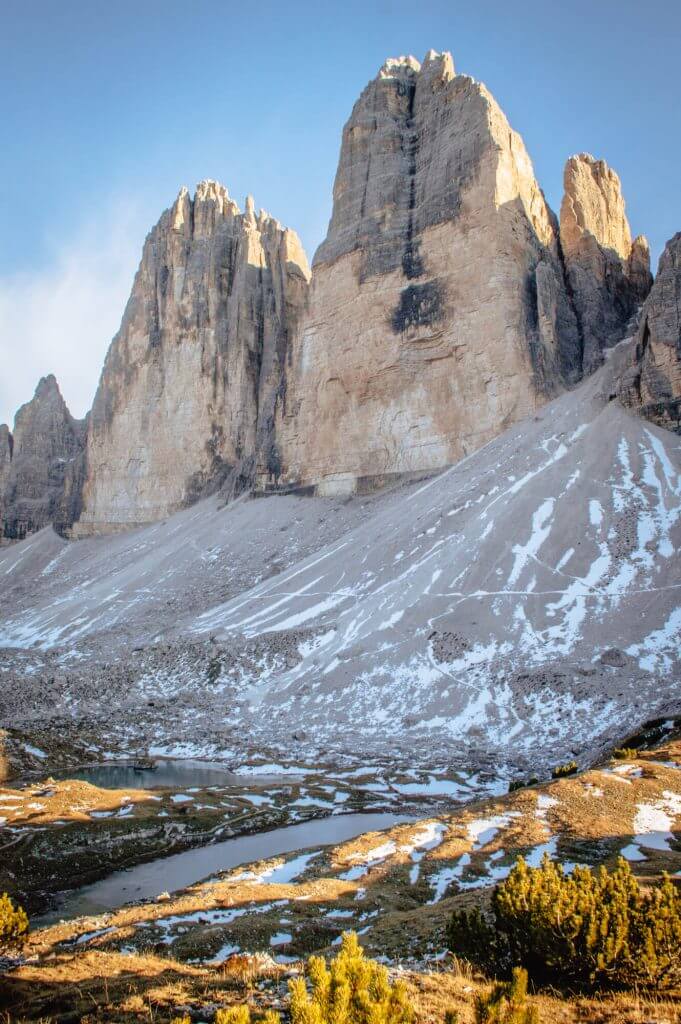
9. Learn how to say hello and thank you
Apart from my usual reason that it’s just good manners to learn a bit of the local language, in Italy there’s the bonus perk that Italian is just so fun to speak.
So take advantage and speak as much of it as you can while you’re there. Knowing the basics can go a long way.
Here are the basics to learn by heart before your visit:
- Hello (in the morning/afternoon): Buongiorno (Bwon-JOOR-no)
- Hello (in the evening): Buonasera (Bwon-ah-SAY-ruh)
- Thank you: Grazie (GRAHT-see-eh)
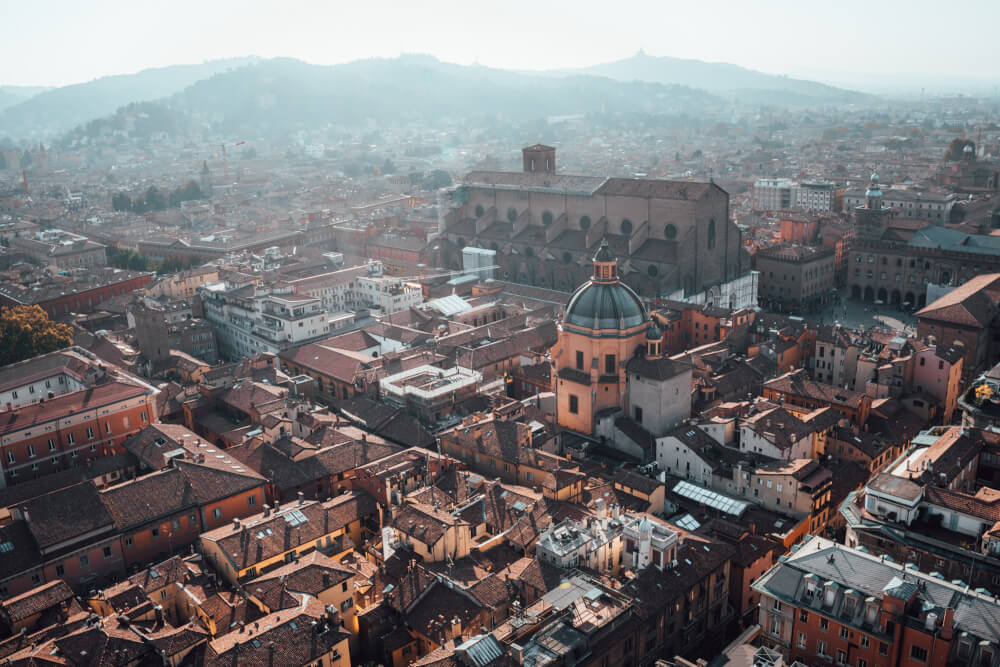
10. Bring a bag you can easily carry
One of the biggest beginner mistakes that visitors make in Italy is they pack way too much and are left red-faced dragging their gargantuan suitcases across centuries-old cobblestones, trying in vain to find their hotel which… probably doesn’t have an elevator.
I get it – the urge to look cute while lapping up gelato is SO strong, but remember there’s ways you can pack light and still not look like a slob.
So, my best Italy packing tip is to simply not bring any bags you can’t physically carry.
Trust me, there are many situations where you might need to pick up your bag (going up stairs, getting on a train, etc.) so if you’re not able to lift your own bag, then you need to downsize pronto.
This tip is especially important in places like Cinque Terre or the Amalfi Coast where there’s a lack of roads and lot of stairs.
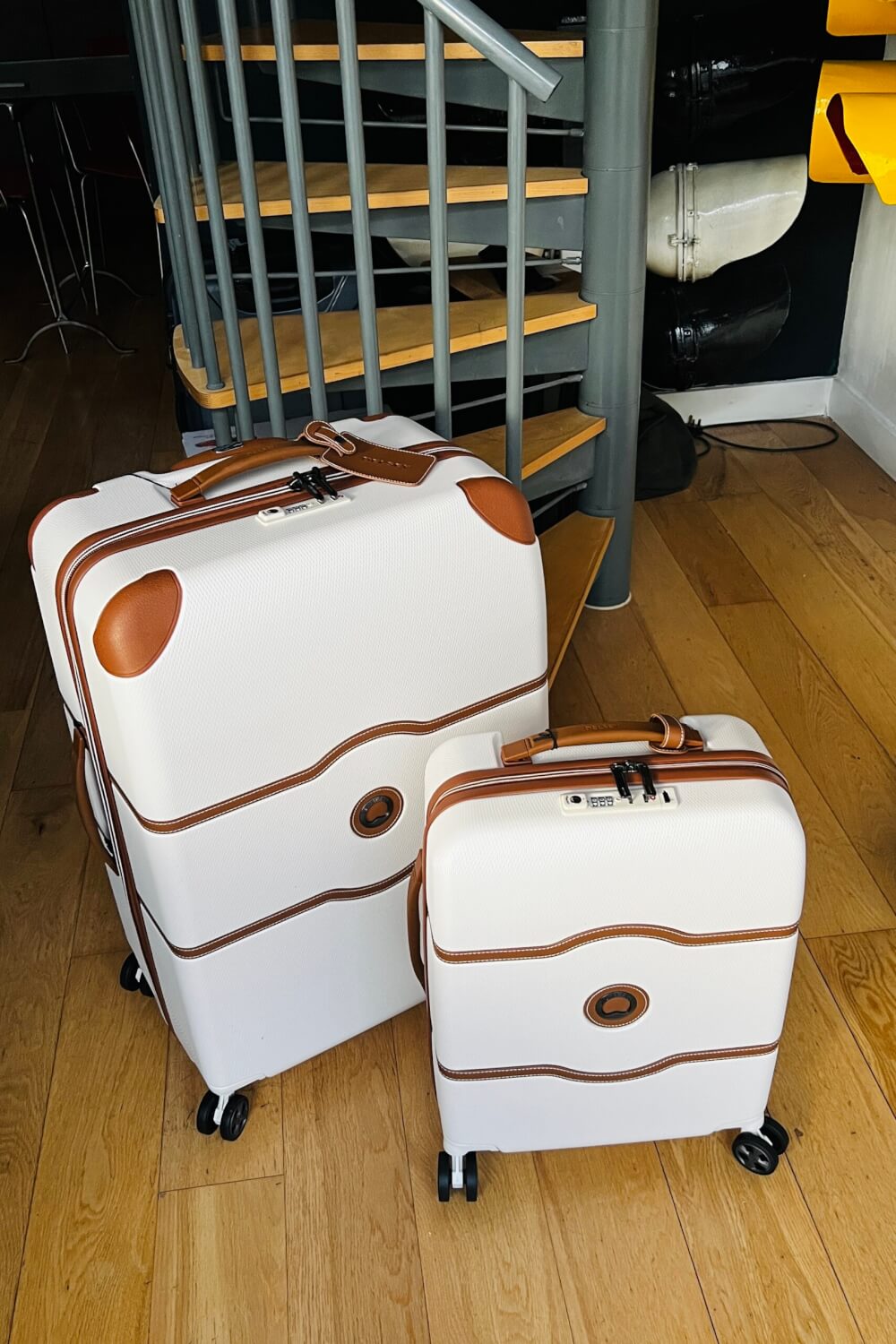
11. Cover up when visiting churches
Unbeknownst to many first time visitors, churches in Italy usually have a dress code stating that shoulders and knees must be covered. If you’re not dressed appropriately, often you won’t be let in.
SO, if you’re visiting in the summer, make sure you have a scarf you can drape over yourself and at least one or two long options for bottoms.
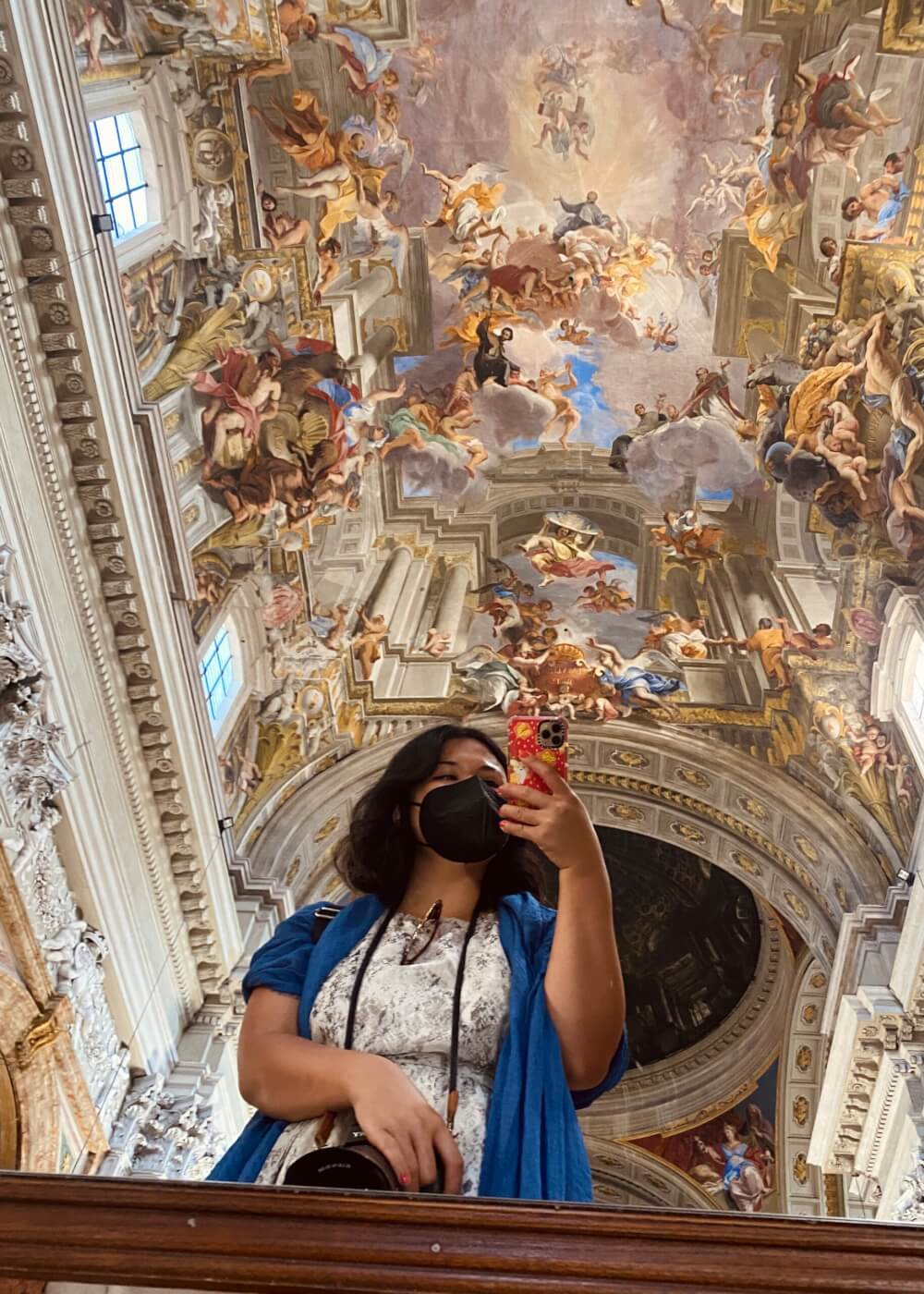
12. Prepare yourself for scaffolding and restorations
Italy is an amazing destination thanks (in part) to its fascinating history.
… The flip side of that history? Many of the country’s most famous monuments have seen better days, and are in constant need of repair/restoration.
So, mentally prepare yourself for the possibility that the amazing church or landmark you’ve seen a million times on social media is covered in scaffolding, or doesn’t look as you hoped due to restorations.
As a harrowing example, this is what the Trevi Fountain looked like on my first trip to Rome.
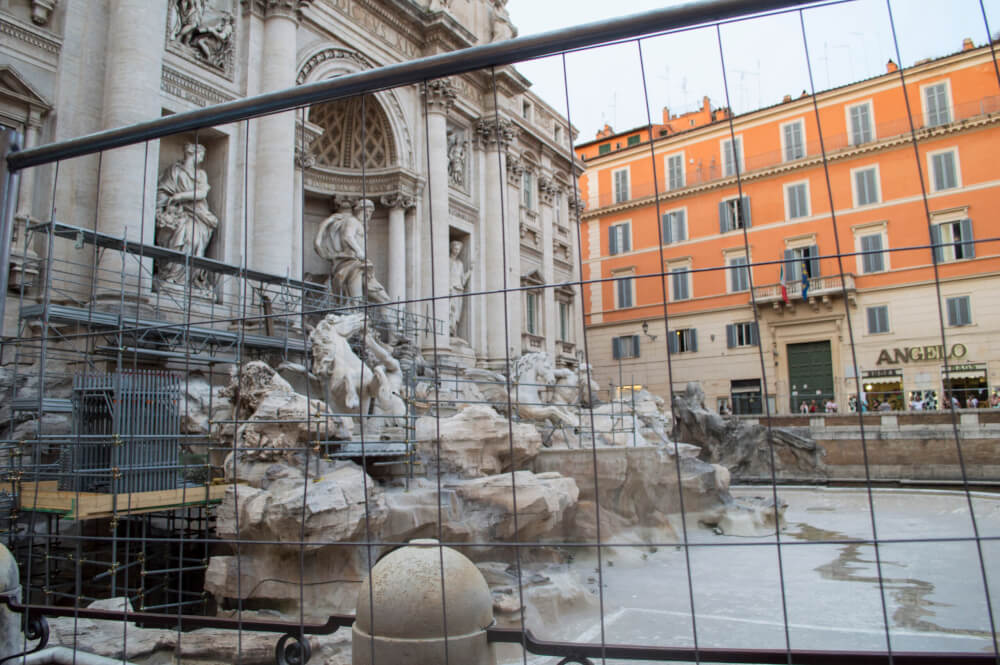
13. Book tickets for popular attractions in advance
Sorry for the aggression but I’m really passionate about this: the absolute worst waste of time during your Italy trip is waiting in line to buy tickets the day-of.
If you are reading this right now, you have access to the Internet. As such, you have access to buying tickets in advance… which you should do because it’s usually cheaper, saves you waiting in line, and also protects you in peak season if things sell out, which they often do.
So, buy those tickets in advance! I usually book directly on the attraction’s official website, or scour sites like GetYourGuide and Tiqets for deals.
NOTE: If there’s a skip the line option, most of the time it’s also worth the extra cost.
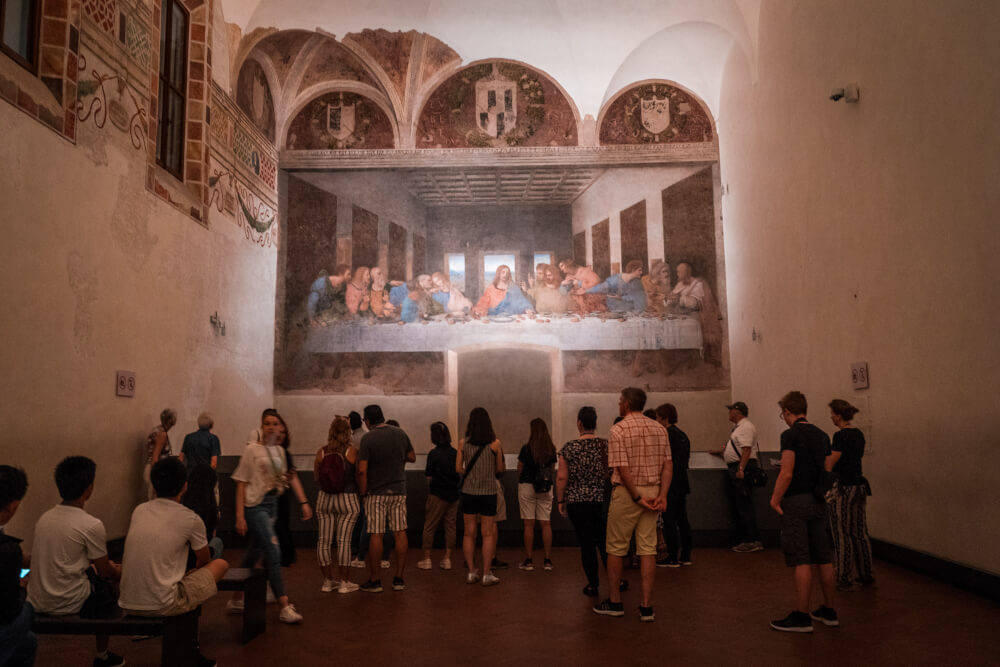
14. Learn the tricks to avoiding crowds at attractions
It’s ironic really – most tourists hate seeing other tourists when they sightsee.
After all, how dare the public be out in public at the same time as me?!
But hey, if this irrational peeve is one you share, I have some great tips for avoiding crowds in Italy. You might not like some of them, but trust me – they work!
Here’s how to avoid crowds at major attractions in Italy (especially during peak season):
- Wake up at sunrise to explore/take photos
- Visit attractions shortly before closing time (this is how I managed to get the Vatican Museum practically to myself!)
- Look into sunrise or after hours tours for attractions
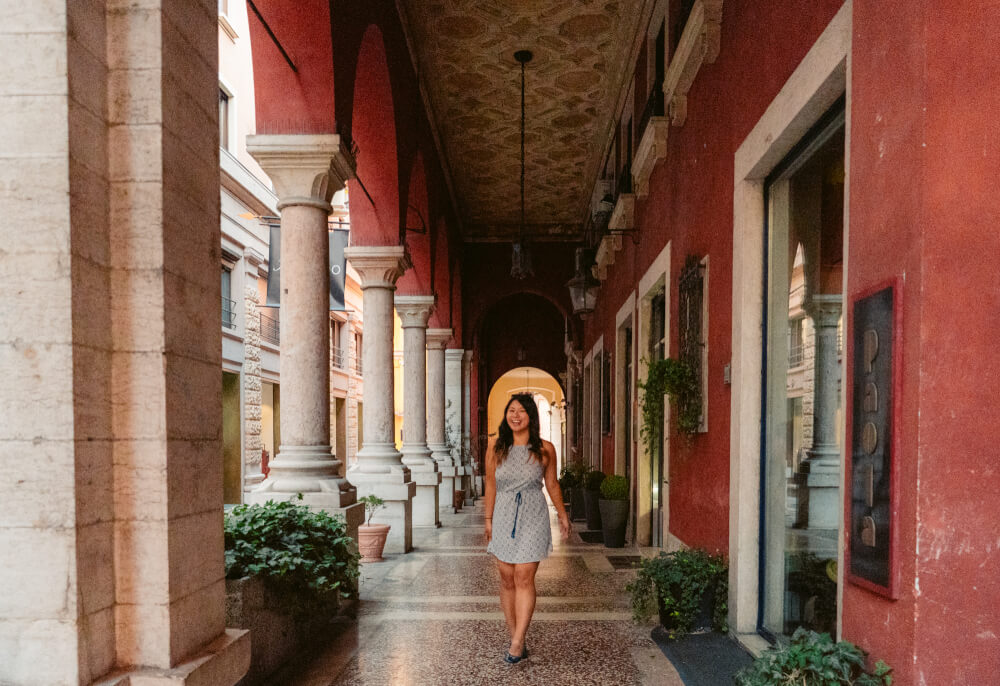
15. Buy a city pass or card
Besides crowds, the other villain in your Italy sightseeing journey is prices .
Yes, visiting attractions in Italy (especially the big ones) can get real spendy real quick.
Luckily, there are many ways to save. One of my favourite tips for saving money on Italian attractions is getting a city card or pass, which gives you entry to most major attractions in a place for one set cost.
For instance, I’ve used this card in the past to check out all the fun things to do in Verona , and found it not only saved me lots of money, it also pushed me to see some more off the beaten path attractions I would’ve otherwise not paid for.
Every city will have some kind of pass for this purpose, so be sure to look into it, crunch the numbers, and see if it’s worth it for you!
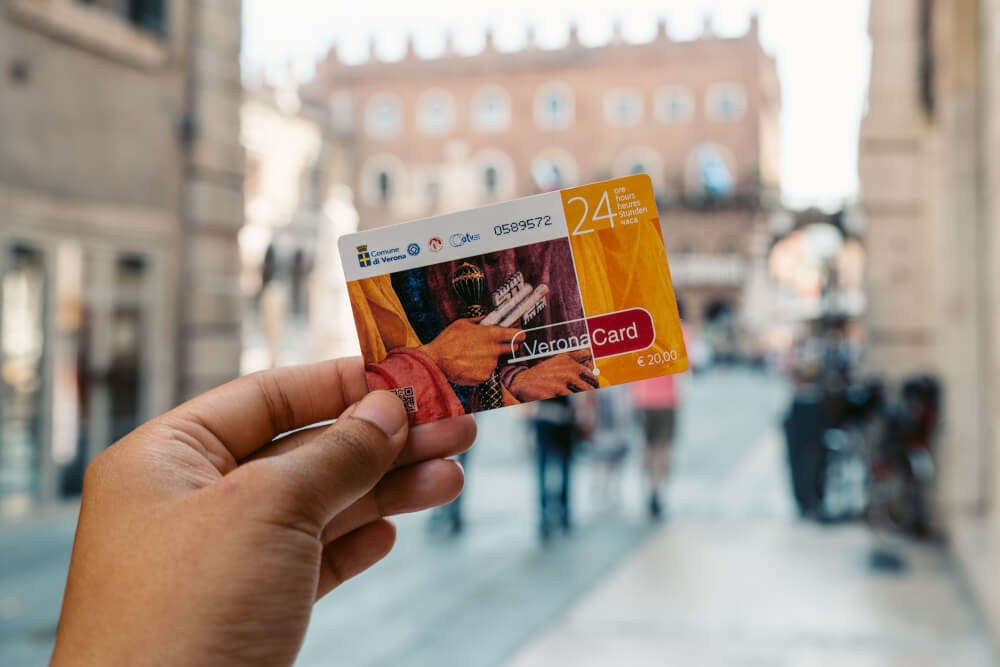
16. Beware of pickpockets
It’s not a fun topic, but no list of travel tips for Italy would be complete without a quick pep talk about dodging pickpockets.
I do have a full guide on how to avoid pickpockets in Europe if you want more specific information, but just know that pickpocketing is a very common occurrence in touristy Italian cities.
I was actually pickpocketed in Rome during my first backpacking trip, so I know this from sad, first-hand experience.
But don’t worry – a little common sense (which I lacked at the time) can go a long way.
Remember, pickpockets thrive on easy, unsuspecting targets, so to make sure that’s not you, here are some quick tips for avoiding pickpockets in Italy:
- Be ultra vigilant in busy areas like train stations or tourist attractions
- Keep as much distance as possible between you and others
- Avoid things being given to you for “free” e.g. friendship bracelets or roses – often they will then demand you pay
- Don’t sign any petitions – often they will hassle you for a donation or use it as a distraction while pickpocketing you

17. Don’t freak out when your accommodation photocopies your passport
There are a lot of random culture shocks that first time visitors experience in Italy – one of the most jarring (and immediate) is that hotels/accommodation will take your passport and make a photocopy of it upon arrival.
But don’t worry, before your mind jumps to an Italian thief stealing your identity, just know that this is a common legal practice they have to abide by, and not a super brazen scam.
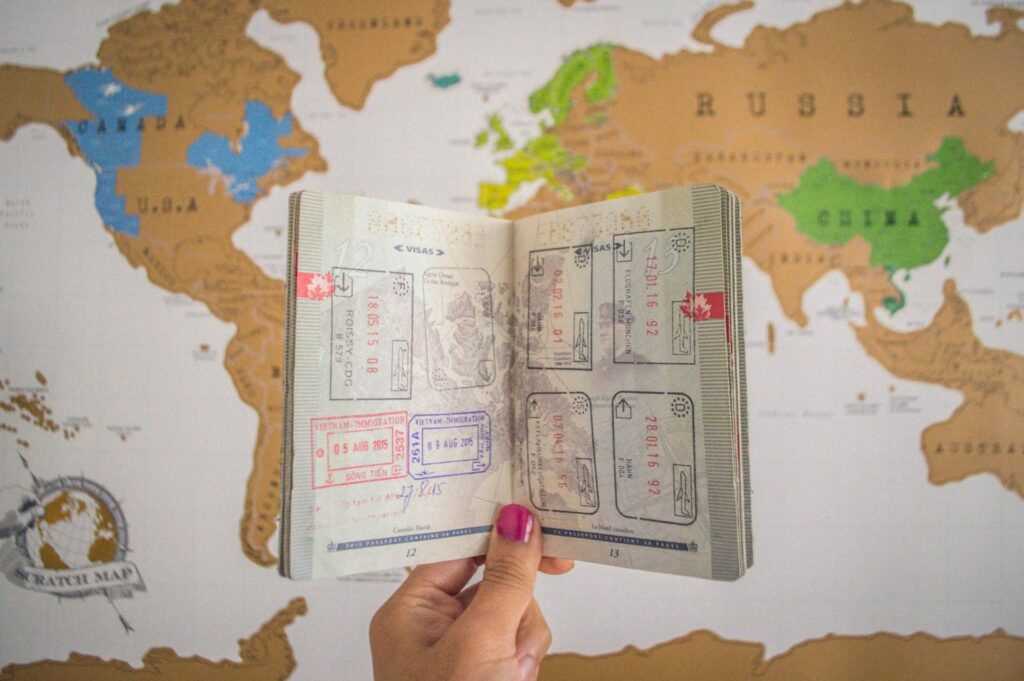
18. Prepare for the tourist tax
Another thing that feels like a scam, but actually isn’t? The almighty Italian tourist tax.
The reason this feels like an illegitimate ploy is because they usually ask for the tax in person, and some old school places will also demand it’s paid in cash.
But don’t worry – just like the passport thing, the Italian tourist tax is also not a scam. It’s simply an additional charge to be paid on arrival, and the amount is typically 3-7 euros per person per night.
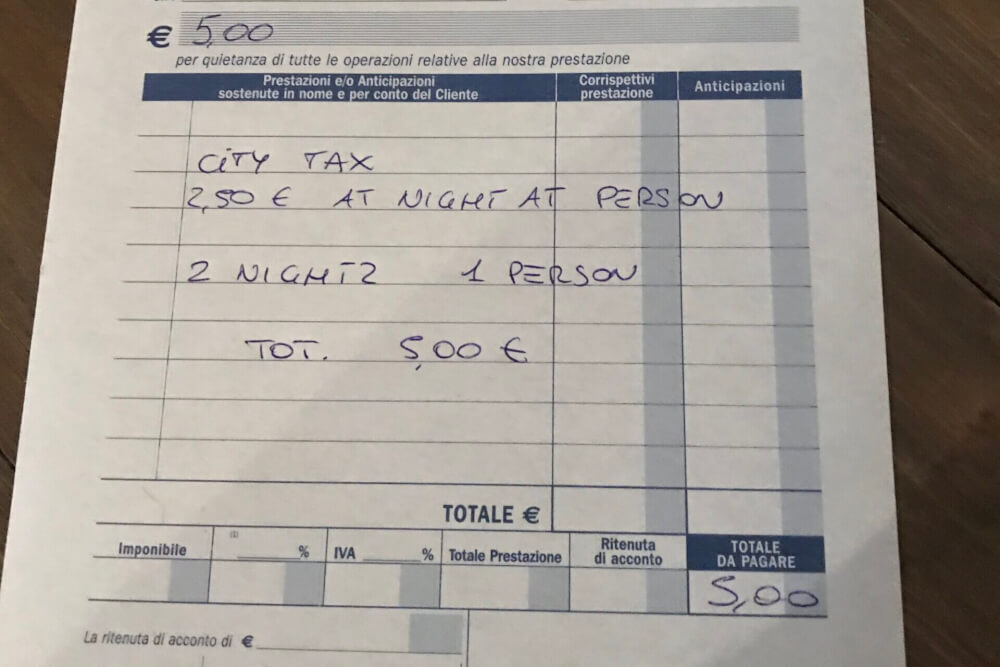
19. Make sure you have cash
While we’re chatting about money, I have to say this as well: when you get to Italy, one of your first orders of business should be to get some cash out. Preferably in smaller denominations (like 10 or 20 euro bills).
While card payments are a lot more popular these days in Italy than say, ten years ago, there are still a lot of old school businesses that prefer cash, especially for smaller purchases (i.e. the many, many gelatos you’ll be inhaling).
Having coins is also ideal for situations like vending machines or paid public bathrooms.

On that note…
20. Prepare to pay for the bathroom
Yes, sadly the ‘pee for free’ mentality is increasingly dwindling in Italy.
While some free public bathrooms do exist here, paid ones are becoming more common and usually cost between 50 cents to a euro. So be sure to have some coins on you in case of a urinary emergency.
Otherwise, make sure you do your business at a museum or restaurant before you leave. Even paid public bathrooms can be tough to find sometimes!
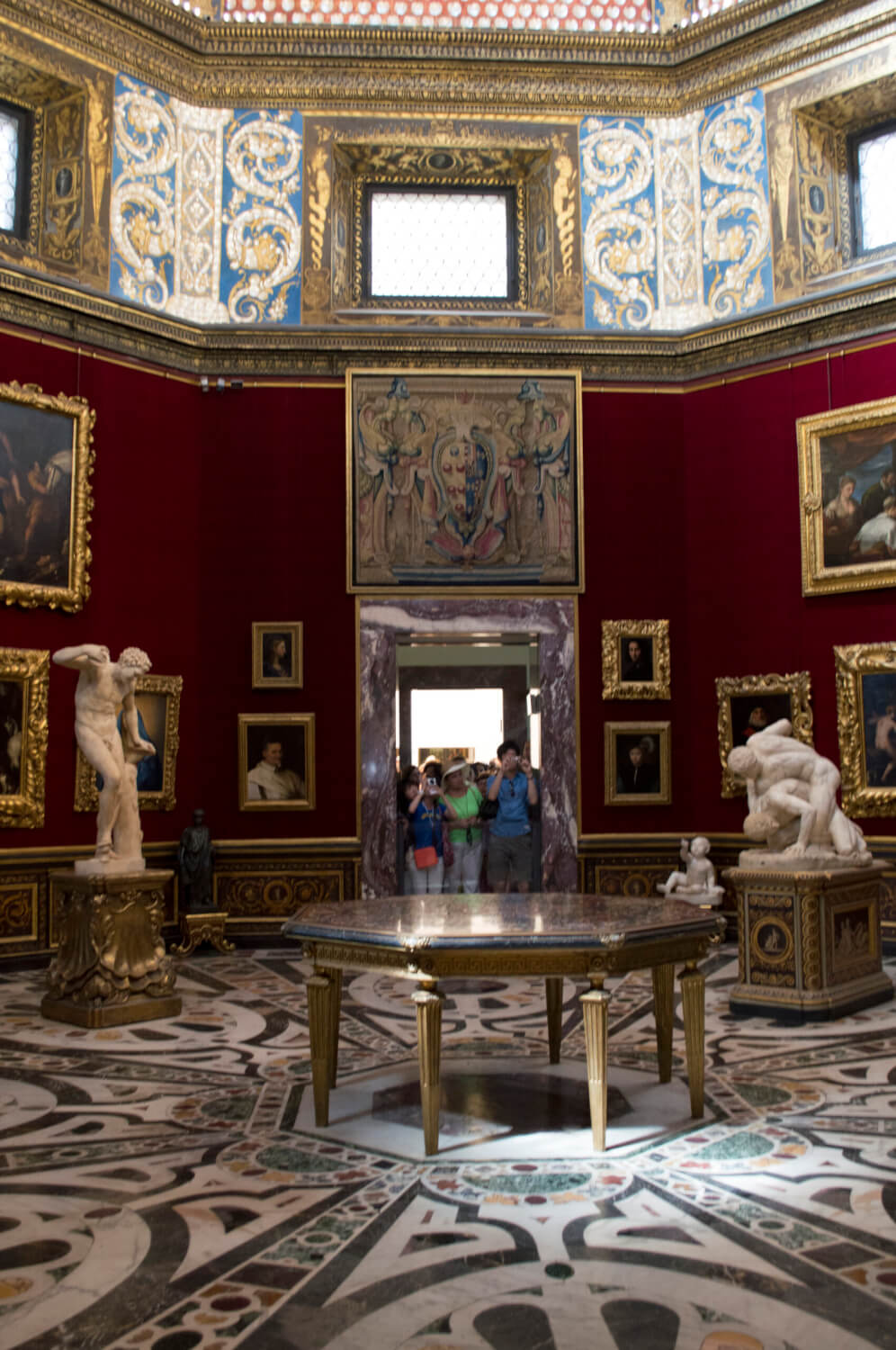
21. Be prepared for random toilet flush locations
Italian toilets can be strange. Perhaps it’s just bad luck on my part, but I’ve been caught out multiple times over multiple trips by bizarre flushing mechanisms that take a while to understand.
So, prepare for inconsistency.
Sometimes you’ll walk into a bathroom to find a standard pull flush, sometimes it’s a separate wall mounted flush OR sometimes it’s a pedal on the ground or a random button on the wall.
Overall, it can really vary, so before you panic, take a good look and see if there’s anything nearby that is pressable – odds are that’s the flush.
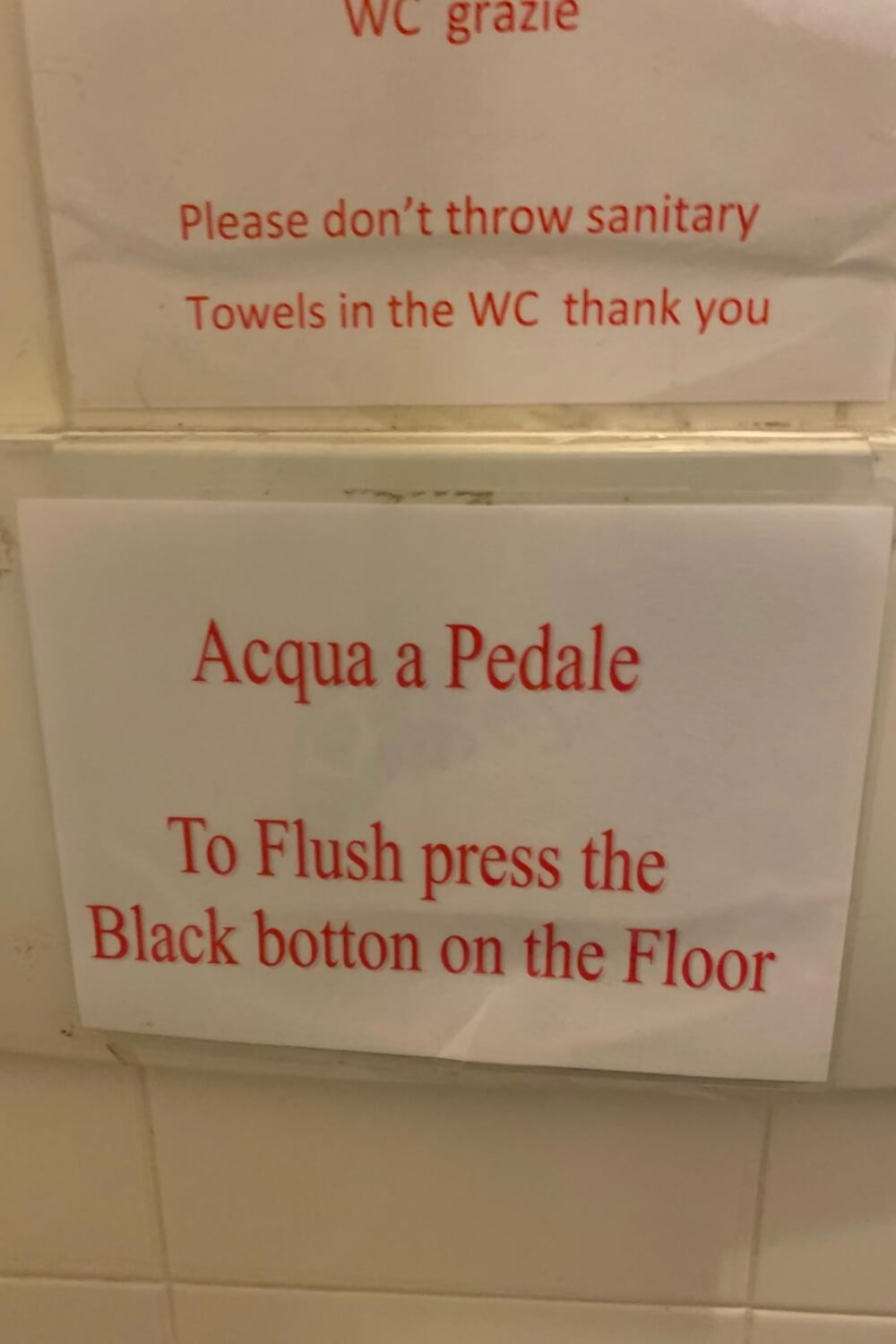
22. Dine far away from tourist locations
This is one of my top Europe travel tips for any destination, but especially in Italy, I’ve found that the closer restaurants are to tourist hotspots, the pricier and more mediocre the food.
Of course, there’s exceptions (I’ve written previously about where to eat near tourist attractions in Rome ), but avoiding restaurants on main squares or overlooking major landmarks is usually a good idea.
The logic makes sense of course – restaurants in these areas are usually targeting tourists who will never come back, so customer retention is clearly not as much a priority as other restaurants that may cater to a more local demographic.
Often, all it takes is a short walk a few blocks away to find food that is much cheaper, and much tastier too.
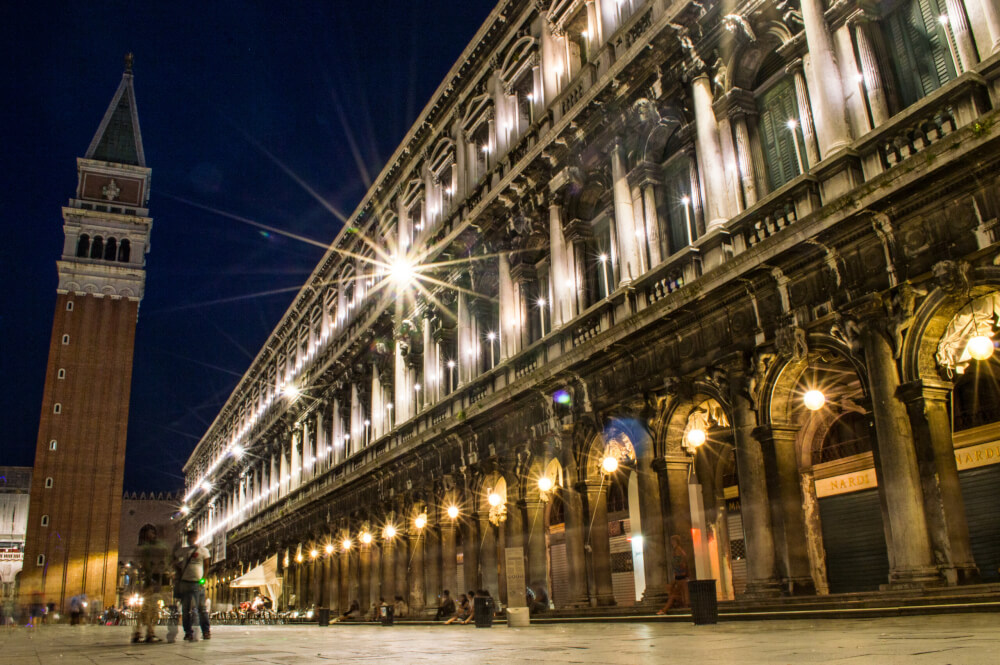
23. Learn how to spot tourist trap restaurants
Of course, tourist trap restaurants can exist outside of main squares/hotspots too… so how can you quickly and efficiently weed these out?
Well, there are usually a few tell tale signs in Italy that a restaurant is (probably) going to be a tourist trap, or at the very least, a place that caters more to a tourist demographic.
Here are a few to look out for:
- Menus and signs only in English, rather than Italian (or a BUNCH of menus out front in various languages)
- Large photos of the food outside/on the menu
- A persistent host standing outside trying to get you to sit down
- Big signs advertising appealing tourist perks like Free WiFi
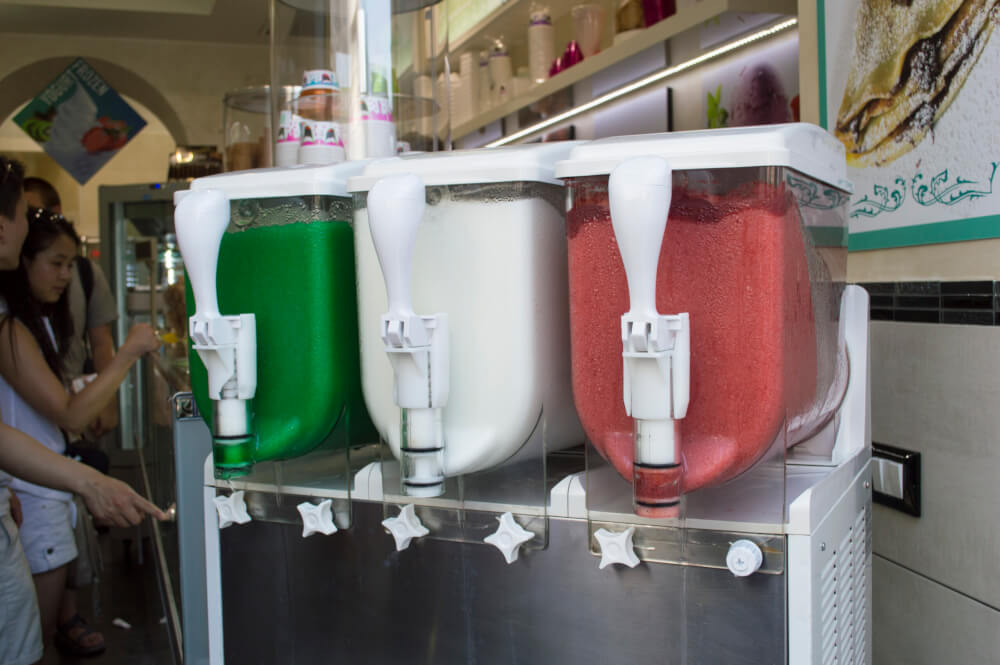
24. Order based on the regional specialties of where you are
When in Italy, the urge to simply order pizza and pasta until you explode is… admittedly, tough to resist.
But the truth is, what we in North America know as Italian food is just a very surface level understanding of Italy’s cuisine.
In reality, Italy is a country with exceptional regional diversity, and most regions and even cities have their own specialty dishes that they excel at.
So, before you simply plonk down and order a pizza everywhere you go, consider what that region specializes in and give that a try. I promise your tastebuds will thank you.
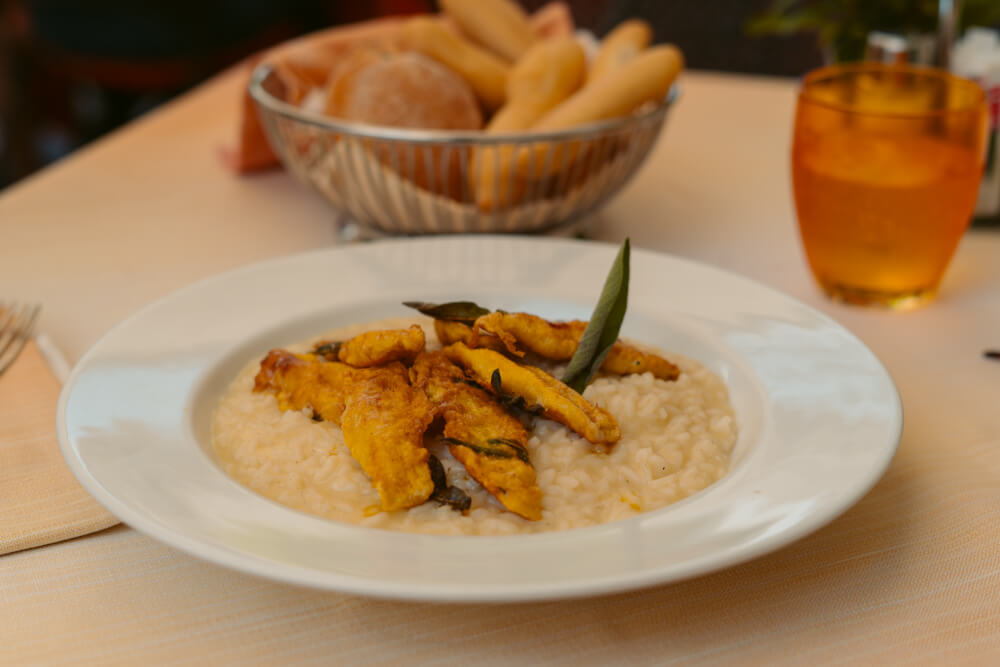
25. Don’t order or look for Americanized Italian classics
I feel like I’m about to break a lot of hearts with this Italy travel tip, but here goes: I’m very sorry to say that many of your favourite “Italian” dishes may not be offered in Italy at all.
Spaghetti and meatballs? Chicken fettucine alfredo? Garlic bread?!
Sadly, none of the above are actually Italian dishes served in Italy, but rather Americanized iterations of Italian classics that (while delicious) are not typically found in traditional Italian restaurants.
Luckily, there’s no shortage of delicious Italian dishes to try, and many of your favourites are probably based on some kind of Italian staple, so do a little research before you head out.
… and if you DO see any of these American-Italian classics on a menu, then take it as a sign that the restaurant caters more to tourists than to locals.
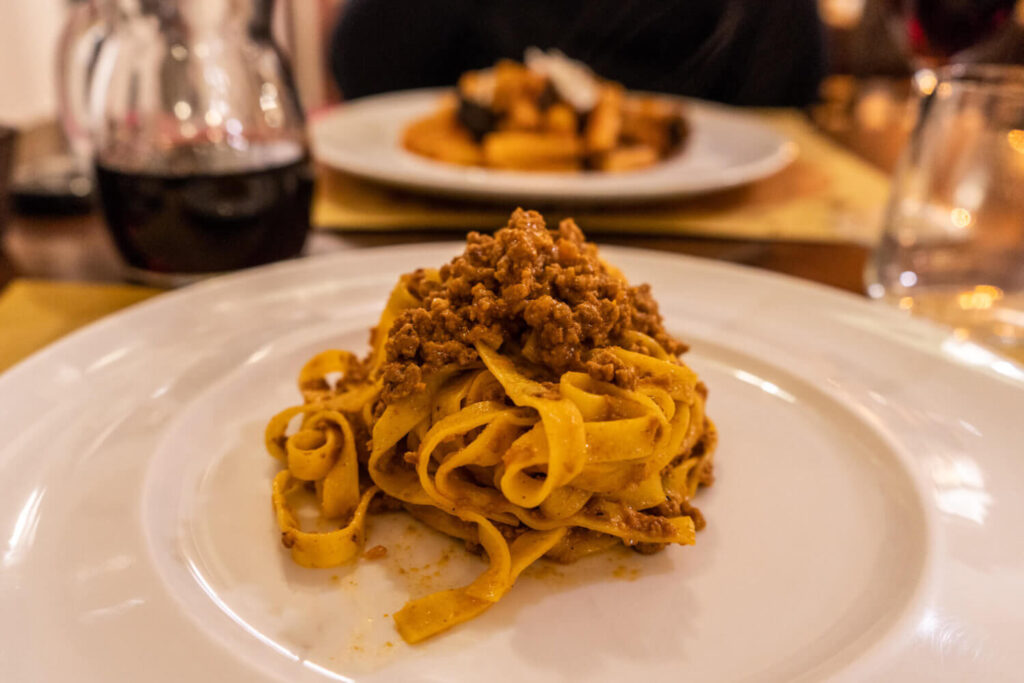
26. Know that the word “menu” in Italy has a second meaning
If you’re used to the word “menu” solely referring to the list of dishes you can order at a restaurant, then you should know the word also has a second meaning in Italy.
Often times, an Italian “menu” refers to a set meal that includes multiple courses, so if you see something like “Menu – 25 euros” that means they are offering a set deal that is 25 euros for multiple courses, not that every dish costs that much.
Ordering a “menu” in this way can often be a more cost-efficient way to enjoy a multi-course meal, so if you’re looking to splurge on a budget, that’s definitely something to consider.

27. Understand the basic structure of an Italian menu
Alright – now the fun stuff! Ordering at a restaurant!
Once you get the hang of them, Italian menus are fairly easy to understand, but can be confusing for first timers so here’s a quick crash course.
The standard structure of an Italian menu goes according to courses, which are normally shown in the sequence they would come during the meal, namely…
- Antipasto: Appetizers like cured meats, cheeses, etc.
- Primi: Usually a carby dish like pasta or risotto
- Secondi: Usually a meat-based dish
- Contorni: Side dishes like roasted vegetables
- Dolci: Desserts
But hey, before you force yourself to pick four courses every time – know that practically speaking, it IS completely normal to just have a Primi (a plate of pasta is plenty filling on its own) or a Secondi with a Contorni rather than follow through with something in every course/category.
But hey, if you want to pursue a four course feast in the name of cultural appreciation, that’s an endeavour I’m happy to endorse as well.
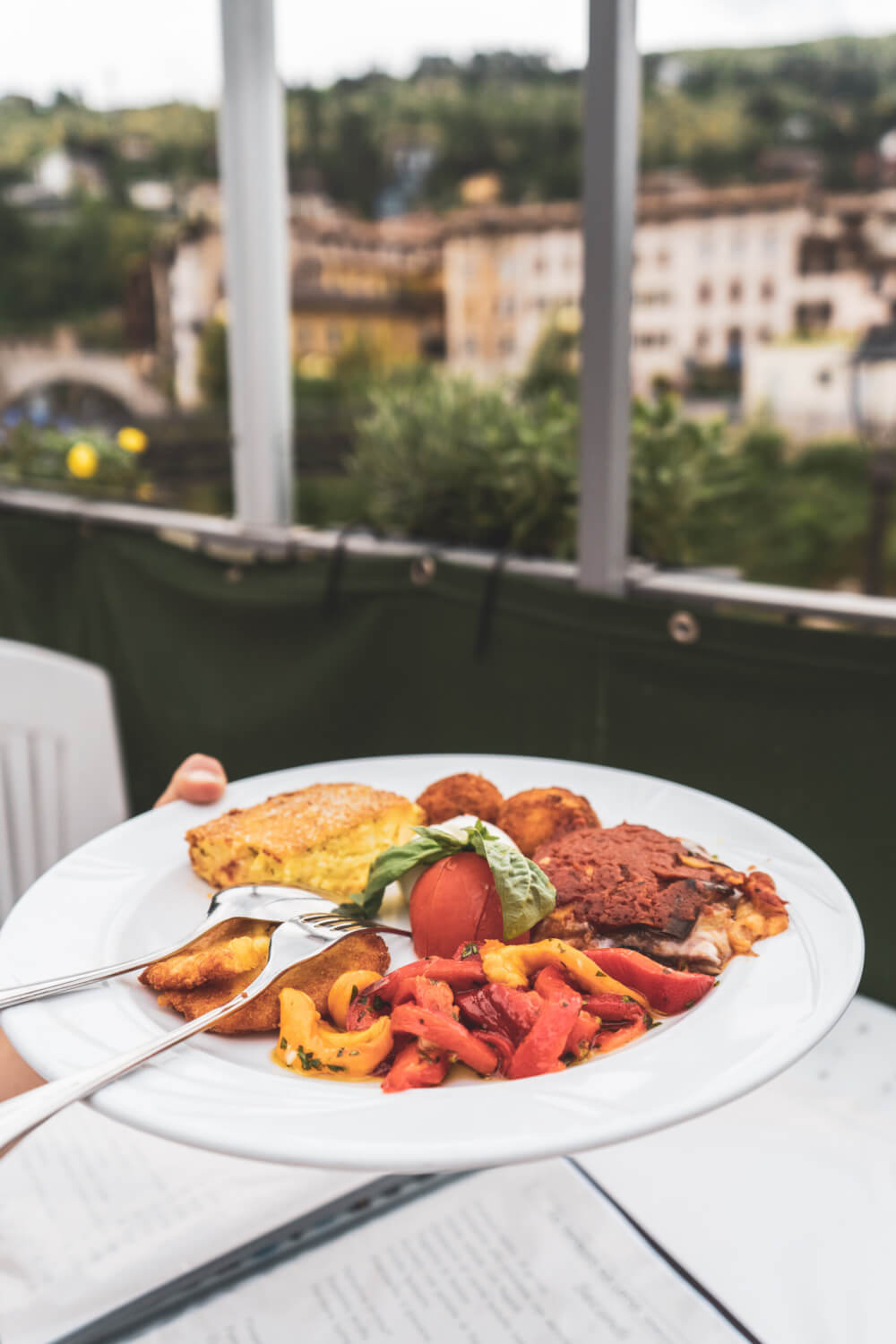
28. Beware that many restaurants close between lunch and dinner
Unlike North America where restaurants often stay open all day, it’s common for restaurants in Italy have a mid-day break ( Riposo ) between lunch and dinner, typically between 1-4pm.
During my first trip to Italy, my friends and I referred to this harrowing period as “the food desert” during which all our attempts to secure food were thwarted by a parade of “CHIUSO” (closed) signs.
If you (or your travel companions) suffer from Hangry Hangry Hippo Syndrome, this is an important thing to take note of.
Of course, in larger cities, there will often still be options available, but (from experience) the more traditional restaurants will usually be shut during this in-between period.
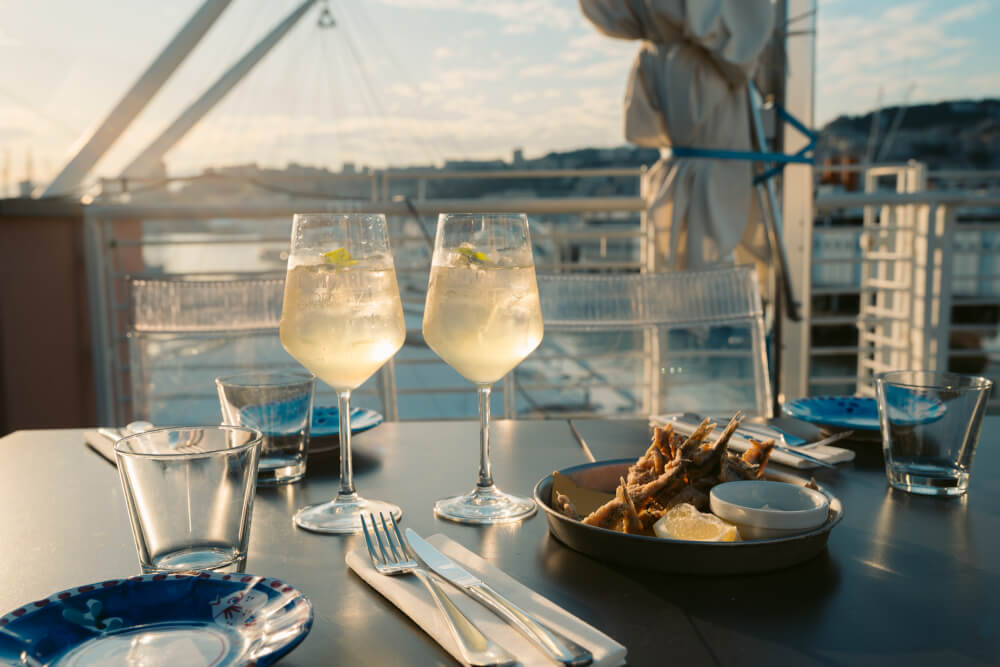
29. Make reservations
For popular restaurants, this is a must. Many restaurants in Italy are small and have a limited number of tables, and unlike in North America, many don’t set aside a section for walk-ins.
So, if there’s a particular restaurant you had your heart set on, booking in advance is key. If you feel nervous to do it yourself over the phone, you can always ask someone at your hotel to help you out, or (in the case of bigger cities) try to find places that take an online booking.
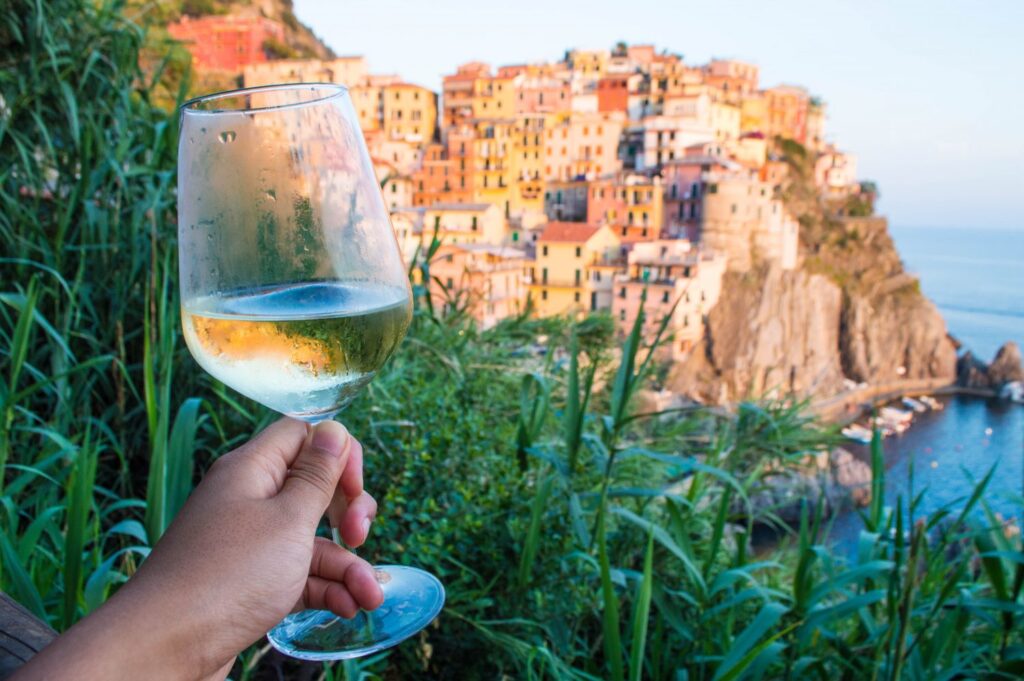
30. Expect slower service
The pace of meals (and accordingly, of service) can be a lot slower In Italy than what you’re used to.
Remember, in Italy, meals are meant to be savoured and enjoyed over a few hours, and the assumption is you want your own privacy, so they’ll rarely come in to check on you after they’ve taken your orders/brought your food.
So, if you need anything like another drink, or additional food, make sure to take the initiative and get your server’s attention – they’ll probably ignore you otherwise.
In fact, it’s even considered rude to bring the bill without asking in Italy, so if you’re hoping to pay and leave, make sure you ask for the bill, rather than expect it to come.

31. Take advantage of the free water fountains everywhere
Another great tip for saving money in Italy? Don’t waste money on bottled water.
Across the country, you’ll find free drinking fountains supplying delicious water for all, so bring a refillable bottle to take advantage.
… Or do as I did on a particularly hot day in Rome, and simply drink cupfuls with your hands like you’re cosplaying an ancient farmer after a hard day out on the fields (trust me – it’s more refreshing this way).
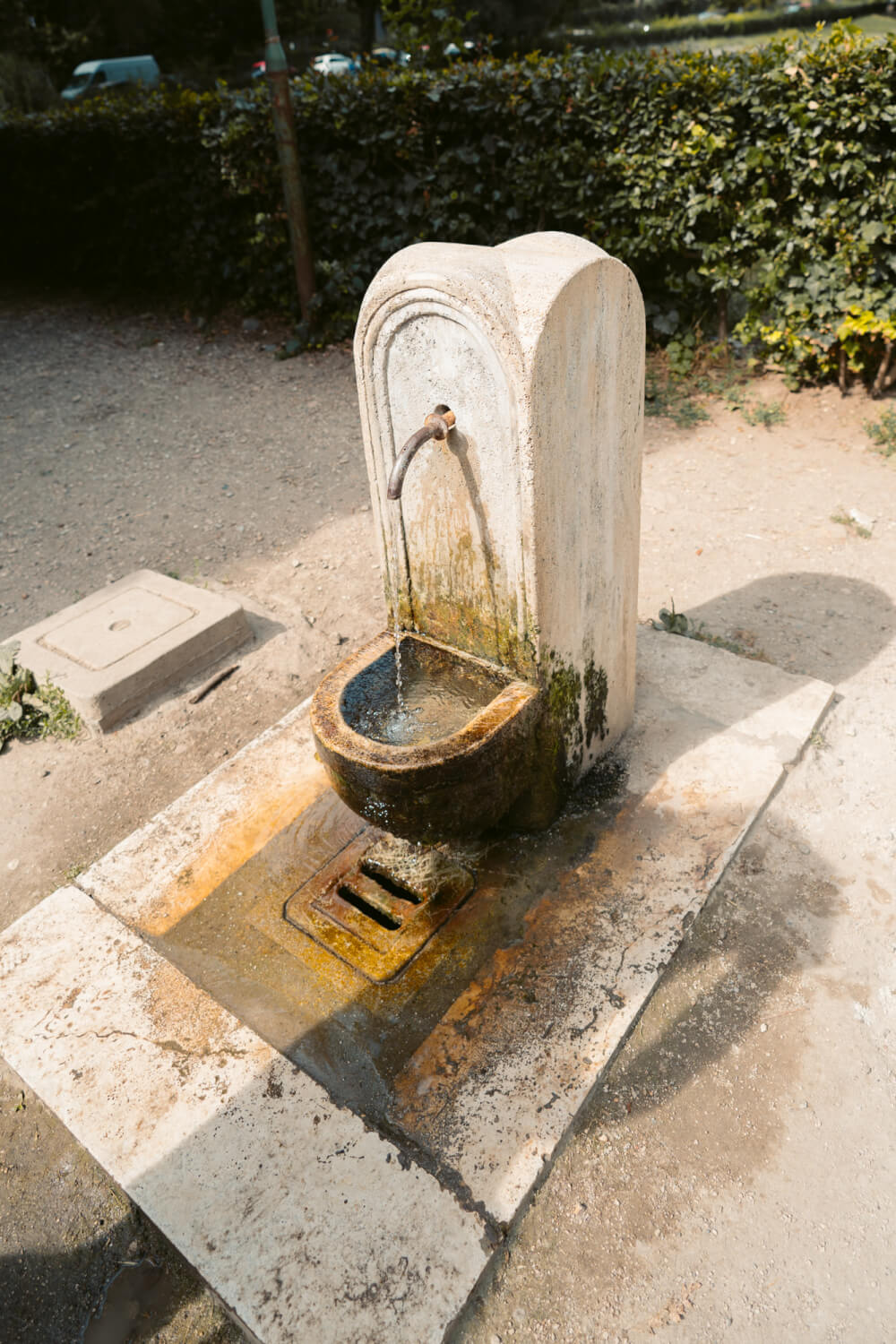
32. Be prepared to pay for water in restaurants
Funnily enough however, while free water is available in abundance from fountains on the street in Italy, water isn’t usually free in restaurants. This is because bottled water is the default, and most places won’t offer tap water as an option.
So, when the waiter asks you if you’d like water, know that you’ll likely be charged a small fee per bottle (usually 2-3 euros for a big one.
And be sure to specify whether your want still or sparkling! I tend to go for sparkling – it makes every meal feel like a mini-celebration.
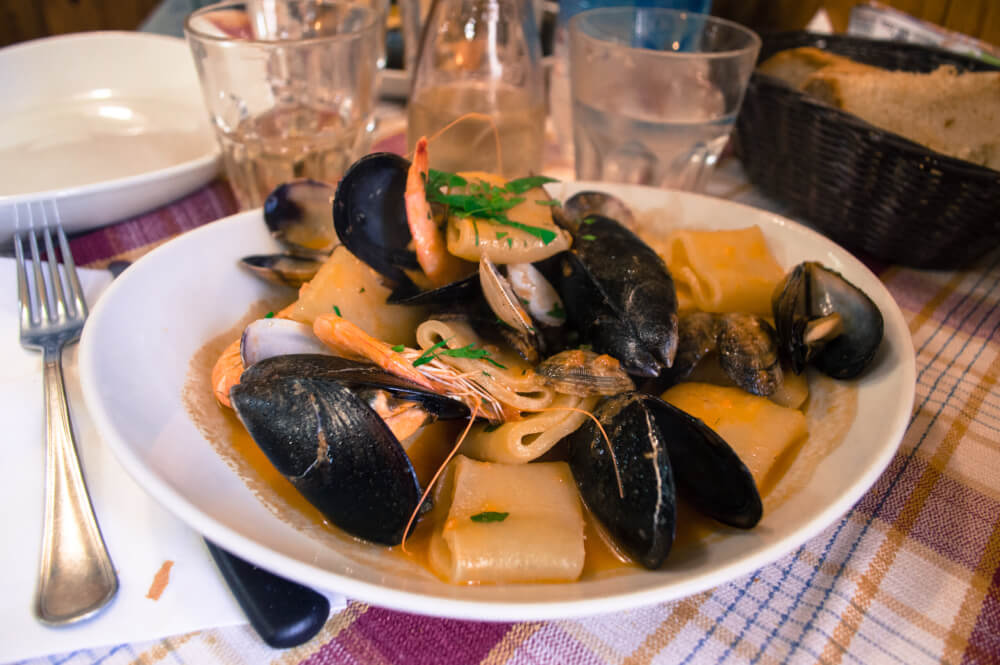
33. Be prepared for the “coperto” charge
Besides water, another charge to be mindful of is the ubiquitous Coperto .
Most restaurants in Italy will charge an additional fee per person (around 2-3 euros) as a “Coperto” charge.
You can think of this a service/sit-down fee, usually including bread too.
This is not a scam – it’s fairly standard, and evens out as tipping culture in Italy is very modest compared to North America, with rounding up or 5-10% being the max.
Take note that this also means oftentimes sitting down to enjoy your coffee, treat, etc. will cost more than taking it away (because a coperto charge does not apply unless you occupy a table). This is why you’ll see most locals consuming their coffee at the bar counter, rather than at a table.
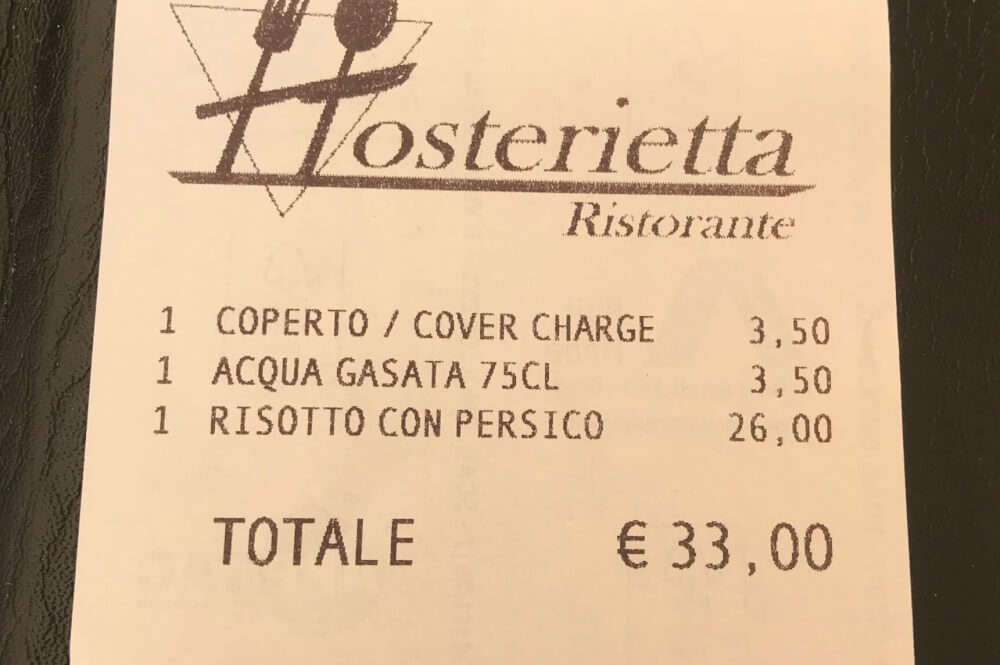
34. Expect breakfast to be small and sweet
… Just like me 🙂
Anyways, if you’re a hot, savoury breakfast person like I am, then you may face a wave of disappointment when you get to Italy.
Unlike their lavish lunches and dinners, Italians treat breakfast as a relatively modest affair. A standard Italian breakfast may be a coffee or cappuccino with a pastry, plus a juice. Not a single egg in sight!
Of course, if this is a dealbreaker for you, many hotels doing continental breakfasts will offer more familiar options – as will some more contemporary cafes in bigger cities.
But if you want to start your day like an Italian, a cappuccino and cornetto is the way to go.
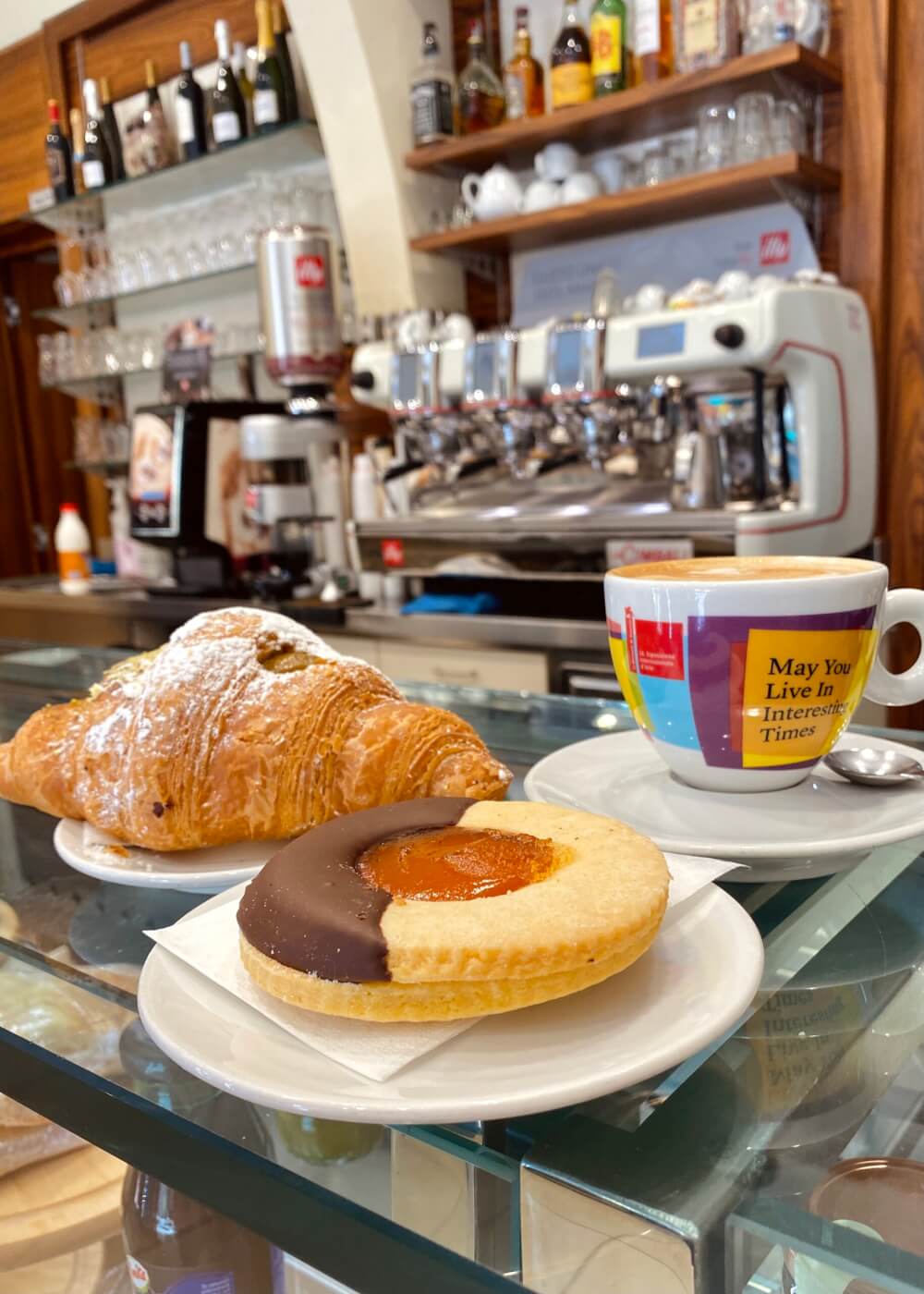
35. Make sure to enjoy Aperitivo
From denim jeans to espresso machines, Italy is responsible for a lot of the world’s most wonderful inventions… but perhaps none is more enjoyable than the almighty Aperitivo.
An Aperitivo is a classic pre-dinner ritual observed across Italy. It refers to a pre-meal drink intended to whet your appetite for dinner.
How to aperitivo depends on where you are. Some places will bring you a free snack or two while you enjoy your drink, while some others will offer a full-on buffet for you to graze at while you enjoy your cocktails.
No matter how you do it, it’s one of the best ways to unwind after a long day of sightseeing, so be sure to partake… if even just in the name of cultural education 😉
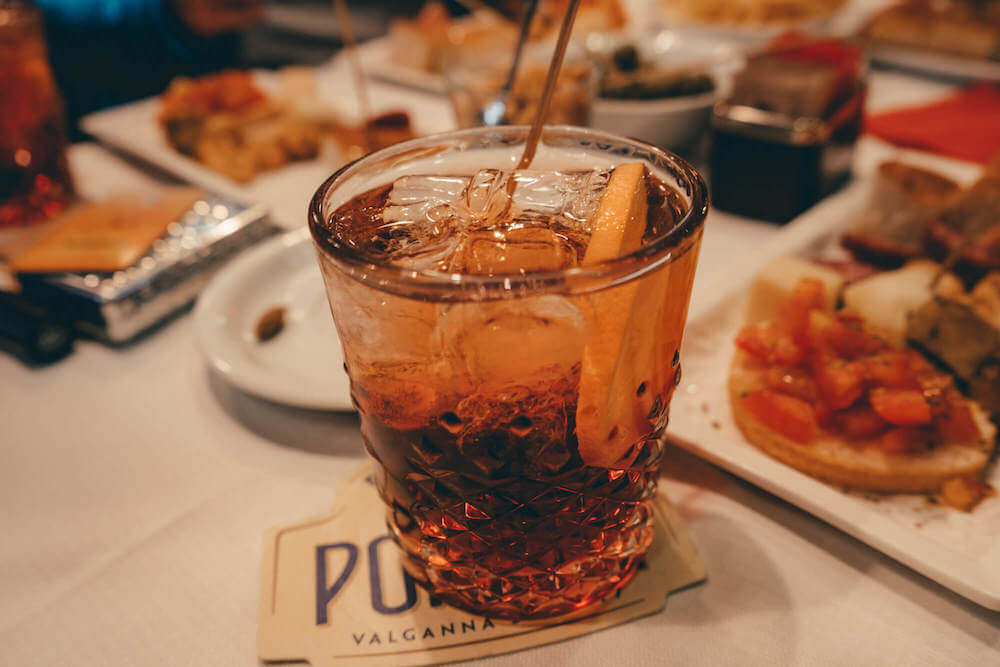
36. Familiarize yourself with Italian coffee culture
Speaking of cultural education, it’s time we tackle some Italy coffee tips.
Italians take their coffee seriously, with proper caffeination being a pleasure firmly weaved into the fabric of Italian culture and society.
And while you may think you know coffee from, you know, chugging it by the gallon every morning, there’s a lot of things about Italian coffee culture that commonly catch visitors off guard.
So, here’s a quick list of must-knows for drinking coffee in Italy:
- If going out for coffee, you would be going to a “Bar”, not a “café”
- Coffee is most commonly consumed on-site, usually standing at the counter of the bar. Getting coffee to go isn’t common
- The standard order (Caffè) refers to an espresso shot, not a drip or filter coffee. This kind of coffee isn’t typically offered at traditional coffee bars – instead ask for a Caffè Americano.
- Cappuccinos are typically a breakfast drink – ordering one after 11am is considered a faux pas, especially after a meal
- In contrast, a Caffè (espresso) is very common after a meal to help with digestion
- Lattes do not exist – ordering one may get you a glass of milk as that’s what “Latte” means in Italian. Instead, for a coffee with milk, order an Espresso Macchiato
- Lastly, “Iced coffee” isn’t a common order at traditional coffee bars. Common alternatives include Crema al Caffè, an amazing coffee slushie, or Affogato al Caffè which is gelato topped with espresso
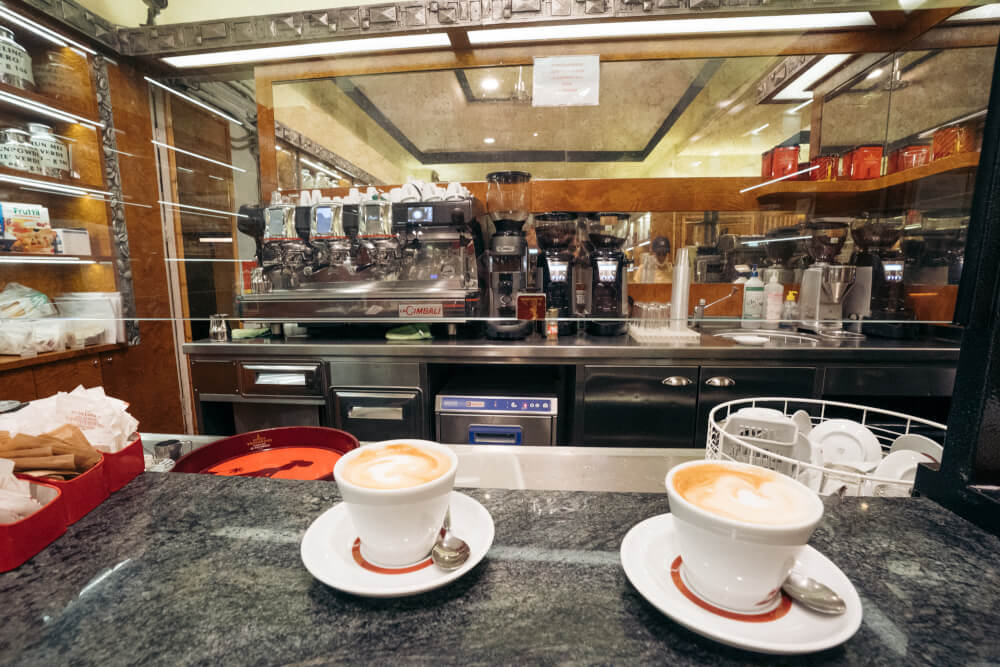
37. Don’t order pepperoni pizza
Niche Italy food tip, but an important one. If pepperoni is your topping of choice back home, just know that in Italy, “peperoni” literally means “bell peppers”.
Which is how you end up getting something like this:

For a North American style pepperoni pizza, instead, the closest thing to look for is pizza with salami.
38. When in doubt, get the house wine
Choosing a wine in Italy may seem like a daunting endeavour, with plenty of tantalizing options and a wild range of prices.
But hey, if you’re a total cheapskate like me and also lack a refined wine palette – the choice is easy! Go for the house wine.
Unlike in North America (where ‘house wine’ is just whatever near-rancid bottles they have left), house wine in Italy is almost always delicious and best of all, budget-friendly.
Plus it’s usually served in a jug which feels wonderfully Middle Ages.
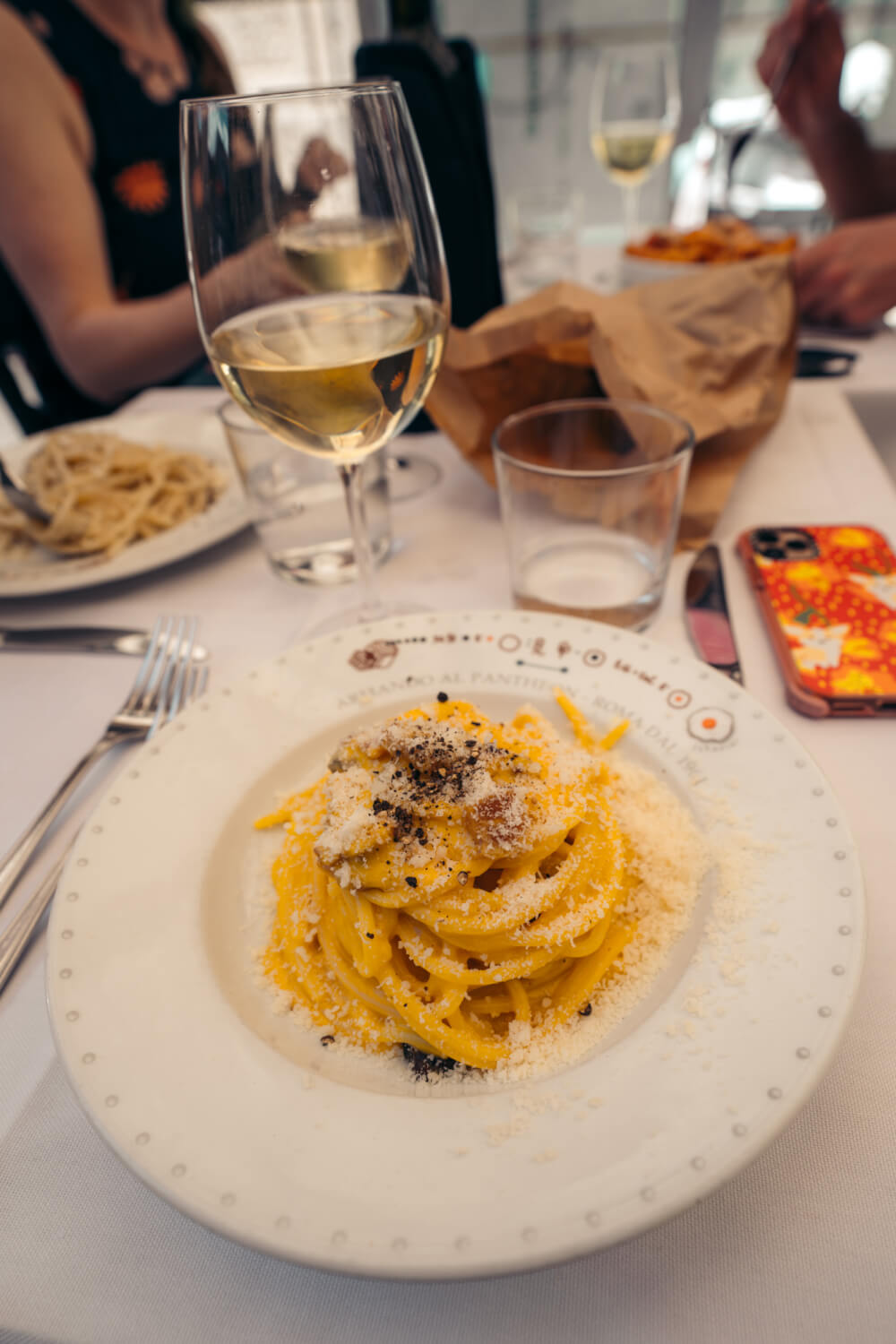
39. Avoid the pretty, colourful gelato
Lastly, I need you to be strong, because this final Italian travel tip is tough to obey.
… But please, as difficult as it is, do NOT give into the hypnotism of the beautiful and vibrant gelato mounds that beckon you from touristy gelato shops.
I’m talking places like this:
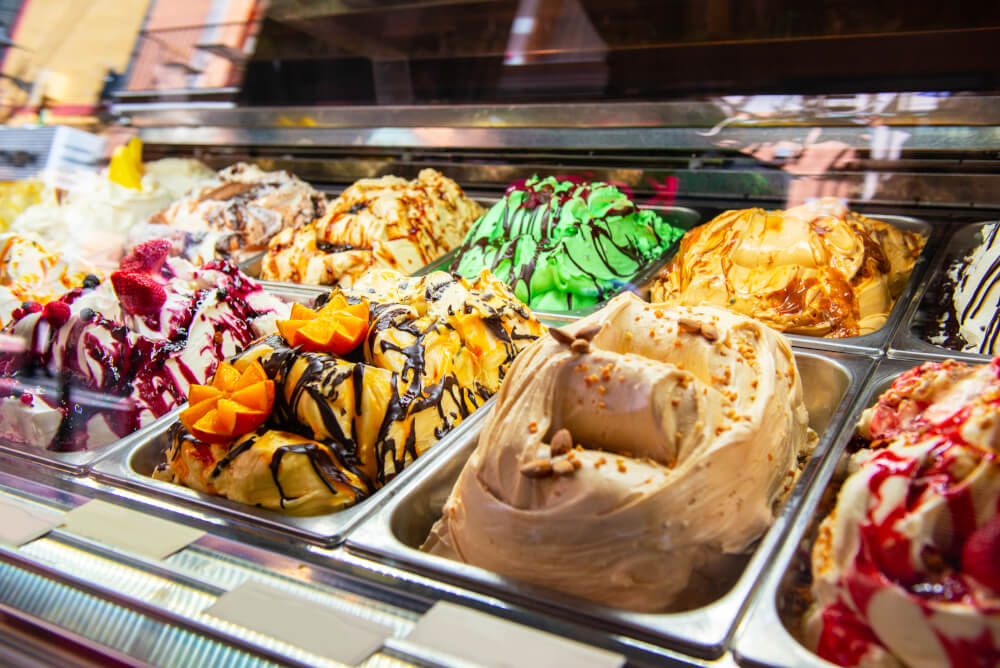
Usually, these places with the vibrant gelato mountains topped with decorations are beautiful to look at, but not the best gelato to eat.
That’s because their eye-catching nature usually indicates a lot of artificial colouring and (if there’s huge stacks of it), likely a lack of freshness as well.
In contrast, what you’re looking for are covered metal containers with flat lids. This indicates the gelato is being kept at the right temperature (and on a less technical note, that they take this stuff seriously).

The colours should also be paler and more natural, like so:
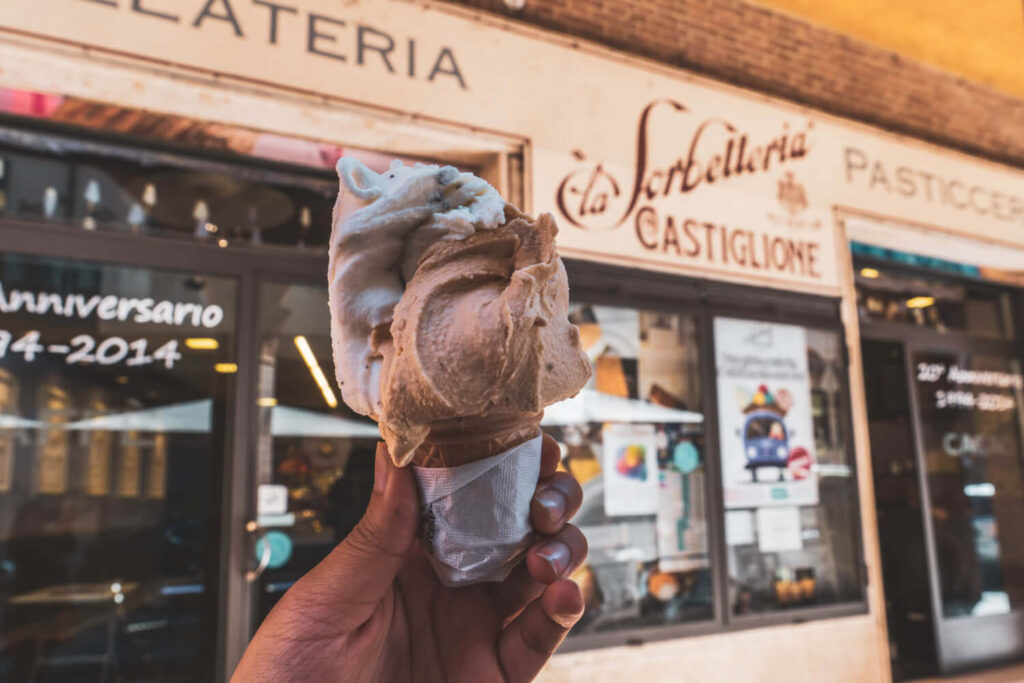
I hope this list of Italy travel tips was helpful!
Admittedly, this was a VERY long list of tips for Italy, so if you’re here, I’m beyond proud of you! Hopefully by now, you’ll feel much more prepared for your big Italian vacation, but if you have any more questions, let me know in the comments.
My Go-To Travel Favourites:
🧳 Eagle Creek: My favourite packing cubes
💳 Wise: For FREE travel friendly credit cards
🍯 Airalo: My go-to eSIM
🏨 Booking.com: For searching hotels
📷 Sony A7IV: My (amazing) camera
✈️ Google Flights : For finding flight deals
🌎 WorldNomads: For travel insurance
🎉 GetYourGuide: For booking activities
1 thought on “30+ Italy Travel Tips for First Timers & Must Knows Before You Go”
My goodness! This is amazing! Thank you so much!
Leave a Comment Cancel reply
By using this form you agree with the storage and handling of your data by this website. *
- Work with us
- Favorite travel blogs
- netherlands
- switzerland
- family travel
- food and wine
- trip planning resources
- accommodation guides
- travel gear guides
- itineraries
- packing guides
- travel gifts
- health and safety
101 Essential travel tips for Italy
This article may contain compensated links. See our full disclosure here
Buon giorno! Whether you are visiting Italy for the first or tenth time, it’s always exciting.
Before you depart, let’s make sure you are ready.
After countless trips to our favorite country, we compiled this bumper list of things you should know when traveling to Italy.
Our travel tips for Italy include advice on Italian culture and etiquette as well as practical information about transport, accommodation and much more for your trip.
What's in this article
Italy is a big and diverse country
Italian language tips, italian culture tips, food and eating in italy, transport and getting around in italy, money in italy, accommodation, internet access, attractions and museums, best souvenirs from italy.
From the alps in the north to the rocky shores of Sicily and all the magnificent cities in between, there are so many different landscapes and cultures to explore in Italy.
Not so long ago, you needed to catch overnight trains to cross the country. Don’t underestimate how long it will take to travel from north to south if you are straying from the major cities.
Italy only became a unified country in 1871. Prior to that, the area we know as Italy today was made up of several kingdoms who each had their own identities, culture, food and language.
These differences continue today, so much so that Italians from the north may not be able to understand southerners when they speak in their local dialect.
However, in most situations these days everyone speaks standard Italian.
While many people, particularly in tourist areas, speak and understand English it is the polite thing to do to try and learn some basic Italian phrases. People always appreciate it when you make an effort with their language.
Always greet people when you enter a shop, restaurant or attraction. Saying Buon Giorno! (good morning) to everyone you meet is an essential part of Italian culture and it is considered rude if you don’t make this small effort.
Learn a few words
Here are the most basic phrases you should know:
These days there are many tools to help you learn how to use and pronounce words. We like Duolingo a free online tool that can help you to learn Italian at your own pace.
If you want to get up to speed quickly, this Italian language course for travelers has great reviews.
While on the road you can’t beat Google Translate – it even helps you with pronunciation.
If you are traveling with kids, Italians love it when your children call out Buon Giorno! and Grazie! Our children quickly learnt that this was a sure fire way to score a few treats – extra scoops of gelato and lollipops
Communicating isn’t just about words
Watching people speak to each other in Italy is so entertaining. Italians use their faces and hands to communicate as well as words. Decoding the signals takes some practice so here’s a fun video to get you started.
I’ve also learnt over the years, especially being married to someone from an Italian background, that speaking loudly and in what I consider to be an angry tone does not necessarily mean the other person is angry or picking a fight.
It’s just part of the communication process.
Out of bounds topic
Thanks to books and movies, many people are fascinated with the Italian mafia and their impact on daily life. This is not a subject you should raise in Italy.
The mafia are a series of organised crime groups that operated mainly in the south and in Sicily. People in the north are not interested and find the topic distasteful. In the south, you don’t know whose toes you might tread on. It’s a subject best avoided.
If you are stuck for conversation topics, just talk about food. Italians love talking about what, where and with whom they are eating.
Despite their differences, Italians have some cultural norms you should be aware of when you visit. Italy is a conservative Catholic country and loud raucous behaviour, and particularly drunkenness is not well received.
In fact, there are now laws in place to fine tourists who disrespect national monuments like the Trevi Fountain in Rome and Piazza della Signoria in Florence by going for a swim or using them as a toilet. Which is as it should be.
Italians have an essential concept in their culture known as “ bella figura ” meaning – the beautiful figure. It refers to presentation and how one is perceived.
Bella Figura drives the Italian way of dressing and their attention to grooming but it also refers to behaviour. Knowing how to behave and showing good manners is an important part of this concept.
How to dress in Italy
Italians are snappy dressers and will always make an effort to be well groomed and look sharp. They wear fitted, pressed clothing (even jeans) and wear classic styles and neutral colors. You rarely see Italians in sports clothes on the street and I have never seen anyone wearing flip flops.
What not to wear
If you don’t want to stand out as a tourist in Italy then you should follow the following rules:
- don’t wear sports clothes, yoga pants or sweats unless you are exercising
- flip flops are for the beach only and will not support your feet over cobblestones
- if you must wear sneakers make them stylish – like these ones
- avoid very bright colors and big logose
- very tiny shorts and skirts are not recommended
Instead, wear this in Italy
Stick to neutrals (navy, black, white, grey) and well fitted clothes. Then accessorize for the season. Your sunglasses and a scarf will get you through most situations.
Above all, bring comfortable shoes.
More information on how to dress in Italy including a capsule wardrobe and packing list in our Italy packing guide .
Visiting churches
You are sure to be visiting at least one church on any trip to Italy. After all, they are the cultural hub of every town and village in the country.
Be respectful and make sure you cover up. That means no bare shoulders or knees. So tank tops, short skirts and shorts should not be worn. You must also remove your hat.
While in a church, try to remain silent or use a very low tone of voice if you need to speak. Refrain from eating, drinking and chewing gum inside churches.
Afternoon walk or “La Passeggiata”
One of my favorite traditions in Italy is their afternoon walk known as La Passeggiata. Italians of all ages take a leisurely early evening walk or stroll, just to socialize and catch up on all the local news.
Between the hours of 5 and 7pm across the country, from the smallest towns and villages to the grand piazzas of Rome and Florence, locals mingle and stop for a chat with friends and family before dinner.
Join in the fun but be sure to make an effort with your presentation ( bella figura ) and take it slow, stopping for a pre dinner drink or gelato as the sun sets.
You can’t talk about Italian culture without talking about food. Italians love their food – talking about what they are going to eat and what they have eaten is one of their favorite pastimes.
For example, my Italian mother-in-law has an ongoing conversation with her best friend about how to make a certain type of cookie. That discussion has been ongoing for over 50 years!
Note that Italian food is really something only foreigners discuss. Italian cuisine is regional, each area has its own local traditions, cooking methods and dishes.
For example, Milan and the Lombardy region are famous for risotto while pizza was invented and is most traditional in the south. While in Venice they enjoy small bites called cicchetti that are a bit like Spanish tapas.
Read our food guides: Rome , Venice , Brescia and Sicilian desserts
Must try experience – a local Italian food festival – sagra
When you are in Italy, embrace this culture, taste the local dishes and enjoy every last bite. I don’t know why pasta and gelato taste better in Italy, they just do!
Meal times in Italy
Mealtimes in Italy are quite different to what you are probably used to.
Breakfast (collazione) is eaten between 8am and 11am and is usually very light – a coffee and perhaps a small pastry (cornetto) or some fruit.
Lunch (pranzo) is served between 12:30pm and 2pm and usually includes pasta and/or protein with salad or vegetables
Aperitivo – a light pre dinner snack eaten between 5pm and 8pm – see below
Dinner (cena) is not served until at least 8pm until 10:30pm and follows the same structure as lunch.
Most Italians will make either lunch or dinner their main meal and have a panino (sandwich), salad (insalata) or even a pizza for the other meal.
Gelato may be eaten at any time of day. In Sicily they eat it for breakfast in summer! Not all gelato is great however. Learn how to find the best gelato here
Many restaurants close on Mondays
Italian menu tips
So you know how to order from the menu in Italy, here is the basic structure of an Italian menu
- Antipasti – light starters such as cured meats and olives
- Primo piatto – first course – pasta or rice ( risotto)
- Secondo piatto – second course – usually meat or fish
- Contorni – side dishes such as vegetables ( vedure) or salad ( insalata)
- Dolce – dessert such as cake or gelato
Do NOT feel obligated to eat a full 3 or 4 course meal. It is not necessary – unless you want to of course!
Tourist menus are likely to be quite ordinary and are best avoided.
The menu will indicate if there is a cover charge (coperto) – a standard charge of a couple of euros for your seat and bread (even if you don’t eat it). It is non negotiable.
There may also be a service charge (servizio) of 10% particularly in tourist areas.
Tipping is not expected (especially when there is a service charge). You leave your change to the nearest dollar if you like.
Drinking water
Italian tap water is safe to drink. You will also find drinking fountains in the major cities. Rome, Florence and Venice all have perfectly safe, clean and free drinking water in town squares. You can take your own bottle and fill it up unless there is a sign reading ‘ acqua non potabile ‘.
We recommend these collapsible water bottles – perfect for staying hydrated during a long day sightseeing.
At restaurants tap water is not common. You can order still ( naturale ) or sparkling ( frizzante ) water and it usually comes in a 1 litre bottle.
Lost in translation – Italian food quirks you should know
Some foods we think of as Italian are really versions or adaptations of dishes for our tastes and palates. Here are some food items you might find confusing:
- Insalata verde directly translates as green salad and if you order it you will get a bowl of lettuce
- Spaghetti and meatballs is not a dish you will easily find in Italy
- Fettucine Alfredo is an Americanized version of a very simple pasta dish ‘pasta in bianco’ that you won’t find on any menu
- Bread is not a pre dinner snack – it is there to wipe up the juices left on your plate
- Bread is not served with oil and vinegar or butter as general rule (see above)
Click to learn more about Italian food culture
Coffee culture
Italy has the best coffee in the world. Do not expect a giant Starbucks style latte as you won’t get it. What you will get is a strong and aromatic brew. Italians drink coffee throughout the day and into the night.
Coffee types
- Un caffé – 20 – 25ml of espresso coffee. This is what will be served if you ask for a coffee
- Cappuccino – one third espresso, one third steamed milk, one third froth – considered a breakfast drink
- Caffé latte – hot milk mixed with a dash of coffee – breakfast drink
- Caffé americano – espresso coffee with added hot water served in a larger cup. Also known as a long black in Australia
- Caffé macchiato – espresso coffee with a drop of milk
- Caffé doppio – double espresso
The rules on coffee
- At most coffee bars you need to pay at the till, get a ticket and then repeat your order to the server behind the bar
- Cappuccino and caffé latte are considered breakfast drinks and not consumed after 10:00am – drinking lots of milk after this time is considered to be bad for digestion
- You pay a surcharge to sit down at a cafe and consume anything (including water). This does not apply when standing at the bar
I love aperitivo! Served between 5 and 8pm, aperitivo is a tradition that began in Milan. At its most basic, aperitivo is a drink such as wine or a cocktail, such as the classic Aperol Spritz, served with bar snacks such as chips or olives. They are included in the price of your drink.
These days the concept has evolved into something more elaborate. Some bars now offer a buffet for aperitivo or higher class snacks.
Italian wine
Wine is taken very seriously in Italy and is always accompanied by a meal or as an aperitif. As a general rule, Italians do not drink to get drunk and this practice is considered rude – see bella figura above.
Table wine or house wine is generally quite acceptable (and cheap if you are on a budget). Just ask for a glass (bicchiere) or bottle (bottiglia) of vino bianco (white wine) or vino rosso (red wine).
Sometimes house wine is served in a tumbler at more humble establishments. If you get a wine glass it will be served half full as standard practice.
If you are taking your wine drinking a little more seriously (and why not!), Italy has 15 major wine producing regions and over 1 million wine growers. You are spoilt for choice.
Some favorite and famous Italian wines are:
- Prosecco – a light sparkling white wine from the Veneto region
- Chianti – red wine made from 80% sangiovese grapes from Tuscany
- Barolo – Italy’s most expensive red wine from the Piedmont region
- Pinot grigio – a crisp white wine from Lombardy
If you want your sommelier to help you choose your wine, ask for
- Vino rosato – rosé wine
- Vino secco – dry wine
- Vino abboccato – semi-dry wine
- Vino corposo – full-bodied wine
- Vino dolce – sweet wine
Look out for enotecas – wine bars. They are the best places to try local wines.
Food allergies and preferences
If you are managing food allergies and preferences you might be surprised to learn that they are easily accommodated in Italy.
Gluten intolerance in particular is a health issue for Italians, so many restaurants offer a gluten free alternative to their standard pasta dishes.
Vegetarians and vegans are well catered for too. There are many amazing vegetarian dishes from a basic pasta with tomato sauce to more elaborate creations. My favorite is melanzane parmigiana (eggplant parmigiana)
If you are lactose intolerant or vegan, you should be able to get your daily cappuccino with soy milk. Try asking for ‘un cappuccino con latte di soia per favor’.
Many pizzas come without cheese too. If you are in any doubt ask for your pizza senza formaggio (without cheese).
Look for some of the bigger gelato chains like Grom in the major cities as they offer dairy free gelato.
A special note on seafood allergies – we learnt the hard way that even if you are far from the sea, anchovies are sometimes hiding in delicious olive tapenade.
Pork is eaten widely in Italy. Be on the lookout if you don’t eat it as this meat is preferred to chicken and is widely eaten especially at lunchtimes.
Tips on dining with kids in Italy
There really are none except that you will rarely see a kids menu. Just order a half serve from the main menu.
It’s an absolute pleasure dining out as a family in Italy. Kids are so well catered for.
Restaurant staff will ensure they are fed and have a drink before you on most occasions. Meals arrive quickly and there’s usually some pencils for drawing. Our kids have sometimes been given little presents too.
Public restrooms can be difficult to find in Italy.
More often than not, when you do find one, you need to pay a small charge to visit the restroom in public spaces in Italy. This charge could be from 50 euro cents to €1.50. You can expect these facilities to be cleaner than standard public restrooms in your country.
While you are visiting museums use the facilities – you just never know when you are going to get another opportunity. They also usually have decent changing facilities for children and babies which is a rarity in Italy.
If there is no public facility close by then duck into the nearest cafe or restaurant and ask for ‘il bagno per favore’. We always try to buy something small for their trouble.
Always carry toilet paper or tissues. Always.
If you are traveling with small children bring a foldable change mat.
The best way to travel between the cities of Italy is by train. You can buy tickets easily at the station but if you prefer to book in advance using an English language site we recommend Omio (formerly GoEuro) or Italiarail .
Tickets are usually cheaper when booked in advance if you can commit to a set day and time of travel.
Most city centres in Italy are very walkable but if you need to use public transport then the system is pretty standard across the country.
Buy bus or tram tickets from a nearby tabaccaio or street kiosk and train tickets at the closest station. Tickets are generally valid for a set time unless you buy a day pass and you must validate your ticket once on board . In Rome, for example, a single €1.50 ticket is valid for 75 minutes.
Warning – you must validate your train ticket for it to be considered usable. Big fines apply if you do not
There are often no lifts or escalators in train stations so be prepared to haul your luggage up a couple of flights of stairs
Taxis and Uber
Taxis are generally a little expensive but they are controlled by the government and are a professional service. Look for white or yellow cars with a taxi sign on the roof.
Hailing taxis is not common. You need to find a taxi stand and wait for one to arrive or enter the first car on the stand.
If you need to call a taxi use the My Taxi app
Surcharges apply at airports and major train stations like Rome Termini
Tipping is not usual although you may give a euro or two if the driver has been particularly helpful
Uber is available in larger cities like Rome and Milan. You can use your app just as you would at home.
Airport transfers
If you are traveling in a group of more than 3 with large luggage we recommend booking an airport transfer. Taxis are not able to accommodate large parties.
We recommend Suntransfers and Black Lane for airport transfers in Italy and Europe for their reliable service and affordable prices.
Detailed transfer information:
- Rome airports to city center – read here
- Venice Marco Polo airport to the city – read here
Driving in Italy
The Italian countryside is so beautiful and the best way to explore the small towns and villages is by car. Italian drivers have fearsome reputations though don’t they?
Don’t worry, driving in Italy is not as difficult as you think. We wrote a full guide with our Italy driving tips – you can read that here
Make sure to bring your International Driving Licence if you are traveling from outside Europe
We use and recommend Car Rental by Booking.com to rent cars in Italy.
The currency in Italy is the Euro €.
Italy is a modern country with the financial services you would expect at home. You will find ATMs (called bancomat in Italian) that use the Visa, Mastercard, Cirrus and Maestro systems everywhere.
Credit cards are widely accepted in hotels, restaurants, shops and autostrada tollbooths. Where you might come unstuck is relying on American Express and Diners Club which are not widely accepted
It’s always wise to carry a small amount of cash for small cafes, pizzerias and restaurants (trattorias), some transport and taxis
Read: why you need travel insurance for Italy
Tipping in Italy
Tipping in Italy is not expected. This applies to all situations.
A service charge (servizio) may be added to your restaurant bill (in addition to the coperto cover charge). In this case tipping is absolutely not required.
If there is no service charge you could leave a few euros or add 10% for a smart restaurant. Many people leave small change when ordering a coffee at a bar
Tipping is not required for taxis or services at most hotels although is commonplace at luxury 5* hotels
We have always felt extremely safe traveling in Italy. Police known as carabinieri are highly visible and have an extra strong presence at the main attractions and in city centres.
The general emergency number in Italy is 112. You can also call these numbers for:
- Police – 113
- Fire – 115
- Medical – 118
The usual rules apply however. Avoid being alone in dark places at night time, particularly if you are a solo female traveler.
Pickpockets
Unfortunately where there are crowds you will find pickpockets. Petty thieves do target tourists in busy areas such as train stations and tourist attractions in Italy.
To keep your belongings safe, stay alert and keep an eye on your belongings at all times. I carry a crossbody bag so I can keep a firm grip on it when in crowds.
Do not go sightseeing with valuable and keep your passport in your hotel safe. You can read our full guide to avoiding pickpockets in Italy here .
Tourist scams
In general, if someone is trying to give you something for free, it really isn’t and they want cash in return. As in any country with large numbers of tourists there are enterprising individuals at all of the major sights ready to make a quick buck.
My favorites are – people dressed up in Roman soldier costume ready to pose for your vacation snaps (there is a fee – we fell for this one), guys with small gifts for your children – animal carvings, bracelets etc (there is a fee), ladies with little bouquets of flowers they would just love to give you (there is a fee).
Always buy tickets and tours from licensed vendors. If you are stuck in a line at one of the major attractions it is tempting to try and jump the queue when you are offered skip the line tickets, bear in mind they may not be genuine.
Instead, be organized and book your tickets in advance. We use GetYourGuide to book tickets, tours and attractions in advance throughout Italy and Europe – you can read our full review here .
One of the most delightful things about traveling in Italy is you can stay in historic buildings and old palazzos.
What could be more romantic than waking up staring at a beautiful fresco and opening shuttered windows out onto a piazza?
Take note, rooms with views are more romantic, rooms without views are cheaper.
Hotels, apartments, villas.. and more!
There is a broad range of accommodation in Italy. From upscale and boutique hotels to city apartments and bed and breakfasts and country villas.
We mainly use Booking.com to find and book accommodation in Italy as you can search through almost all accommodation options to find the one that best suits your needs.
One type of accommodation you may not be familiar with are agriturismi – a great option if you want to explore the Italian countryside.
At its most basic, an agriturismo is a farm stay – local farmers rent out their rooms for additional income and your room rate usually includes a (delicious) home cooked meal.
You can also find luxury farm stays that a more like mini resorts with a pool, restaurant and gardens. We have used this option several times now and recommend them to everyone we know.
Check this site for agriturismi around Italy. We find the site a bit clunky for booking purposes however and you can usually find the same properties on Booking.com
Practical things to check
Make sure you check for the following things when booking accommodation in Italy:
- Do you need a lift? Many hotels and apartments, do not have lifts so you may need to negotiate several flights of stairs to get to your room
- Do you feel the heat? Air conditioning is not as standard as you might hope in a country that experiences very hot temperatures in summer
- Read reviews to understand room sizes as these can be quite small in Italy
- Need a hearty breakfast? Breakfast is usually a very light meal in Italy so look for hotels that offer an American style breakfast
The fine print
Many Italian cities charge a city tax of 1 to 5 Euros per person, per night. Often, this charge is payable in cash so make sure to read the terms and conditions before booking. Some hotels may include this in their daily rate, others won’t.
Check the booking engine you are using for the fine print on payment. Many apartments require cash payment in Euros in arrival.
Wifi and wireless mobile is widely available in Italy at reasonable speeds. Public free wifi is usually slower and less reliable however.
If you traveling from outside Europe (where charges are limited by European law) and are going to be in Italy for a couple of weeks, you may want to consider buying a local SIM card so you can avoid paying data roaming charges.
Local SIM cards are easily purchased throughout Italy. Note – You will need an unlocked cell phone to do this and you will need to show proof of identity eg your passport, to buy one
We prefer to buy a prepaid SIM prior to departure and recommend OneSimCard who offer prepaid international SIMs with up to 85% savings on roaming charges and fast shipping so you can be organized prior to departure – click here for more information
Stores are generally open from 09:00am to 13:00pm and from 16:00pm to 20:00pm. There is a break in the early afternoon for riposo (a traditional mid afternoon break)
Many stores close on Sundays and Monday morning although this is less common
The main supermarket chains in Italy are Carrefour and Conan – you can find small branches open 24×7 in the big cities.
When selecting fresh produce at supermarkets – use the plastic gloves provided, then weigh your goods and collect the printed sticker with the price from the scale before proceeding to the checkout.
At markets, the vendors will select the produce for you – do NOT handle the goods
Most pharmacies are open from 8:30 to 12:30 in the morning and from 15:30 to 19:30 in the afternoon. You may find some pharmacies that open at night, holidays and Sundays, but this is the exception not the rule
American Express and Diners Club are often not accepted in Italian shops
Bring your own shopping bag or expect to pay a 5 to 15 cent fee per bag – plastic bags were banned in Italy in 2011
Many museums and churches traditionally shut on Mondays so it is wise to check in advance whether they will be open during your visit.
Italy’s main attractions are incredibly popular and it is not uncommon to wait in lines for up to 3 hours to buy a ticket. For this reason we recommend booking skip the line entrance tickets in advance.
You will also need to pass through strict security checks. Do not big large bags or backpacks with you.
Here is a list of the main attractions and where to buy tickets using online booking engine Get Your Guide which we find much easier to use than trying to navigate the Italian museum sites.
- Colosseum (includes Roman Forum and Palatine Hill) – book tickets here or a guided tour here
- Vatican museums – book tickets here or a guided tour here
Click here for our guide to recommended tours in Rome
- Uffizi Gallery timed priority entrance – book tickets here or a guided tour here
- Accademia Gallery for Michelangelo’s David – book tickets here
- Milan cathedral and rooftop tickets – click here
- Da Vinci’s Last Supper tickets – click here (must book at least 2 months in advance)
- St Mark’s Basilica – book tickets here or a guided tour here
- Doge’s Palace – book tickets here or a guided tour here
In my opinion, the best souvenirs from Italy are food products. I only found out quite recently how easy it is to bring food stuffs back within the EU and to the United States and Canada. Sorry Australians, our quarantine laws make this impossible!
Stores across the country are used to vaccuum sealing cheeses and meat products so they stay fresh for a long time. You can also buy pasta, herb mixes and other delicacies like truffle salt to bring with you.
Glassware from Murano, carnevale masks from Venice and paper goods and leather from Florence are popular too. Italian craftsmanship is highly regarded due to the skills they have developed over many centuries. Do check the products are made locally though and not cheap imports.
I loved the vibrant ceramics from the Amalfi Coast and Sicily. In that region you can also buy extremely well made leather sandals.
But having said all that, my favorite souvenir from Italy is a cliché tea towel with pictures of different pasta varieties on a map of the boot. You can get those anywhere, and they are light!
I hope you enjoyed reading our travel tips for Italy. If you have any other questions be sure to let us know!
Disclaimer – Untold Morsels assists our readers with carefully chosen product and services recommendations that help make travel easier and more fun. If you click through and make a purchase on many of these items we may earn a commission. All opinions are our own – please read our disclosure page for more information.
The creator, writer and photographer behind Untold Morsels , Katy has been travelling and tasting the world since she was a teenager.
Now the proud mum of twins, she hopes they grow up to share her passions of great food, wine and travel. Favourite destination: Italy

33 Italy Travel Tips That Will Save You Time, Money and Disappointment
Avoid tourist traps and have authentic experiences with these top italy travel tips.
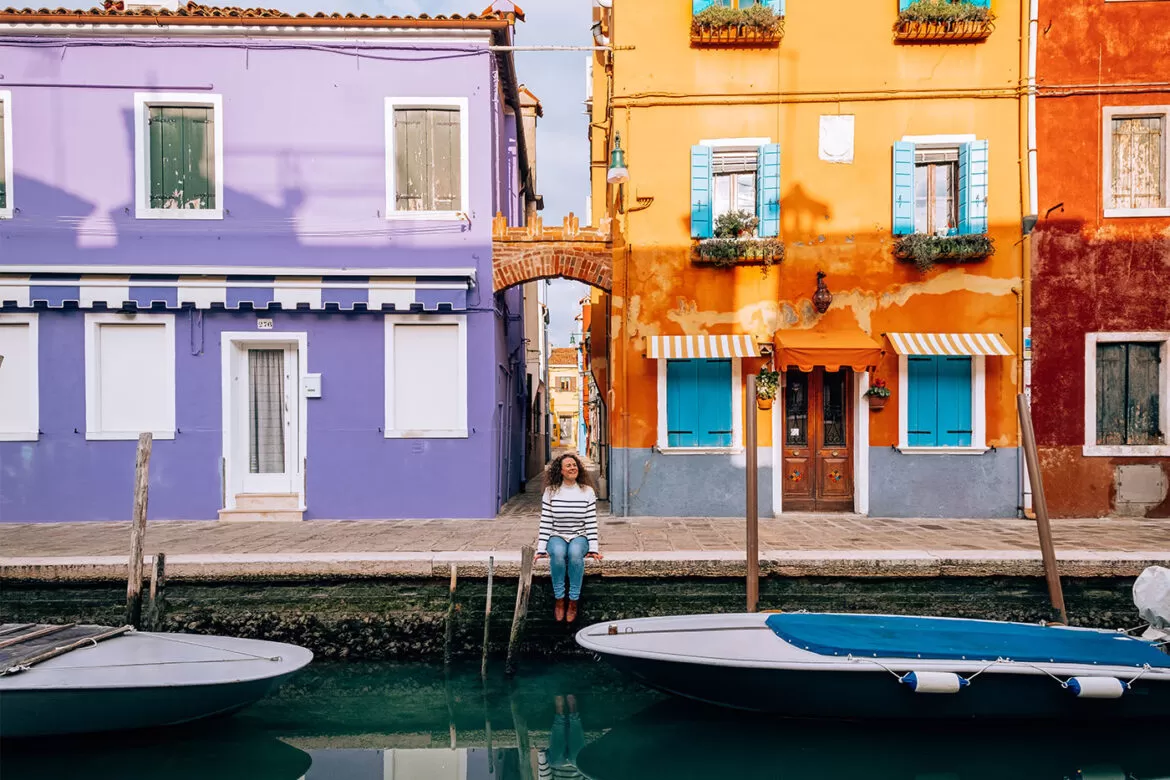
With over 50 UNESCO world heritage sites, 3 active volcanoes, over 1500 lakes, excellent food, top-notch wines and the smallest restaurant in the world (that’s right: it can only seat two people!), Italy is one of the most popular destinations for travellers around the world. Despite being a relatively small country, Italy really has something for everyone: gorgeous beaches, stunning cities, archaeological sites, art, countryside and mountains.
It’s not uncommon to experience so-called culture shocks , which are nothing more than cultural diversities, customs or local peculiarities that can cause visitors to feel in over their heads. Sometimes this can lead to scams, paying too much, and general disappointment or confusion.
There’s so much to know about Italy and consider before planning a trip, but don’t worry: whether you’re a first-timer or a returning visitor, here’s everything you need to know before travelling to Italy!
In this guide, you’ll find 33 Italy travel tips and hacks divided into categories which will help you make the most of your time and avoid possible challenges you’ll run into while visiting Italy. Knowing these things will ensure you have a safe and enjoyable stay on each one of your trips. Want more tips? Get my complete guide to 101 Italy travel tips here.
Tips for getting around, travelling and transport in Italy
- Pack light. Steps, inclines, cobblestones, narrow hotel staircases: getting around Italian cities can be a struggle with lots of suitcases and heavy luggage. Whatever your travel style, choose appropriate bags to make sure your arrival and your stay go smoothly. If you’re visiting places like Venice , you will also need to be able to carry your luggage on waterbuses and up flights of stairs as lifts/elevators are very rare.
- Wear comfortable shoes. For the same reason mentioned above, you’ll make your life a lot easier by wearing comfortable shoes when you’re out and about. If you plan to visit Venice, don’t forget you might need a pair of stivali di gomma , rubber boots, when high water occurs in lower-lying parts of the city such as sound Piazza San Marco.
- Validate your train ticket. If you’re travelling by train in Italy, make sure you validate your ticket before getting on the train. Italy doesn’t have turnstiles at its train stations, it is up to you to validate your ticket in the machines (usually green or yellow) located near the entrance to each platform. Hefty fines apply to those travelling with an unvalidated ticket! Emergency tip: If you can’t find a machine, it doesn’t work, or you’re in a hurry, the next best thing you can try is to write on the ticket the time it was last used. This might just be enough to convince a ticket conductor on board that you intended to do the right thing.
- Book high-speed trains in advance. High-speed trains in Italy are called “frecce”, like Freciarossa, Frecciabianca, Frecciargento . Bookings usually open 120 days before your trip. It’s always a good idea to buy tickets in advance to ensure you get a cheaper price. You can get your tickets on the Trenitalia website which is the official Italian rail network ticket provider. There is also Italo , the official private seller of the Italian high-speed train company.
- Beware of transportation strikes. One word sciopero (pronounced: shoh-peh-roh ) this is the Italian word for strike and a must-know term. Strikes have become part of daily life in Italy so don’t be shocked if there’s a strike of some sort that may affect your travel plans. Be prepared and pay attention to signs, especially in train stations. Usually, strikes are announced ahead of time so you have the chance to think of a plan B or C.
- Be aware of parking lines. Before parking your car, always check the colour of the lines. White means it’s a free or time-restricted free parking (in this case you need to display a disco orario , that is, a parking disc or clock disc showing the time at which the vehicle was parked). Yellow parking lines mean that the space is reserved for residents in that area or street and it’s forbidden to park there unless you have a permit. Areas marked with blue lines mean you need to pay to park. This normally applies on weekdays and Saturdays but not on Sundays and public holidays, but it’s always better to check the signs. Just like for the motorways, bring some coins, as some parking machines do not accept cards.
- Only use official taxis. All taxis in Italy are white with official markings. Standard prices are listed inside the taxi and on the door. Remember to check these to avoid being scammed. I’ve seen this happen a lot in Rome. Often at airports, you will see people trying to convince unassuming tourists to get a ride with them. Unless the car is white and a marked taxi, don’t risk it.
Food and drink tips
- No cappuccino after breakfast. Ordering a cappuccino together with your meal for lunch or dinner is definitely frowned upon in Italy! Italians normally have a cappuccino (or milk or caffellatte ) for breakfast, which often comes with sweet (and not savory) food such as biscuits, pastries, croissants or cereals. This is why you typically don’t order un cappuccino or any other beverage containing milk after 11 am. It’s quite common though to have an espresso , a macchiato (black coffee with a few drops of milk) or a corretto (black coffee with a tiny bit of grappa or other liquor) after a meal. Check out my guide on how to order food and drink in Italian.
- Ask for the bill. In Italy, when dining in a restaurant, you need to ask for il conto (the bill) or go to the cash register to pay. It’s considered rude for the waiter to give you the bill before you’ve asked for it as they just don’t want to rush you. Mealtime is precious in Italy :)
- Drink from water fountains. Water fountains are found in many Italian cities. In Rome, these are called “nasoni” (literally, “big noses”) and provide fresh, cool water. So there’s no need to pay for bottled water. These aqueducts have been supplying Rome with its water for thousands of years! If it’s good enough for the emperors it’s good enough for me :) Bring an empty bottle and fill it up as you explore the city.
Tips for Eating out in Italy
- Dinner is eaten late. Italians typically eat late, from 9 pm, especially in southern Italy. A restaurant serving dinner around 5-7 pm is catering to tourists and therefore the quality of food is often lower. Normally, good restaurants don’t open before 7 pm, unless they’re establishments that also serve aperitivo , a drink (alcoholic or not) that comes with crisps and other nibbles. This can be a good solution to “calm” your hunger while waiting for dinnertime or to stimulate your appetite.
- Italy doesn’t have a tipping culture. No one will judge you if you don’t tip the waiter/waitress. Although, in highly touristic areas it’s become kind of usual and some might even expect it, especially if the service was attentive and punctual, the food tasty and the overall experience pleasant. Italians will only ever leave up to 1-2 euros per person. Learn the dos and don’ts when it comes to tipping in Italy with my complete guide.
- Learn how to express your dietary requirements. Even though in touristic cities people may understand or speak some English, don’t always take it for granted. Learning how to order your meal , your favourite dish and how to express any dietary requirements (e.g. I’m vegetarian, I’m gluten intolerant, I’m allergic to peanuts) in Italian is essential and will ensure that your lunch or dinner runs smoothly.
- Don’t ask for tap water. Even though it’s common in many countries to ask for tap water in restaurants, you will get a disapproving look in Italy. It’s just not common in Italy so if you want to drink water it will be bottled. Just specify if you want it naturale (still) or frizzante/gassata (sparkling).
Italy Sightseeing tips
- Some businesses take a break during the day. In Italian cities, very rarely you’ll find a 24/7 store, let alone in small towns. While in some large shops it has become more common to have an orario continuato (non-stop working hours), generally every Italian store or venue closes right after lunch (12 pm or 1 pm) and then reopens at 3 pm or 4 pm, after the riposino (nap, rest), which is the equivalent of the Spanish siesta . Monday is usually a day off for shops, mini-markets, restaurants, hairdressers and beauty salons. Make a note of business hours, just in case.
- Check public holidays. Public holidays can affect your travel plans and the ability to visit attractions. The most important ones to know are: 1st (New Year’s Day) and 6th (Epiphany) January, Easter and Easter Monday, 2nd June (Republic Day), 15th August ( Ferragosto ), 1st November (All Saints), 8th (Immaculate Conception), 25th (Christmas) 26th (Saint Stephen/Boxing Day) December. Individual cities also have local festivities. Check the opening hours of each individual attraction if travelling during these times.
- Avoid queues. Book private tours and skip the line tickets in advance for major attractions to avoid disappointment. It’ll be a huge time saver! My favourite go-to service for finding the best-guided tours is Viator .
- Dress appropriately when visiting religious places. You will need to cover your shoulders and your knees before going into religious buildings, like churches and cathedrals or you could be turned away. Avoid carrying large backpacks as they will be denied entry or you will have to use the cloak.
Italy Safety tips
- Beware of pickpockets. Pickpockets can be terrible in some tourist areas and especially on the buses, metros and trains. Avoid the number 64 and 40 bus in Rome when travelling to the Vatican from Termini station. These lines are notorious.
- Never leave your credit card out of your sight. Don’t let your credit card unsupervised when paying for anything. I’ve heard stories of waiters taking their card to swipe using a machine “out the back” of the restaurant. Thirty minutes later, the card had been cloned and they had apparently bought 3,000 Euros worth of jewellery, paid for a taxi, purchased 500 Euro worth of sports equipment and 200 Euros of groceries all over Italy in a span of an hour.
- Always have your ID with you. In Italy, it is required by law to carry your personal ID with you. You may be asked to show it if stopped by police officers on duty.
- Learn Italian emergency numbers. Should you have an emergency while in Italy, you can call 112 (European Emergency number) for general emergencies, 113 for polizia (National Police), 115 for firefighters and 118 for health emergencies.
- Learn some basic Italian. Even though Italy is a highly touristic country, don’t expect everyone to understand or speak English. It’s a good idea to learn some basic Italian phrases for everyday situations but also in case of emergency – God forbid!
- Know where to find public toilets. To access public toilets in Italy you will often need to pay a euro or two. However, the law requires bars and restaurants to give access to their facilities for free. Common practice is to make a small purchase or to take a quick espresso drunk at the counter. Local city apps, like Veritas in Venice , will help you find public restrooms.
- Bring a plug adaptor. Check the voltage before using your appliances (remember that most hotels provide things like hair dryers anyway) and make sure you have the right adaptor for Europe and Italy. For Italy, there are three plug types, types C, F and L. Plug type C has two round pins, plug type F has two round pins with two earth clips on either side and plug type L has three round pins in a row. Italy’s supply voltage is 230V and 50Hz.
Italy Accommodation tips
- You need to pay city tax. Each person must pay city tax or tourist tax. This is not included in your bill and must be paid separately once you arrive at your accommodation. This fee is set per person per night, it must be paid in cash and is usually around 2 euros. Visiting Rome? From the Spanish Steps to the Pantheon , don’t miss my guide to the best hostels and neighbourhoods in Rome. For more tips, don’t miss my guide on the best time to travel to Italy.
- Don’t expect air conditioning everywhere. Double-check that your hotel or car rental has air conditioning, as this is not standard and usually it’s not available unless specified. When there is air-conditioning, expect it to be weak. If you are used to the US air-con standard, you will notice that Italian air-conditioned spaces feel significantly warmer than those back home.
Types of establishments in Italy
- Use plastic gloves when handling baked goods, fruit and vegetables at the supermarket. It’s a common thing in Italy to wear plastic gloves which are found near the scales. Once you pick your items, you’ll also have to weigh them yourself, enter the product code, print the sticker, and put it on the plastic bag. This can’t be done at the checkout and you’ll be sent back.
- Learn about Italian farmacie . Pharmacies in Italy are run by real pharmacists (and not just shop assistants), who give medical advice and strictly sell pharmaceutical products and health articles. Even things like aspirin are kept behind the counter. The business hours of pharmacies are typically 8 am to 8 pm and they generally have a lunch break from 1 pm to 4 pm. However, in case of an emergency, there is always a pharmacy open. You can find the address and phone number of the farmacia di turno (pharmacy on duty) written on all pharmacy doors. Pharmacies are marked by large green crosses lit by LED lights.
- Go to the tabaccherie . Tabaccherie are newsagents that sell almost anything from cigarettes and tobacco to magazines and newspapers, candy/sweets, snacks and local transport tickets. They can easily be identified by their signage: a large white “T” on a black or blue background.
Travelling with children in Italy
- Most restaurants don’t have a kid’s menu. Kids menus are not very common in Italy but this doesn’t mean a restaurant is not child-friendly. You can easily ask for a simple pasta dish or a mezza porzione (smaller portion) of whatever is on the menu, they will be happy to do that.
- Car seat for children. Not all rental companies have the full equipment for children. If you’re travelling with a baby who needs a rear-facing car seat, consider bringing your own car seat and make sure it complies with the EU safety standards.
Want more Italy travel tips? Get my complete guide which features 101 Italy Travel Tips that will save you more time, more money and disappointment .
I wish you many wonderful and memorable trips to come. Buon viaggio! (Have a wonderful trip)
Don’t be treated like a tourist. Learn Italian with my 80/20 method
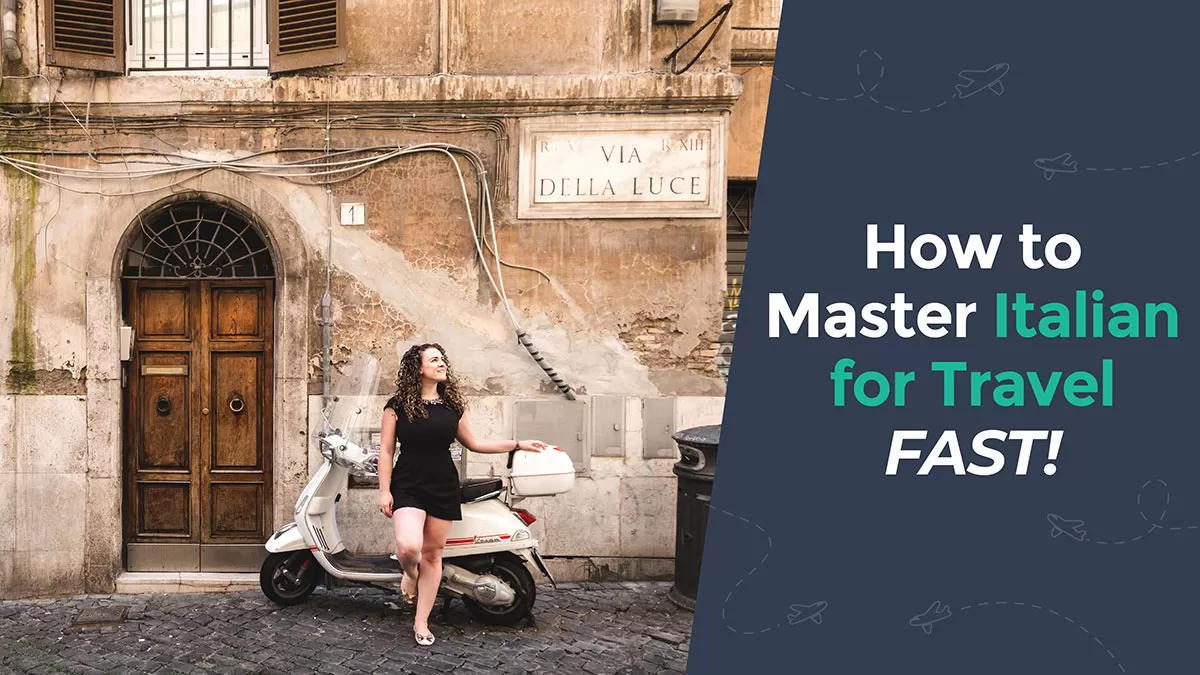
Travelling to Italy? Don’t be treated like a tourist! Live your best travel experiences and learn Italian for less than the cost of eating at a tourist trap restaurant or a taxi driver who has “taken you for a ride”. I’ve made it easy for you to master the Italian language so you can create lifelong memories as you mingle with locals , get local tips , avoid tourist traps , and make new friends . Who knows, you may even be invited over for afternoon tea by a lovely Sicilian family like I was! Read all about how speaking Italian changed my life and check out my online Italian video course here.
Here’s what my students are saying:

I really enjoyed the Intrepid Italian course, it certainly exceeded my expectations. The learning methodology is great, and easy to follow and found that I progressed much faster in the last 4 weeks than I ever did on my own or using other language apps. Grazie mille Michele, I can’t wait until I can put my new skills into action!- Roma Small
Click here for instant access!
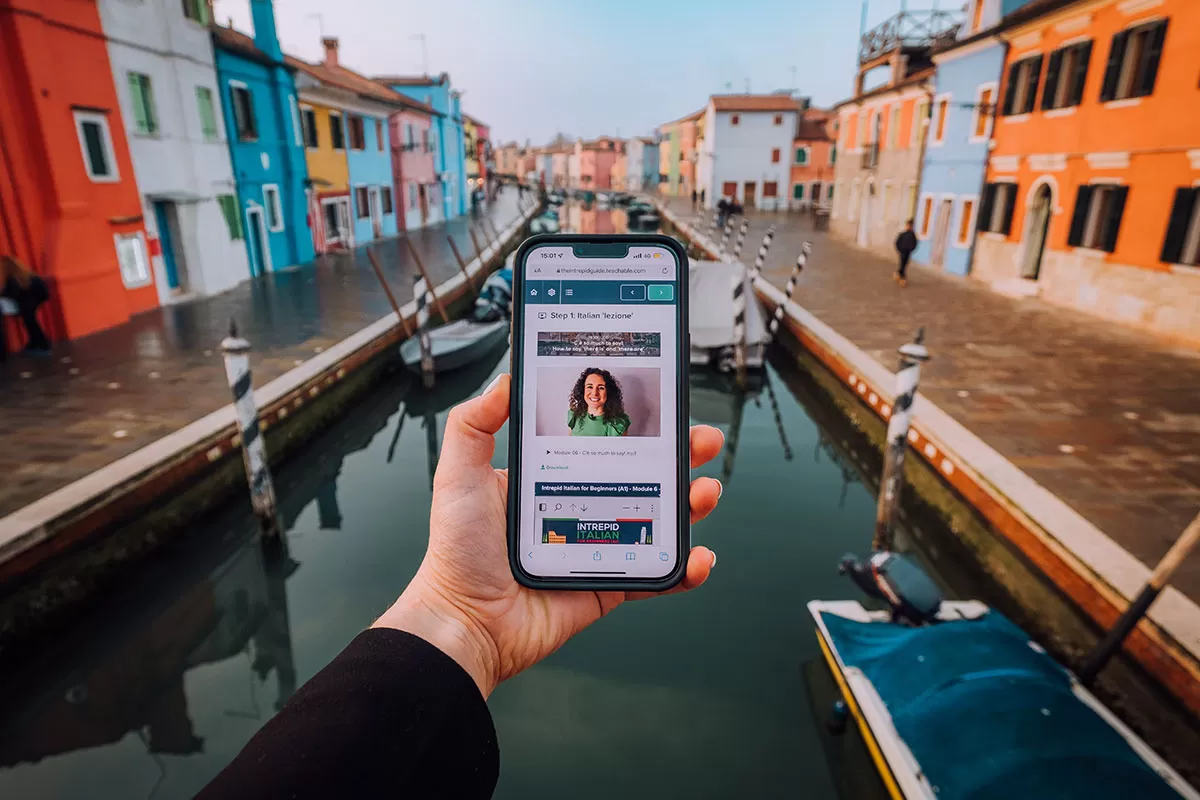
Don’t miss my Italy travel guides
- Best Time to Visit Italy // PLUS Tips to Avoid Crowds and SAVE $$$
- 29 Amazing Day Trips from Rome By Train, Car & Guided Tour
- 21 Unique Things to Do in Venice You Should Try at Least Once
- Where to Stay in Rome | Best Hotels and Best Neighborhoods to Stay in Rome
- 20 Top Hotels Near the Pantheon in Rome for Every Budget
- 12 BEST Things to do in Burano, Italy (Tips from a Local Guide)
- Top 7 Authentic Tours and Experiences in Rome [Run by Locals]
- Domus Aurea: Why You Should Visit Rome’s Secret Hidden Palace
- Rome Tips and Tricks: 27 Things You Should Know Before You Go to Rome
- Top 10 Absolute Best Views of Rome That Will Blow Your Mind
- Self-Guided Trastevere Walking Tour: Where to See Rome’s Most Beautiful Streets
- 26 Absolute Best Things to do in Verona, Italy
- Lakes, Mountains & Castles: 21 Best Things to do in Trento, Italy
- 36 Wonderful Things to do in Umbria, Italy (PLUS Map of Umbria)
- Italy Fun Facts: 126 Unique Things You Didn’t Know About Italy
Like it? Pin it for later!
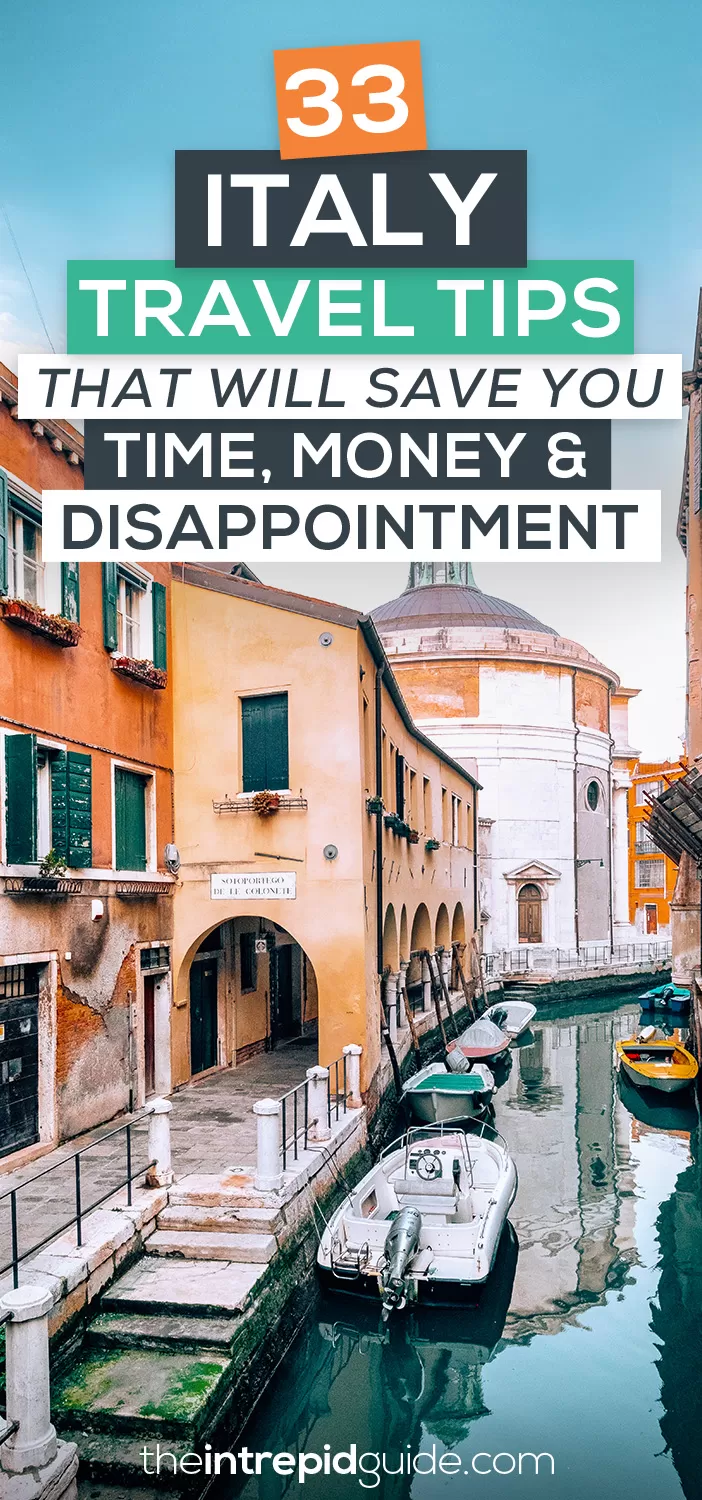
Over to you!
Have you visited Italy before? What other tips would you add to this list? Let me know using thecomments section below or join me on social media to start a conversation.
Thanks for reading and I hope you enjoyed this post.
Like what you see? Subscribe using the form below to have all of my posts delivered directly to your email.
Michele creates language learning guides and courses for travel. What separates her from other instructors is her ability to explain complex grammar in a no-nonsense, straightforward manner using her unique 80/20 method. Get her free guide 9 reasons you’re not fluent…YET & how to fix it! Planning a trip? Learn the local language with her 80/20 method for less than the cost of eating at a tourist trap restaurant Start learning today!
21 Unique Things to Do in Venice, Italy (A NON-Touristic Guide)
Ca’ bonfadini historic experience review: a unique stay in a 16th-century palace in venice, leave a comment cancel reply.
Save my name, email, and website in this browser for the next time I comment.
This site uses Akismet to reduce spam. Learn how your comment data is processed .

If you don't know where you are , how do you know where you're going? Find out how well you know Italian grammar today!

Italy Travel Guide
Your ultimate italy travel guide, with tips, ideas on things to do, and best things to see in italy. great for first-time and returning travelers..
Located in southern Europe, Italy is a Mediterranean country bordered by three seas (Adriatic, Tyrrhenian, and Ionian).
Known as the birthplace of Western culture, Italy is a stunning country affectionately referred to as the Bel Paese (the beautiful country) .
A country full of history and beauty, it is a must-see for travelers.
From Unesco World Heritage Sites like the ruined city of Pompeii to coastal beauties like the Amalfi Coast and Cinque Terre, Italy is a great place for those who want to experience something different.
Add in great Italian cuisine and it makes a perfect vacation.
Get inspired to visit Italy and plan your dream trip with our Italy travel guide .
Popular City Guides
Our highlight.
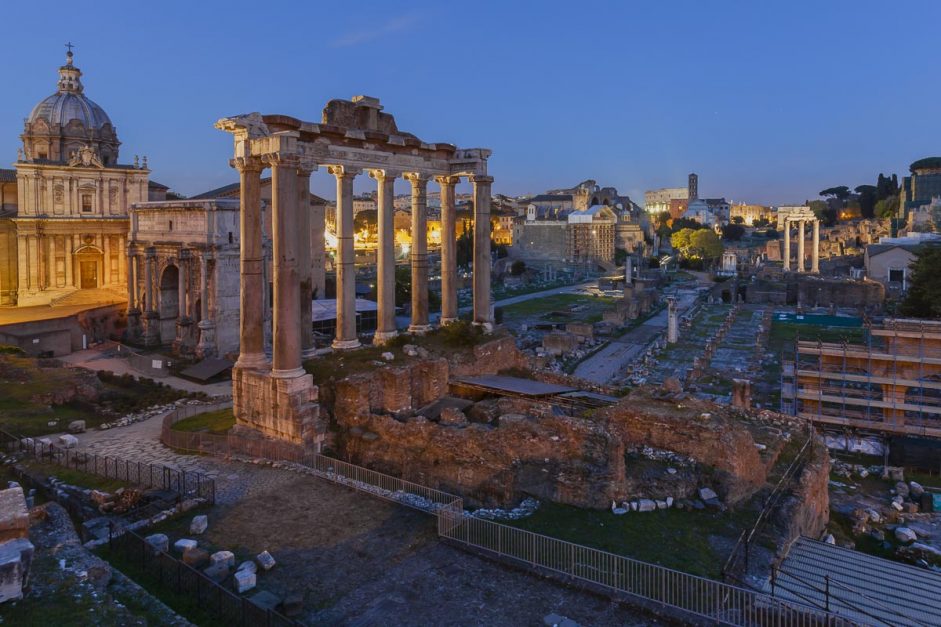
Table of Contents
Fast Facts About Italy
- Currency: The official currency is the euro and 1 euro is equal to 1.12 USD.
- Power: Power voltage is 220V at 50 Hz.
- Entry: To enter, you will need a U.S. passport valid for at least 6 months after your departure date.
- Getting Around : The best way to get around is by public transport or renting a car but beware, Italians are hairy drivers!
- Sales tax: The value-added rate (VAT) rate is 20%.
- Best Sim Cards: TIM, Vodafone, WindTre, and Iliad are the main mobile providers. A prepaid SIM card can be purchased through any of them.
- The Capital City of Italy is Rome – See the Best Things to do in Rome
Things to See and Do in Italy
- Off the Beaten Path – step outside of Rome and explore the many villages that surround Italy’s capital.
- Hike Mount Etna: Take your adventure to a new level by climbing Italy’s highest Volcano.
- Learn How to Make Traditional Balsamic Vinegar – sold for up to $100 US for 100 ml, learn all about the ins and outs of making this delicious Italian vinegar.
- Meet David on a Walking Tour of Florence – get introduced to the beauty of Florence and be catapulted to the front of the line to see the famous statue of Michelangelo’s David
- Visit the Leaning Tower of Pisa – Pisa may be crowded with tourists, but this is one sight you do not want to miss.
- Explore Romagna – not only is Romagna home to Pavarotti, Enzo Ferrari, Ferrucio Lamborghini but it is also the gastronomical capital of the country.
- Explore the Vatican Museums : When in Rome you can’t miss Vatican City and these museums. Even if you are not a history buff you will be blown away by the beauty of this part of Rome.
- Explore the Italian Riviera : From hiking the famous Cinque Terre trail to relaxing on Sestri Levante beach, this is what Italian luxury is like. A visit to the Italian riviera is a perfect way to spend a week in Italy.
Italy Travel Guides
- Best Things to do in Rome
- Best things to do in Venice
- Best Things to do in Florence
- The Best Things to do in Amalfi Coast
- 15 Reasons to visit Emilia Romagna
- Best Things to do in Bologna
Accommodation
Budget: You can find a number of budget hotels in Italy for around 30-40 euros per night. Enjoy free Wi-Fi and breakfast, private rooms, and great city locations.
Mid Range: For mid-range hotels, expect to pay between 50-80 euros per night. Enjoy private air-conditioned rooms, indoor and outdoor pools, a hotel restaurant and bar, and free Wi-Fi.
High End: Upscale hotels will range from 150-1,220 euros per night.
Take in the best with top-of-the-line hospitality, elegant rooms and suites, spa services, indoor and outdoor pools, multiple fine dining restaurants, fitness centers with personal trainers, private balconies, and more.
If you intend to visit Italy for food you won’t be disappointed.
Italian cuisine is famous for pasta, tomatoes, cheese, fish, and meat.
While many might think that spaghetti and meatballs are the traditional dish of Italy, this is not true, and in fact, is rarely eaten in Italy (except for tourist places).
The national dish is Ragu alla Bolognese Sauce (meat-based sauce served in tortellini, gnocchi, or tagliatelle pasta). Other favorites include pizza, lasagna, and bottarga (cured fish roe).
There are a number of restaurants where you can try authentic Italian cuisine, as well as cafes.
Try a cappuccino for about 1.34 euros (but remember, if you want to follow tradition, it is custom not to drink one after 10 or 11 AM).
In total, expect to pay about 10-20 euros per meal for most restaurants, or 50 euros per meal for three-course restaurants.
The Best Ways To Get Around Italy
Getting to Italy: The Leonardo de Vinci-Fiumicino Airport is one of the busiest airports to fly into and is 20 miles from the city center.
The Malpensa International Airport is great when going to Milan and is a 20-40 minute train ride to the city of Milan.
Transportation: Trains are a fast way to get around. You can find trains both for regional trips as well as between cities. High-velocity trains are a speedy and fairly inexpensive way to travel throughout Italy.
Go from Rome to Florence in 2 hours, for example, and pay just 25 euros.
Buses : Italy has a number of buses for shorter trips, as well as metro services in larger cities like Rome and Milan. Tickets start at 1-2 euros.
Make sure to purchase your tickets before boarding or you can get a fine up to 100 euros.
Taxis: Taxis are an alternative way to get around. You can hail one down or call for a taxi, though note that if you call, the meter starts running once you call.
A typical price for a taxi is about 15 euros, depending on the distance .
Car Rental : To rent a car, you must be at least 21 years old and have a U.S. license as well as an International Driver’s License. It is advised that you know the rules of the road before driving in Italy.
Prices start at around 55 euros per day. But you can find great deals for car rentals too so look around.
When to go to Italy
The best time to visit Italy is from April to June and September to October.
July and August are usually quite crowded, and hotel rates are at their peak, whereas spring and early autumn have lower prices and the temperatures are neither too hold or too cold for outdoor and sightseeing activities.
If you are spending most of your time in the north then I would definitley say the best time to visit would be during the fall and winter. You have fewer crowds but great mountain activities like skiing.
Where to Stay in Italy
Hotel Italia: A traveler favorite, stay at this great hotel in Rome. Just 9 minutes from multiple airports and minutes away from numerous attractions (including the famous Trevi Fountain), this is the place to stay.
Acca Palace : Stay at this four-star modern hotel in Milan. Sleep in private suites with a balcony and a minibar and enjoy amenities like room service, dry cleaning and laundry services, the hotel’s restaurant and bar, free high-speed Wi-Fi, and transportation to the airport.
San Gallo Palace—Florence: Just 30 minutes from the Florence airport and minutes from attractions like the Florence Cathedral and the Uffizi Gallery, this hotel puts you in the heart of everything.
Italy Accommodation Guides
- Where to Stay in Rome
- Where to Stay in Venice
- Where to Stay in Florence
- A Luxury Tuscan village
- 15 Best Italian Coastal Villages
What to Pack for Italy
Similar to many European countries, the climate of Italy is highly diverse depending on where you plan on traveling.
If you are spending your time on the Amalfi coast you will be packing differently than if you are up in the Italian Dolomites.
Considerable differences in temperatures between the north and south are more prominent during the winter months.
Winters are cold and damp in the north and milder in the South.
However, most of Italy has hot dry summers with July being the hottest month of the year.
- Toiletries – beauty items and toiletries can be expensive in Italy if you want to save some money than pack some extra in your bag.
- Blend in – Italians love to dress up, so why not pack some basic classic items that you can mix and match throughout your trip. Try to avoid baseball caps and white sneakers.
- Wedges – Italy is known for its cobblestone streets. If you want to pack a fancy pair of heels for a classy night out on the town than stick with wedges over stilettos. Wedges allow you to walk smoothly over the cobblestone.
- Layers – this is especially important for those traveling throughout Italy during the winter months. The general rule of thumb is to pack at least four layers: a base layer, long sleeve shirts, a fleece (mid-layer) and a top layer such as a windbreaker. Don’t forget a warm pair of gloves, a thick scarf, and a hat!
Italy Travel Guide: Best Booking Resources
Whenever we travel to Europe we make sure to start with these companies.
We have tried a lot of different ones over the years and all of these have consistently proven to be the best when it comes to offering great prices as well as great customer service.
We have used every one of these personally and continue to do so.
Booking.com : This is our go-to site when comparing prices for accommodation. It is usually and has the cheapest prices, especially in Europe and we love their interface. Not to mention you get free cancellation and you are guaranteed the best price.
Trip Advisor : What we like about Trip Advisor is that we can look at all the reviews and then book our accommodation. TripAdvisor is where we go when we want to compare prices with multiple accommodation providers.
Air BnB: Airbnb is the main search engine we use when we are looking for a home or apartment rental. It can sometimes be cheaper than hotels and it is the best way to stay in areas that offer a more local feel.
Hostelworld: With one of the largest databases of hostels in the world, Hostelworld is the go-to site when you are looking for budget accommodation.
Skyscanner: This is the first place we check for flights. It consistently comes back with the cheapest and best options. It allows us to compare a lot of airlines to get the best price.
Rome 2 Rio: If you want to see how to get somewhere by plane, train, bus, ferry, or car Rome2Rio lays it all out for you as well as related costs. I love how they show it all to you on a Google Map and it works offline.
Get Your Guide: For all your day trip and city guide needs, we use Get Your Guide. It has the world’s largest collection of things to do with more than 30,000 activities in 7500 destinations.
World Nomads Insurance: When traveling to Italy you should always have travel insurance. We have found the best bang for your buck is by far World Nomads.
Italy Travel Guide: Related Articles
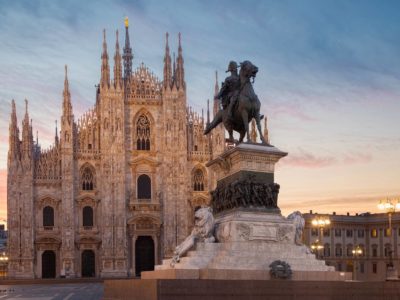
One Day in Milan Itinerary: The Ultimate Guide for First-Timers
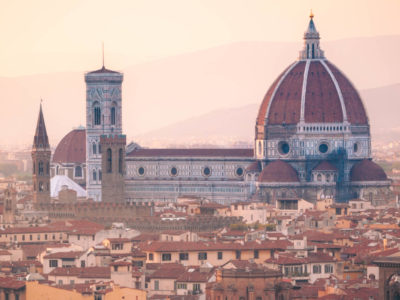
Where to Stay in Florence: Your Area And Neighbourhood Guide (2024)
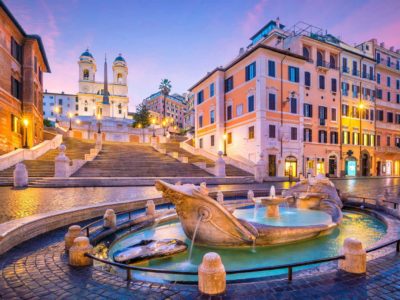
Where to Stay in Rome: Our Favourite Places And Neighbourhoods (2024)
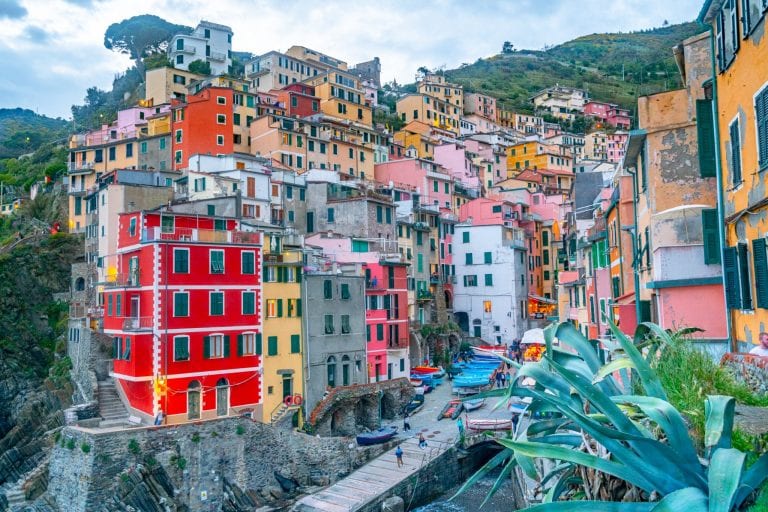
101 Important Travel Tips for Italy
We have an intense love of traveling in Italy–and after visiting Italy so many times that we’ve each spent about a year there, we have a huge collection of travel tips for Italy to share!
Italy is a delightful and fairly easy country to travel in, but it’s absolutely a world all its own.
Cultural quirks, transportation snafus, tax confusion, and how exactly to buy fruit in a supermarket are just a few of the possible challenges you’ll run into while traveling in Italy.
And, while getting out of your element is part of the fun of visiting another country, reading through these Italy travel tips will definitely make your experience a bit smoother, especially if it’s your first visit!
We have traveled Italy extensively over the course of almost a decade, covering 14 of Italy’s 20 regions, from the northern reaches of the Italian Dolomites to the beaches of Sicily .
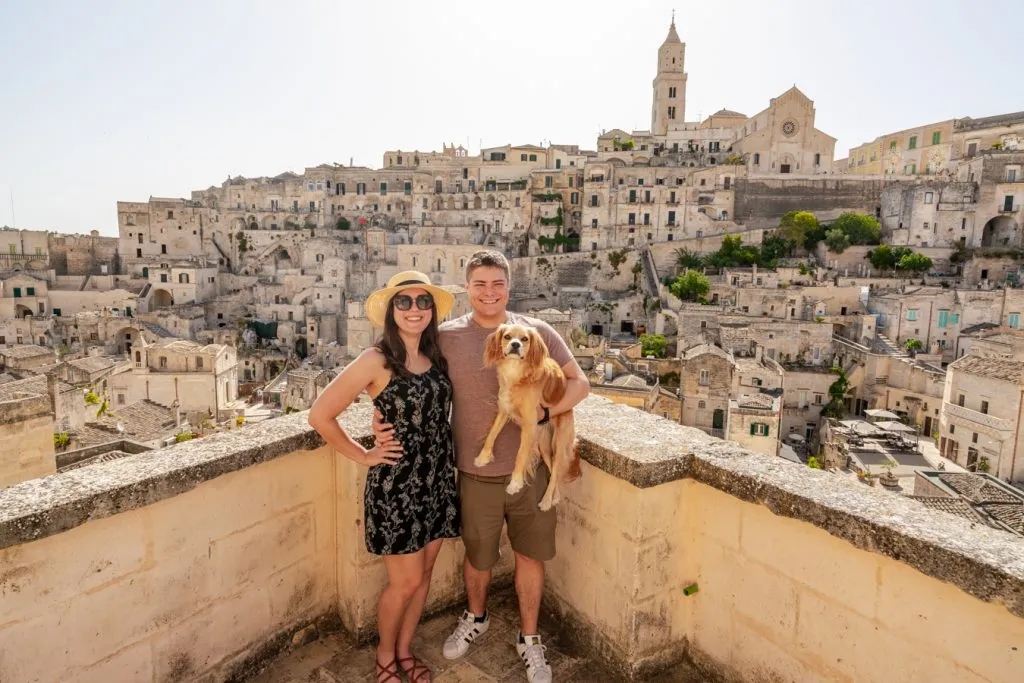
Some links in this post may be affiliate links. If you make a purchase through one of these links, we may earn a small commission at no extra cost to you. Please see our disclosure policy for more detail.
We’ve traveled by plane, train, rental car, taxi, ferry , and bus. We’ve traveled on a budget , and we’ve splashed out on luxury experiences. We’ve mostly traveled Italy as a couple, but also with friends and on multigenerational trips with family.
We’ve paused to experience certain areas more deeply at times, spending a month each “living” in Florence and Bologna, and 2 months in Rome.
In other words, we’ve seen a lot of Italy (and published 100+ Italy blog posts and counting along the way).
After all of those trips, here is our best advice for traveling Italy !
Table of Contents
A Quick Note on Who We Are
Advice for staying in hotels + apartments in italy, food-related tips for visiting italy, tips for transportation and getting around italy, tips for paying for things in italy, logistical travel tips for italy, advice for avoiding common scams in italy, what to know about packing for your trip to italy, other things to know before visiting italy.
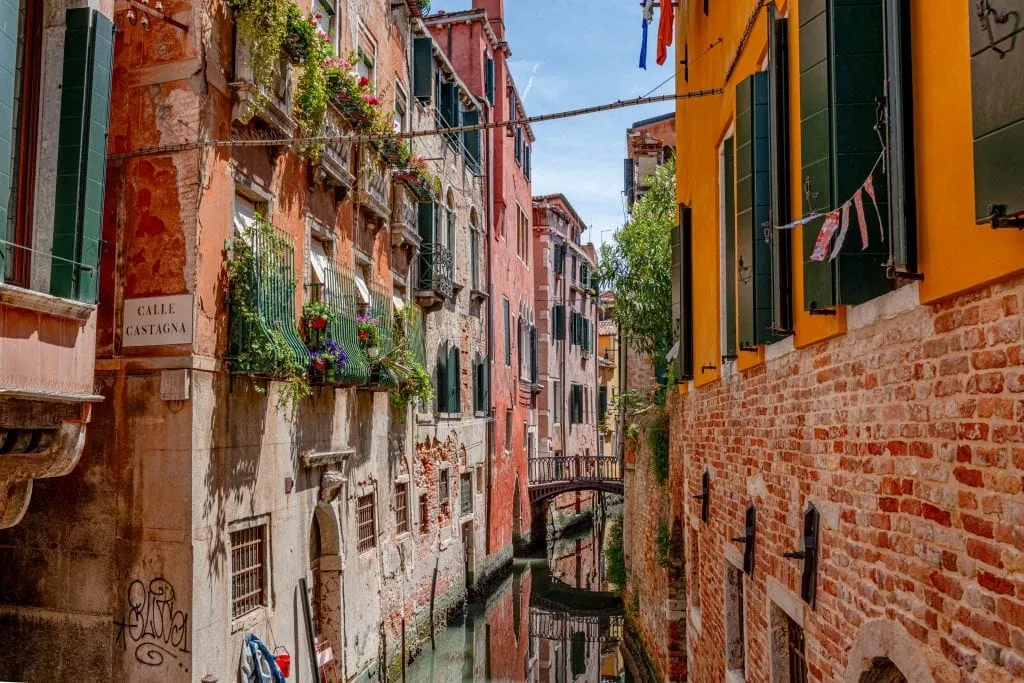
We are Kate and Jeremy Storm, a travel blogging couple from the USA, and these tips are written from our perspective (if you’d like, you can read more about us here ).
Because of this, a couple of these tips speak to cultural differences between the USA and Italy specifically.
However, the focus here is very much on Italy, not the USA, and the vast majority of these Italy travel tips will be useful for travelers coming from anywhere outside of Italy!
Consider this an Italy 101 guide for anyone planning their very first trip to Italy .
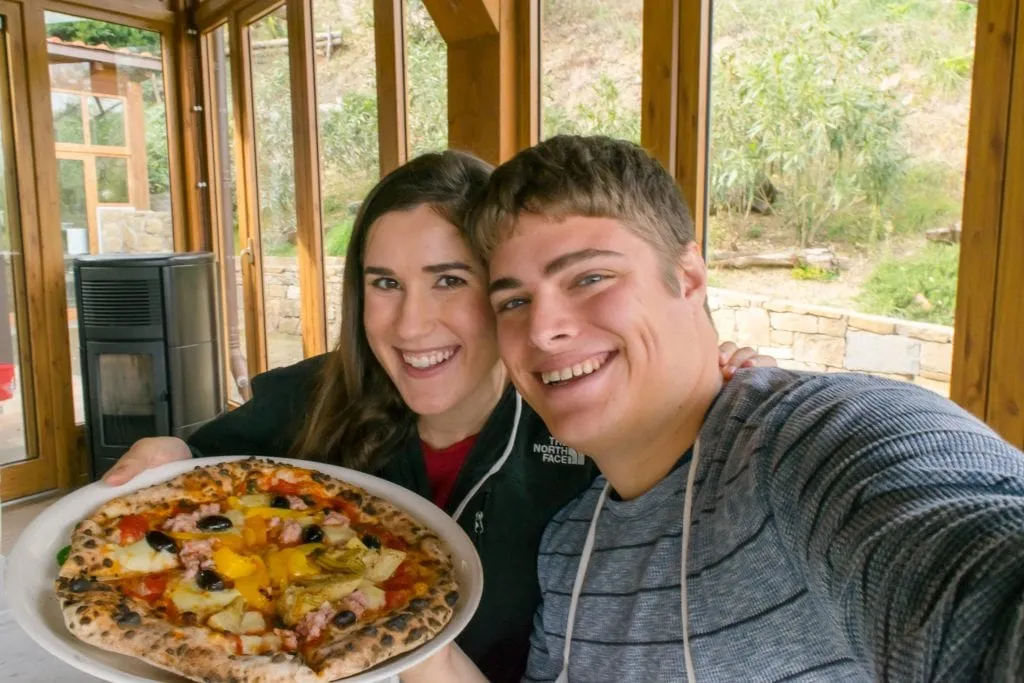
Hotels and Airbnbs will make a copy of your passport.
… Or take a picture, or write down the number… you get the idea.
This is done for tax purposes on their end and is totally normal, so don’t worry about it!
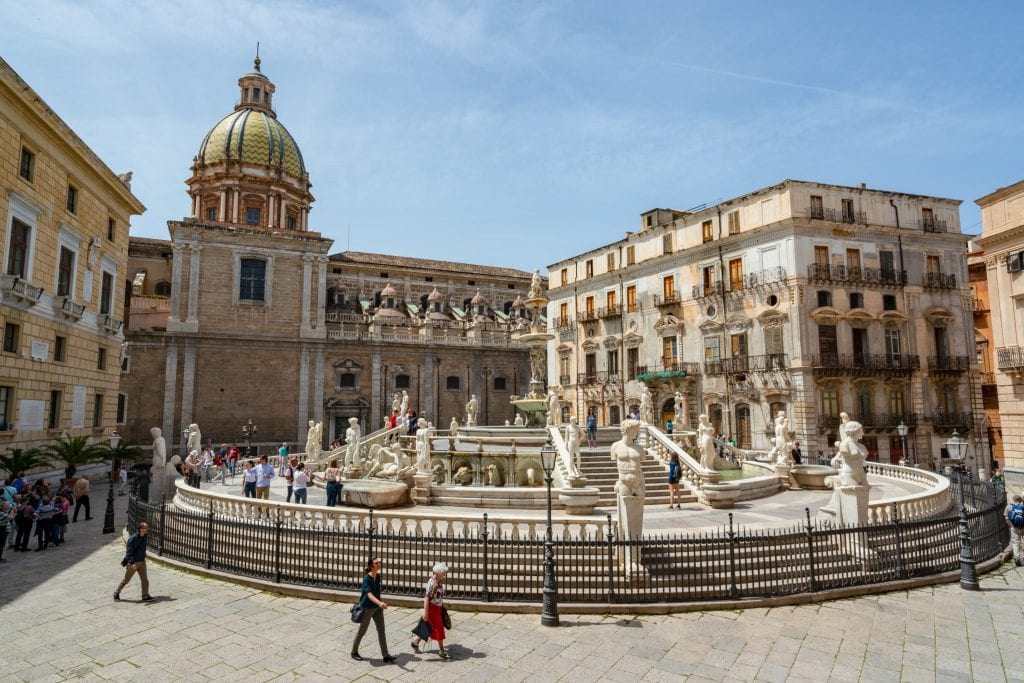
Leaving your room key at the hotel is common.
It’s not done 100% of the time, but it’s a very common practice in Italy to drop your key off at the front desk as you head out for the day and to pick it up when you come back to the room.
This is much more common at historic hotels, as many of them still use “real” keys!
Beds are tiny and generally don’t come with comforters.
Don’t be surprised if you find only a sheet and a very light blanket on your bed, especially if you’re visiting Italy in the summer !
Oh, and two twin beds being pushed together to make a double bed is common too, especially if you’re renting an apartment rather than staying in a hotel.
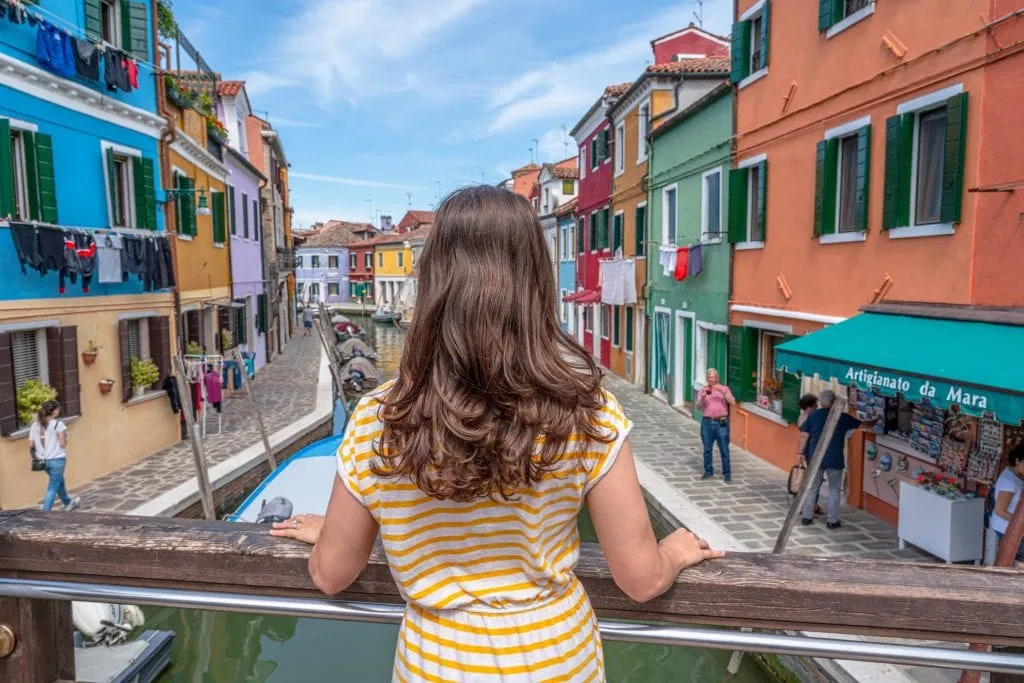
Air conditioning is not a given.
If you’re visiting Italy during the summer, double-check your hotel or apartment before booking.
Air conditioning isn’t always standard, but it’s often very necessary in our opinion!
… and if present, air conditioning isn’t turned on year-round.
While many hotels and apartments offer air conditioning these days, if you’re visiting Italy during the spring or fall, you aren’t guaranteed to have access to it.
In Italy, air conditioning is turned on “for the season” during the summer months, and exceptions aren’t necessarily made for weather.
In other words, if there’s a heat wave in April or October, you may find your hotel room a bit warmer than you’d like!
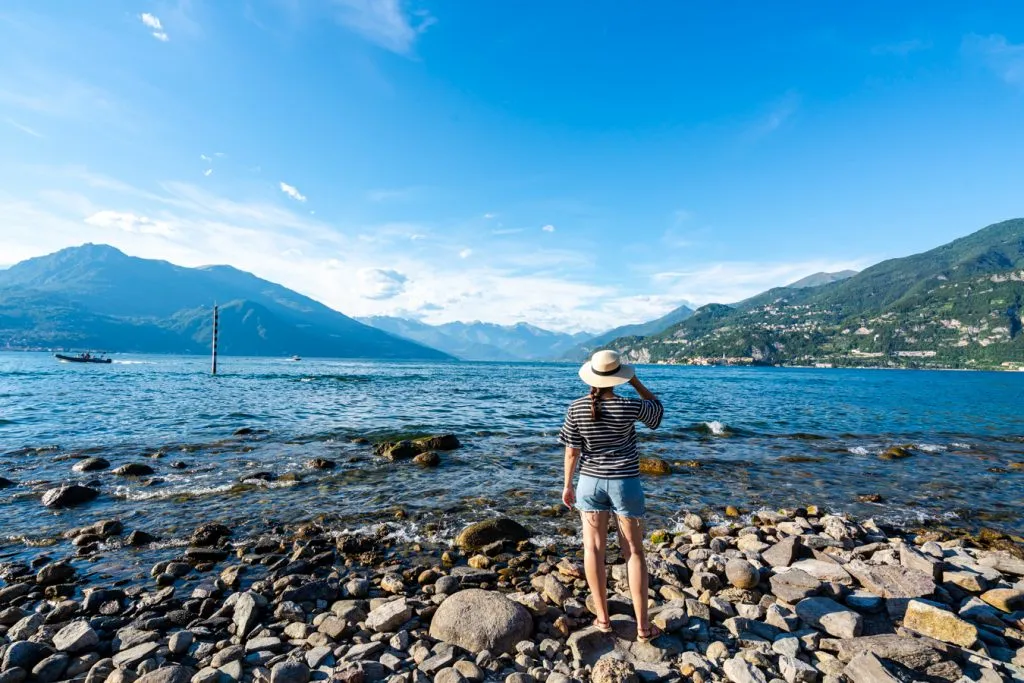
You’ll need to pay a tourist tax in each city you visit.
This is collected by your hotel and increasingly by private apartments/Airbnbs (they’re required to do so).
This fee is set per person, per night, and is usually around 2 Euros, though it does vary, and some places are more expensive.
So, for example, if you’re a couple spending 4 nights in a city with a 2 Euro tourist tax, you would owe 16 Euros: 2 Euros per person (aka 4 Euros per night for you as a couple), for 4 nights.
This tax must be paid in cash .
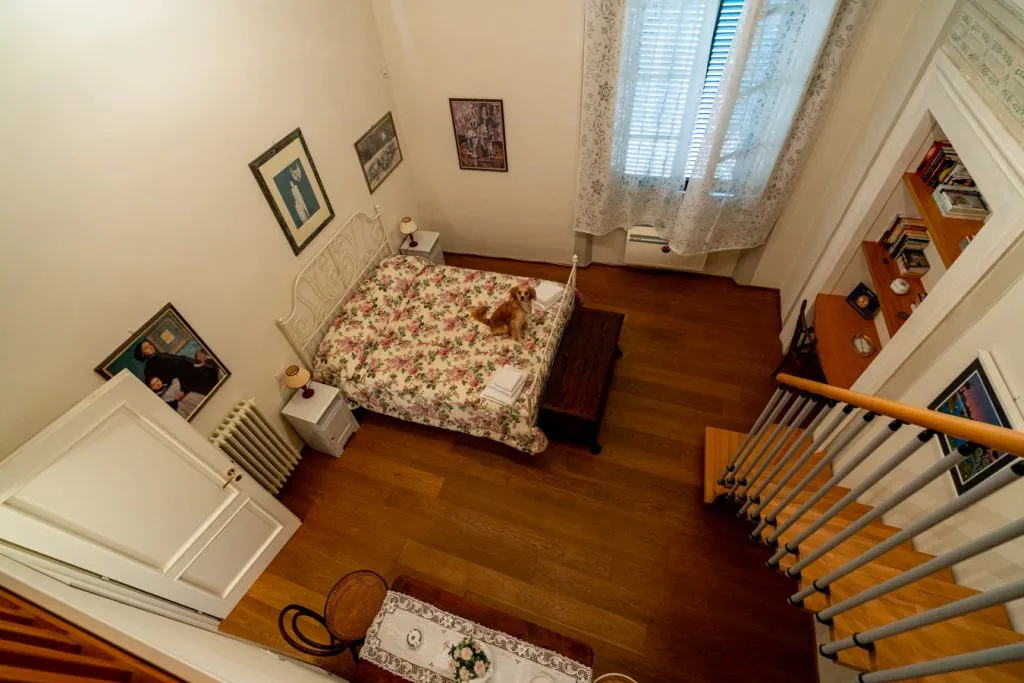
There are exceptions–some higher-end hotels will let you charge it and then handle the cash on their end–but we’ve only had that happen a couple of times.
Cash is always deeply preferred.
Hotels will generally request the tax at the beginning of the stay, but most won’t make a big deal out of having you pay anytime before check out if you don’t have cash on you at check-in.
These taxes are never paid before arrival–so even if you paid for your hotel in full through a service like Booking.com before checking in, you’ll still owe the tax.
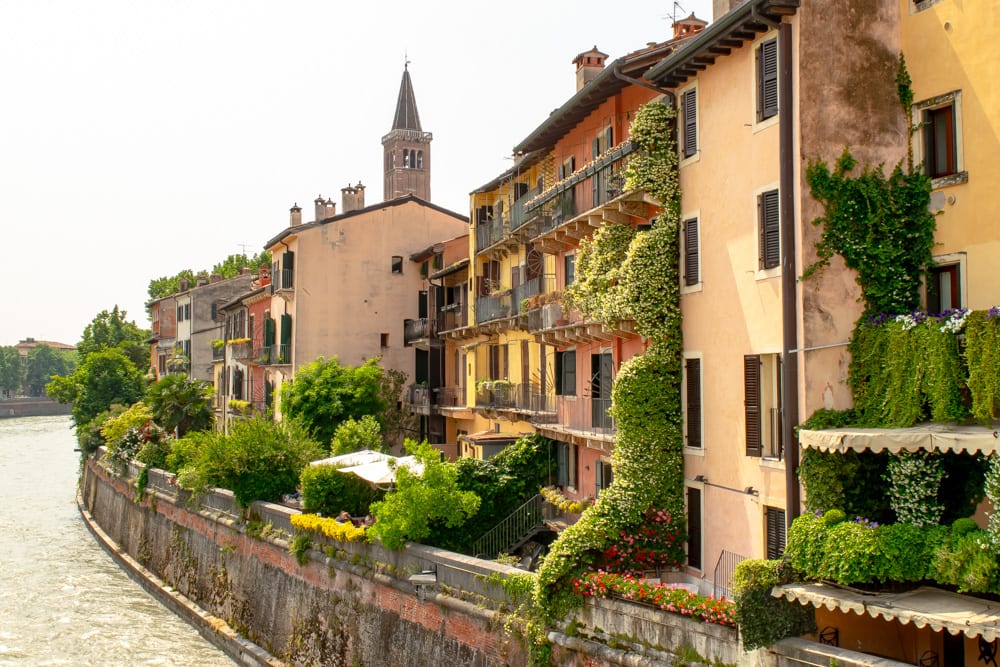
Occasionally you’ll also owe a tourist tax on day trips.
The only place we’ve run into this is the highly touristed Capri , but it does happen.
As of 2024, Venice is–finally, after years of chatter– piloting their new 5 Euro tax for day-trippers during certain days between April and July 2024.
Whether or when this becomes a more regular practice is still up for fierce debate, but if you’re spending the night in Venice, it’s nothing you need to worry about, regardless.
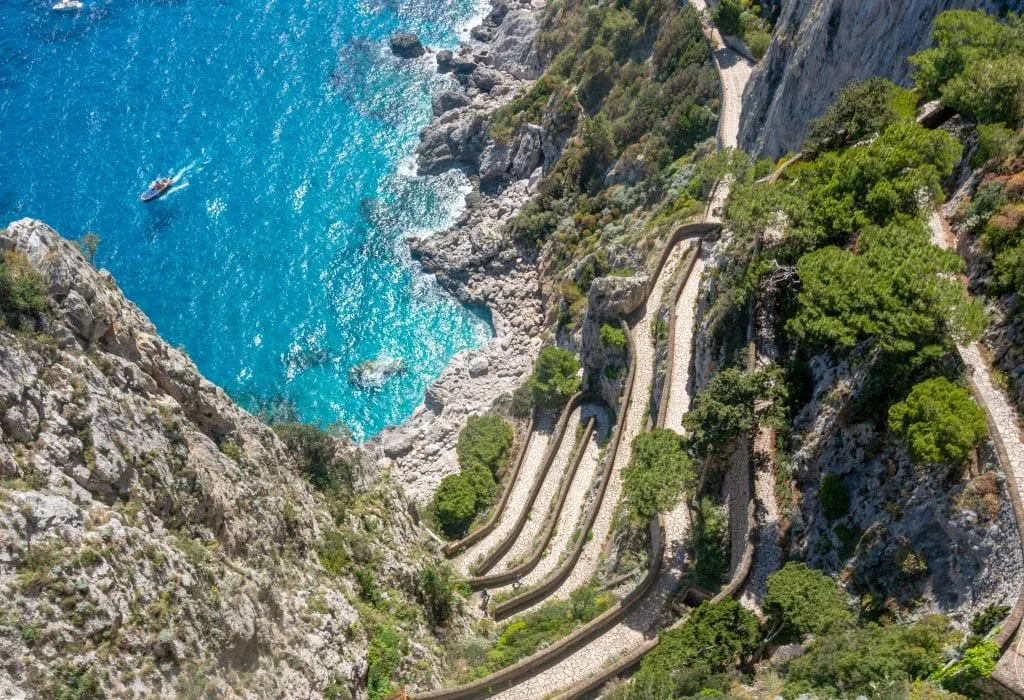
Don’t expect a clothes dryer.
Even if your apartment rental or Airbnb comes with a washer, you won’t find a dryer–but there will be a rack to line-dry your clothes on.
If you have mobility concerns, choose a place to stay carefully.
Narrow, steep staircases are very common in Italy–we’ve climbed many of them to reach apartments or hotel rooms.
Elevators/lifts are far from a guarantee, especially at small, family-run properties.
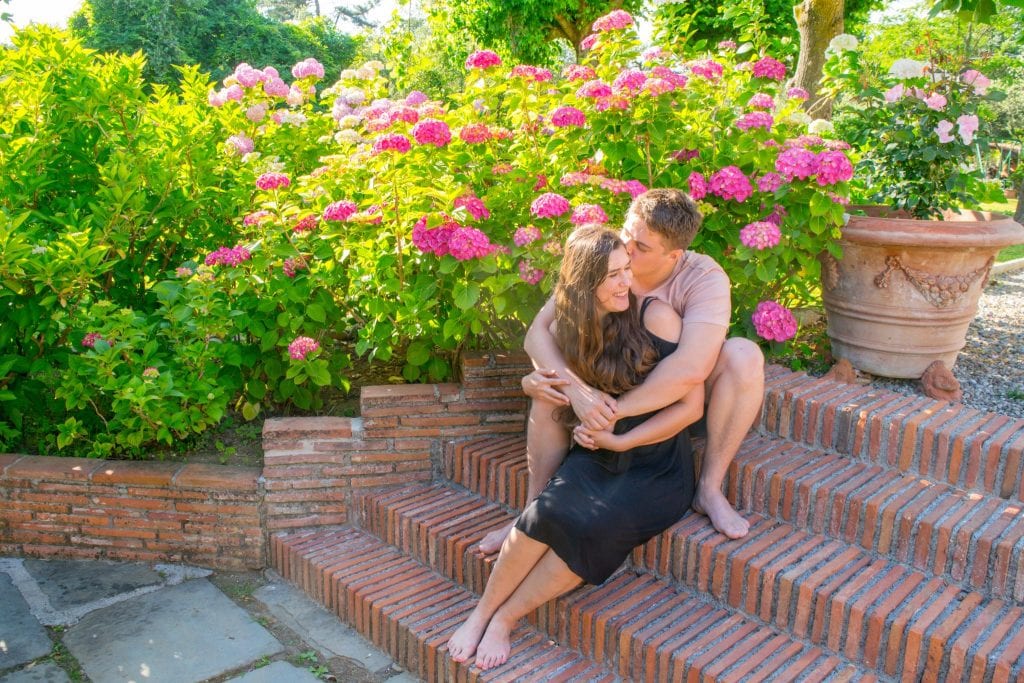
Restaurant Tips for Italy
Food is extremely local, and you’ll eat well by sticking to regional specialties..
In other words, you won’t be likely to find great Napoli-style pizza in Rome or pasta carbonara in Sicily .
(… but since Roman-style pizza is also incredible and Sicily has its own magnificent array of pastas to choose from, you won’t miss them much, either).
Because of this, food tours in Italy are fantastic.
Everywhere you go in Italy, you can learn about new foods, dishes, and eating habits from locals–and that variety makes food tours extra special.
We love taking food tours in Italy and have taken several incredible ones.
Some of our favorite food tours include this one in Florence , this one in Emilia-Romagna , and this one in Rome !

Don’t use a spoon to eat your pasta!
In Italy, this is for children.
… And don’t cut it.
It takes a while to get the hang of twirling neatly with a fork, but it’s worth it!
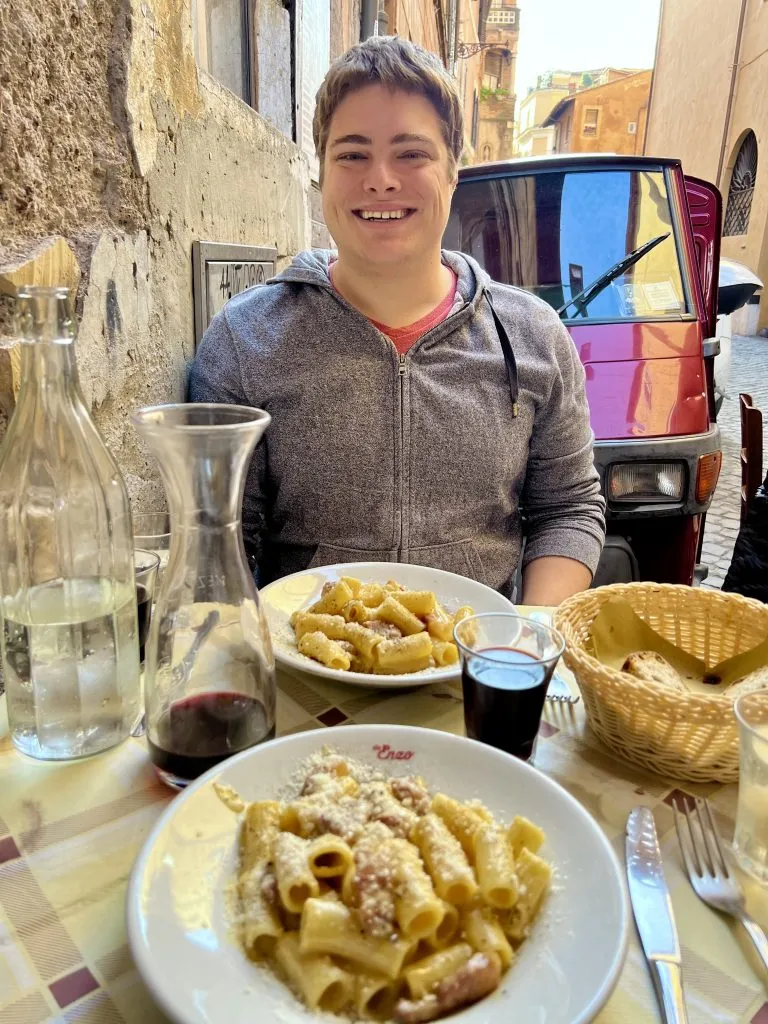
The house wine is usually delicious.
… And even if you don’t see it on the menu, there’s a 95% chance that it exists.
You just have to ask for it ( vino della casa ).
House wine is sold by the liter.
Generally, you’ll order a quarter, half, or entire liter, and you’ll have your choice of red (v ino rosso ) or white ( vino bianco ).
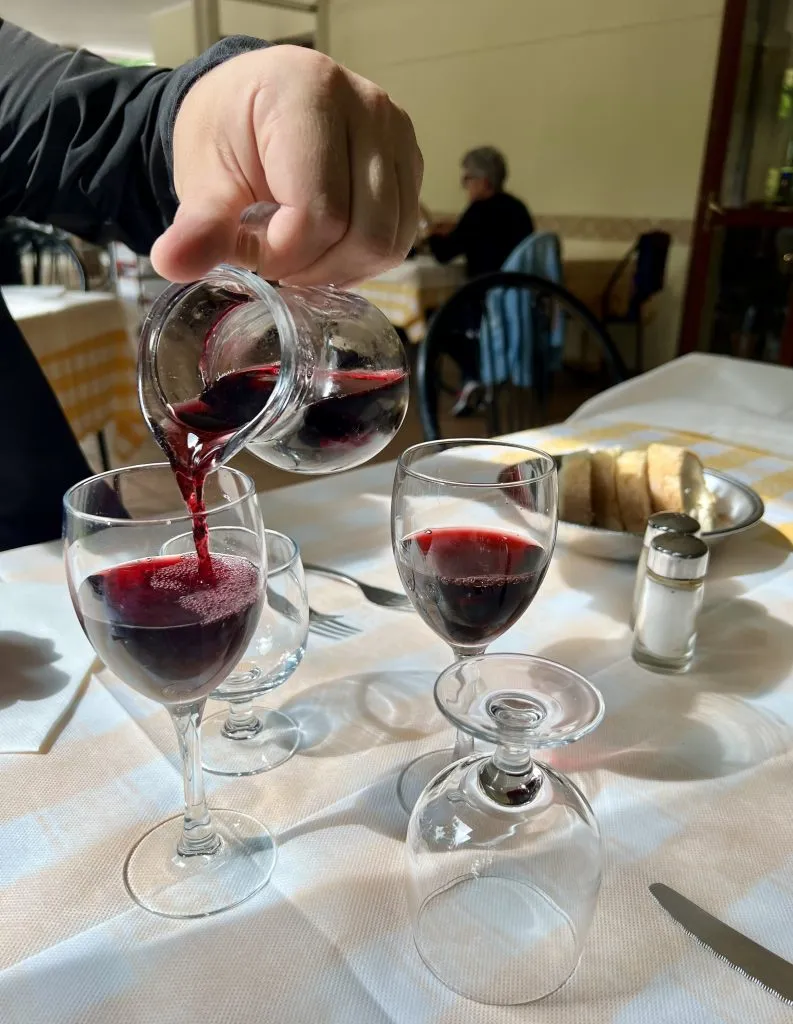
The bread is not included. Sort of.
Some restaurants will bring bread to the table before your meal, and it’s typically not “free”.
However, more often than not it’s included in the coperto , or cover charge (usually 1-3 Euros/person), so you’re likely going to pay for it regardless and might as well eat it.
If you’re not sure what the deal is, ask!
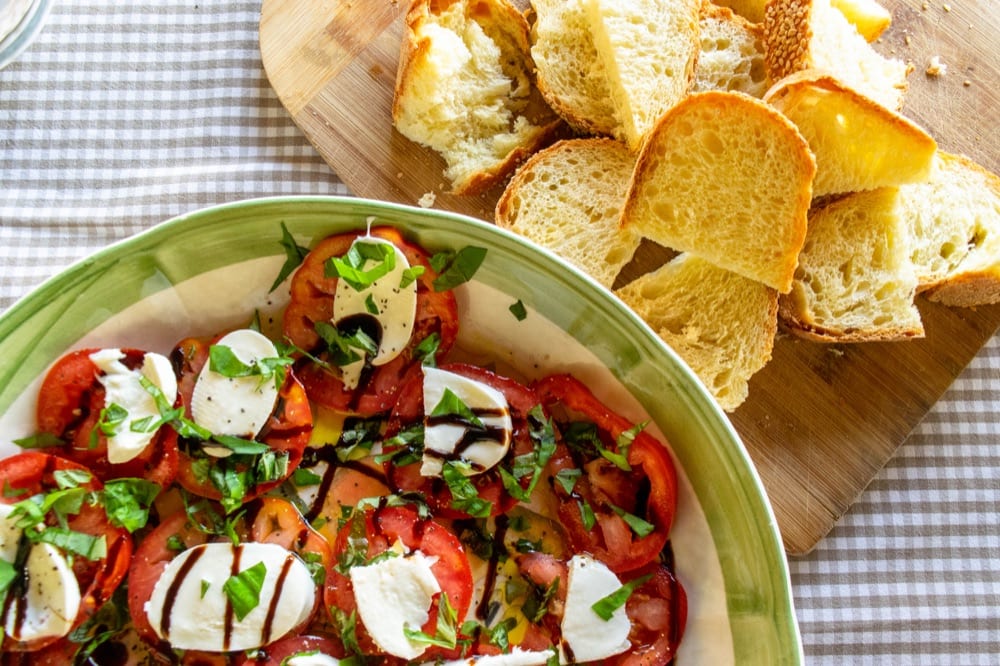
Garlic bread does not exist here.
It is merely a delicious American delicacy.
… And neither does fettuccini alfredo, or chicken on literally any kind of pasta.
Italian-American food is tasty, and we eat plenty of it at home, but it’s not Italian.
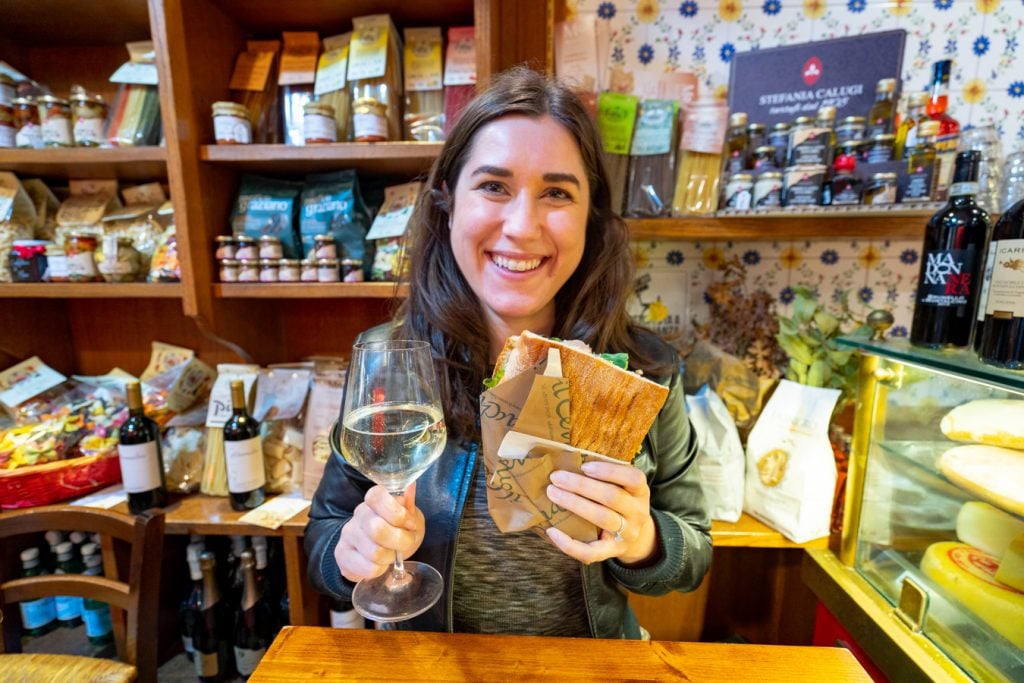
Cappuccino is a breakfast drink.
The reason for this is digestion–everything about eating in Italy revolves around digestion, and frothy milk in the afternoon?
Not great for digestion, as the local thought goes.
Obviously, you can order it–Jeremy does–but if you’re a “when in Rome” sort of traveler, stick to espresso after about 10:00 AM.
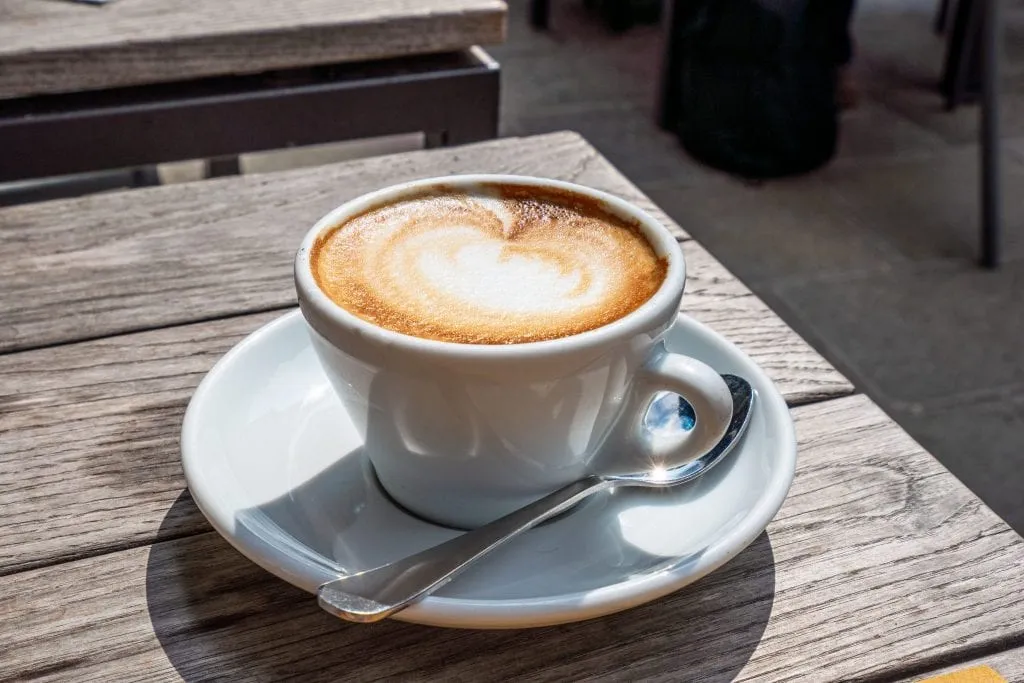
Coffee is espresso, and it’s not called espresso.
If you order un caffè (sometimes clarified to un caffè normale if they want to confirm you’re not looking for an Americano/if you know how to order coffee Italy), you’ll be given espresso.
We have a full Italian coffee culture guide here to help you parse the specifics!
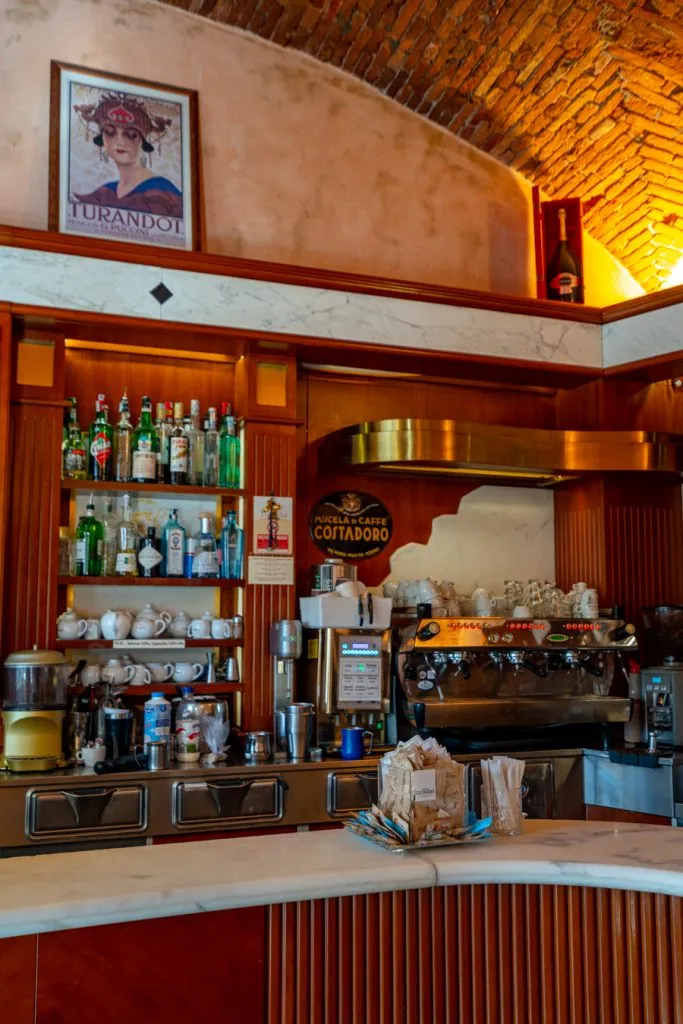
… And it is considered great for digestion.
Coffee is typically served after a meal, even dinner, and though I can’t fathom being able to handle that much caffeine at night, it’s a very common practice!
If you want to stick with the ritual but also sleep, you can request decaf, or café déca (the locals won’t, though).
If you see an omelet for sale in Italy, you’re at a tourist restaurant.
Italian breakfast consists of coffee and maybe a pastry (a cornetto cioccolato is a delightful treat, take advantage of it), consumed standing at the bar and not sitting down at a table.
Here’s our full guide to Italian breakfast culture!
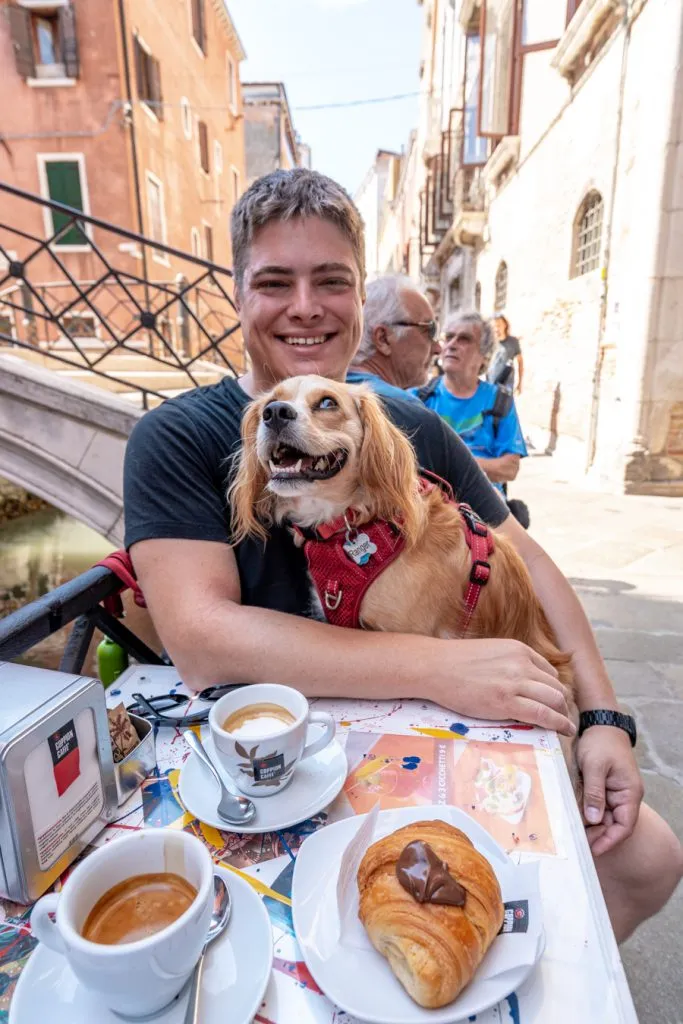
Italian sparkling wine is generally prosecco.
Prosecco, like French champagne, comes specifically from the prosecco region of Italy (it’s up north in Veneto and makes a great day trip from Venice, if you’re interested).
Prosecco is delicious, and if you like sparkling wine, you need to drink some while in Italy!
Bars are not just for the evening.
Italian bars serve alcohol, yes, but they also serve coffee and pastries.
Think of them like a coffee shop + bar hybrid! You’ll go here to get your breakfast… and then also to get your aperitivo in the evening.
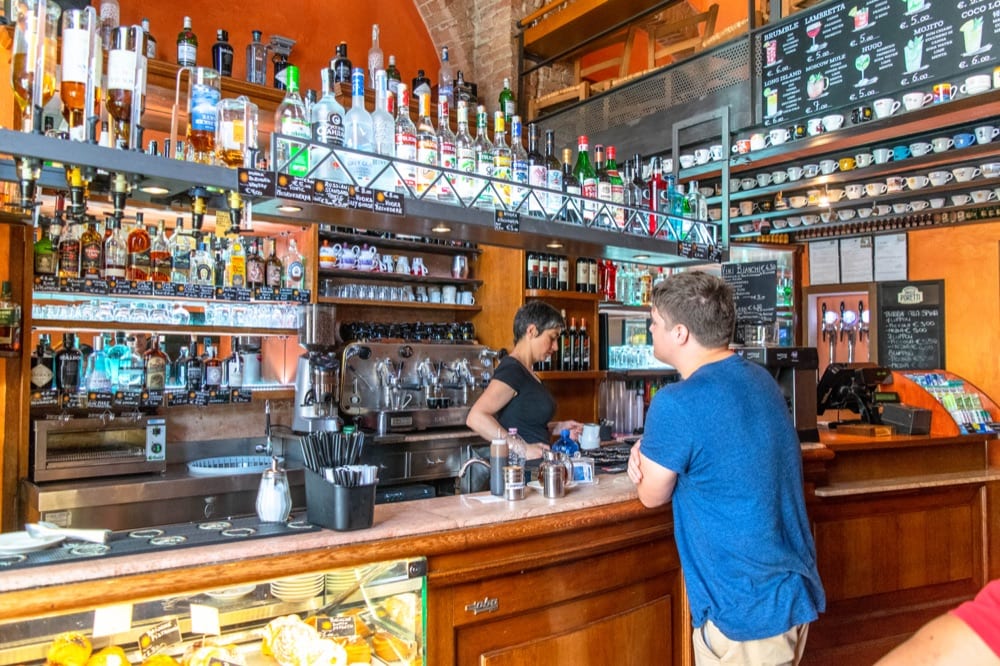
Get your stomach on Italy’s schedule.
This varies a bit by region, but it’s something to consider: the best restaurants don’t stay open all day!
Here’s a vague schedule to keep in mind:
Breakfast of coffee and pastry at the bar when you wake up (pretty flexible, the bars will stay open through the day, though the best pastries can go early-ish).
Lunch is between 12-3. Aperitivo is between 5-7.
Restaurants open for dinner at 7:30–occasionally 7. They’ll really start to fill up around 8:30-9.
We go into this and many more Italian dining habits in our guide to eating in Italy !
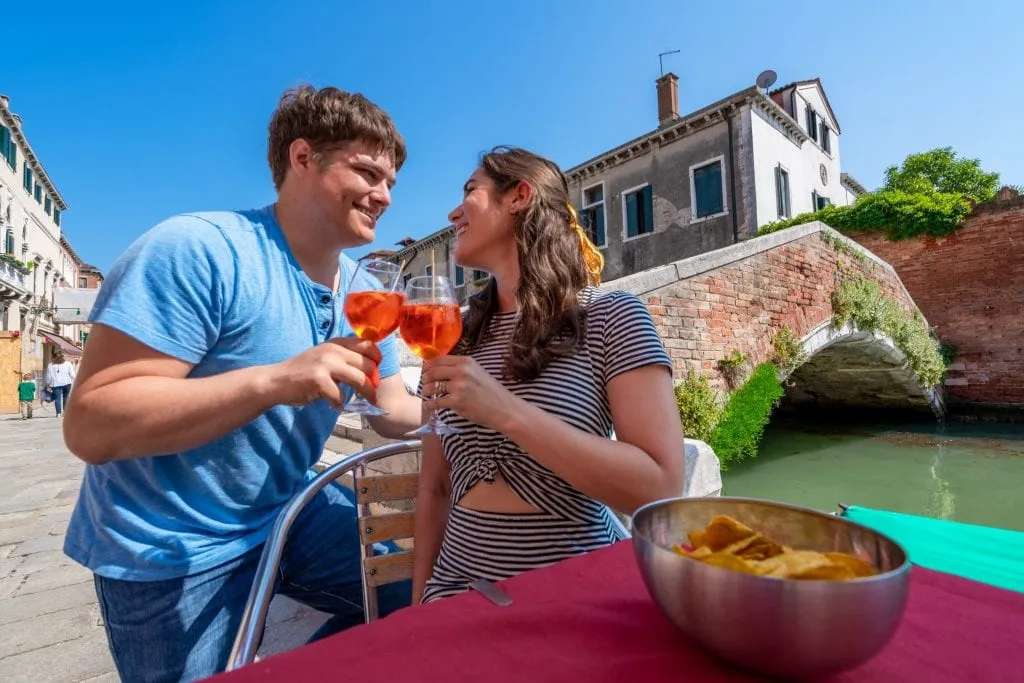
Reservations matter.
If you want to eat at a particular restaurant, especially in a major city like Rome, make reservations!
Your hotel concierge can help with this if you like, but many restaurants have an online reservation option as well.
For a casual neighborhood trattoria, making a reservation can be as simple as stopping by during lunch to reserve a table for dinner.
Specify what kind of water you want.
Acqua naturale is flat, and acqua gassata is carbonated.
They’re both generally the same price and will come in a bottle.
You can also usually request an acqua grande , or big water, which is typically one liter to share amongst the table.
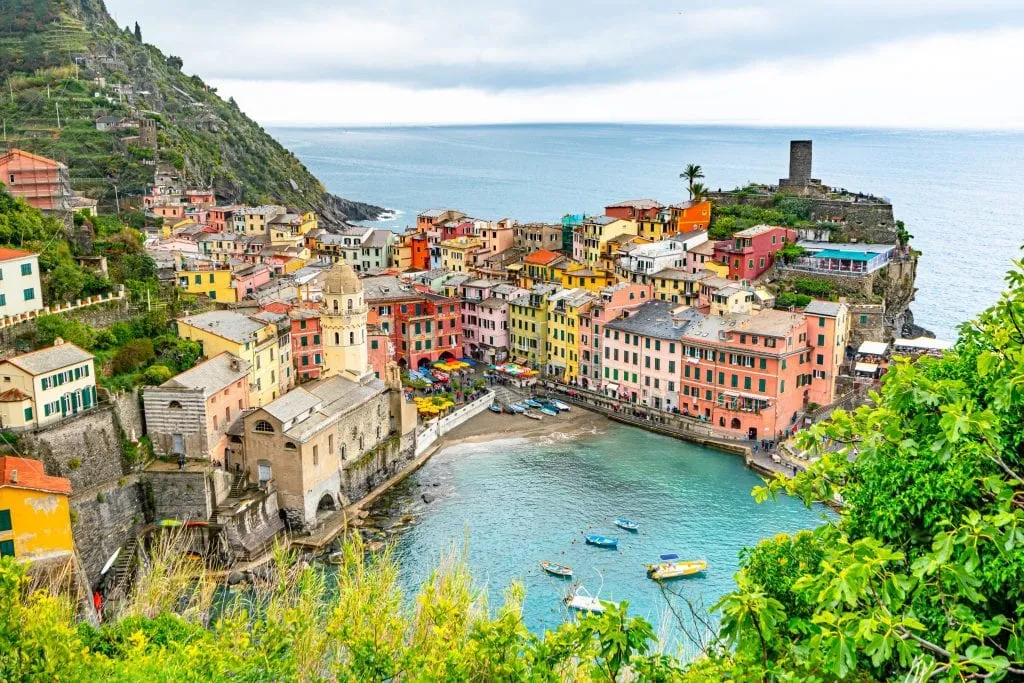
Don’t dip your bread in olive oil.
A small amount of olive oil drizzled over fresh bread? Delicious.
Dipping your bread in oil and letting it get soaked? Too heavy–according to the Italians, anyway.
My American self still loves it (but I generally save that indulgence for home).
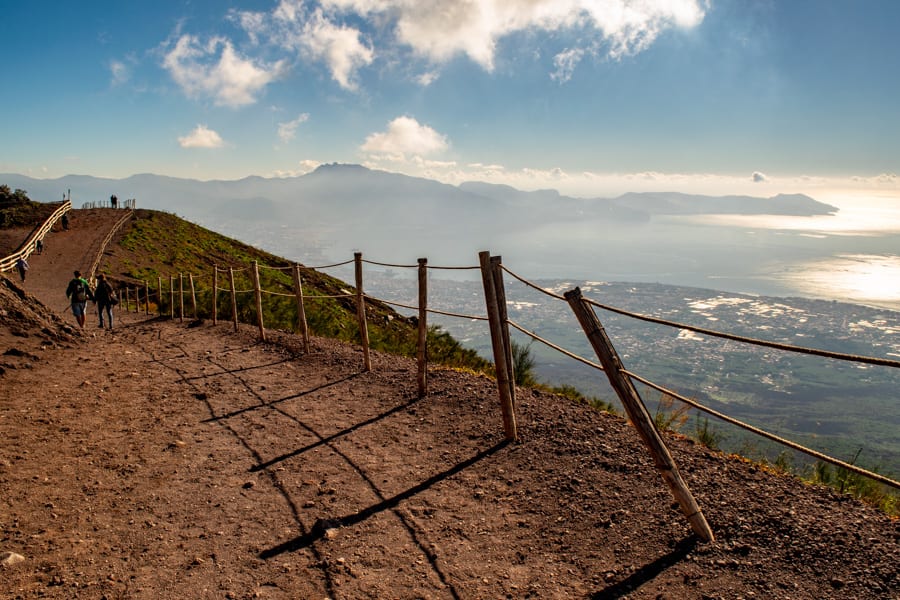
Pasta noodles are not interchangeable.
Pasta shapes don’t exist for fun–they’re designed to be served with certain kinds of sauces, and what you order matters!
Don’t special order different noodles with a dish (in fact, as a general rule, avoid special ordering in Italy unless it’s due to dietary restrictions).
If you have your choice of noodles and sauce, ask which is the best noodle for the dish you’re after.
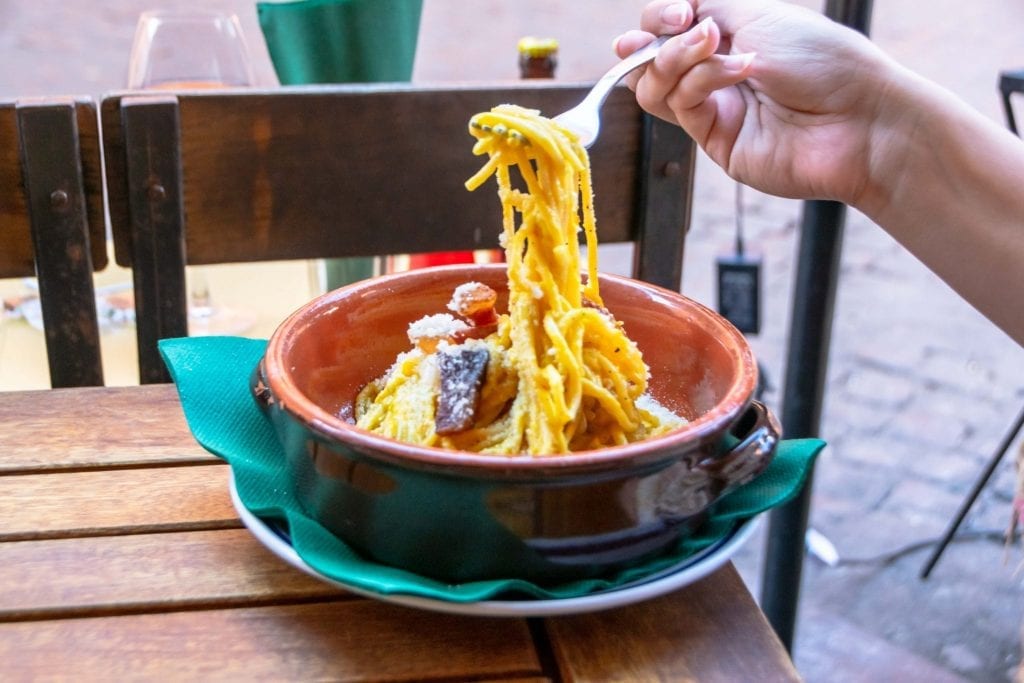
Slow service doesn’t mean bad service.
Courses aren’t rushed in Italy, and your waiter will never bring your check until you ask for it.
If you want to pay by card, ask for the card machine when you ask for the check.
Your waiter will bring the machine right to the table and run the card in front of you.
In Italy, and in Europe overall, it is considered a major faux pas to ever remove a credit card from the sight of its owner!
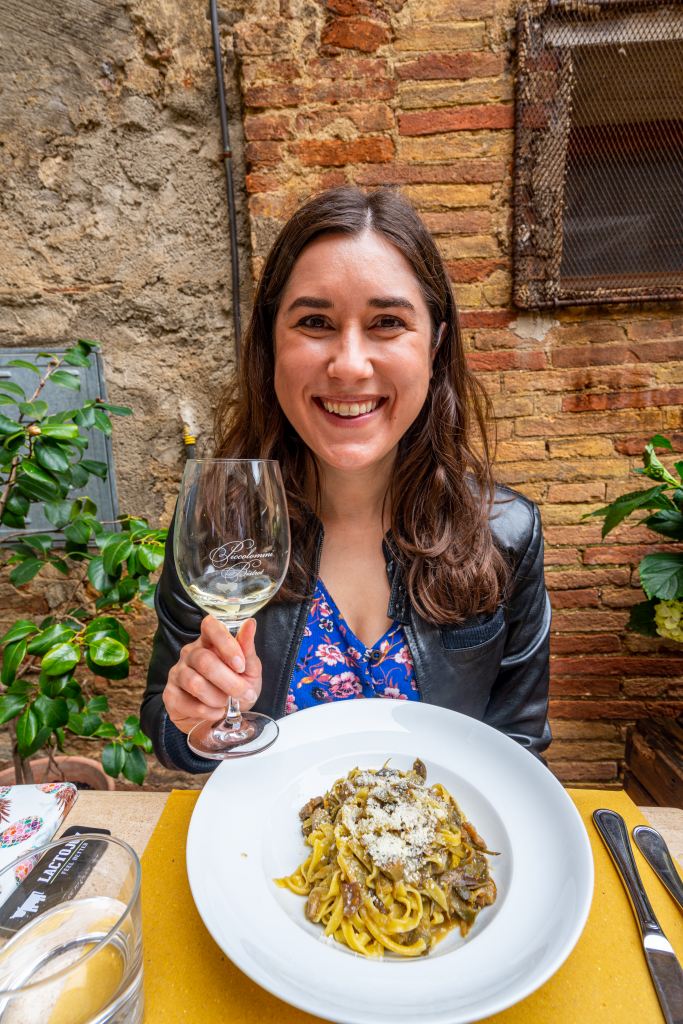
If you order pepperoni on your pizza in Italy, you’ll receive a pizza with peppers.
The closest approximation to American-style pepperoni pizza in Italy is a diavolo , which is served with cheese, salami, peppers, and sometimes olives.
We go into more specifics on typical Italian pizzas and toppings in this pizza guide !

Travel Tips for Grocery Shopping in Italy
The most common supermarket brands in italy are spar, carrefour, and conan..
You’ll find at least one of these in any given Italian city.
Size varies dramatically, though, from giant supercenters in the suburbs of major cities to tiny “express marts” that are barely more than a corner store.
Use plastic gloves when handling produce in the supermarket.
I’ve found that this one varies by region, but when in doubt, look and see what the other shoppers are doing, and choose whether or not to use gloves accordingly.

You’ll weigh your produce in the supermarket yourself.
In the USA, you’ll bag your produce and then it will be identified and scanned at the register–but in Italy, that’s your job.
When browsing, you’ll notice that each type of produce will be marked with a number.
Take the number to the nearby scale, place your bag of produce on it (one type at a time, obviously), and press the respective number.
A sticker will automatically print with a barcode, weight, and price.
This is the opposite of what happens in markets.
In markets, the vendors will select your produce, though you can sometimes point to a particular piece if you want a certain apple or orange.
Vendors do not take kindly to people, say, rooting through their pile of apples.
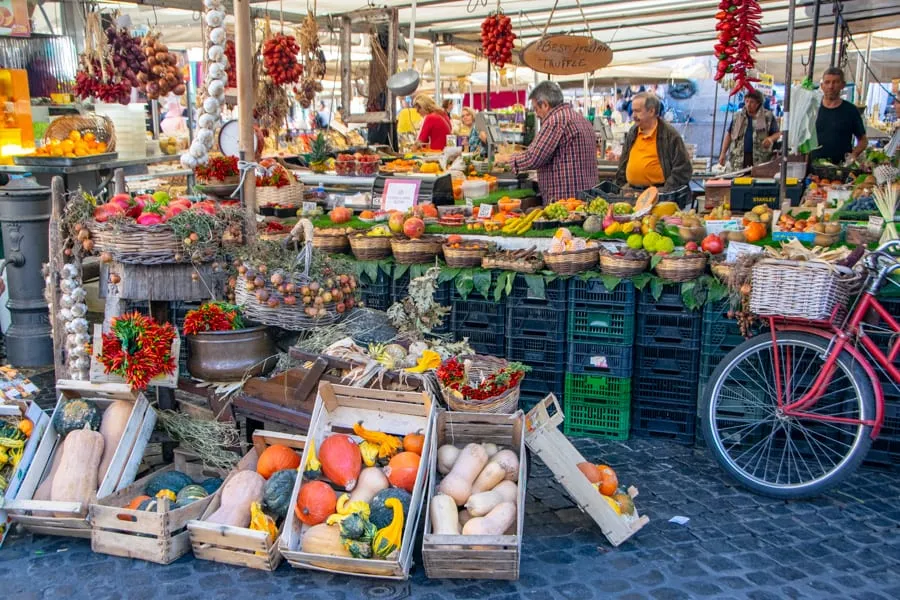
If you love Italian wine, go to the grocery store.
… And delight at finding what would be a $30 bottle in the USA for a mere 5-10 Euros!
Consider buying produce at the market.
You’ll often find better quality produce for less money than the supermarket, especially in smaller towns.
Major supermarkets often stock fine produce, but the smaller stores, not so much.
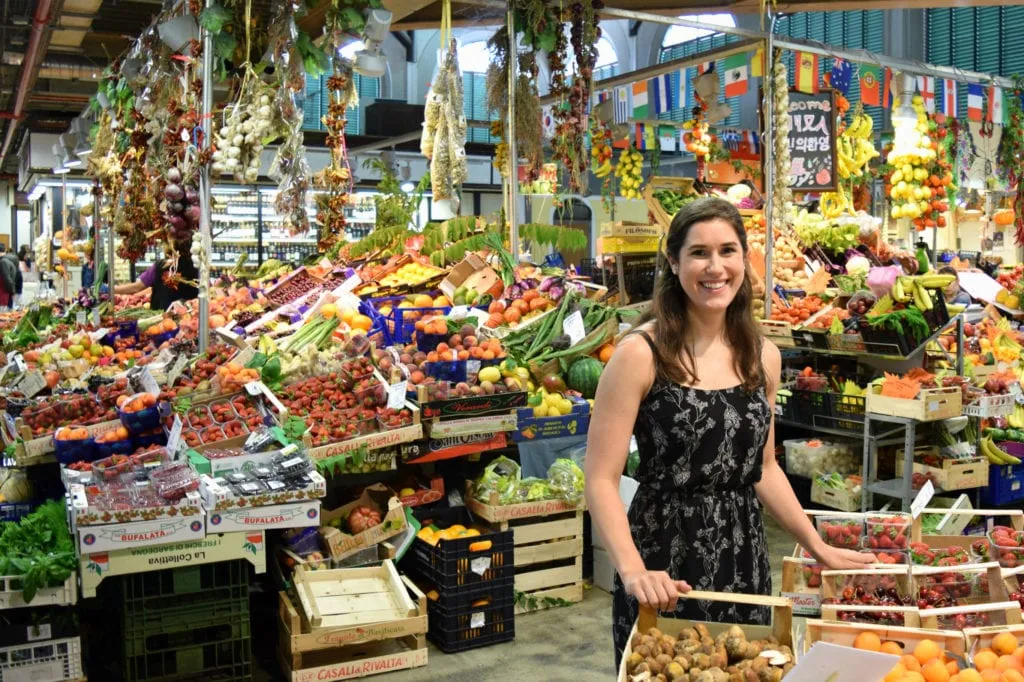
Don’t expect free plastic bags to carry your groceries in.
Plastic bags come with a small charge in Italy.
They’re available at the register in the supermarket, and you’ll either place however many you need on the conveyor belt yourself, or, if they’re stored under the register, the cashier will ask you how many you want (if any).
Of course, the best thing to do is to bypass this problem entirely and bring a reusable bag!
We love our tote bag and have been using it to buy groceries in Italy (and for a myriad of other things) for years.
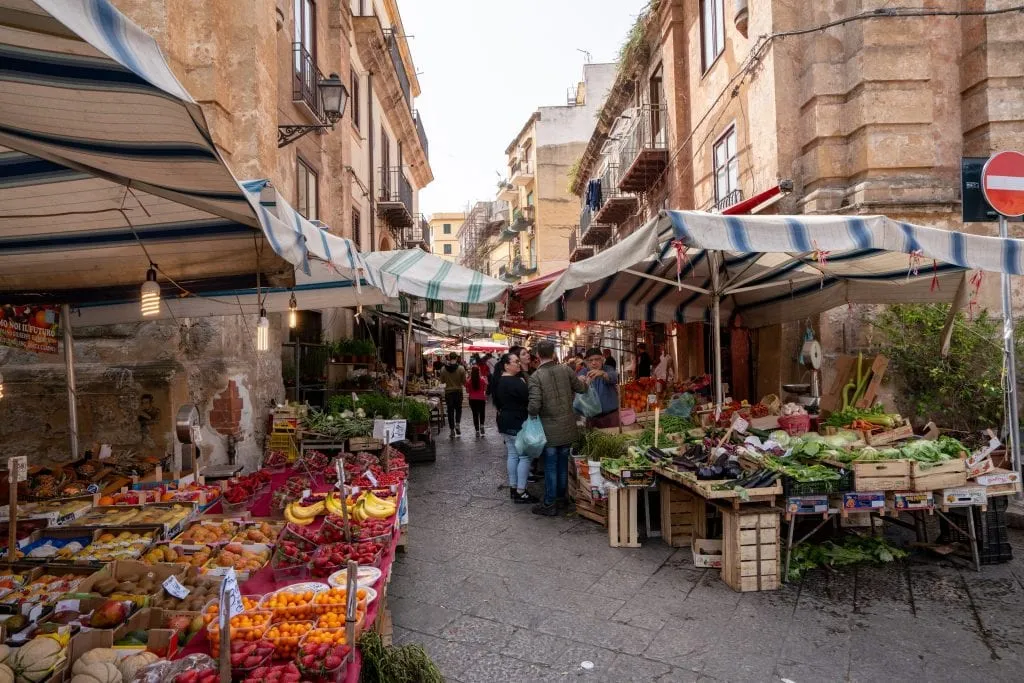
Tips for Driving in Italy
Your normal car insurance company may not cover car rentals in italy..
Be sure to double-check before renting a car!
It’s important to m ake sure that they cover Italy specifically, not just some places in Europe.
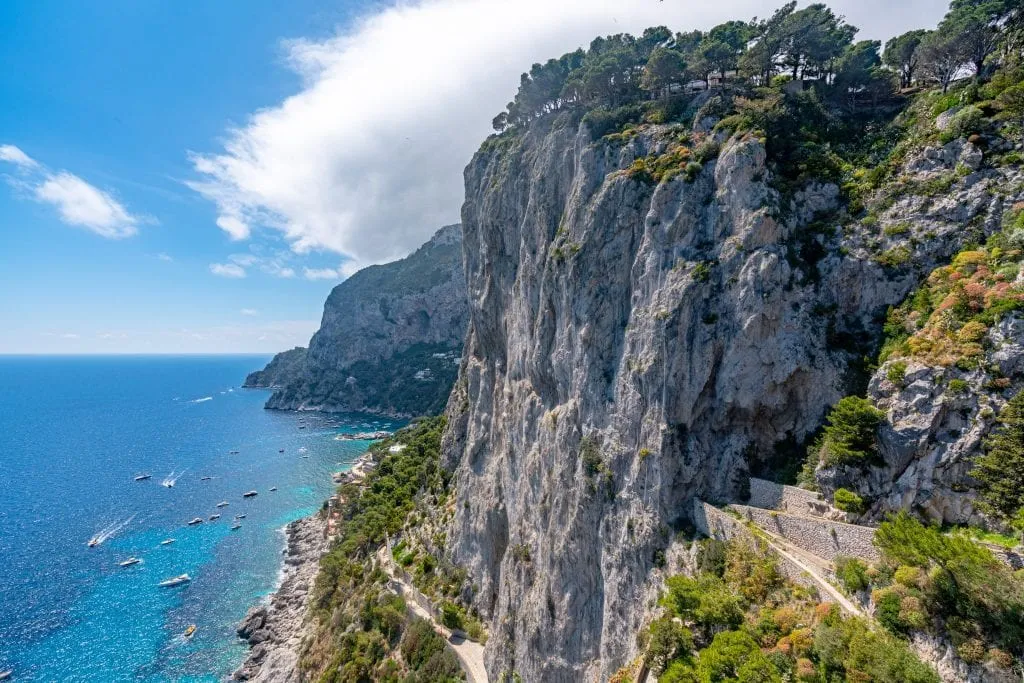
You may not know if you get a ticket while driving.
Tickets are often given out by mail based on violations caught on camera, so you may come home to an unexpected bill!
It’s forbidden to drive into most historic centers.
These are called “ZTL zones” and it is imperative that you avoid them when driving except under very limited circumstances (like having permission to park your rental car at a specific hotel).
… If you accidentally violate that rule because you’re lost, you may come home to one of the tickets mentioned above.
Ask us how we know…
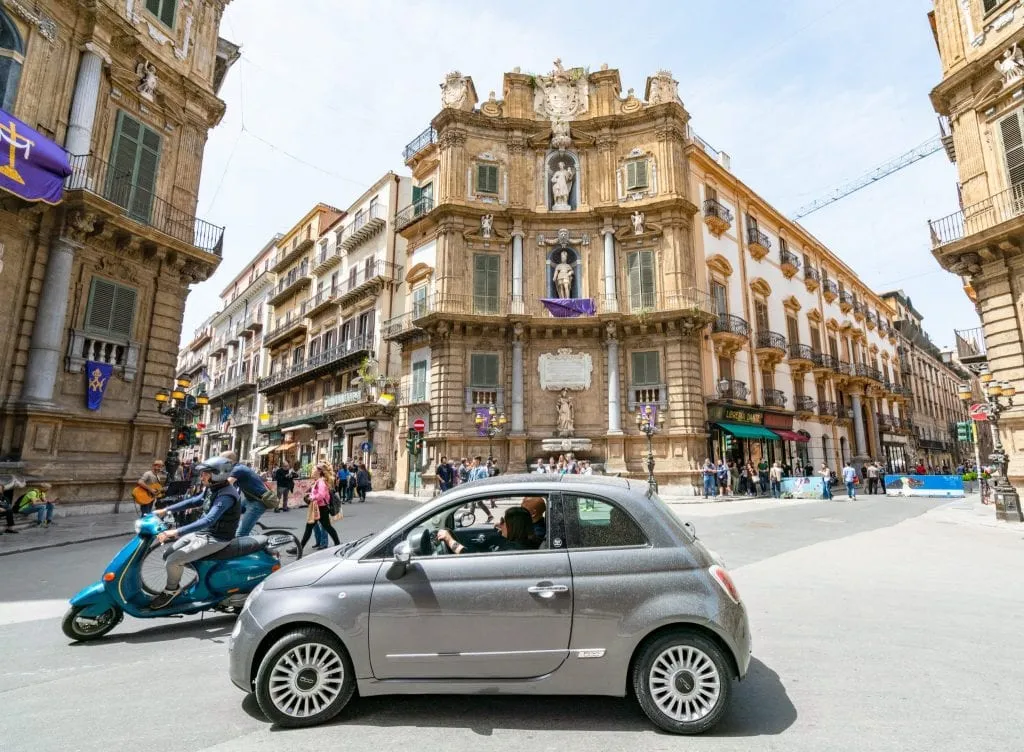
You need an International Driving Permit to rent a car in Italy.
The rental company may or may not ask you for it, but the last thing you want is to be pulled over by a police officer and not have one.
International Driving Permits translate your license into local languages, and the official ones (the only ones that count) must be arranged for before your trip.
We usually obtain ours through AAA.
International Driver’s Licenses, offered for a fee by various online services, are not the same thing and don’t fulfill the requirement.
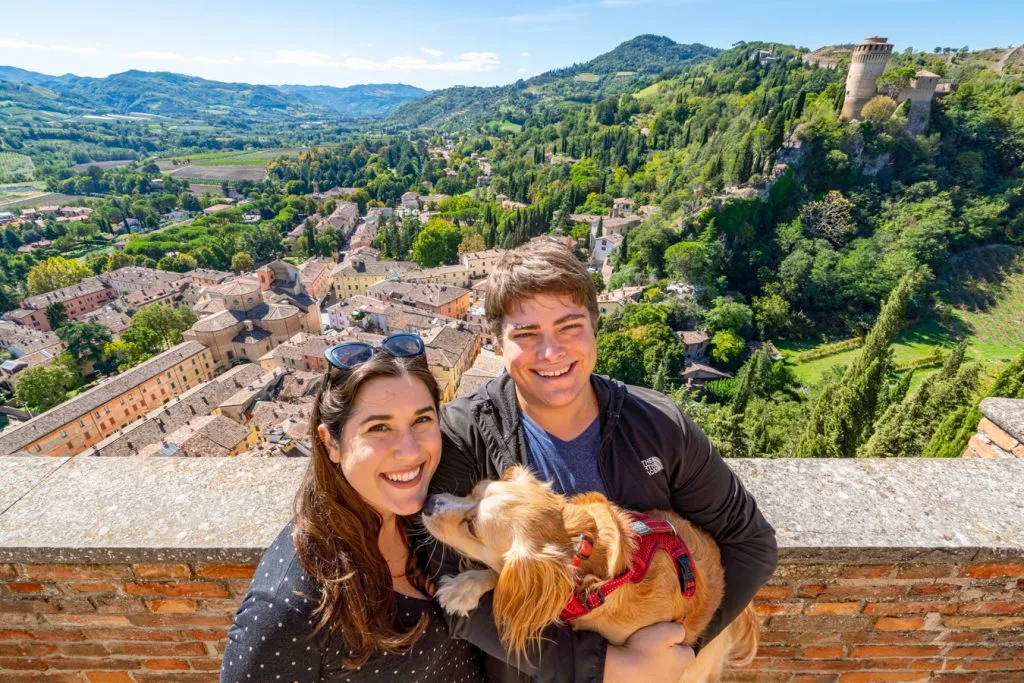
Rent the tiniest car that you can fit your belongings into.
Italian roads, parking spaces, and vehicles are all much smaller than their North American counterparts.
It’s a simple but essential piece of advice for traveling in Italy that life will be much easier if you’re driving a small car!
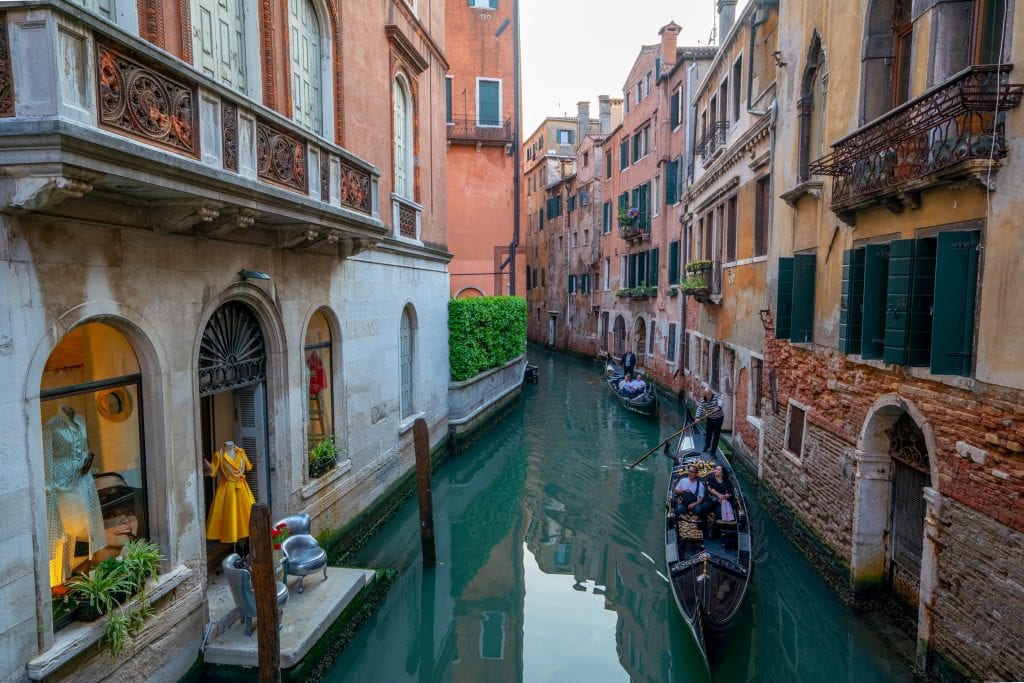
Knowing how to drive a manual will make life simpler.
Most car rental companies keep a few automatics on hand for international visitors, but manual cars are standard in Italy (and all over Europe).
You’ll pay much less–and have much more vehicle choice–if you can drive a manual.
Pay attention to the color of your parking space.
Generally speaking, white parking spots are free to use, blue spots are paid (look for the nearby meter), and yellow spaces are to be avoided.
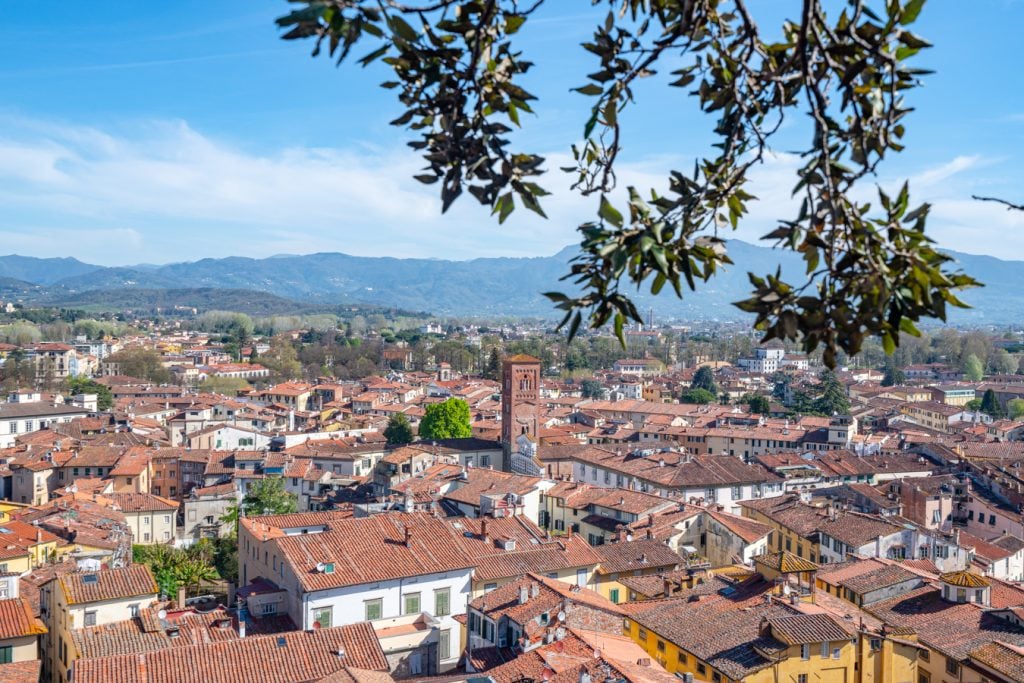
Train Travel Tips for Italy
Trenitalia is the most prevalent train company in italy..
This is Italy’s national train company.
They have the most routes, and in our experience, typically the best prices.

You’ll also see Italo trains and (rarely) Trenord trains in Italy.
Italo is a private company that operates some routes in the country, especially high-speed ones.
Trenord is similar, but much more limited in scope.
You can expect to find these trains in Lombardy, such as around Milan and Lake Como.
Omio is a great place to plan train travel in Italy.
Omio is a transportation aggregate that simplifies planning transportation routes in Italy (and beyond).
You can check prices and compare rates, schedules, and more on Omio to ensure you’re getting the best deal on train (or bus) travel in Italy.
We use Omio regularly throughout Europe and have always had good experiences with it.
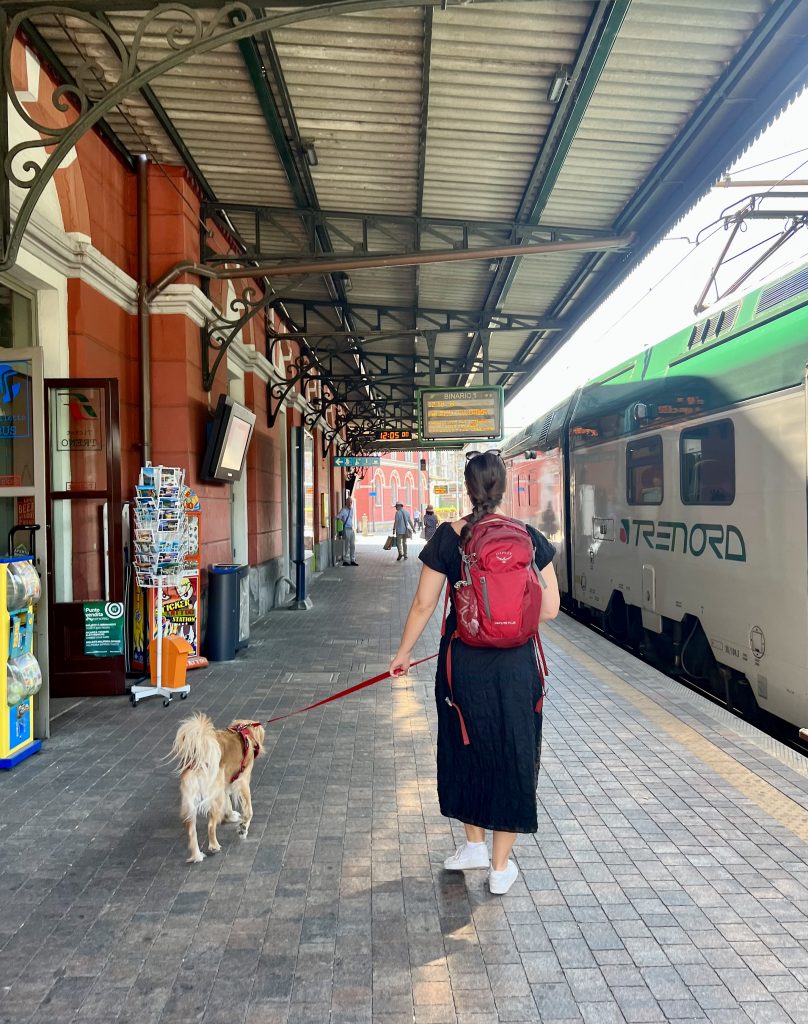
You must validate your train ticket!
… If you have a paper ticket, that is.
Instead, consider downloading the Trenitalia and/or Omio app.
This will allow you to purchase train tickets on your phone, and the conductor will then be able to easily scan your ticket from there–no validation required.
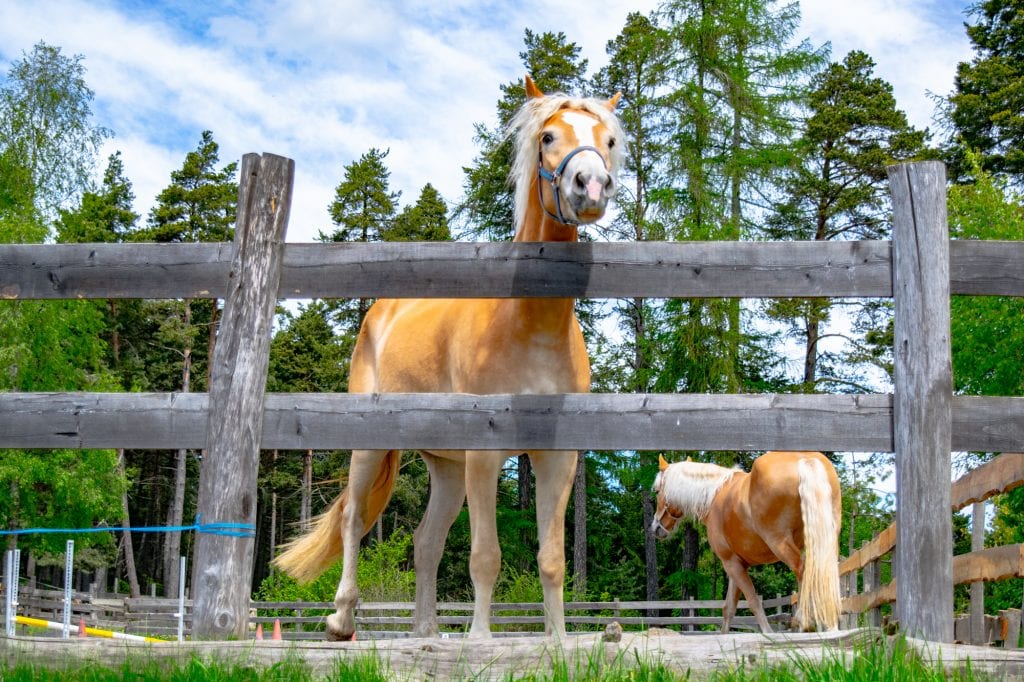
However, you’ll need to download or screenshot your tickets immediately after purchase.
Without an Italian tax ID number, you’ll need to use the Trenitalia app as a guest, and therefore your tickets won’t be saved within the app itself.
This sounds more intimidating than it is, but it’s something to be aware of.
You can buy regional train tickets whenever you want.
These are the “slow” trains, and their prices are set by the government.
For example, if you want to travel from Florence to Bologna on the slow/regional train, you can simply show up and buy your ticket that day, and no advance planning is required.
If you wanted to take the high-speed train though (for this route, roughly 30 minutes of travel versus an hour), booking in advance would yield the best price.
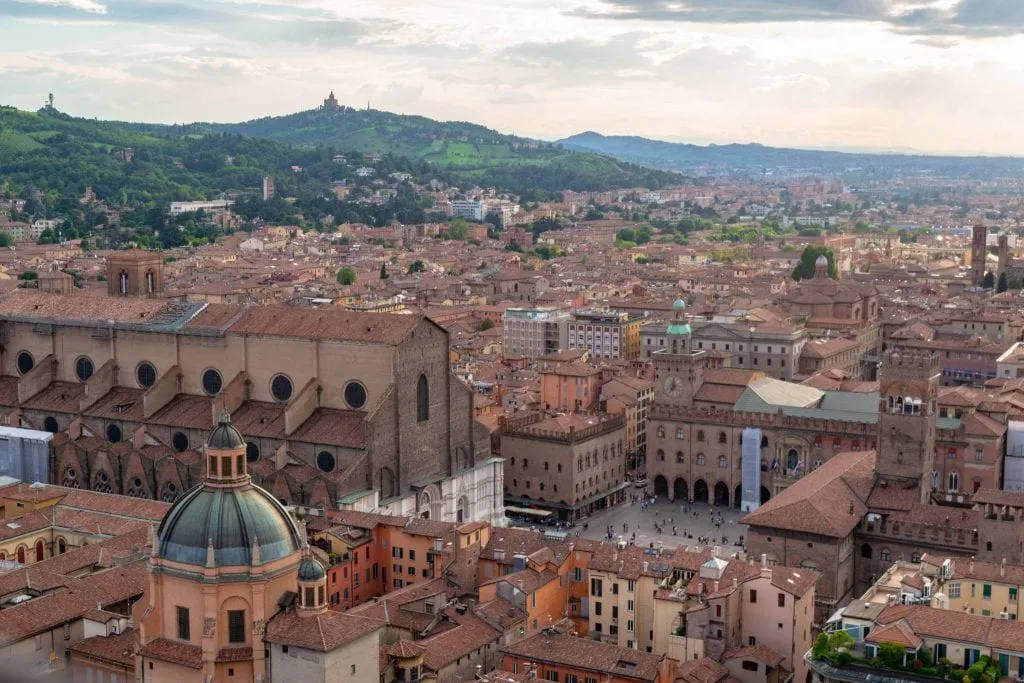
However, high-speed rail tickets must be purchased ASAP.
These tickets escalate in price as the date of travel gets closer.
So, for example, if you want to travel from Florence to Venice , it helps to plan ahead!
Fast trains are called AV (or Alta Velocità) trains.
You’ll most commonly see them marketed as Frecciarosa , Frecciabianca , or Frecciargento , depending on what region you are in.
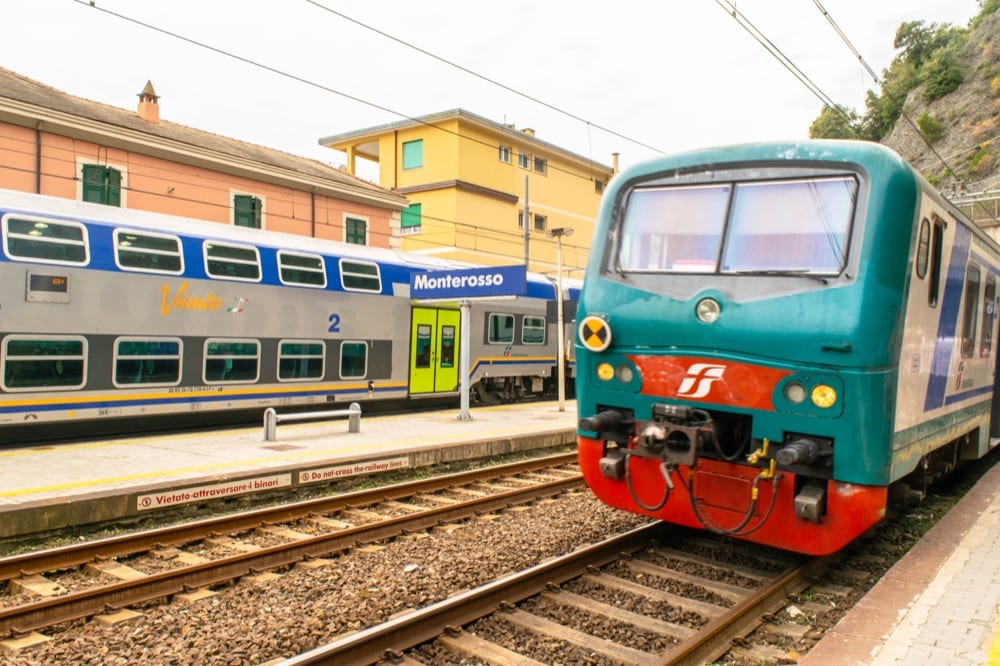
Bus Travel Tips for Italy
Tabacchi are your friends..
An Italian tabaccheria (aka tobacco shop) sells cigarettes, but also bus tickets.
… And lotto tickets, and sometimes SIM cards, and usually snacks. Think of them like gas stations in the USA, but you know, without selling gas.
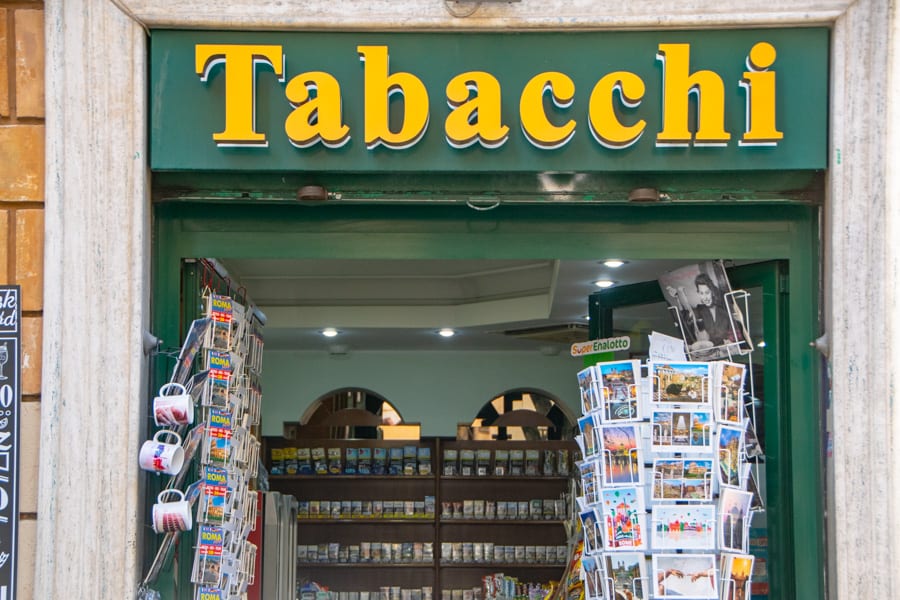
… This is important because not all Italian buses sell bus tickets.
Looking at you, Rome.
Before boarding a bus in Italy, it’s best to always have a ticket in hand–and don’t forget to validate it once you board!
Make sure you have enough bus tickets for Sunday.
Since many tabacchi and other small shops are closed on Sundays, you might not be able to buy more.
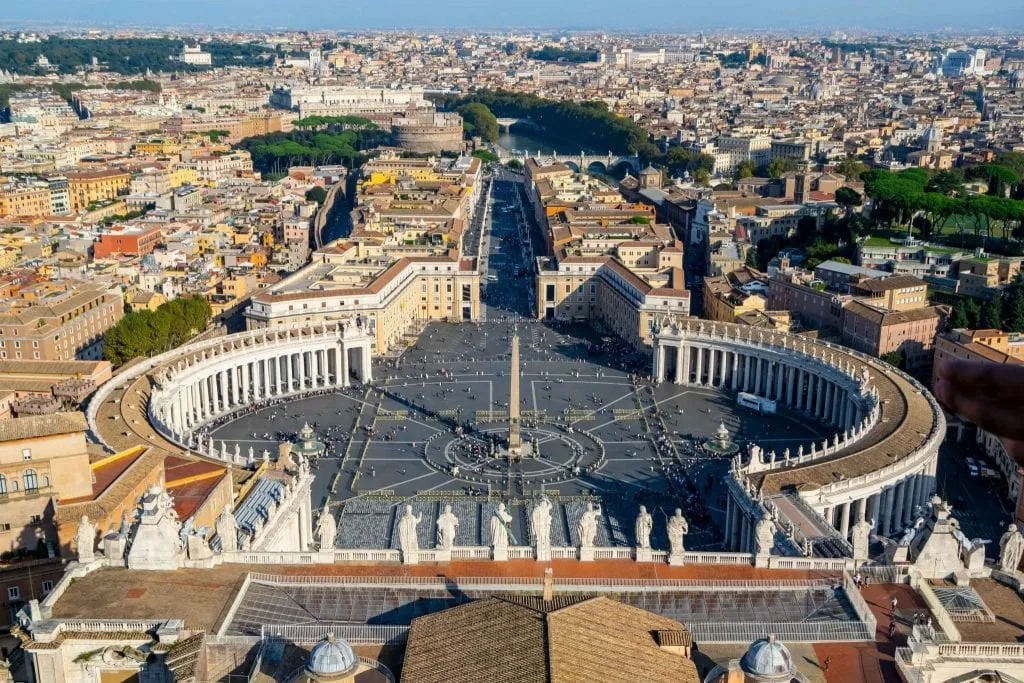
For inter-city travel, check Flixbus.
The low-cost budget carrier has quite a few routes in Italy, and if you’re trying to visit Italy on a budget, it might be the cheapest way for you to get around.
Flixbus tickets are also available through Omio .
Tips and Advice for Flying in Italy
Double-check your airports..
Many budget airlines fly to airports just outside of major cities, so be sure you’re headed to the right place before packing your bags!
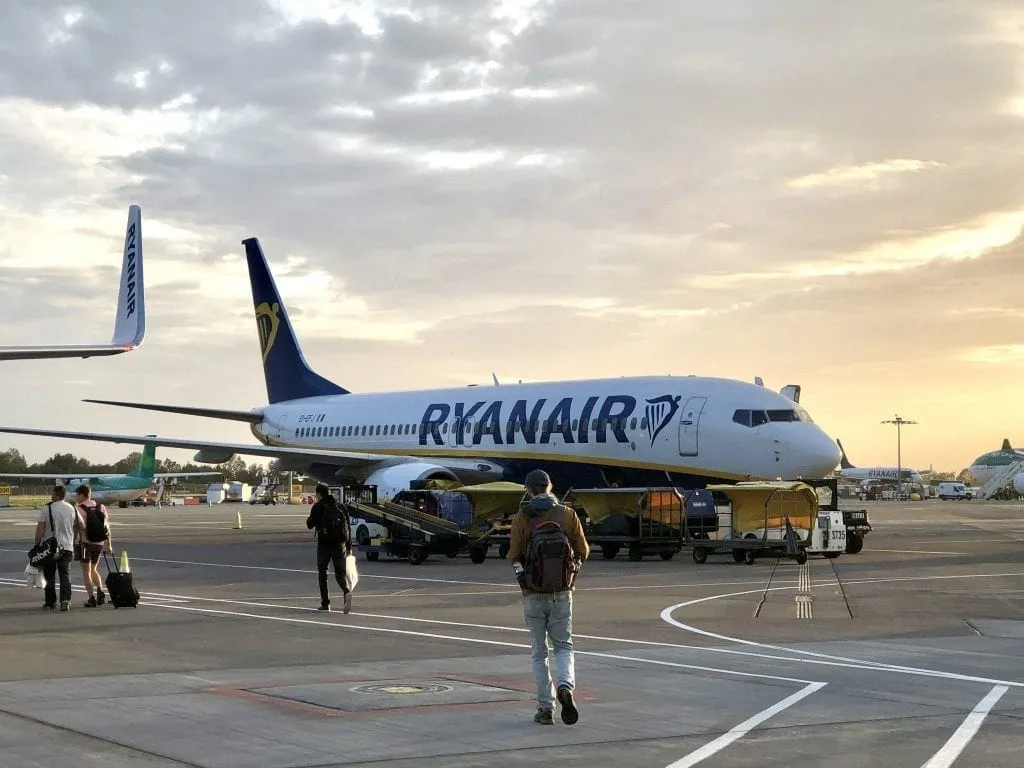
… And also your prices.
It’s not great for the globe, but from an economic standpoint, it can often be less expensive to fly domestically in Italy than take the (fast) train.
If you’re on a budget, check both (plus buses) before booking anything.
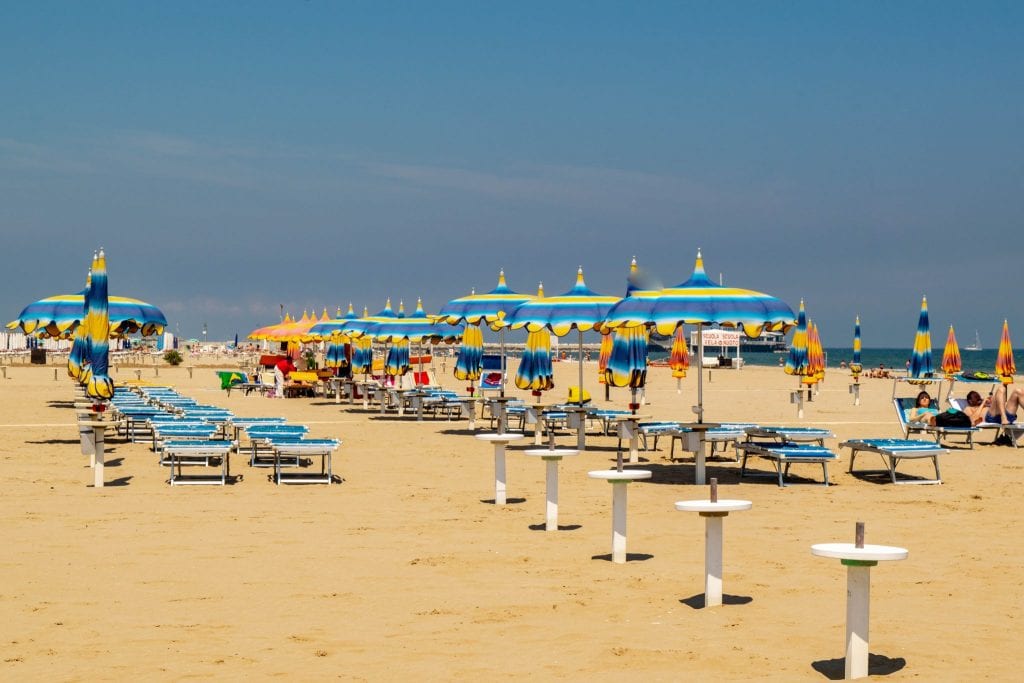
Don’t bother showing up at the airport more than 2 hours before your flight.
If you have to check bags, the counter won’t take them, and you’ll be stuck outside security until the 2-hour mark.
This actually goes for most of Europe , not just Italy, but it’s a huge change as compared to flying in the USA!
Other Tips for Getting Around Italy
Train and bus strikes are common in italy..
Be sure to leave yourself plenty of extra time to get around on important days (like when catching a flight).
Luckily, Italians schedule their strikes in advance, so if you’re worried about a particular date, ask around to see if anything is coming up.
This isn’t an everyday thing–I think we’ve run into it about 3 times in all of our time spent in Italy–but it’s far from unheard of.
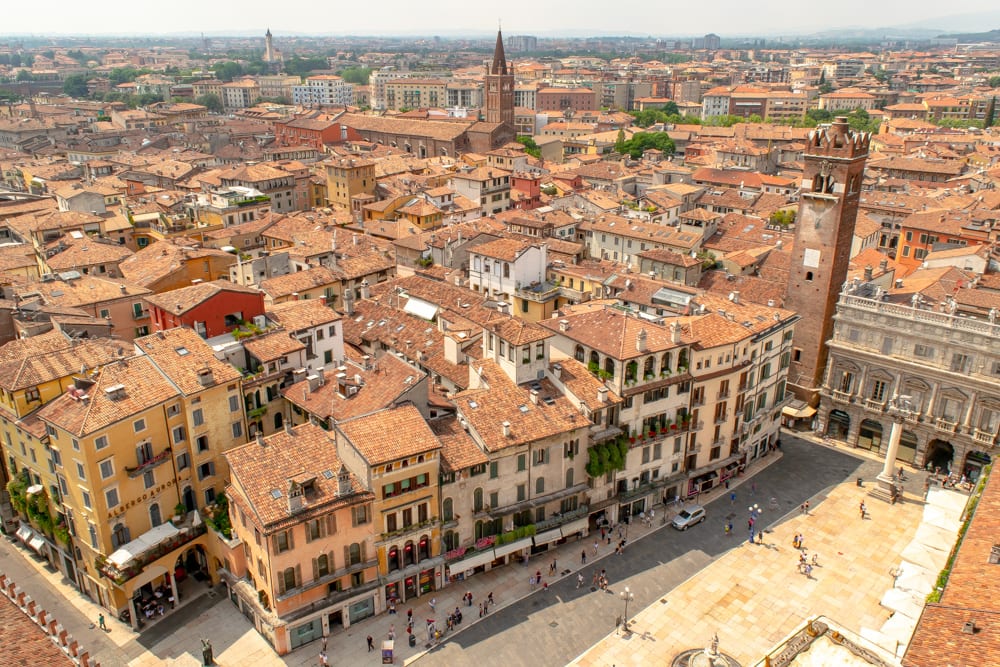
Taxis are notorious for ripping people off.
Not just an Italy problem, of course, but you definitely need to be aware of it.
The FreeNow app –sort of a local Uber that connects to local taxis, if you will, can help with this, and you can then use a credit card to pay through the app.
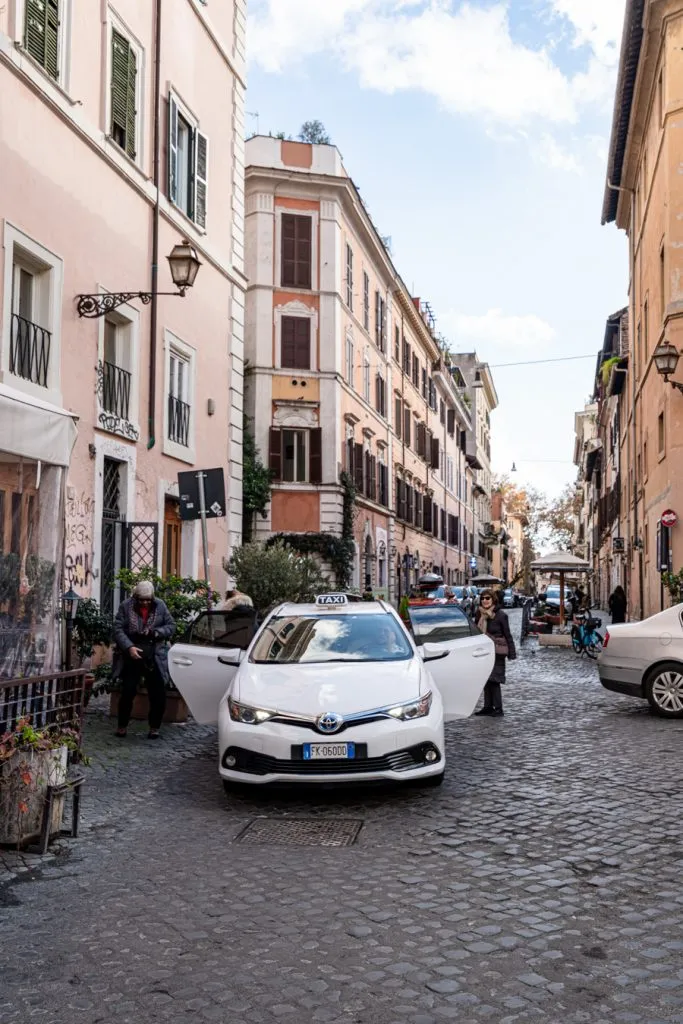
Have a transportation plan before leaving the airport.
Train, bus, taxi?
Know exactly how you’ll be getting from the airport to the hotel before you arrive, and your day will be much easier for it.
If you’ll be taking a taxi, look up and see if there’s a flat/set fare to get to the city center from the airport–there usually is, and it’s government regulated.
However, that won’t always stop drivers from telling you that your hotel isn’t in the center (it probably is).
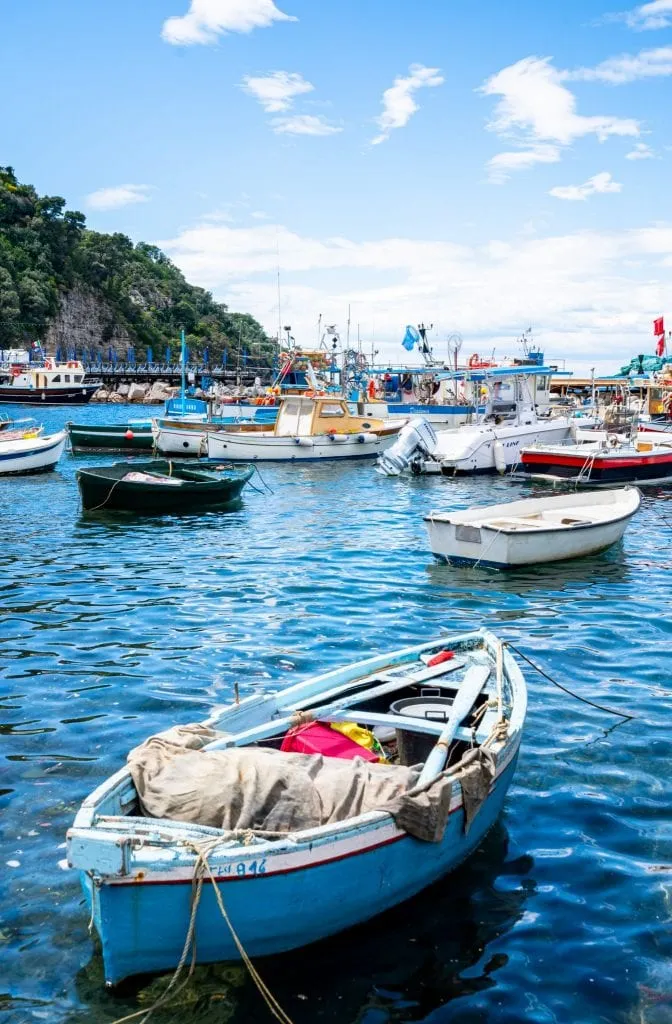
Bags may cost you.
Everyone knows that you have to pay for luggage on airplanes, but in Italy, luggage can also cost you on the bus or in a taxi.
This is another thing to confirm with your taxi driver before getting into their vehicle !

Uber only exists in a very limited form in Italy.
Currently, the only form of Uber that exists in Italy is Uber Black, and it only has a presence in Rome and Milan.
Uber has been engaged in back-and-forth legal battles in Italy for years, but as a general rule, don’t count on using Uber in Italy.
FreeNow is a great alternative and is what we use in Italy (and in many places throughout Europe).
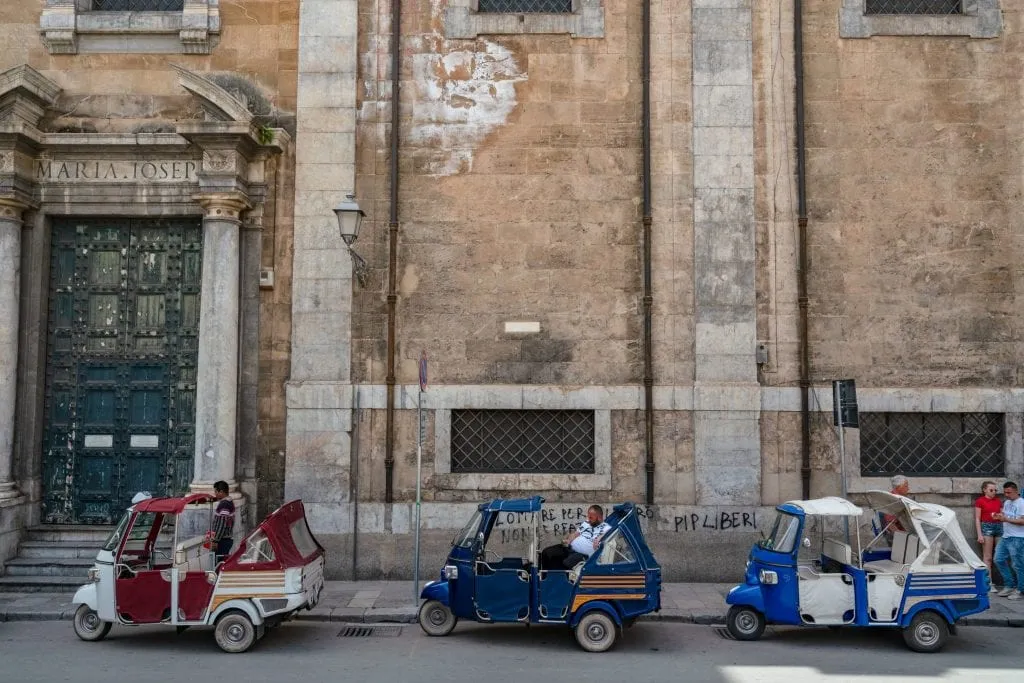
Card payments are increasingly prevalent in Italy.
You’ll be able to use your credit card regularly to purchase meals, groceries, train tickets, etc.
However, don’t use a card for small purchases.
For small items like gelato or coffee (both very important parts of any trip to Italy), it’s best to have cash on hand.
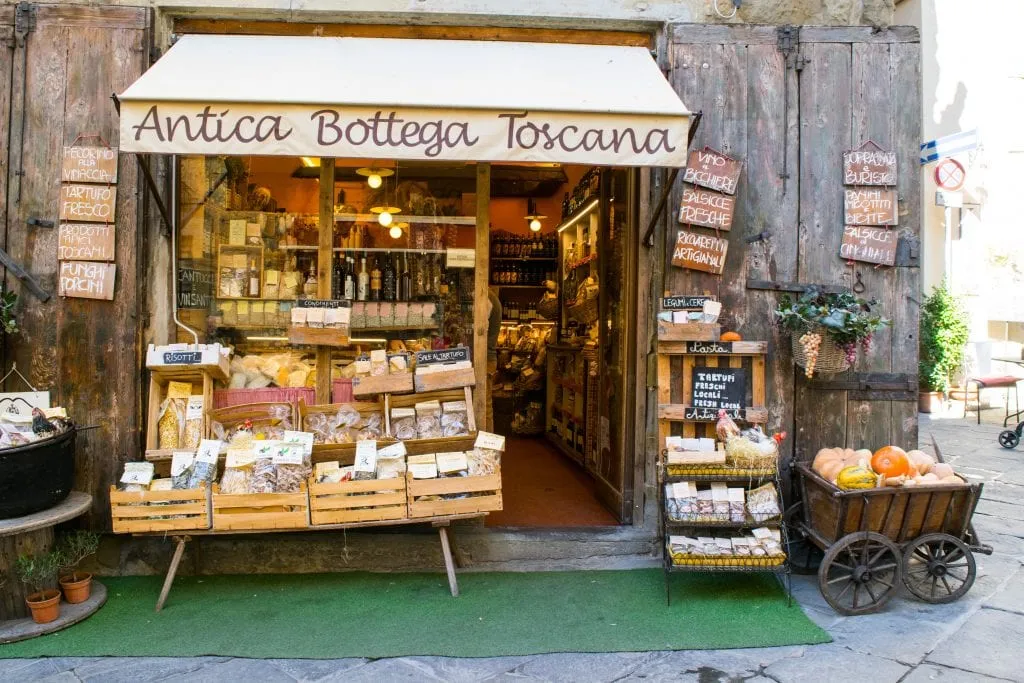
In fact, always have Euros on hand.
You never know when you’ll accidentally walk into a cash-only restaurant.
Bring a Visa or Mastercard to Italy.
Discover, Diners Club, and American Express are not as commonly accepted.
… And ideally one with no foreign transaction fees.
Credit cards with no foreign transaction fees are so common these days that it’s a shame to use anything else when visiting Italy!
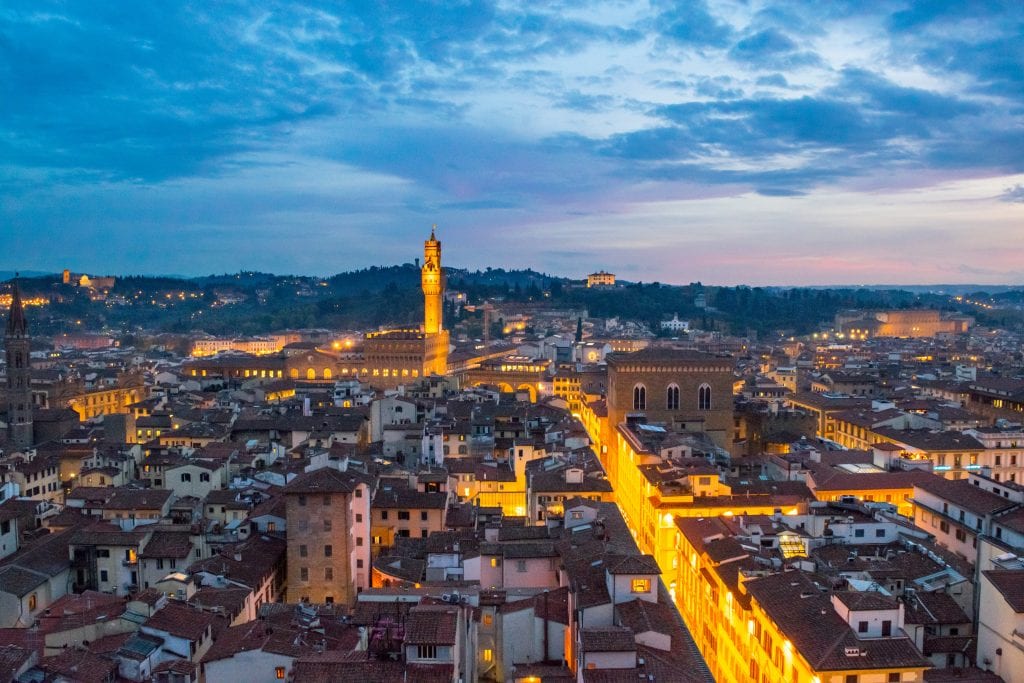
ATMs are the best way to get Euros in Italy.
If you’re from the USA like us, we love having our checking account with Schwab for this reason!
T hey refund all ATM fees worldwide, making getting cash from ATMs in Italy a breeze.
Even if you do have to pay an ATM fee, though, the ATM (or bancomat in Italian) is still the simplest way to get cash in Italy.
Avoid Euronet-branded ATMs.
Euronet ATMs are all over Europe, generally in very convenient places, and their exchange rates and fees are absolutely abysmal.
Instead, look for ATMs at the branches of local banks.
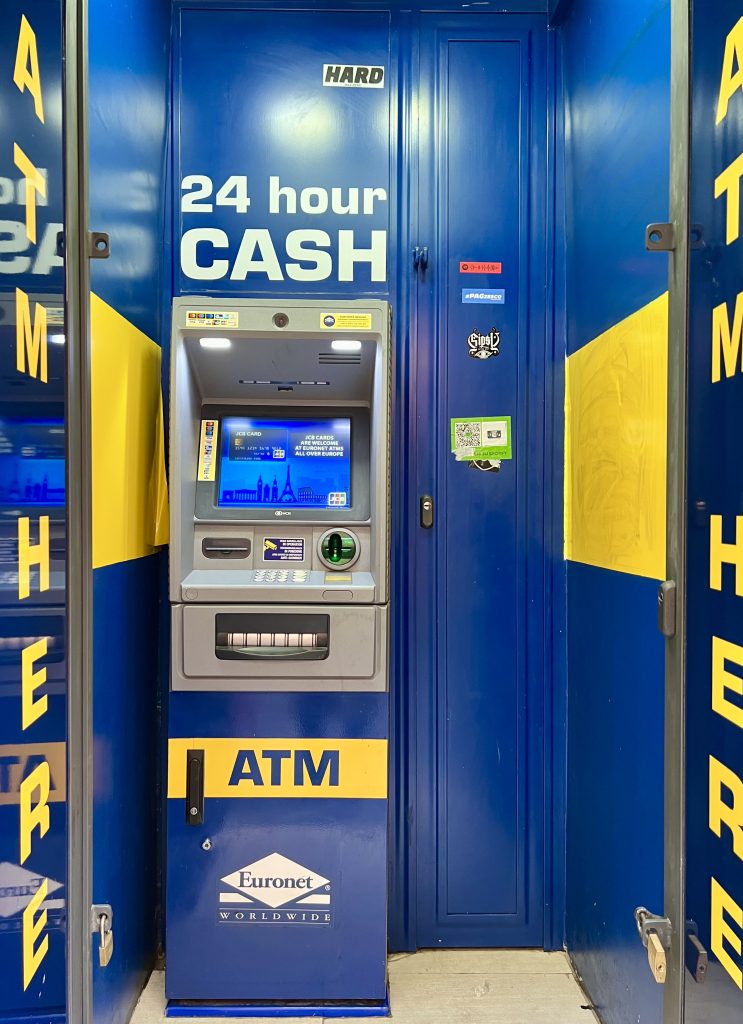
Strongly consider purchasing a SIM card in Italy.
They are very inexpensive, can be put into any modern unlocked phone, and having data will make your trip to Italy infinitely easier.
We usually use TIM, but Vodafone is also popular.
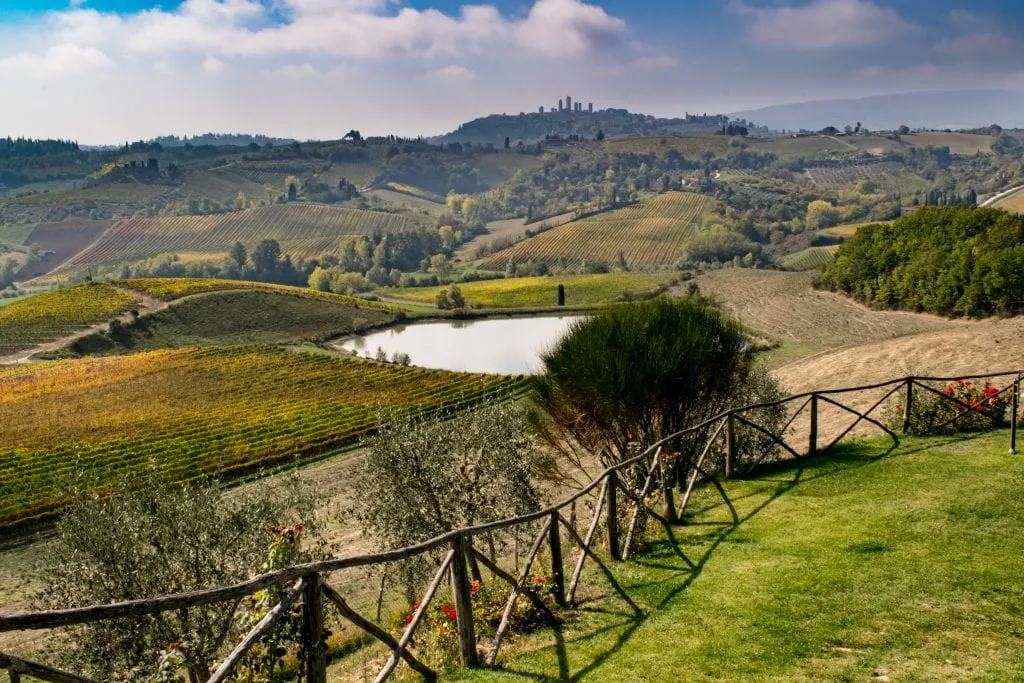
Bathrooms aren’t always free.
Half a Euro for a restroom is a good price. One Euro is acceptable. More than that, find somewhere else.
If you have a tiny bladder like me, planning ahead for restroom use is one of the most important travel tips for Italy (or at least it’ll feel that way when you’re wandering around Rome and can’t find a public bathroom).
Make a habit of visiting the restroom in any places you visit that have one included–this includes restaurants, bars/coffee shops, and museums.
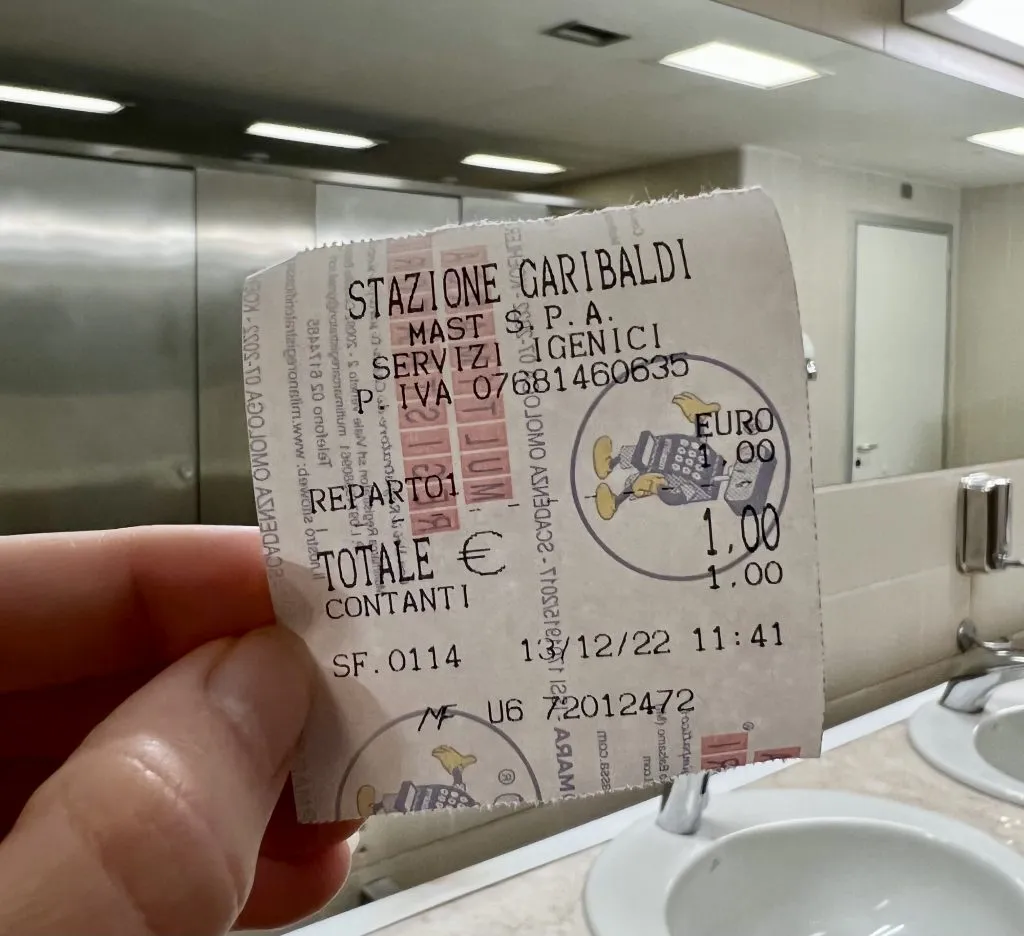
Squat toilets exist in Italy.
They’re not incredibly common, but the first squat toilet I ever saw in my life was in a Tuscan train station!
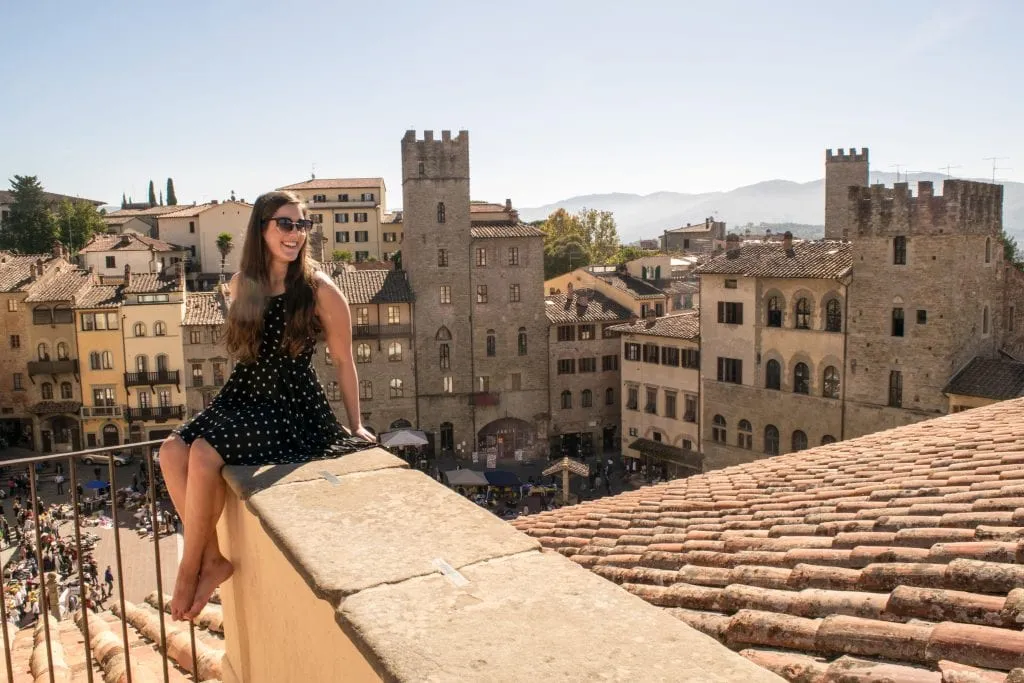
Carry a small pack of tissues, just in case.
Finding a restroom in Italy that is out of toilet paper is far from uncommon.
Be prepared for the Italian riposo .
This is Italy’s answer to the Spanish siesta , and you’ll find some shops closed in the mid-afternoon for this reason.
You won’t notice it as often in major cities in northern and central Italy, but in smaller towns and in southern Italy, it’s very apparent.
The exception is restaurants–you’ll see a riposo at restaurants just about everywhere.
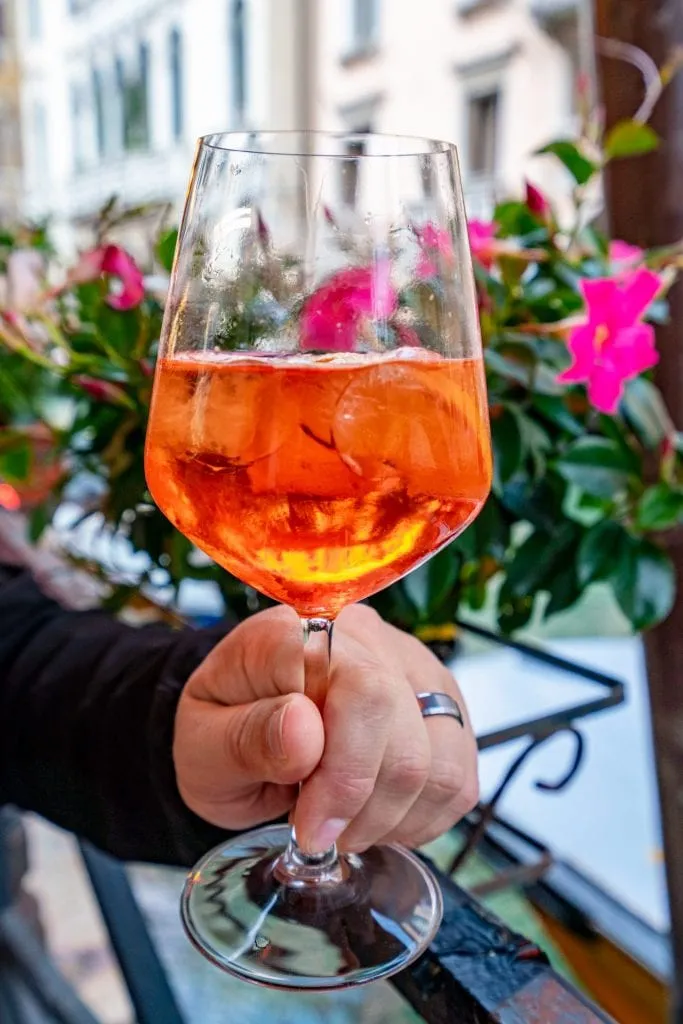
Seek out lesser-known piazzas in Italy.
Every city in Italy has its famous, central piazzas, from Piazza Navona in Rome to Piazza San Marco in Venice and beyond.
These places are beautiful and historic, of course, but they are also–inevitably–the most expensive place to enjoy a coffee or aperitivo in the city.
However, each city in Italy also has many piazzas to choose from (here are 15 of the best piazzas in Rome , and that’s just a small sample of what the city has to offer).
By heading to a smaller, lesser-known piazza, you’ll pay far less, be in a much more laid-back (and often local) environment, and get to indulge in just as much people-watching.
We love Campo Santa Barbara in Venice’s Dorsoduro neighborhood , for example–but there’s no limit to the number of charming piazzas you can find in Italy!
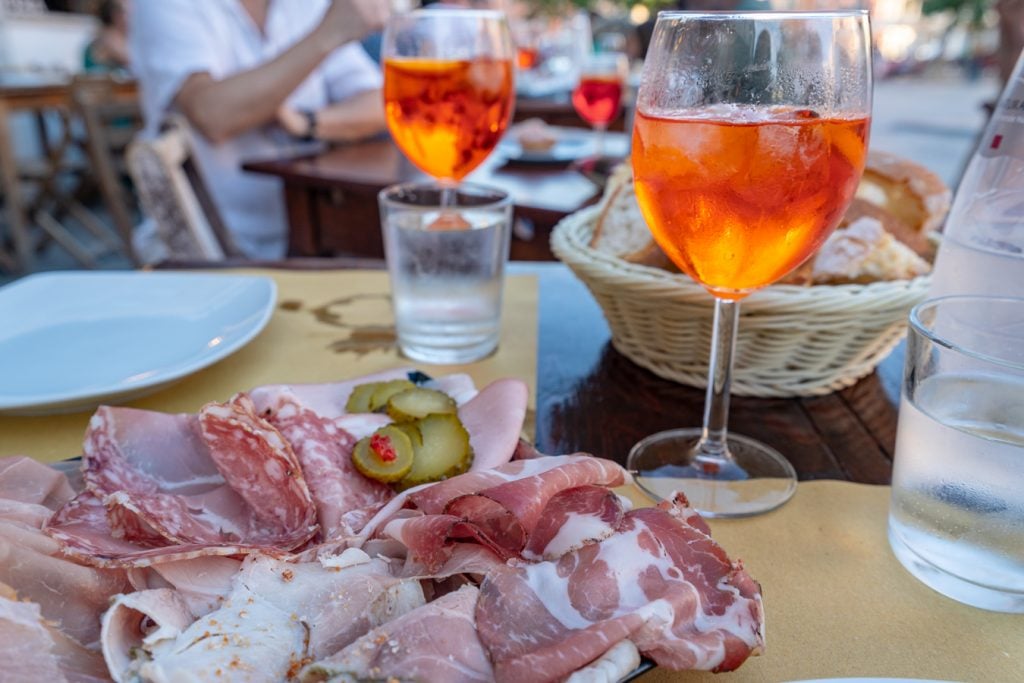
Monday is generally a terrible day to visit museums in Italy.
This is a very common day for museums to be closed, including the Uffizi Gallery in Florence, the Borghese Gallery in Rome, and the Galleria dell’Accademia in Florence.
The Vatican Museums are, unsurprisingly, closed on Sunday instead of Monday.
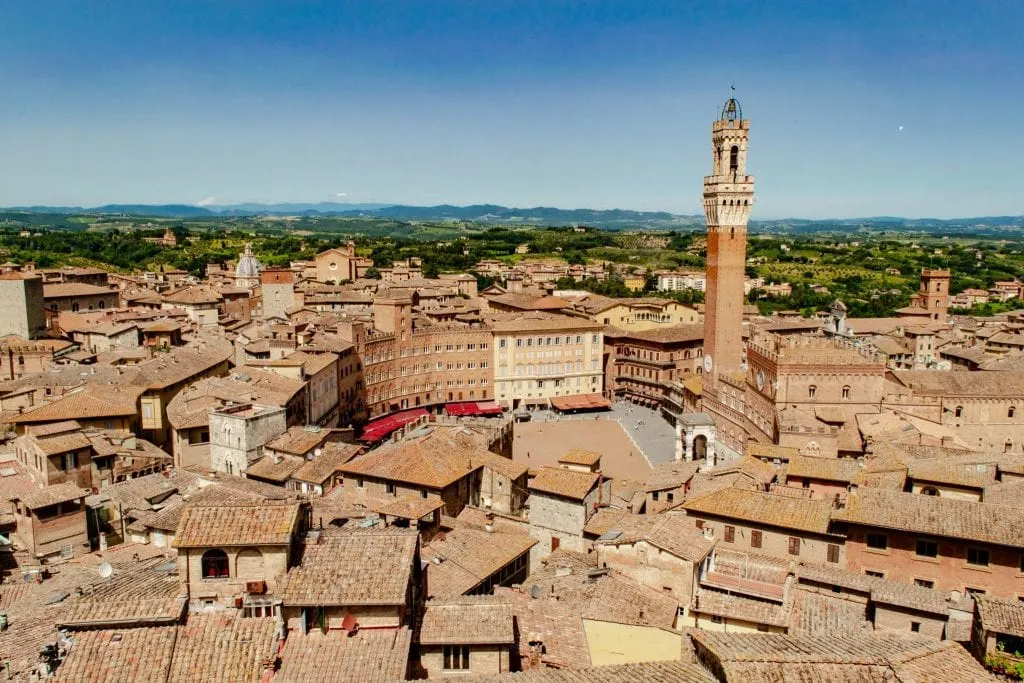
Take advantage of skip-the-line tickets at all popular attractions.
They’re generally available for a small upcharge (sometimes even no upcharge!) and will make your visit to Italy so much smoother.
We book all of our tickets for major Italian attractions like the Uffizi Gallery , Colosseum , Vatican Museums , Doge’s Palace , etc, on Get Your Guide .
You can drink from the fountains.
The small, pretty fountains found all over Italian cities?
That water is potable, and you can absolutely take a swig or even refill your water bottle there.
We love taking advantage of these fountains every chance we can and always miss them when we’re traveling in cities outside of Italy (and our dog Ranger is an even bigger fan than we are).
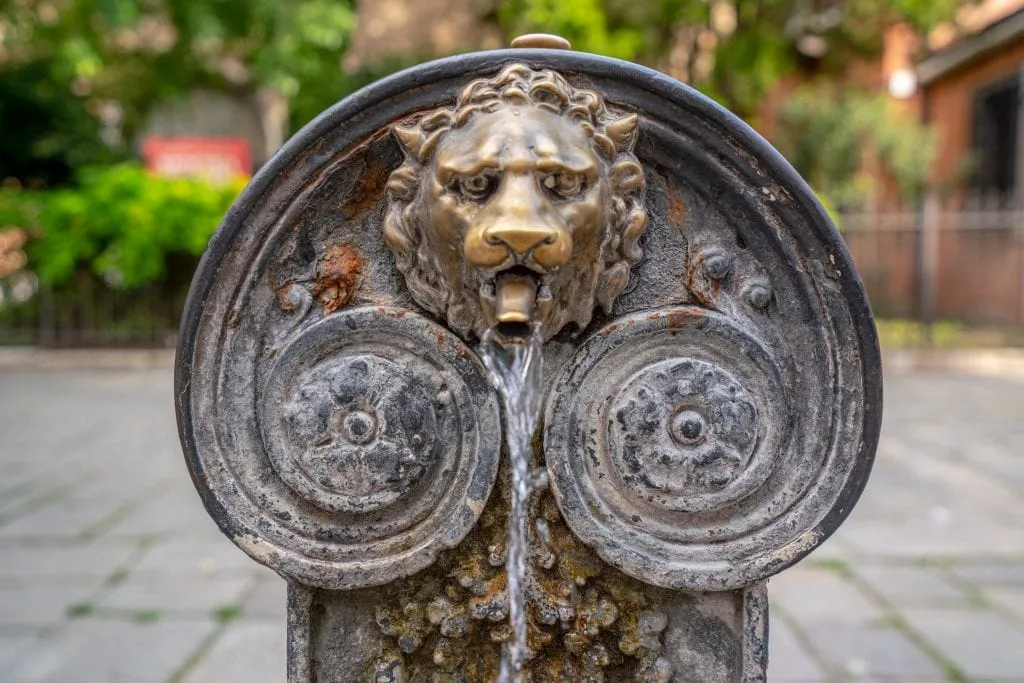
Fall is the best season to visit Italy.
Unlike many of these travel tips for Italy, this one isn’t objective truth but only our opinion!
Fall brings cooler weather (though still decently warm in most parts of Italy in September and October), the harvest, lessened crowds, lower prices, and plenty of crisp, sunny days.
There is nowhere on this planet I would rather spend the month of October than central Italy.
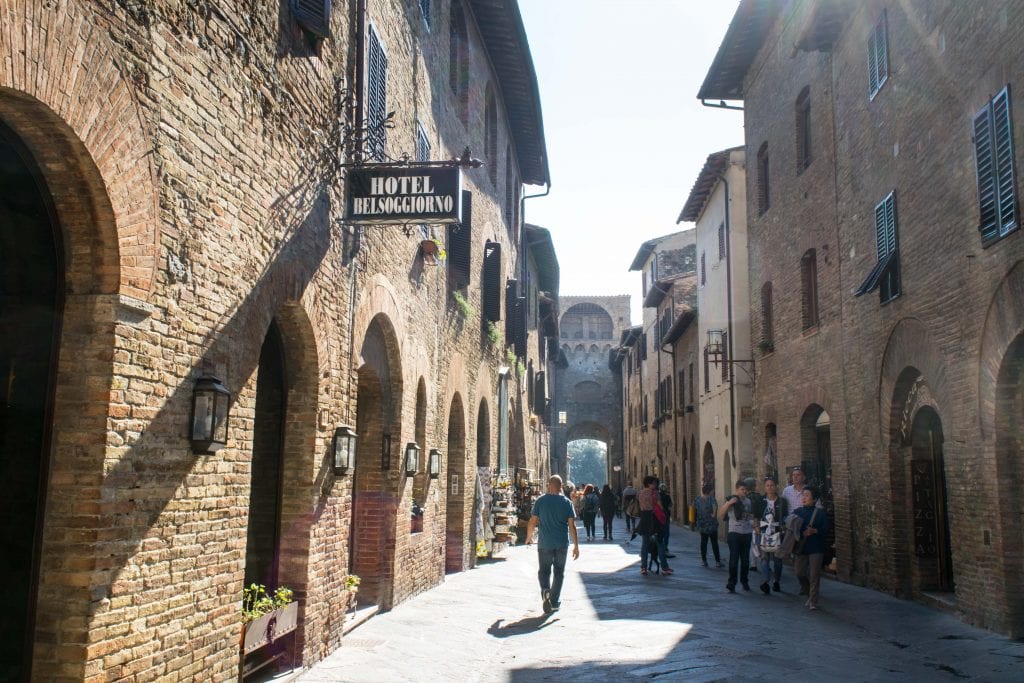
Winter also has its perks!
One of our favorite travel tips for Italy is to consider traveling in the offseason–it is both peaceful and lovely!
If you’re visiting Italy on a budget and want to see the country’s classic attractions for cheap, winter has a lot to offer.
We are often downright shocked at how empty the cities are in winter, and they’re still lovely to visit.

… But don’t expect great Christmas markets.
Those are more of a Central Europe thing.
The closest you’ll get to “real” Christmas markets like what you’ll find in Austria or Germany is in Bolzano , which is home to the oldest Christmas market in Italy , and the smaller South Tyrolian towns that surround it.
… No big surprise, since the area was Austrian until 1918!
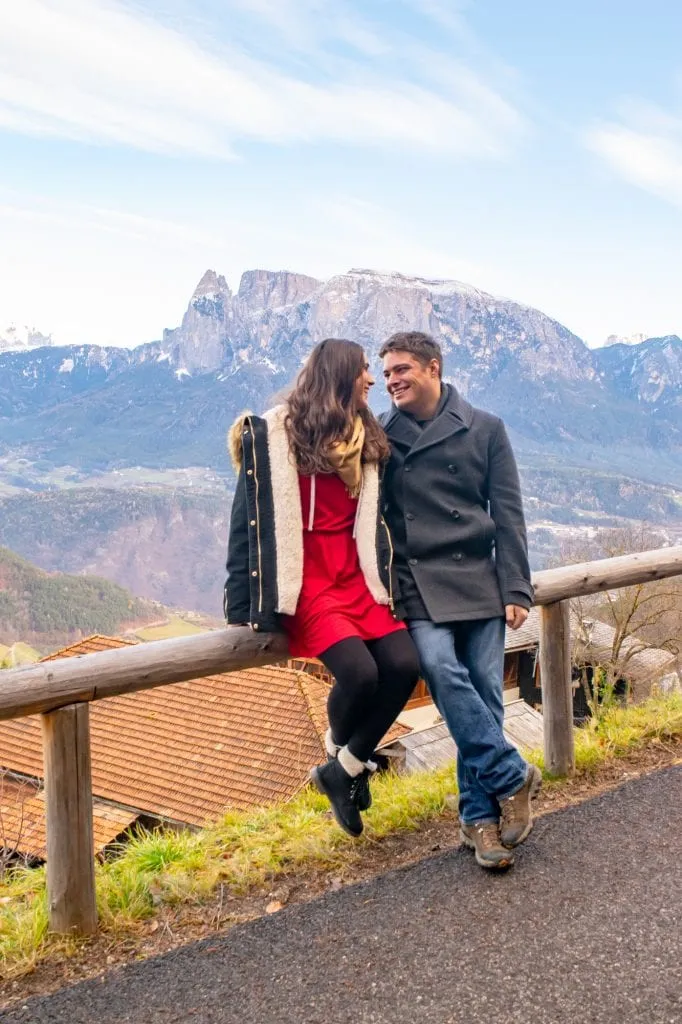
Be prepared to carry your luggage for decent distances.
This is especially prevalent in city centers, where transportation may not be able to deliver you all the way to your door.
If carrying your luggage sounds terrible, you might be able to hire a porter!
They’re especially common in places like Venice and Cinque Terre , and many hotels offer the service.
If you try to politely stand back in a line/queue, your turn may never come.
… And this becomes more and more prevalent the further south you travel in Italy.
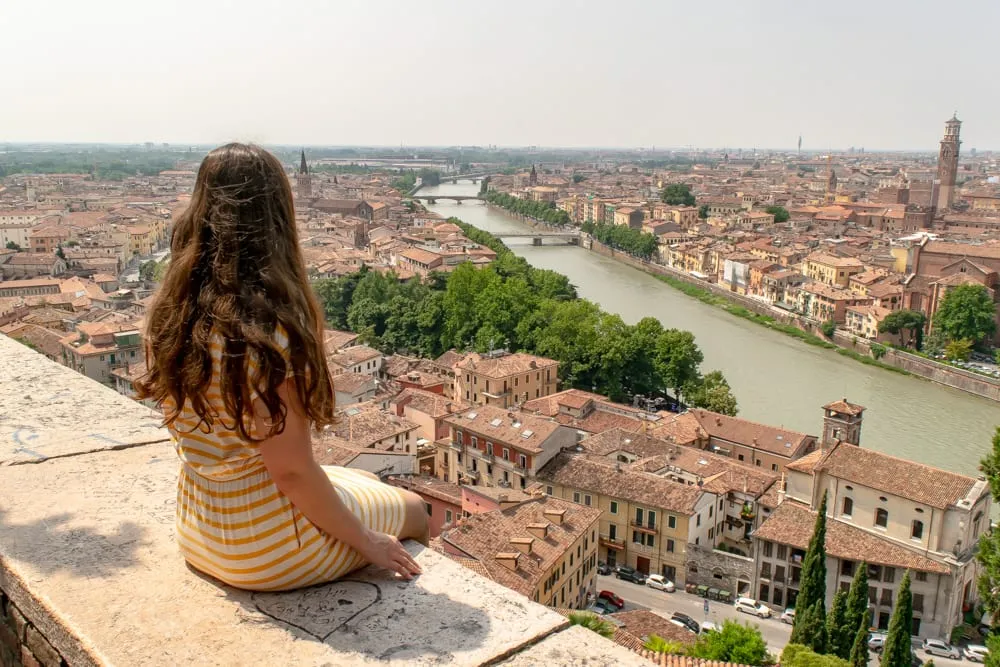
English is the international language of tourism, and that includes Italy.
… So don’t worry about being fluent, especially in large cities and particularly touristy areas (like hotels and big tourist attractions).
However, everyone in Italy does not speak English.
You should absolutely learn at least a few basic Italian phrases before coming to Italy!
Here are a few to keep in mind.
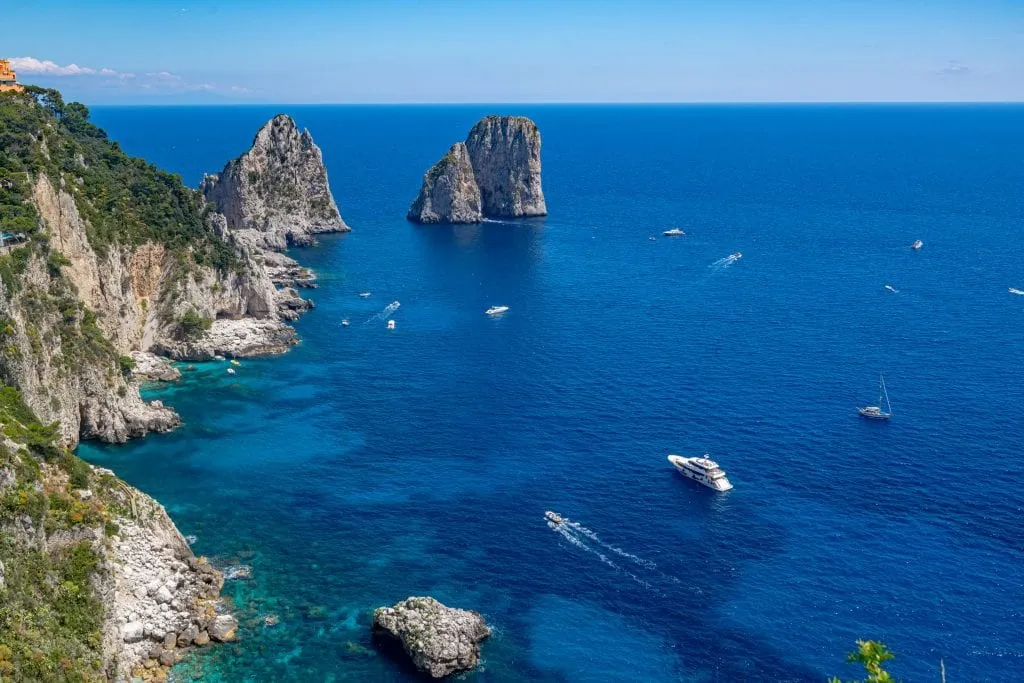
Basic Italian Phrases
Buongiorno . — Good morning.
Buona sera . — Good evening.
Ciao . — Hello/goodbye. (More casual than above.)
Per favore . — Please. (When requesting or accepting something.)
Grazie . — Thank you.
Prego . — You’re welcome, or please. (When offering something–as in, “Please, have a seat.”)
Non capisco . — I don’t understand.
Parla inglese? — Do you speak English?
Il conto . — The check. (In a restaurant.)
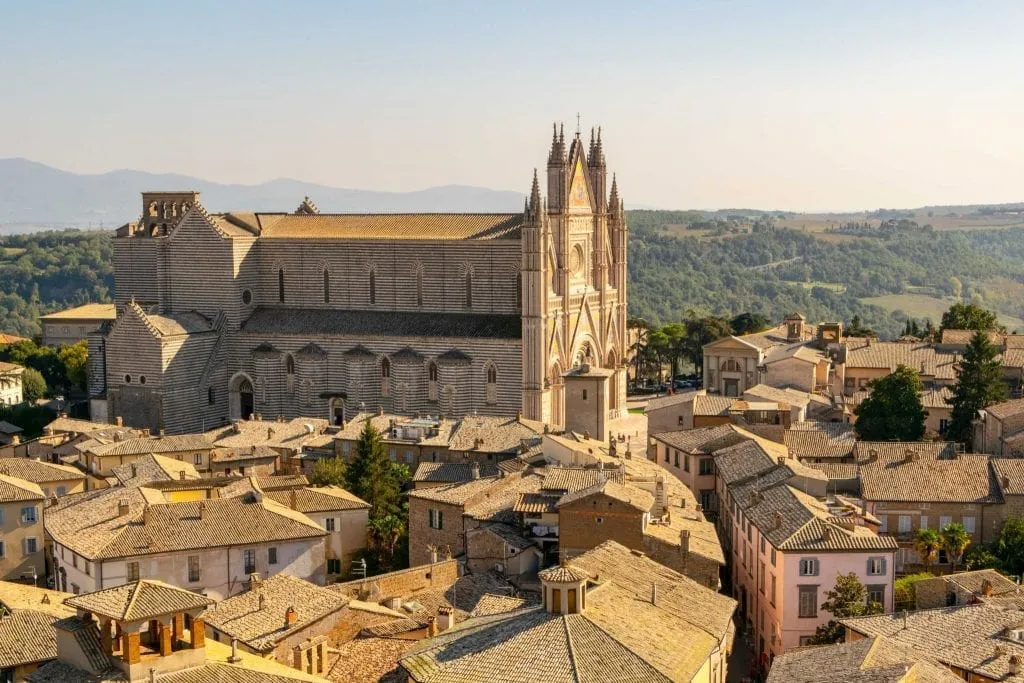
Sign no petitions.
I don’t care what they say it’s for, pay attention to this Italy travel tip: sign nothing. Smile and walk away.
Take no flowers.
This is a very common scam throughout Europe and seems to be particularly prevalent in Venice.
If someone hands you or your partner a flower, they will try to extort money from you for it.
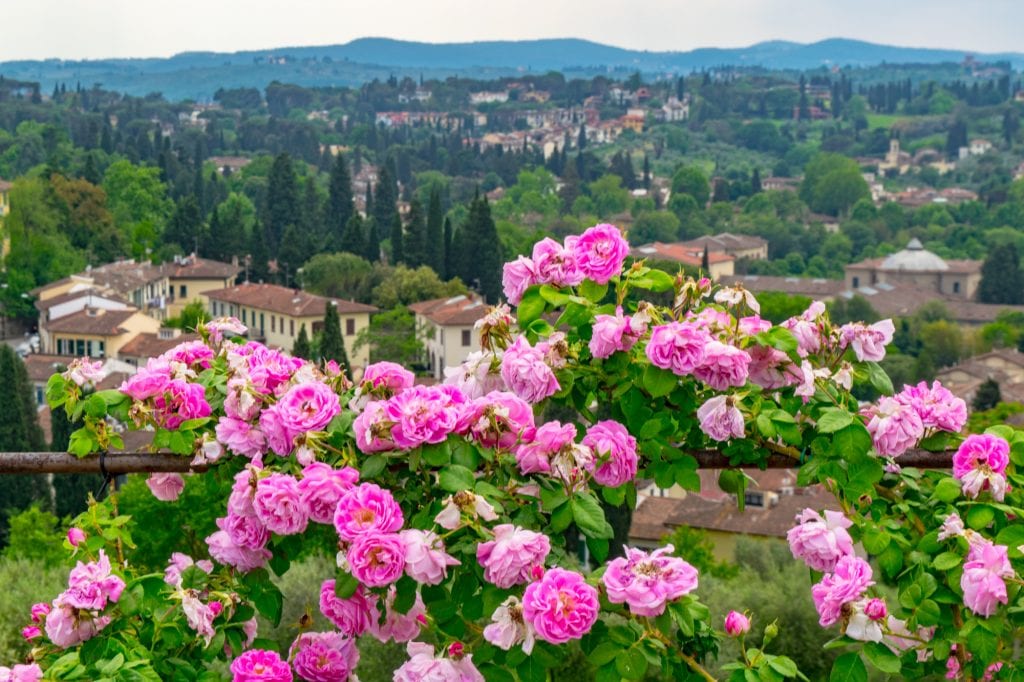
Don’t let anyone give you a friendship bracelet.
Yet another common scam in Italy–the friendship bracelet.
Someone will approach you to offer a “free” friendship bracelet.
As soon as it’s tied to your wrist, it’s not free anymore.
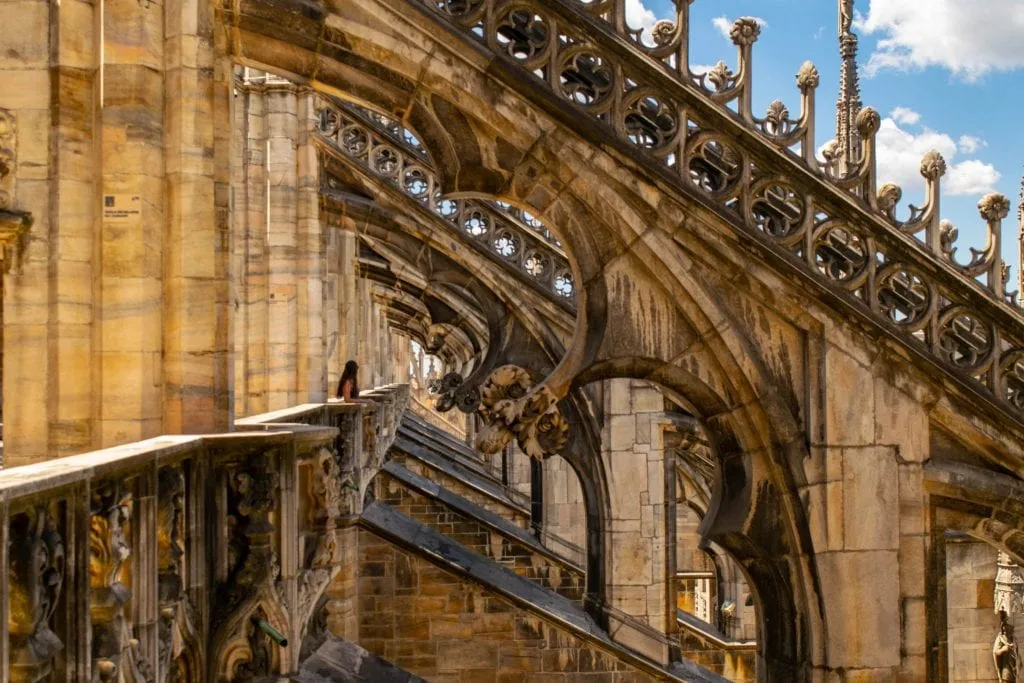
Keep an eye out for pickpockets.
This goes double in busy train stations, on crowded buses and trains, and in highly touristic areas like near the Colosseum, St. Mark’s Square , Duomo di Milano, etc.
Naples and the surrounding area, especially the Circumvesuviana train, are particularly packed with pickpockets (the Circumvesuviana is the only place we’ve ever knowingly seen someone get pickpocketed!).
If you’re particularly concerned or not used to watching your belongings in a crowded urban area, you might want to consider using an anti-theft backpack or a money belt for a little extra security.
Now, to be perfectly clear–all pickpockets know to check for money belts, and we no longer choose to use one ourselves.
That being said, they do offer a bit more protection than a normal pocket!
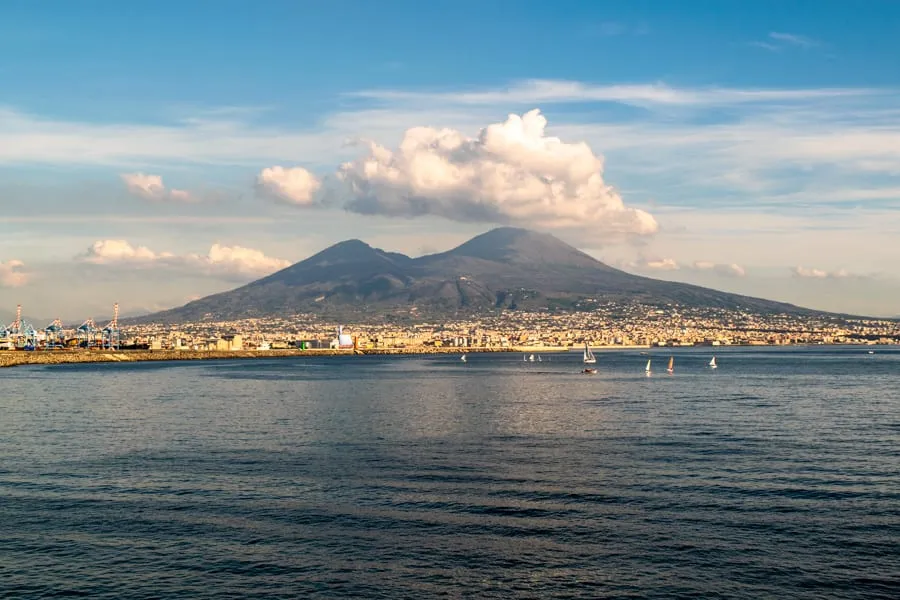
You’ll need European travel adapters for Italy.
We recommend purchasing travel adapters for Italy before you arrive, though you can find them on the ground in Italy as well.
Leave your hair tools at home.
The voltage, not just the plug, is different in Italy.
To use your hair tools, you’ll either need a converter (which is both heavier and more expensive than an adapter) or a dual-voltage device .
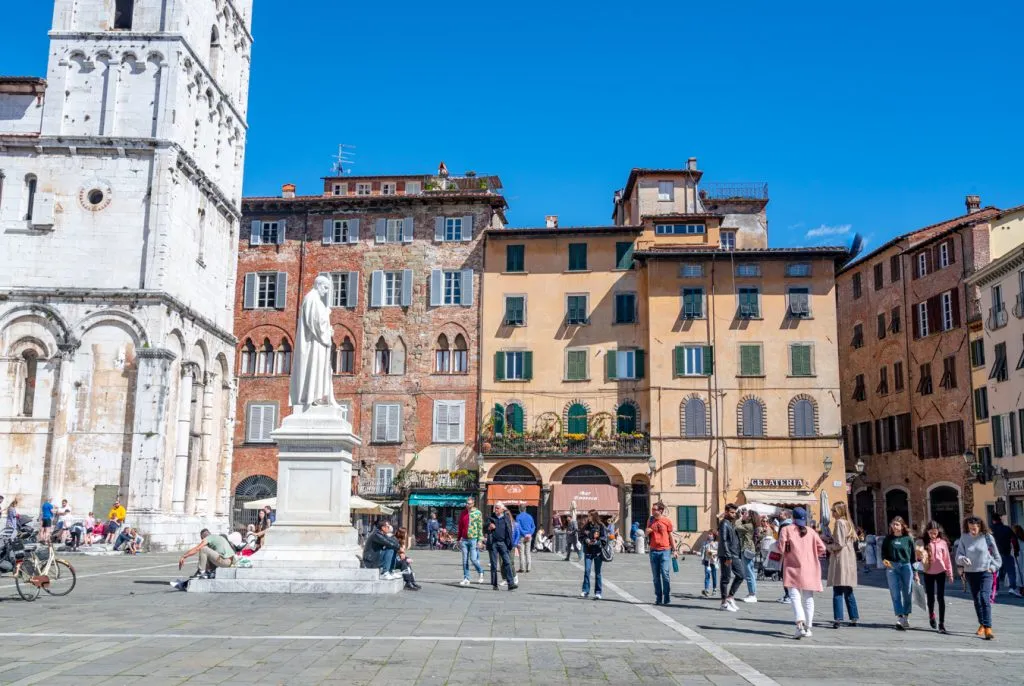
However, most hotel rooms will have a hairdryer.
So you won’t be left completely without styling tools if they’re important to you!
Bring at least one church-appropriate outfit.
That means no knees (men can usually get away with shorts that hit at the knee), no shoulders, and no cleavage.
Trust me–it’s not fun being turned away from a religious site!
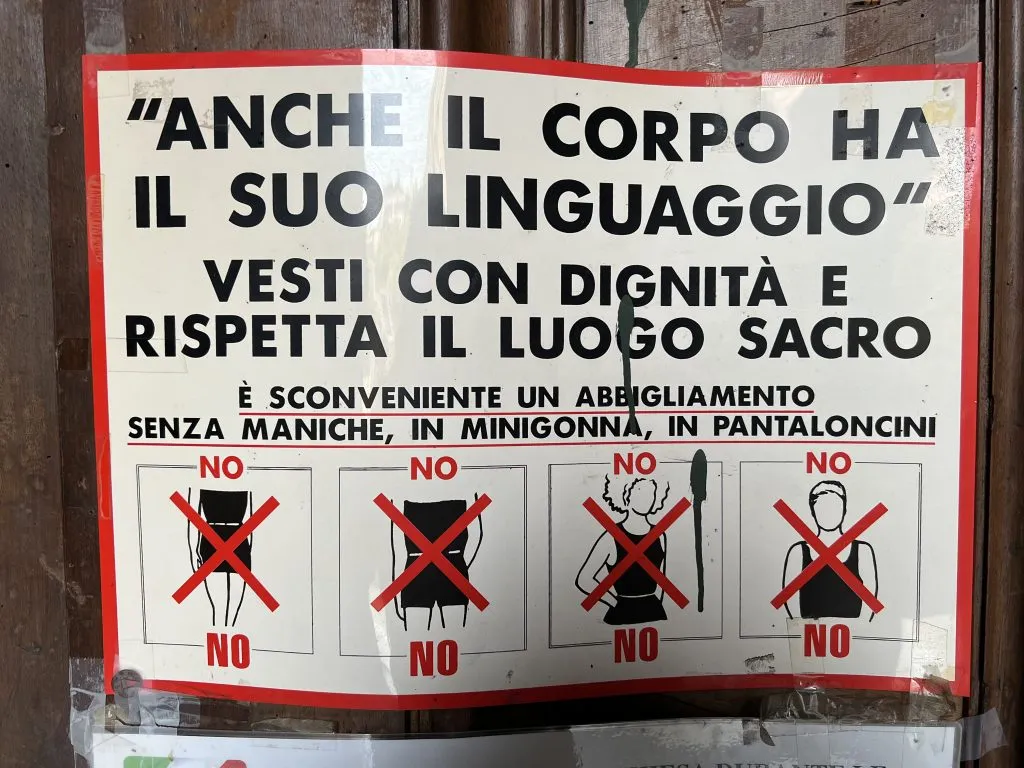
Bring (or buy!) a scarf.
Not only are scarves fashionable year-round in Italy for both men and women, but it’s also a cheap and easy way to make a church-ready outfit in a jiffy during the hot summer.
You won’t always be hot in the summer, though, so bring a jacket.
When Italians turn on the a/c, they really turn it on.
If you tend to get cold like me, definitely follow this Italy travel advice and bring a jacket–otherwise, you might be freezing in a train or museum.
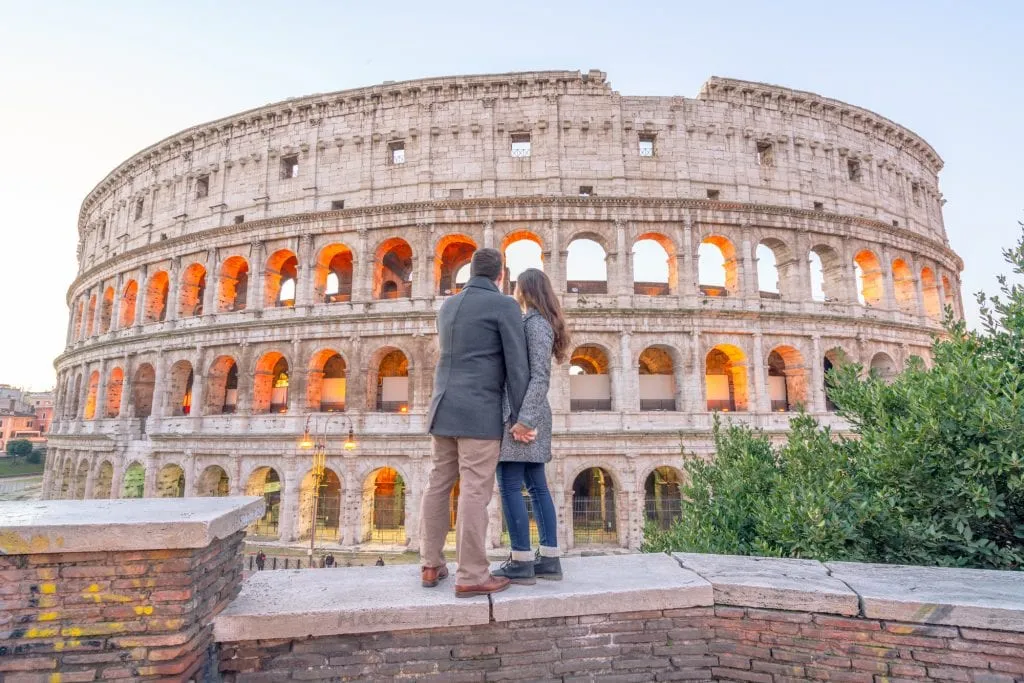
There are two countries inside Italy.
Everyone knows about Vatican City , but are you familiar with San Marino ?
Located in the eastern part of Italy between Emilia-Romagna and Marche, this tiny country styles itself as the oldest republic in the world!
It’s also incredibly beautiful, and definitely worth visiting.
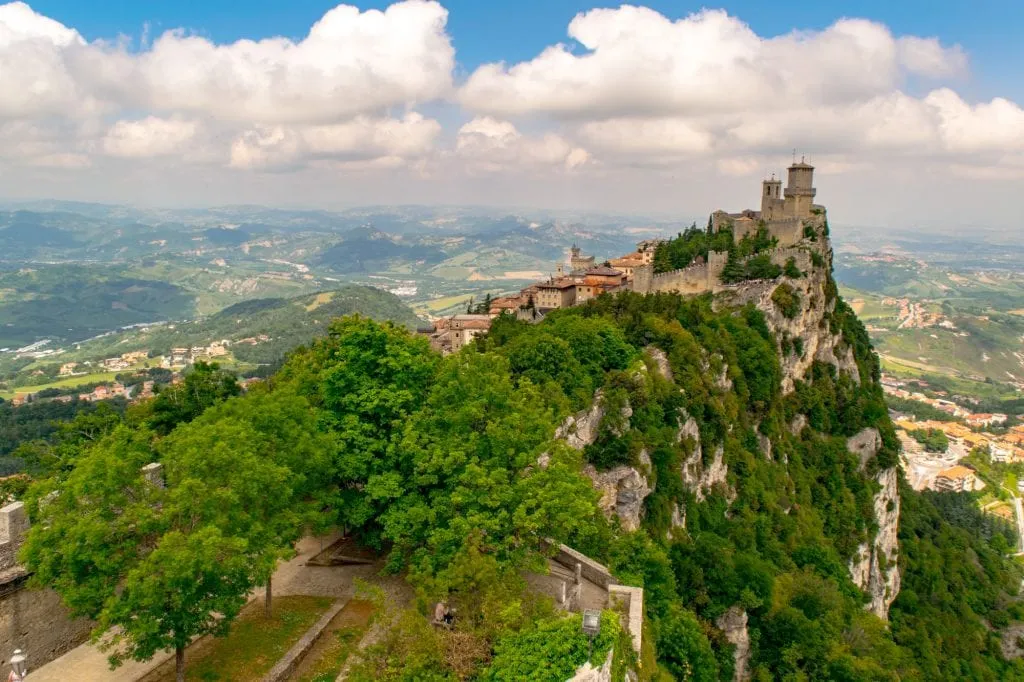
The emergency phone number in Italy is 112 (the equivalent of American 911).
Hopefully you’ll never need it, but it’s good to make a note of it just in case.
The northern, central, and southern portions of Italy are very distinct.
Everyone talks about the stark difference between the north and south when discussing travel tips for Italy, but central Italy has its own flavor as well!
In fact, if you’ve never been to Italy, central Italy will likely initially feel the most “Italian” to you based on the photos, videos, and stories we’re exposed to abroad.
Central Italy is where you’ll find Tuscany, Umbria, and Emilia-Romagna, which are home to rolling hills bathed in golden light, hilltop villages, and “classic” Italian foods like parmigiano-reggiano and tagliatelle al ragù (aka the real version of what non-Italians know as spaghetti bolognese).
Here’s our guide to the differences between northern, southern, and central Italy.
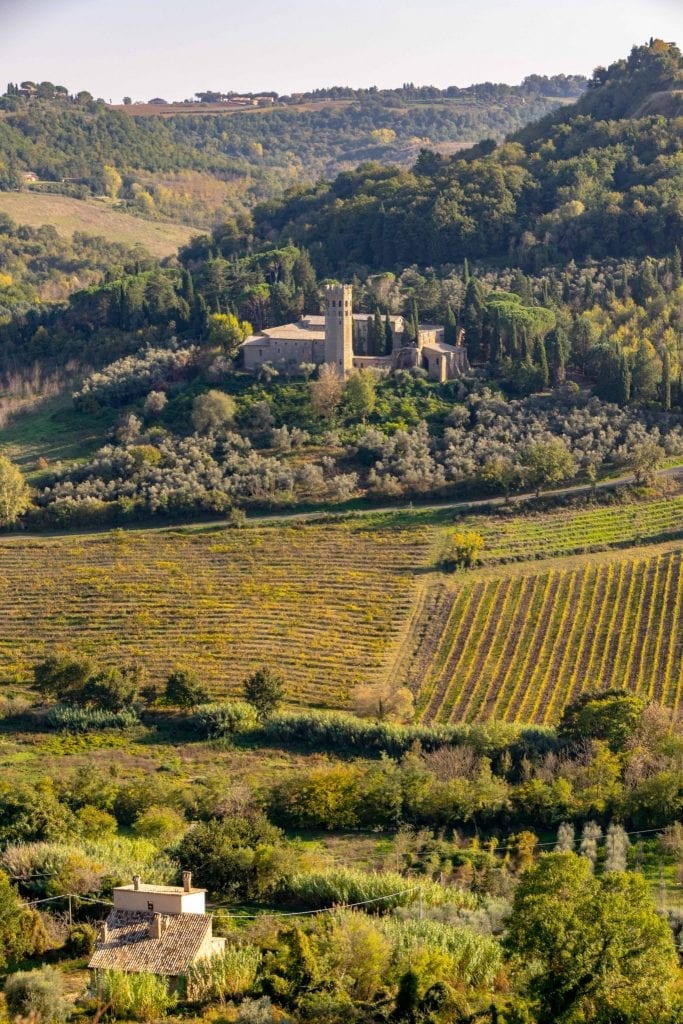
In fact, all 20 regions in Italy are distinct.
Italy was only unified in 1861 (and that date is a bit fluid), and the regional differences are still incredibly stark.
Italy didn’t gain its current borders until after WWI!
Vittorio Emanuele II was the first King of Italy.
This is why you’ll see his name just about everywhere!
Examples you might recognize are the Galleria Vittorio Emanuele II in Milan and the Vittorio Emanuele II Monument (aka Altare della Patria/Altar of the Fatherland) in Rome.
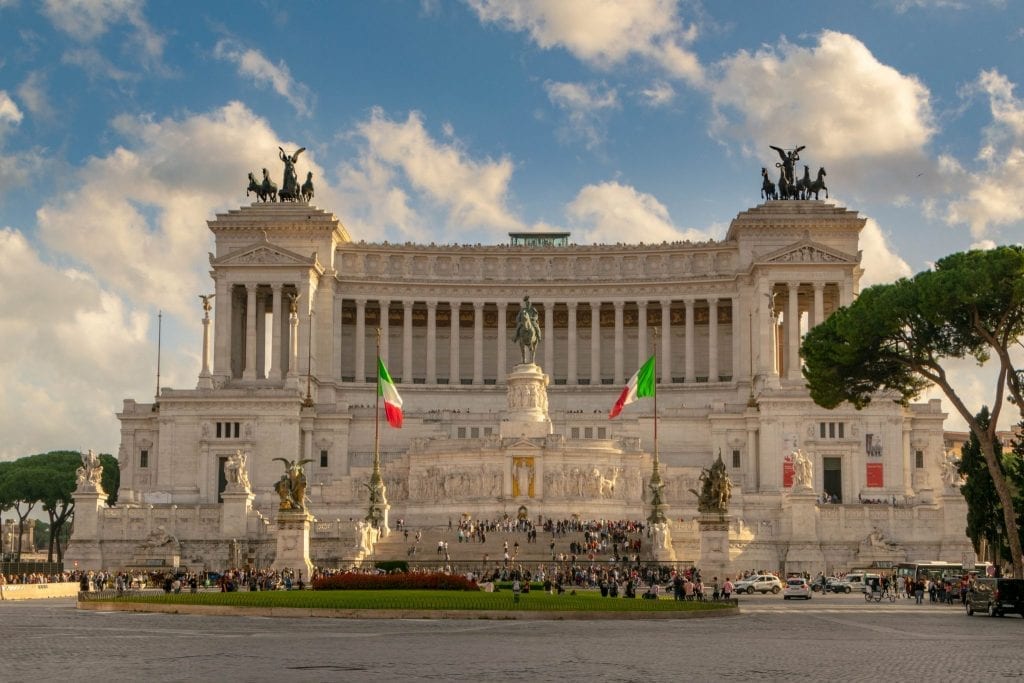
Dialects definitely still exist.
You won’t hear a lot of it as a tourist, especially without seeking it out, but Sicilian dialect, Napoli dialect, Roman dialect… all of these languages (and more!) still exist and are spoken in the small towns of Italy .
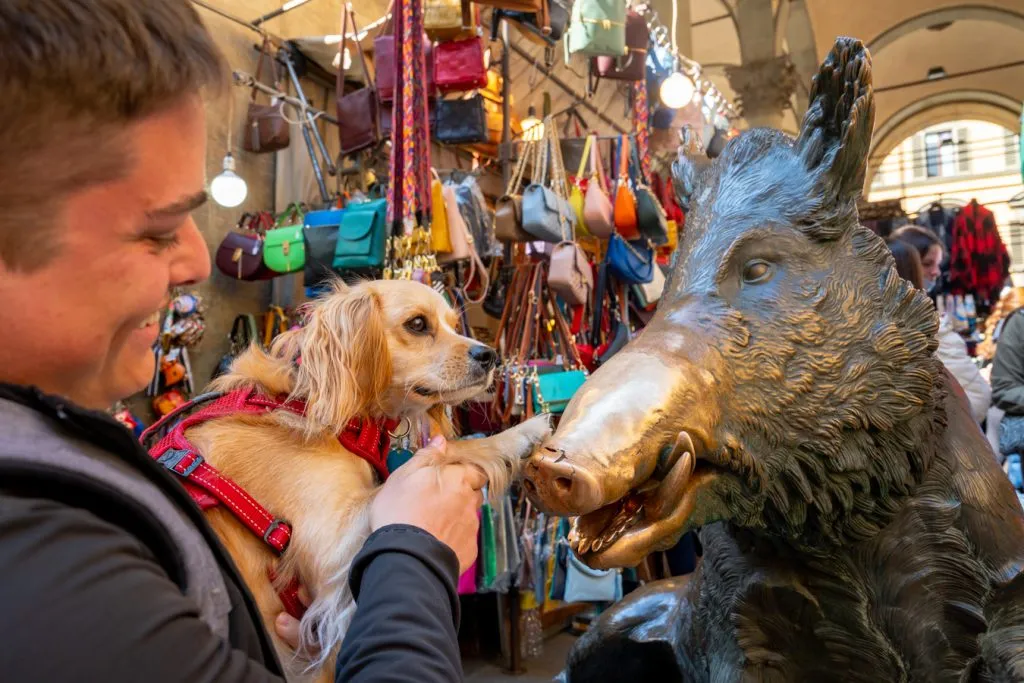
Italy has some of the best dog-watching around.
… Especially if you’re into tiny, fluffy dogs.
We’ll end this Italy travel tips post on a light note: if you’re a dog fan like us, be prepared for all kinds of cuteness in Italy!
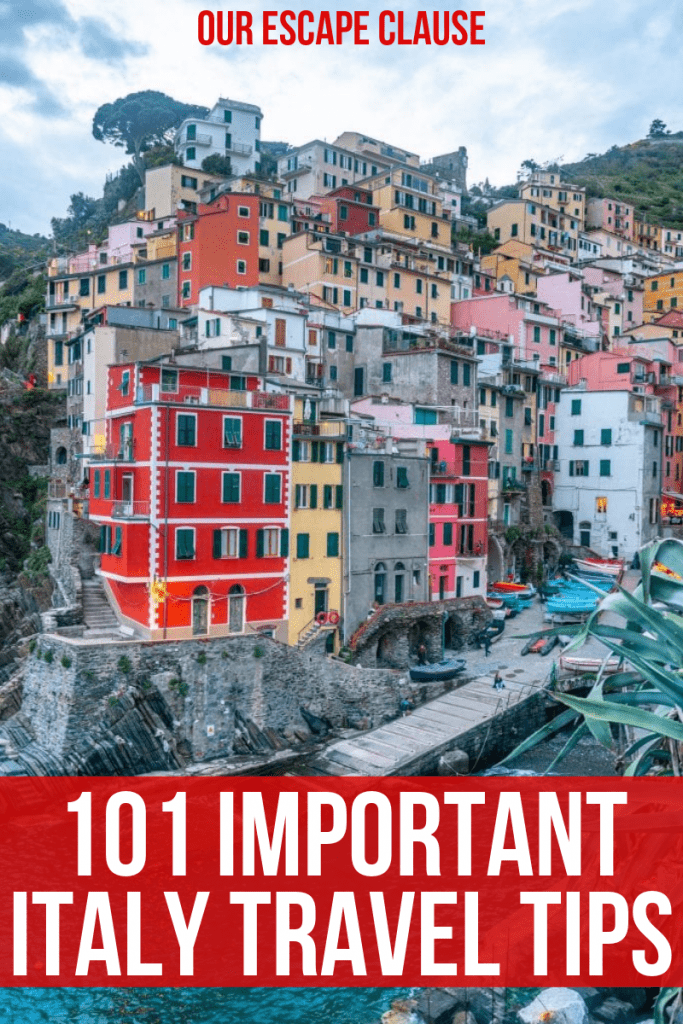
About Kate Storm

In May 2016, I left my suburban life in the USA and became a full-time traveler. Since then, I have visited 50+ countries on 5 continents and lived in Portugal, developing a special love of traveling in Europe (especially Italy) along the way. Today, along with my husband Jeremy and dog Ranger, I’m working toward my eventual goal of splitting my life between Europe and the USA.
60 thoughts on “101 Important Travel Tips for Italy”
Love this!! Leaving the end of September for our first trip to Italy. I have 2 questions… 1) if you’re there only 10 days is Pisa or San Marino worth a look? 2) we were trying to drive from Venice to the French Riviera to Barcelona but proving to be too difficult. Thoughts?
Hi Suzanne!
On your first question, not sure if you’re asking either/or or whether both are worth it… personally on a first Italy trip, I wouldn’t recommend either Pisa or San Marino unless you REALLY want to see them and happen to be close. Of the two, I vastly prefer San Marino! It’s absolutely worth seeing, but I wouldn’t go out of your way for it on your first trip.
That road trip does sound quite intense! If you’re not planning on seeing anything in particular in between Venice and the Riviera, I’d look at flights or trains to Nice instead. You’ll also likely incur some additional charges to cross borders in your rental car, and large fees for dropping it off in a different country (I’m assuming you’re not planning on driving back to Venice).
If it were my trip, I’d only rent a car in France, and use planes/trains/buses to get there from Venice and to reach Spain from southern France, but that’s not to say you’re wrong to drive (and I don’t know how long you have or what stops, if any, you plan to make in between). Road trips can be fun, but definitely add a layer of complexity in this situation.
Thanks for such an informative blog! We head to Florence, Cinque Terre, Nice and Aix-en-Provence at the end of September. I am jealous that you have been able to explore the world, though I’m sure it takes a lot of work! Inspires me to keep booking trips!
Thank you so much, Liz! That sounds like an absolutely sublime trip–hope you have an incredible time! :-)
Hi Kate, Thank you so much for all this information. I have been to Italy before and love it. I’m going with a couple of girlfriends that have not been before in October. We have only 8 days in Italy. Can’t wait. We are starting in Rome, then Florence and on to Venice. My Favorite is Venice! We are only in Florence 1 full day and have 2 tour options we would like to do, however maybe only have time for 1. The tour of Tuscany, includes Siena, San Gimignano and Pisa with a Wine and lunch or tour the Italian Rivera (which looks sooo awesome). I think we should do the Italian Rivera by train on our own though if we choose that one. Which would you suggest?
Both places are amazing, of course! I’d personally probably opt for the Siena/San Gimignano/Pisa/Wine option, just because you’ll be in Tuscany anyway and it’s a shame to go all the way there and not see the countryside. Plus, the Tuscan countryside is fantastic in October, while the Riviera is winding down and more or less in the offseason by then.
As for the Riviera independently, it depends on where exactly you want to go–Cinque Terre, for example, is a logistically complicated and LONG day trip from Florence by train. Not impossible, but not nearly as relaxing as sipping wine when overlooking a vineyard!
Ciao Kate! My name is Elena, I am italian (from Veneto, near Venice) and I found casually this guide on the internet. I found super interesting to read how a lot of this that are normal for me are actually strange for foreigners. I just want to tell you and your readers that all you’ve written is really true. The differences in our regions are truly important, so everyone who wants to discover Italy needs to visit all of them. My favourites are Venice, Rome, Siena, Trieste, Padova, Turin and Assisi! Have you been there? I hope to discover the USA one day!
Thanks so much, Elena! So glad this guide reads as accurate to Italian eyes. <3 We adore Rome (probably our favorite city on the planet!), Venice, and Siena, honestly didn't fall in love with Trieste (though we're willing to give it a second chance--Miramare Castle was amazing), and haven't been to the others... yet! Hoping to explore most of Italy eventually.
Hope you and your loved ones are holding up okay during these very strange times we are living in!
This is a wonderful resource! My husband and I are thinking about visiting the Lake Como area in July, assuming it is open for travelers. What are your thoughts on that area at that time of year? We haven’t booked anything yet – just investigating our options.
Hi Sandy! Unfortunately, Lake Como is one of the biggest travel oversights in Italy so we haven’t been ourselves yet (can’t wait to fix that!), but from what we hear from friends, it’ll be beautiful and crowded in a normal year. Definitely don’t expect a bargain, but the hikes and boat rides will be at their best!
Hi Kate! I am going to Italy and will be taking my teenage daughter. We will be all over – Milan, Venice, Florence, Rome. Do you know of any tourist friendly night clubs/dance halls that we could go to? I get all the day trips and great stuff to see, but what can we do at night?
Hi Lauren! No, that’s not our area of expertise, but I’m sure you’ll be able to find some (except possibly in Venice–it’s very, very quiet at night there). Hope you guys have a great time!
Kate what a great resource you are..Thanks for sharing your insight. We are planning a two week trips to Tuscany the first two weeks of ..September… . what would be appropriate attire and what type of shoes would you suggest?
Thanks so much, Beth!
September is a wonderful time to be in Tuscany, but it will probably still be quite warm. You’ll probably want comfortable sneakers/closed-toed shoes, but probably not boots. Maybe a light jacket for the evenings, but even that is a maybe.
Definitely check the weather as your trip gets closer, though, you never know what will happen!
Kate thanks for the quick response….I appreciate your advice….starting to get excited… we are staying at a villa in Cortona with 3 other couples and we are starting to plan day trip… any suggestions on what not to miss would be awesome ! Thanks Beth
Oh goodness, so many options! You guys will have a wonderful time.
I’d look at Montepulciano, Pienza, Perugia, and Assisi for possible day trips, but that’s just scratching the surface!
Thank you so much for the many tips on Italy, I particularly enjoyed the coffee guide. My wife and I will be there for the first time for 10 days in August, focusing on the big three of Rome, Venice, and Florence. We have most of our travel and tours booked, but we don’t really have much planned for the evenings. Do you have any recommendations? Perhaps some “must dine” restaurants?
Thanks so much, Thad! I had lot of fun writing that coffee guide. :-)
If you have room in your schedule, you may consider swapping one of your big tours (Colosseum, Vatican, etc) for a night tour if you haven’t already, as August is such a hot and crowded month. It’s a fun way to break up a day–we just did a Colosseum night tour last month and I reviewed it here: https://www.ourescapeclause.com/colosseum-at-night-tour/
We also love doing food tours at night! Take Walks has some incredible ones, we especially enjoyed their Florence tour.
Other than that, we do have night guides to all 3 of those cities with some more ideas on what to do with your evenings! Here’s our Rome guide: https://www.ourescapeclause.com/what-to-do-in-rome-at-night/
Hope you guys have a fantastic trip! We count each of those cities among our absolute favorites, you’re going to have a blast. :-)
My main question is how to stay in Italy, I have heard so many differnt ways, I will be moving like crazy too try and see it all. I will be there 22 days and was wondering should I do hotels, B&B, or Airbnb? any advise on this.
also I download the Italy version of uber, but any other apps I should get? for trains, tours etc…
First step: take a deep breath and don’t try to see it all! I know, it’s cliche, but seriously–your trip will be better for it.
A mix of hotels, bed and breakfasts, and apartments/Airbnbs is completely fine, we use them all. No one option is best, they all have pros and cons. Whatever looks like the best option in any destination is what we go with.
We don’t use a lot of apps beyond FreeNow when traveling in Italy ourselves, but you may look at Trenitalia for checking train schedules, etc. The app is a bit wonky with non-Italian cards, and you can’t save your information without an Italian tax number, though, so you can’t access all the features.
Hope you have an incredible trip!
Thank you for all the helpful info! I am going with my mother in two weeks and we will be renting a car and going all around the country. I have traveled to multiple countries, but I’m very concerned about the pick pocket scenario in the larger cities of Italy. For someone who is naturally very aware of her surroundings, what sort of bag would you recommend? I am not comfortable with the backpack as I cannot see it, and I’m thinking more of a cross body and keeping my arm and hand over it. Also do I need to be worried about my smart watch being taken? Would you recommend wearing it or not? Any and all help with what bag to use is appreciated.
Hi Brittany,
Pacsafe (the brand that makes our backpack) also has some cross-body bags. Some of my best friends use those and swear by them!
As far as your smartwatch, it’s up to you–it’s not zero-risk to keep it on, of course, but Jeremy does wear his watch in Italy.
Pickpocketing is definitely a concern, but outside a few very specific places (like the Circumvesuviana train in Naples), the risk is pretty similar to any other dense, highly touristed European city.
Regarding ATM’s. I have dollars to bring over is it easier to cash American curreny at a bank or just bring a debit card and withdraw euros? Will establishments accept American currency?
Bringing a debit card and withdrawing Euros directly is always our preferred method!
I imagine banks will change USD for you, but I’m not sure how competitive the exchange rate will be.
I’ve never heard of anywhere in Italy taking USD! You’ll definitely want to stock up on Euros. :-)
Very helpful I formation.Going to Toscany for a week on 20th September.. Regards Anna
Hi Kate I am a Native Italian, but lived in the USA and I would like to have the option to go back and forth, but do not know how to do so. I had forgotten many things and of course found that many cities have changed a lot. I agree with all you said, especially to be sure where to drive (I got a ticket in the States). Each cities is divided in weird zones and if you do not have the right car you can’t get in. I also have bought a portable router with 200GB so I can connect wherever I go. Turning light switches, keys, and opening doors is still challenging at times, which makes you feel dummy. In most coffee places (bars) nobody will show up unless you ask for to pay. My favorite cities are definitely Turin (no need for car), the first Italian capital, with tons of museums and beautiful buildings and walks. There is one Synagogue close to the main station. From there I loved to go to Lake Maggiore (Bellaggio, Isola Bella, Ticino). About 1 and half hour by train from Milan. It is much cheaper than Milan. They are famous for the Americana (Happy Hour), where for a max of $20 you get a full buffet. It takes more than 1 day to see it all. The Mole Antonelliana is now a Museum of Cinema (movies), the Museum of the Shroud is amazing. I one does not mind the very cold winter, they have impressive lights. Naples has a magnificent historic center, which contains an old Giudecca with Synagogue still active, close to both the Harbor and the shopping center. Capodimonte Museum and the view are magnificent. There are two levels to the city so there are several “funiculari” (trains that go up and down). Pizza is a must. The view of Vesuvius in amazing. There is always something going on so check ahead of time. Nearby Pozzuoli has underground caves, just like Turin with its underground. From Naples one could easily reach the Islands of Capri or Ischia or go to Sorrento and take the bus to visit the Amalfi Coast (scary thought to drive there, but more freedom to explore) and pause in Salerno to visit its historic center also very vivacious 24/7 with Mexican, Venezuelan, Chinese, Indian, Irish and so on food places all stuck together. Lots of little interesting artisan shops. The railroad is quite important and there are many buses so you can pretty much go everywhere. Make sure to maker reservations in advance, for Salerno is very popular and can be expensive all year long due to its temperate weather. In December they are famous for their street lights. I am from Milan, but lived also in the cities I mentioned, which is why I gave those tips, but would like to know from you if Trani residents (and Bari) seem to be open minded. Also, since I am hoping to find other expats, what do you think about some main coastal Cities on the Adriatic? Bari, Ancona, Pescara, Pesaro? I was in Trieste but don’t remember much. Have you been in Croatia or Albania? Thank you
We very much want to go to Turin/Torino soon! We actually had planned to visit for a few days this fall, but ended up spending our time in the Langhe region instead (which was also amazing, of course).
Naples is a delight, we’ve visited twice and plan to visit many more times. :-) Unfortunately, we did not luck out with the weather when visiting Sorrento/Capri/the Amalfi Coast, so we owe those several more visits as well!
We’ve spent a lot of time in Croatia and love it! Haven’t made it to Albania yet, but hopefully one of these days. :-)
Thank you for all of the incredible information! I have been given the opportunity to sing at the Vatican next summer! I of course have to raise the funds first, but your blog helped me in so many ways to plan! I do have a question. I know that I will want to bring wine back. Any suggestions? I live in FL. Thank you so very much! Grazie!
Congratulations, that sounds incredible!
If you’re only talking about a couple of bottles or so, you can bring those back yourself in your checked luggage.
If you’re thinking more bottles, consider shipping! It’s a bit of a splurge–think in the neighborhood of 75-100 Euros for a case of 6 bottles–but most wineries and enotecas are more than happy to do so, and it makes for a great memory.
Hi Kate, amazing blog ,my wife is doing an art course with Art Toscano near Barga in Lucca on May & we would like to spend some time on the coast adjacent to Florence… I’ve looked around LaSpezia & Livorno , any other interesting coastal areas we could visit on a budget. We’ll be in Italy for 3months, travelling from Australia
Are you looking for day trips? If so, you may look into places like Portovenere and Camogli. Cinque Terre won’t be at its peak crowds and prices yet, but it’ll definitely be more expensive than other options.
If you’re looking for a longer coastal getaway, 3-4 days or more, though, you can even look beyond the closest spots. The Adriatic Coast has some incredible spots that can be bargains by comparison, including Sirolo in Le Marche. You could also consider taking the ferry out to Elba to experience Tuscany’s most famous island!
We’re very partial to Puglia for affordable Italian beach towns, but unless you have several days to work with it likely won’t be worth the train ride.
Hello Kate, thank you so much for these useful tips. I will be staying in Rome from May to July and this will be my first time in Europe. I hope to travel to other cities in Italy and other European countries and was wondering for what advice you may have for travel during this time within Italy and outside. I hope to go to Florence, Cinque Terre, and Venice. I also hope to visit Paris, Switzerland, and London. Do you have recommendations on how to travel to these places from Rome? Thank you!
How exciting! You’re going to have a wonderful summer.
Florence, Cinque Terre, and Venice are easy enough to do by train, which is what we’d recommend.
Paris and London you’ll definitely want to fly to!
As for Switzerland, it depends on where in Switzerland you’re going and at what time. If you’re combining a trip to Switzerland with Milan or Venice, for example, train works. Otherwise, it may make sense to fly.
Traveling by train is definitely our preference in Europe whenever it makes sense to do so! We have a whole guide with tips to do so here: https://www.ourescapeclause.com/travel-europe-by-train/
Hi Kate and thank you so much for sharing such wonderful tips! We are going to Italy for about 10 days in July ’23 and planned to split our time between Florence and Rome but also thought we may hit a beach (maybe near Rome?) . Wondered what you thought about this and any suggestions you have would be very much welcomed. Thanks!
You are so welcome, glad we can be helpful!
I’m not sure if you’re looking for a day trip or to spend a couple of nights at a beach, but either way, you have options. :-)
The closest/easiest beach to Rome is generally considered Ostia. If you go, the ruins of Ostia Antica are well worth a visit as well. Ostia is more of a “local” beach but visitors do go there!
Sperlonga is a bit further from Rome and often considered one of the prettiest beach towns near the capital.
Near Florence, Viareggio (more local, but lots of beaches) and Forte dei Marmi are options, and of course, Cinque Terre isn’t too far (here’s our advice if you’re considering a day trip there: https://www.ourescapeclause.com/florence-to-cinque-terre/ ).
One quirk of Italian beach towns (especially in July!) is that the lidos, or beach clubs, often take up much of the beach and you have to pay to access them. You can typically find free swimming areas everywhere if that’s what you’re looking for, but depending on the place, it may mean throwing a towel down on some rocks!
The lidos are a fun experience, but it’s just something to be aware of since Italy is different than the US in that way. :-)
Thank you so much!
My pleasure! :-)
Hi Kate: this is my first trip to Italy and also first-time written questions about a trip online. We are traveling last week of march, and I am reading the south cities are best to visit in March? We are a group of 9, including kids and adults. What are you recommending for March month?
In March, you’ll want to be prepared for cold, gray weather in many cities. You’ll probably see some early signs of spring, especially in Rome and further south, but think of it more like a winter trip than a spring one!
With that caveat, though, any of Italy’s major cities are wonderful to visit in March, and while you’ll likely find yourselves wearing coats, you’ll also benefit from lower prices and decreased crowds than you would visiting in more popular months.
I wouldn’t have any qualms about visiting Florence, Venice, Milan, etc, during March!
Hi Kate, Thank you so much for taking the time to share beautiful insights of your love & passion for Italy. We (myself, my husband & 10 year old daughter) are Aussies & will be travelling over for a wedding in August 2023. We fly into Rome on the 17/8 & are heading to Genzano Di Luciano (close to Napoli) for the wedding on the 21/8 & will stay there until around the 25/8. We fly out from Milan rather than Rome on the 18/9 to go to Singapore for a week before returning to Australia. If you were us, What would be your rough itinerary of must see places & for how long would you stop at each for the timeframe we have? We prefer not to hire a car & use trains where possible. We had come up with a bucket list, but after reading your blog we realise that we have picked all of the tourist hotspots, still great to see, but perhaps not the best to stay at or stay long so we’re a bit lost & back to square one. Also, do you have any accommodation recommendations? Did you notice if the accommodation was cheaper to book once in Italy rather than from home in the US? Thank you so much again for all of the info you have shared already – it’s a huge help.
With that much time to work with (I’m counting about 3.5 weeks after the wedding, not including the time before that I assume you plan to spend seeing Rome?), the sky really is the limit with where you want to go–there are endless options!
For places beyond the usual top-10 destinations, a couple of our favorites that you might want to look into include:
Emilia-Romagna: an incredible food scene, wonderful architecture, and a beautiful landscape. You can also take a side trip to San Marino, one of Europe’s microstates! Here’s a guide to it: https://www.ourescapeclause.com/7-day-itinerary-emilia-romagna-italy/
Piedmont: a wonderfully refined food scene well off the usual beaten path. Home to the Langhe-Roero and Monferrato wine regions, which are absolutely stunning and a UNESCO World Heritage Site. Turin, the region’s capital city, is also overlooked but worth a peak.
Puglia: rising in popularity but a MUCH more laid-back Italian coastal experience than hotspots like the Amalfi Coast! Absolutely beautiful with unique architecture (trulli in particular), incredibly fresh food, and lots of whitewashed towns to explore in between beach days. Here’s one of our guides: https://www.ourescapeclause.com/puglia-road-trip-itinerary/
That is not remotely exhaustive, but hopefully it gives you a couple of ideas! Other places you might consider include but aren’t limited to the Dolomites (we like the Bolzano area), lesser-visited but easily accessed cities like Padua or Perugia, or hopping over to Sicily or Sardinia.
We’ve never noticed any price benefit to booking lodging in Italy versus the US, but I can’t say I’ve been on the lookout for it, either. I’d definitely recommend booking, at a minimum, all of your lodging in August (especially anything in the mountains or at the beach) well in advance. September will be a bit more relaxed, but still quite busy!
I lived in Italy for a couple of years (Veneto) and now send students there for study abroad. I’ve been working on a short workshop with travel and cultural tips for them. Your list covers pretty much everything I had in mind, and then some! Some things I had forgotten, like wearing a glove for produce at the supermarket. Great post, thanks for sharing!
Thanks so much, Kim! Hope your students have a blast in Italy! :-)
Hello! Thank you so much for this very helpful information. We are taking our first trip to Italy in September 2024 and now have a 5 day reservation and an AirBnB for five nights in Testaverde Roma. Our plan is to then rent a car to drive to Tuscany for another rental in the countryside for 4 nights, drop our luggage and spend some time in Florence plus drinking up the area of Tuscany, then driving to Venice to drop off our car OR take a train to Florence, rent the car and at the end of four day stay, drop it off and take a train to Venice. Then a train to Paris for a few days and then to London by train. England is also a first. After doing our thing in London, we want to rent a car and visit all the charming areas in the countryside, staying at a couple of different rentals and then back to London and car drop off. We’d fly into Rome and out of London or? I’d love your thoughts. Thanks!
Your second plan with the car is likely going to be much easier! There’s no need to drive between Rome and Florence or Florence and Venice unless you’re planning to sightsee along the way, and by picking up and dropping off the car in the same place you’ll avoid the (often pricey) one-way drop off fee.
Flying into Rome and out of London can definitely work, no reason not to do that as long as the prices work out.
If for some reason it’s dramatically more expensive than a round-trip ticket and you’re not on a tight timetable, you could also check the prices for flying from London back to Rome to go home. Thanks to the many budget airlines, hopping between cities in Europe by plane can often be extremely affordable.
Have a wonderful trip!
Ciao, sono italiano e vivo in Italia da sempre. Sono stato negli USA tantissime volte e c’è una cosa che mi ha sempre colpito degli americani quando parlano dell’Italia e dei viaggi da fare in questo splendido Paese: sembra che per gli americani esista solo la Toscana o poco più. Vi posso invece assicurare che la Toscana è solo una parte (bella, per carità) dell’Italia e a parte Firenze, nel resto d’Italia c’è sicuramente di meglio della campagna toscana. Trovo assurdo ad esempio perdere delle giornate intere nella campagna Toscana e non prendere in considerazioni luoghi e città come Napoli (la città più “italiana” di tutte), Lecce, la Puglia, la Costiera Amalfitana e, soprattutto, la Sicilia! Non so se questo derivi dalla pubblicità delle agenzie di viaggio, ma da vero italiano trovo assurdo leggere che, ad esempio, si parta dagli USA per visitare Milano e non Napoli, Palermo, Taormina, la meravigliosa Capri ecc.
My Italian is sadly not good enough to type out a long response in your language (maybe one day), but thanks for sharing your thoughts! You’ll notice that all of the destinations you’ve listed are mentioned or highlighted somewhere on our website–we’ve been to them all and many more! :-)
The reality is that most Americans are dealing with very limited time when visiting Italy–a 2 week trip is even on the generous side–so first-time visitors tend to prioritize the places that they are most familiar with and have been dreaming of for years. The Amalfi Coast is definitely one of those places, though!
Those who are lucky enough to return to Italy more than once tend to start branching out more, and we’re thrilled to sometimes be a small part of helping them do so.
Ti ringrazio per i complimenti all’Italia, ma ti posso assicurare che qualsiasi italiano resta meravigliato del fatto che una persona possa venire dalla lontana America e vedere solo la Toscana, senza ad esempio andare anche a Roma che è distante al massimo un’ora e mezza. Io credo che un viaggiatore dovrebbe seguire questo ordine di importanza (e bellezza): 1) Roma; 2) Venezia; 3) Firenze; 4) Costiera Amalfitana e Napoli (sono vicinissime); 5)Sicilia; 6) Sardegna; 7) Lecce e il mare del Salento; 8) un luogo a scelta tra la campagna Toscana, quella dell’Umbria e il fantastico insieme di paesi e montagne di una regione sconosciuta a tutti che si chiama Abruzzo, con città veramente deliziose come L’Aquila, Sulmona e Chieti. Un caro saluto.
We are so excited to be going to Italy the last week in April for a cruise. We are flying into Rome, and have a timeshare in selvatelle. What is the best way to get from the Rome airport to Selvatelle? And conversely when we leave we need to get from selvatelle to the cruise dock in chivitavecchia. We are nervous to drive. Thank you for pointers!
Hi Michelle,
Sounds like an exciting trip!
Selvatelle (and the Hilton Borgo alle Vigne, where I suspect you may be staying?) is quite rural! In your case, a car will make your life much, much easier–I would argue it’s even a requirement to get the most out of your trip, given where you’re staying.
Selvatelle doesn’t have a train station, and while there are buses, they can be a bit of a pain to navigate depending on where you’re trying to go. If you were staying in a place like Rome, Florence, or even Lucca, I would be giving the opposite advice, but in your case, you’ll see much more of Tuscany with a car.
The good news is that driving in Tuscany is very doable. We have quite a few tips on what to expect toward the end of this post: https://www.ourescapeclause.com/tuscany-road-trip-itinerary/
You can definitely take a train from Rome to Florence and then pick up a car there to cut down on driving time. Same with the way home–if you return the car in Florence, you can take a train to Civitavecchia in order to catch your boat (you’ll need to make a change in Rome).
I have a note of caution about using Omnio to book group train tickets. In my case, we booked 5 tickets and then one of our group wanted to take a train that left the next day. I thought, no problem, we will just change that one ticket. The Omnio policy is that we could not make that one individual change without canceling all five tickets, paying a fee, and starting all over again with booking. I find this ridiculous since typically buying tickets to almost anything else – planes, concerts, even trains (on other websites) – are sold as a group but treated individually for changes. Not so with Omnio! Be aware.
I’m sorry to hear that, Paul! We’ve never run into that issue, but thanks for sharing your experience. I’ll ask them about it.
This is treasure trove of useful information. I do have a couple of questions about a trip I’m planning for April 2024. The plan is 4 days in Milan, 3 days in Parma, and 3 days in Venice. The first question is how many days is really necessary in Milan? I’ve read that 2 can be enough or 3 is enough. I want to do a day trip to Lake Como (found one that also includes Lugano, Switzerland). Would 3 days be enough to cover Milan? Also would a day trip from Milan to Florence be worth it or should I just wait until we return to Italy and make Florence part of a Florence, Rome, and Naples trip?
Second question is 3 days in Parma will include a day trip to Modena to visit a vinegar farm and see the sights of Modena (Ferrari Museum, etc). Is 2 days in Parma too much?
Finally, what are your absolute “must dos” in Venice? Is there a local restaurant that truly stands out? A coffee shop that we just can’t miss? A museum that is incredible but no one really knows about?
Thanks in Advance, Rick
Happy to help, Rick!
I don’t think there’s truly a right answer on 2 versus 3 days in Milan, it’s a matter of personal preference. For us, 2 days (one spent fully in Milan and one on a day trip to Lake Como) would be ideal in your situation, but you’ll find plenty of people who disagree with us! Our one day Milan itinerary is a good overview of what you can expect to see in a day there–it’s up to you whether that’s enough: https://www.ourescapeclause.com/one-day-in-milan-itinerary/
A day trip to Florence is definitely doable from Milan and could easily account for your third day. I suspect it’ll have the effect of making you even more excited for the next trip, LOL, but you can certainly see enough to make it worth it! Just be sure to book the fastest train routes in advance, as the distance can vary dramatically depending on the route.
I wouldn’t say 2 days in Parma is too much (one for the city, one for a parmigiano-reggiano and parma ham factory tour), but you could also spend that third day in Bologna and have a wonderful time.
As far as Venice, this post covers a lot of our must-dos: https://www.ourescapeclause.com/one-day-in-venice-in-a-day/ Bar Ducale is a traditional coffee shop we enjoy there. :-) But the most important part of visiting Venice in our opinion is meandering far enough from the crowds that you can be alone amongst the canals–which is surprisingly easy to do! We have a post on hidden gems as well that you might want to check out–we cover several lesser-visited museums in there.
I was born and I live in Milan, so I can try to answer your questions.
2 days in Milan can be enough to see main attractions.You can spend your first day visiting the city center and nearby district.You can see “Piazza del Duomo”, “Galleria Vittorio Emanuele” and “Piazza san Babila”, if you like museums, beside The Duomo there is “Museo del ‘900”. A tour on the rooftop of the Duomo, IMHO, is a must have if the day is clear.From Piazza del Duomo, walking for about 10 Minutes along “Via dei mercanti” and then “Via Dante”, you can reach “Castello Sforzesco” and “Parco Sempione”. Castello Sforzesco is a castle that was a residence of the Sforza family, the rulers of Milan, and Parco sempione is the garden behind the castle. You can also visit some museums inside the castle and there is an aquarium inside the garden (honestly not so big but the entrance is free). Not so far from the eastern part of the garden there is “Pinacoteca di brera” , another art museum.Not so far from the city center there is also “Museo Leonardo da Vinci” a science and technology museum but, IMHO, not worth it if compared to the same museum type that I saw and you have, in the U.S. When you reach 6/7 P.M. you have to move from the city center. Keep in mind that the nightlife in Milan is not at all in the center but spread around the city. In the center restaurants and shops close early in the evening and the only places that you can find open are the night clubs. Don’t forget that night clubs in Italy are not “dancing clubs”, we call it discoteca, but are strip clubs :). If you are not so tired you may have a nice walk to “navigli” via “colonne di san lorenzo” and then “Darsena”, Google maps will be your friend :) you can find these places. The Navigli are artificial water canals designed by Leonardo Da Vinci and there are many pubs on their sides. In these pubs you can have “Aperitivo”. Usually we have aperitivo before dinner, you pay for drinks and you have a buffet included. A Milanese cocktail is the “Negroni sbagliato” (literally wrong Negroni) but it is quite alcoholic, you can also have a Spritz or a glass of wine or whatever you want :). If you are satisfied with the buffet you can spend the rest of the night walking beside “navigli” and having a pub tour (remember that last call is at 2:00 A.M.), if you like to have dinner in a restaurant and you’re on a budget my advice is to avoid restaurants beside Navigli. Aperitivo will be cheap, dinner at a restaurant probably not. You can find cheap but amazing restaurants far away from the center or Navigli, I live in the south part of the city and usually I can have lunch for 10/15€ and dinner for 20/30€ per person (wine included). For your second day you can try to plan a visit to “Basilica di Sant’Ambrogio” and “Santa maria delle grazie”, 2 churches and also to a fairly unknown place: “la vigna di Leonardo” https://vignadileonardo.com/en . If you like modern arts you have to visit “Fondazione Prada” a gallery of modern art run by Prada fashion company.
A one day trip from Milan to Como’s lake is definitely doable, IMHO, including Lugano’s lake is too much, you risk spending a lot of your day traveling. Both are amazing places (honestly I was at Lugano’s lake just a couple of times, I know Como’s lake better). My advice is to choose one place or spend a night near Como and have your visit to Lugano the day after. Keep in mind that to reach Como or Lecco (the city on the eastern branch of the lake) from Milan by train is easy, the problem is to move from Como to another beautiful lake place, you have to consider renting a car. IMHO in one day you have to visit “Bellagio” a wonderful town in the middle of the two lake’s branches. You can walk along the lakeside, visit a castle, spend time on the beach and there is also a wonderful botanic garden. If you have a car you absolutely have lunch near “Piano Rancio” a small town in the mountain over Bellagio, there is a wonderful view of the Lake and an amazing Alpine refuge where you can have a typical launch: https://www.rifugiomartina.com/. They do not have an English version but under “contatti” you can find a google map route. Not sure about the English of the waiter :)I suggest you try “Pizzoccheri alla Valtellinese” , one of my favourite dishes. Last advice, if you plan to reach the lake by car, absolutely avoid Sunday. On spring Sundays, half the citizens of Milan go to Como’s Lake, the other half to the sea in Liguria. Traffic jams are a certainty ;) . If you have Car and enough remaininng time, both Como and Lecco are nice cities to visit and where to have Aperitivo or Dinner (cheaper than Milan). If you have a car make sure to have a designated sober driver :). Police blocks are not so common inside the cities but on roads that connect cities are.
2 days in Parma? Honestly I don’t know what to do :) I think that Modena is better. Is a small town but the center is amazing and almost all things to visit are in the center or near the center. You have to consider spending a day visiting Modena and the other day visiting “Ferrari Museum” (It’s big enough). Keep in mind that there are 2 Ferrari Museums, one in Modena and the other one in Maranello (A town near Modena). I suggest you visit the museum in Maranello, the hometown of Enzo Ferrari and the Ferrari company too. In Maranello you can visit the factory and track where they test the cars. (Remember reservation).If you are very passionate you can visit both ;). If you plan to move from Modena to Maranello by public transport check before, they are not as frequent as Milan and the towns around Milan.
Lastly, Venice is a wonderful city, you have to visit “San Marco” and “Murano” during the day. Avoid restaurants for lunch, try to find a small bar with the tables outside, they usually serve drinks and something like spanish tapas, very good and cheap. For dinner my advice is absolutely to go to “la Giudecca” (another Venice’s island) , which is the Island where almost all the locals live. You can find very good and cheap restaurants. You can also see how Venice’s people live.
Thanks for reading, enjoy your trip in Italy and sorry for my english ;).
Thank you so much for this information- it has been so helpful!
I have been to Central/South Italy before in the summer, but this fall, we will be in Italy for a few days as a part of a larger road trip during our honeymoon. We are planning to spend a few days in Turin, but it will be late October/early November (Oct. 29-Nov. 2). I am sure that fall weather in northern Italy will be so different than my summer experience, and I am so excited for it. I am wondering if you have any insight into what to pack and what weather to expect!
Most of my research has shown that the weather in October tends to be beautiful, like you mentioned, but November weather isn’t so great. We are from Texas, so we are definitely used to heat and I’m not sure what types of clothes will be best! Any thoughts you have would be much appreciated.
Hi Allison,
You’re right, the late October to early November time is when the weather often starts shifting into being colder and (much) wetter–add in that you’re going to be in Piedmont, and I’d definitely recommend planning to bring sweaters, tights, scarves, a peacoat, etc. The good news is that Turin isn’t as rainy of a city as some, so with a bit of luck you should stay mostly dry.
That being said, it’s all a gamble, and as always you’ll want to play it by ear. I wouldn’t expect to be wearing sundresses in Turin then, though! You may luck out with some sunny days, but the nights will be chilly.
Hope you guys have a fantastic time (Piedmont is phenomenal–the food and wine may just be among the best in Italy), and congratulations on your marriage!
Just found you folks and your site is great! I’m 73, returning to Italy for the first time in 50 years, SOLO! I’ll be based in Salerno from mid-Oct. to mid-Nov. and plan to take day trips into Palermo, Vesuvius, Amalfi, Paestum and maybe a shorter trip up to Campobasso to visit relatives! My biggest question now is: How far in advance should a reserve my tickets for a fast train (Rossa) to Salerno? I’ve been checking schedules and am willing to spend the 50 Euros for a fare that can be changed if necessary…It’s now almost July, and I’m getting nervous about waiting longer…at the same time I’m nervous about the plane getting to Rome …I have booked a hotel in Rome near Termini, so I will be going the day after I arrive in Rome. HOPEFULLY, that will give me some breathing room…
In October, you shouldn’t have much of an issue booking closer, but there’s no harm in booking earlier if you like. If it’s making you anxious and you’re sure your plans won’t change, go ahead and book now.
As far as your day trips… I’m thinking you maybe mis-typed Palermo and meant a different city, but if you *did* mean Palermo, that’s way too far away for a day trip! Since you’re going to be in town for a month, though, it could make a fun little side trip for a few days if that’s what you’re looking for. :-)
Hope you have a fantastic time and love your return to Italy!
Leave a Comment Cancel reply
- Travel Advisories |
- Contact Us |
- MyTravelGov |
Find U.S. Embassies & Consulates
Travel.state.gov, congressional liaison, special issuance agency, u.s. passports, international travel, intercountry adoption, international parental child abduction, records and authentications, popular links, travel advisories, mytravelgov, stay connected, legal resources, legal information, info for u.s. law enforcement, replace or certify documents.
Before You Go
Learn About Your Destination
While Abroad
Emergencies
Share this page:
Travel Advisory July 26, 2023
Italy - level 2: exercise increased caution.
Reissued with obsolete COVID-19 page links removed.
Exercise increased caution due to terrorism .
Country Summary: Terrorist groups continue plotting possible attacks in Italy. Terrorists may attack with little or no warning, targeting tourist locations, transportation hubs, markets/shopping malls, local government facilities, hotels, clubs, restaurants, places of worship, parks, major sporting and cultural events, educational institutions, airports, and other public areas.
Read the country information page for additional information on travel to Italy.
If you decide to travel to Italy:
- Be aware of your surroundings when traveling to tourist locations and crowded public venues.
- Follow the instructions of local authorities.
- Monitor local media for breaking events and adjust your plans based on new information.
- Enroll in the Smart Traveler Enrollment Program ( STEP ) to receive Alerts and make it easier to locate you in an emergency.
- Follow the Department of State on Facebook and Twitter .
- Review the Country Security Report for Italy.
- Visit the CDC page for the latest Travel Health Information related to your travel.
- Prepare a contingency plan for emergency situations. Review the Traveler’s Checklist.
Embassy Messages
View Alerts and Messages Archive
Quick Facts
Six months validity recommended, at least 3 months validity beyond your planned date of departure from the Schengen area .
Two pages required for entry stamp.
Not required for stays under 90 days.
10,000 Euros or equivalent.
Embassies and Consulates
U.S. Embassy Rome
Via Vittorio Veneto, 121 00187 Rome, Italy Telephone: +(39) 06-4674-1 Emergency After-Hours Telephone: +(39) 06-4674-1 Fax: +(39) 06-4674-2244 Email: [email protected] The Rome consular district includes the regions of Lazio, Marche, Umbria, Abruzzo, and Sardinia.
U.S. Mission to the UN Agencies in Rome Via Boncompagni, 2 Telephone: (+39) 06-4674-1 Emergency after-hours telephone: (+39) 06-4674-1 Fax: (+39) 06 4674-3535 Email: [email protected]
U.S. Embassy to the Holy See Via Sallustiana, 49 00162 Rome, Italy Telephone: +(39) 06-4674-3428 Emergency After-Hours Telephone: +(39) 06-4674-1 Fax: +(39) 06-575-8346
U.S. Consulate General Florence Lungarno Amerigo Vespucci, 38 50123 Florence, Italy Telephone: +(39) 055-266-951 Emergency After-Hours Telephone: +(39) 055-266-951 Fax: +(39) 055-215-550 Email: [email protected] The Florence consular district includes the regions of Tuscany and Emilia-Romagna (all except the Provinces of Piacenza and Parma), as well as the Republic of San Marino.
U.S. Consulate General Milan Via Principe Amedeo 2/10 20121 Milano, Italy Telephone: +(39) 02-290-351 Emergency After-Hours Telephone: +(39) 02-290-351 Fax: +(39) 081-583-8275 Email: [email protected] The Milan consular district includes the regions of Valle D'Aosta, Piemonte, Lombardia, Veneto, Trentino-Alto Adige, Friuli-Venezia Giulia, Liguria, and Emilia-Romagna (Provinces of Piacenza and Parma only).
U.S. Consulate General Naples Piazza della Repubblica 80122 Naples, Italy Telephone: +(39) 081-583-8111 Emergency After-Hours Telephone: +(39) 081-583-8111 Fax: +(39) 081-583-8275 Email: [email protected] The Naples consular district includes the regions of Campania, Molise, Basilicata, Puglia, Calabria, and Sicilia.
U.S. Consular Agent - Genoa Via Dante 2 16121 Genoa, Italy Telephone: +(39) 010-584-492 Emergency After-Hours Telephone: Please contact the U.S. Consulate General in Milan. Fax: +(39) 010-553-3033 Email: [email protected] Hours: Monday through Thursday 11:00 AM-3:00 PM, by appointment only.
U.S. Consular Agent - Palermo Via G.B. Vaccarini 1 90143 Palermo, Italy Telephone: +(39) 091-305-857 Emergency After-Hours Telephone: Please contact the U.S. Consulate General in Naples Fax: +(39) 091-625-6026 Email: [email protected] Hours: Monday through Friday 9:00 AM-12:30 PM by appointment only.
U.S. Consular Agent - Venice Viale Galileo Galilei 30 30173 Tessera, Italy Telephone: +(39) 041-541-5944 Emergency After-Hours Telephone: Please contact the U.S. Consulate General in Milan. Fax: +(39) 041-541-6654 Email: [email protected] Hours: Monday through Thursday, 10:00 AM-4:00 PM, by appointment only.
Destination Description
Learn about the U.S. relationship to countries around the world.
Entry, Exit and Visa Requirements
There are no COVID-related entry requirements for U.S. citizens.
Traveling Through Europe: If you are planning to visit or travel through European countries, you should be familiar with the requirements of the Schengen Agreement.
- Your passport must be valid for at least three months beyond the period of stay. Review our U.S. Travelers in Europe page .
- You will need proof of s ufficient funds and a return plane ticket .
- For additional information about visas for the Schengen area, see the Schengen Visa page.
- U.S. citizens who arrive at an Italian Port of Entry without a valid travel document – including passports that have been previously reported lost or stolen – will be denied admittance into Italy and returned to their point of origin. This regulation is strictly enforced in Italy.
- U.S. citizens may enter Italy for up to 90 days for tourist or business purposes without a visa. All non-residents are required to complete a declaration of presence (dichiarazione di presenza). Prospective residents or anyone intending to stay in Italy for longer than 90 days must obtain a permit of stay (permesso di soggiorno). Additional information may be obtained from the Ministry of Foreign Affairs and the Polizia di Stato .
- Non-EU visitors must obtain a stamp in their passport upon initial entry into a Schengen country. Many borders are unstaffed, so you may need to request a stamp at an official point of entry. Travelers arriving from another Schengen country must request the declaration of presence form from a local police office (commissariato di zona), police headquarters (questura), or their place of stay (e.g., hotel, hostel, campgrounds), and submit the form, along with a copy of your passport, to the police or to their place of stay within eight calendar days of arrival. Failure to complete a declaration of presence is punishable by expulsion from Italy.
The U.S. Department of State is unaware of any HIV/AIDS entry restrictions for visitors to or foreign residents of Italy.
Find information on dual nationality , prevention of international child abduction , and customs regulations on our websites. For general information about Italian customs regulations, please read our Customs Information page and our Italian Customs website.
Safety and Security
Terrorism: Terrorist groups and those inspired by such organizations are intent on attacking U.S. citizens abroad. Terrorists are increasingly using less sophisticated methods of attack – including knives, firearms, improvised explosive devices (IEDs), and vehicles – to more effectively target crowds. Frequently, their aim is unprotected or vulnerable targets, such as:
- High-profile public events (sporting contests, political rallies, demonstrations, holiday events, celebratory gatherings, etc.)
- Hotels, clubs, and restaurants frequented by tourists
- Places of worship
- Shopping malls and markets
- Public transportation systems (including subways, buses, trains, and commercial flights)
For more information, see our Terrorism page.
Politically motivated violence in Italy is most often connected to Italian internal developments or social issues. Italian authorities and foreign diplomatic facilities have found bombs outside public buildings, have received bomb threats, and have been targets of letter bombs, firebombs and Molotov cocktails in the past several years. These attacks generally occur at night, and although they have not targeted or injured U.S. citizens, you should remain aware of your surroundings and report any suspicious activity to local authorities.
Crime: Italy has a moderate rate of crime, especially for theft and economic crimes; violent crimes are rare. U.S. citizens should be aware of the following local circumstances:
- Tourists can be fined or detained for buying counterfeit goods (usually fashion accessories).
- Travelers must purchase train, bus, or metro tickets and validate them by punching them in validating machines prior to boarding (usually near the entrance of the train or metro or on the bus). Tickets may be purchased at tobacco stores or kiosks or, in some cities, via Apps or SMS. Failure to follow this procedure may result in an on-the-spot fine by an inspector on the train, bus, or metro. If the violator does not pay the fine on the spot, it will automatically double and be forwarded to the violator’s home address.
- Be alert that many municipalities of cities in Italy have issued local restrictions banning certain activities in fountains or on monuments, such as eating, drinking, sitting, or bathing, as well as regarding the consumption of alcohol both indoors and outdoors after certain hours of the night.
- Violating these regulations can result in fines. Tourists are advised to check the official website of each city they plan to visit to learn the details.
- Thieves sometimes impersonate police officers. If you are stopped by a plainclothes policeman, ask for a uniformed officer or insist on seeing an officer's identification card (documento). Do not hand over your wallet and immediately report the incident to the actual police at a police station or by dialing 112 from a local phone.
- Do not leave bags unattended. Most reported thefts occur at crowded tourist sites, at airports, car rental agencies, on public buses, metros and trains, and at the major railway stations. Never leave baggage alone in a car, including in a closed trunk. For more information on trains and security, please see the Italian railway police’s advice for travelers .
- Be alert to criminal schemes. Organized groups of thieves and pickpockets operate at major tourist destinations, in train stations, bars, and cafes. Some travelers have reported incidents in which criminals used drugs to assault or rob them. Thieves on motor scooters regularly snatch purses or bags off pedestrians. Resisting these thieves can be dangerous.
- Keep your car doors locked and windows rolled up at all times to avoid car-jackings and thefts while you are waiting in traffic.
The U.S. Secret Service in Rome is assisting Italian law enforcement authorities in investigating an increase in the appearance of ATM skimming devices. Here are some helpful hints to protect against and identify skimming devices:
- Use ATMs located in well-lit public areas or secured inside a bank/business.
- Cover the keypad with one hand as you enter your PIN.
- Look for gaps, tampered appearance, or other irregularities between the metal faceplate of the ATM and the card reader.
- Avoid card readers that are not flush with the face of the ATM.
- Closely monitor your account statements for unauthorized transactions.
Potential for Natural Disasters: Several major earthquake fault lines cross Italy, and earthquakes are frequent. High tides in Venice, flooding, and avalanches in mountainous areas may occasionally occur. The Italian Civil Protection agency has a robust capability to assist Italians and foreigners in the area of a natural disaster. Information about crisis preparedness and on-going crises affecting parts of Italy can be found on the Civil Protection web site at: Civil Protection Italy . General information about disaster preparedness is also available online from the U.S. Federal Emergency Management Agency (FEMA). Detailed information on Italy's fault lines is available from the U.S. Geological Survey (USGS).
Italy also has several active volcanoes, including Mt. Etna in eastern Sicily. Travelers to Sicily should be aware of the possibility for travel disruptions, including airport closures, in the event of volcanic activity, and are advised to check the website of the Istituto Nazionale di Geofisica e Vulcanologia for detailed information and daily updates. Italy has many other areas of potential volcanic activity especially in the vicinity of Naples. Any visit to an active volcano or volcanic field bears a certain amount of risk. Eruptions can occur with little to no warning. Travelers should exercise caution, follow posted instructions, stay on authorized trails, and use reputable tour operators.
Demonstrations occur frequently and can be anti-American in nature, especially in areas hosting U.S. military bases. They may take place in response to political or economic issues, on politically significant holidays, and during international events.
- Even demonstrations intended to be peaceful can turn confrontational and possibly become violent.
- Avoid areas around protests and demonstrations.
- Check local media for updates and traffic advisories.
- Security Messages for U.S. citizens pertaining to demonstrations can be found on the Embassy’s website.
International Financial Scams: See the Department of State and the FBI pages for information.
Internet romance and financial scams are prevalent in Italy. Scams are often initiated through Internet postings/profiles or by unsolicited emails and letters. Scammers almost always pose as U.S. citizens who have no one else to turn to for help. Common scams include:
- Romance/Online dating
- Money transfers
- Lucrative sales
- Contracts with promises of large commissions
- Grandparent/Relative targeting
- Free Trip/Luggage
- Inheritance notices
- Work permits/job offers
Victims of Crime: U.S. citizen victims of sexual assault should seek medical attention at the nearest public hospital as soon as possible. U.S. citizen victims of sexual assault are also encouraged to contact the U.S. Embassy for assistance at +(39) 06-4674-1. Report crimes to the local police by dialing 112. Remember that local authorities are responsible for investigating and prosecuting crimes.
See our webpage on help for U.S. victims of crime overseas .
- Help you find appropriate medical care
- Assist you in reporting a crime to the police
- Contact relatives or friends with your written consent
- Explain the local criminal justice process in general terms
- Provide a list of local English-speaking attorneys
- Provide information on victim’s compensation programs in the United States
- Provide an emergency loan for repatriation to the United States and/or limited medical support in cases of destitution
- Help you find accommodation and arrange flights home
- Replace a stolen or lost passport
Victim Compensation in Italy :
- Italy has a program which provides financial compensation for victims of terrorism, organized crime, hit and run drivers and violent intentional crimes.
- If you are a victim of terrorism or organized crime in Italy, you are entitled to economic (special compensation and a life income) and non-economic benefits (special access to certain state jobs).
- In case of death, victims will include family members. You must file the application with the local Prefect’s office (Prefettura - the local representative for the Ministry of Interior) where the crime occurred, providing the date, location, injuries, and losses resulting from the crime.
- If you are a victim of a hit and run driver, you can apply for compensation of damages to the Fondo Di Garanzia per le Vittime della Strada but only if: (i) the responsible vehicle cannot be identified, is not covered by car insurance, or it circulated against the owner’s will; (ii) if the car insurance company went bankrupt; or (iii) if the accident was caused by a foreign vehicle with a license number that does not match or does not match anymore that same vehicle. U.S. citizens should consult an attorney licensed to practice in Italy to clarify time limits for a specific legal action.
Victims of hit and run drivers and their families may seek assistance by reaching out to an Italian non-governmental organization (NGO) called Associazione Italiana Familiari e Vittime della Strada (AIFVS), “Association of Italian Family Members and Victims of Hit and Run Drivers”. AIFVS provides legal and psychological assistance through a network of professionals associated with the NGO. Please visit AIFVS for more details.
If you are a victim of a violent intentional crime, you are entitled to compensation from the Italian government to cover the medical and welfare expenses you incurred, except for sexual assaults and murders cases where the compensation is due even if no medical and welfare expense was sustained. To be eligible for the compensation, your annual income must be within a certain limit. In addition, you must prove that you have already unsuccessfully tried to enforce the decision ordering compensation for damages. We recommend you contact an attorney licensed to practice in Italy for more information.
Domestic Violence: U.S. citizen victims of domestic violence may contact the Embassy or nearest Consulate for assistance.
Tourism: The tourism industry is generally regulated and rules with regard to best practices and safety inspections are regularly enforced. Hazardous areas/activities are identified with appropriate signage and professional staff is typically on hand in support of organized activities. In the event of an injury, appropriate medical treatment is widely available throughout the country. Outside of a major metropolitan center, it may take more time for first responders and medical professionals to stabilize a patient and provide life-saving assistance. U.S. citizens are encouraged to purchase medical evacuation insurance .
Local Laws & Special Circumstances
Criminal Penalties: You are subject to local laws. If you violate local laws, even unknowingly, you may be expelled, arrested, or imprisoned. Your U.S. passport will not prevent you from being detained, arrested, or prosecuted. Individuals establishing a business or practicing a profession that requires additional permits or licensing should seek information from the competent local authorities, prior to practicing or operating a business.
Furthermore, some crimes are also prosecutable in the United States, regardless of local law. For examples, see our website on crimes against minors abroad and the Department of Justice website.
Arrest Notification: If you are arrested or detained, ask police or prison officials to notify the U.S. Embassy or nearest Consulate immediately. See our webpage for further information.
Counterfeit and Pirated Goods: Although counterfeit and pirated goods are prevalent in many countries, they may still be illegal according to local laws. You may also pay fines or have to give them up if you bring them back to the United States. See the U.S. Department of Justice website for more information.
Faith-Based Travelers: See our following webpages for details:
- Faith-Based Travel Information
- International Religious Freedom Report – see country reports
- Human Rights Report – see country reports
- Hajj Fact Sheet for Travelers
- Best Practices for Volunteering Abroad
LGBTQI+ RIGHTS: There are no legal restrictions on same-sex sexual relations or the organization of LGBTQI+ events in Italy. Same sex civil unions are legally recognized in Italy. See our LGBTQI+ Travel Information page and section 6 of the Department of State's Human Rights report for further details.
Travelers Who Require Accessibility Assistance . The law in Italy prohibits discrimination against persons with physical, sensory, intellectual or mental disabilities, and the law is enforced. Social acceptance of persons with disabilities in public is as prevalent as in the United States. The most common types of accessibility may include accessible facilities, information, and communication/access to services/ease of movement or access. Expect accessibility to be limited in public transportation, lodging, communication/information, and general infrastructure, and common in lodging and general infrastructure. There is a significant difference between the main cities and the small towns.
- Rental, repair, replacement parts for aids/equipment/devices, or service providers, such as sign language interpreters or personal assistants, are generally available. Contact the US Embassy in Italy to receive a list of providers.
- Hand-controlled rental cars are available in Italy from major car rental companies. Contact the car rental company well in advance of your trip in order to reserve the vehicle.
- Italy functions on 220-volt current. To recharge a power wheelchair, you may need a transformer to convert 220 to 110 volts and a plug adapter to fit Italian electrical sockets.
- Guide dog owners must present the documentation required by European Union Member States in order to enter Italy with a dog .
Students: Students are often targeted by criminals as targets of theft or sexual assault. See our Students Abroad page and FBI travel tips .
SPECIAL CIRCUMSTANCES: Strikes and other work stoppages frequently occur in the transportation sector (national airlines, airports, trains, and bus lines); reconfirm any domestic and/or international flight reservations if you are traveling during one of these events.
Women Travelers: If you are a woman traveling abroad, please review our travel tips for Women Travelers .
For emergency services in Italy, dial 112 .
Ambulance services are widely available, but training and availability of emergency responders may be below U.S. standards.
Medical facilities are available but may be limited outside urban areas. Public hospitals may not maintain the same standards as hospitals in the United States. It is not possible to obtain an itemized hospital bill from public hospitals, as required by many U.S. insurance companies, because the Italian National Health Service charges one inclusive rate for care services and room and board. Private hospitals require you to pay for all services up front and get reimbursed later from your insurance company.
We do not pay medical bills . Be aware that U.S. Medicare/Medicaid does not apply overseas.
Medical Insurance: Make sure your health insurance plan provides coverage overseas. Most care providers overseas only accept cash payments. See our webpage for more information on insurance coverage overseas. Visit the U.S. Centers for Disease Control and Prevention for more information on type of insurance you should consider before you travel overseas.
We strongly recommend supplemental insurance to cover medical evacuation.
In Italy, end-of-life directives are not legal. Tourists should know that by law, hospitals will continue with lifesaving procedures indefinitely regardless of a person’ preferences stated in a will or advanced directive.
Pharmaceuticals: The Italian Ministry of Health sets rules defining who and how prescriptions and medications can be imported into Italy. However, the Ministry of Health website does not have information in English. According to the Ministry of Health, foreigners entering Italy are allowed to bring personal medications for a period of 30 days, but it is recommended that travelers also bring a copy of their prescription with them. Travelers should not bring excess supplies of prescription drugs into the country and cannot bring prescription drugs for other people.
The import of medications into Italy by courier services or by mail is strictly regulated by Italian Customs laws. Italian customs clears all incoming shipments of medications, even small amounts for personal use. Delays in the release of medications by Italian Customs received by mail or by courier services are common. The receiving party must be able to provide a statement signed by a physician licensed in Italy, certifying:
The medication is essential for the patient, that he/she would be put in a life-threatening situation without it.
There is no substitute or equivalent medication available on the Italian market.
Exercise caution when purchasing medication overseas. Pharmaceuticals, both over the counter and requiring prescription in the United States, are often readily available for purchase with minimal controls. Medication should be purchased in consultation with a medical professional and from reputable establishments.
U.S. Customs and Border Protection and the Food and Drug Administration are responsible for rules governing the transport of medication back to the United States. Medication purchased abroad must meet their requirements to be legally brought back into the United States. Medication should be for personal use and must be approved for usage in the United States. Please visit the U.S. Customs and Border Protection and the Food and Drug Administration websites for more information.
Vaccinations : Be up-to-date on all vaccinations recommended by the U.S. Centers for Disease Control and Prevention.
For further health information:
- World Health Organization
- U.S. Centers for Disease Control and Prevention (CDC)
Air Quality: Visit AirNow Department of State for information on air quality at U.S. Embassies and Consulates. Many cities in Italy have air pollution levels similar to those in major U.S. cities.
In parts of Italy, the lack of adequate trash disposal and incineration sites has led to periodic accumulations of garbage. In some cases, residents have burned garbage, resulting in toxic emissions that can aggravate respiratory problems.
Visit the European Environment Agency’s website for information on air quality in Italy.
Health Facilities:
The U.S. Embassy maintains a list of doctors and hospitals . We do not endorse or recommend any specific medical provider or clinic.
- Adequate health facilities are available throughout Italy, but health services may be below U.S. standards.
- Private hospitals usually require advance payment or proof of adequate insurance before admitting a patient.
- Travelers should make efforts to obtain complete information on billing, pricing, and proposed medical procedures before agreeing to any medical care.
- Medical staff may speak little or no English.
- Generally, in public hospitals only minimal staff is available overnight in non-emergency wards.
- In most cases, patients bear costs for transfer to or between hospitals.
Medical Tourism and Elective Surgery
- Medical tourism is a rapidly growing industry. People seeking health care overseas should understand that medical systems operate differently from those in the United States and are not subject to the same rules and regulations. Anyone interested in traveling for medical purposes should consult with their local physician before traveling and visit the U.S. Centers for Disease Control and Prevention website for more information on Medical Tourism.
- We strongly recommend supplemental insurance to cover medical evacuation in the event of unforeseen medical complications.
Adventure Travel: Visit the U.S. Centers for Disease Control and Prevention website for more information about Adventure Travel .
Travel and Transportation
ROAD CONDITIONS AND SAFETY: While in Italy, you may encounter road conditions that differ significantly from those in the United States such as:
- Traffic lights are limited and often disobeyed.
- Motor scooters are very popular, and their riders may behave unexpectedly.
- Drivers frequently pass on superhighways (autostrada) at very high speeds.
- Rural roads are generally narrow, often have no guardrails, and inconsistent speed limits.
- Be careful when crossing streets even when using a marked crosswalk with a green walk (avanti) light illuminated.
Traffic Laws:
- Seat belt use is compulsory.
- You must use headlights year-round and at all times outside of urban areas.
- During the autumn/winter months, it is compulsory to have either winter tires or carry snow chains if driving outside urban areas.
- If you are stopped, under certain conditions you are expected to pay the police officer issuing the ticket immediately. Be prepared to pay in cash in local currency. Local police can confiscate your car if you cannot pay the fine.
- Fines are imposed if driving without the proper permits in historic downtown areas of cities and towns throughout Italy. Cameras photograph the license plates of cars illegally driving in parts of the city that require a permit. The fines imposed for these violations are forwarded to the driver’s home in the United States to request payment. For definitive legal guidance or to contest a fine, you should consult a lawyer licensed to practice in Italy. See the U.S. Embassy of Rome’s transportation page for more information .
- Public Transportation: Pickpocketing is frequent on all public transportation, especially at train stations and major tourist sites.
See our Road Safety page for more information. Also, we suggest that you visit the website of the Automobile Club d’Italia (A.C.I.). For information on obtaining international drivers licenses, contact the American Automobile Association (AAA) via telephone at (407) 444-7000 or fax (407) 444-7380.
AVIATION SAFETY OVERSIGHT: The U.S. Federal Aviation Administration (FAA) has assessed the Government of Italy’s Civil Aviation Authority as being in compliance with International Civil Aviation Organization (ICAO) aviation safety standards for oversight of Italy’s air carrier operations. Further information may be found on the FAA’s safety assessment page .
Maritime Travel: Mariners planning travel to Italy should also check for U.S. maritime advisories and alerts . Information may also be posted to the U.S. Coast Guard homeport website , and the NGA broadcast warnings .
For additional travel information
- Enroll in the Smart Traveler Enrollment Program (STEP) to receive security messages and make it easier to locate you in an emergency.
- Call us in Washington, D.C. at 1-888-407-4747 (toll-free in the United States and Canada) or 1-202-501-4444 (from all other countries) from 8:00 a.m. to 8:00 p.m., Eastern Standard Time, Monday through Friday (except U.S. federal holidays).
- See the State Department’s travel website for the Worldwide Caution and Travel Advisories .
- Follow us on X (formerly known as "Twitter") and Facebook .
- See traveling safely abroad for useful travel tips.
Review information about International Parental Child Abduction in Italy . For additional IPCA-related information, please see the International Child Abduction Prevention and Return Act ( ICAPRA ) report.
Travel Advisory Levels
Assistance for u.s. citizens, learn about your destination, enroll in step.

Subscribe to get up-to-date safety and security information and help us reach you in an emergency abroad.
Recommended Web Browsers: Microsoft Edge or Google Chrome.
Check passport expiration dates carefully for all travelers! Children’s passports are issued for 5 years, adult passports for 10 years.
Afghanistan
Antigua and Barbuda
Bonaire, Sint Eustatius, and Saba
Bosnia and Herzegovina
British Virgin Islands
Burkina Faso
Burma (Myanmar)
Cayman Islands
Central African Republic
Cote d Ivoire
Czech Republic
Democratic Republic of the Congo
Dominican Republic
El Salvador
Equatorial Guinea
Eswatini (Swaziland)
Falkland Islands
France (includes Monaco)
French Guiana
French Polynesia
French West Indies
Guadeloupe, Martinique, Saint Martin, and Saint Barthélemy (French West Indies)
Guinea-Bissau
Isle of Man
Israel, The West Bank and Gaza
Liechtenstein
Marshall Islands
Netherlands
New Caledonia
New Zealand
North Korea (Democratic People's Republic of Korea)
Papua New Guinea
Philippines
Republic of North Macedonia
Republic of the Congo
Saint Kitts and Nevis
Saint Lucia
Saint Vincent and the Grenadines
Sao Tome and Principe
Saudi Arabia
Sierra Leone
Sint Maarten
Solomon Islands
South Africa
South Korea
South Sudan
Switzerland
The Bahamas
Timor-Leste
Trinidad and Tobago
Turkmenistan
Turks and Caicos Islands
United Arab Emirates
United Kingdom
Vatican City (Holy See)
External Link
You are about to leave travel.state.gov for an external website that is not maintained by the U.S. Department of State.
Links to external websites are provided as a convenience and should not be construed as an endorsement by the U.S. Department of State of the views or products contained therein. If you wish to remain on travel.state.gov, click the "cancel" message.
You are about to visit:

40 Best Italy Travel Tips
T here were a few things that surprised me during my first solo trip to Italy. For instance, train strikes are common in Italy. Also, the Italian way to have morning coffee is not a leisurely affair. In this article, I’m sharing 40 Italy travel tips so that you can make the most of your experience and have an idea about what to expect while traveling to Italy.
I visited Italy from mid-April to mid-May. And I stayed in Bologna, Cinque Terre, Florence, Milan, Rome, and Venice during my month of travel. Originally, I planned to also visit Naples, Amalfi Coast, and Sicily, but decided to save that for another trip focusing on Southern Italy.
Here are my tips for visiting Italy …
Planning Your Days in Italy
1. slow down.
Slow down and embrace a more relaxed pace when doing things in Italy, because that is the Italian way. You may expect tours and events and everything to run exactly on schedule, but I suggest you set that thought aside and instead get used to the idea that everything may be a little late, not on a strict schedule.
2. Plan on Walking a Lot
You should plan on walking a lot because much of Italy is best explored on foot. Wear comfortable walking shoes especially when walking on uneven surfaces like cobblestone.
3. Avoid Peak Season
The peak season for travel in Italy is June and July. While August is when Italians take vacations to the coastal areas, you can expect expensive prices and crowds at the beach towns . Summer is also hot and humid in most of Italy including popular tourist locations like Rome , Venice , Amalfi Coast , Sicily , and Florence . Avoid the summer season if at all possible and instead visit during spring or fall.
Easter and Christmas are also peak travel times in Italy so try avoid traveling during the major holidays.
4. Travel During Shoulder Season
Shoulder season is a great time to visit Italy. Why? Shoulder season is just before and just after peak season, so hotel prices are usually cheaper, but the weather is often pleasant.
Shoulder season in Italy is typically in the spring, from March or April through May, and in the fall, from September through October and even into November. Read our article on the best time to visit Italy for more information on the seasons and options for your trip.
5. Know the Italian Holiday Dates
While Christmas and Easter come to mind for busy holiday travel, there are other important holidays to consider when booking your holiday to Italy. Some holidays are regional, so check with the local travel sites for each region to find out more.
Here are a few of the big holidays in Italy:
Besides Christmas Day , there is also a holiday on December 26 to celebrate St Stephen’s Day in Italy.
New Year’s Day is followed by the Epiphany holiday on January 6 th .
Easter Sunday and Easter Monday are celebrated in Italy, so check the dates if you are traveling in April or May. Note that Good Friday is not a holiday in Italy.
April 25 is Liberation Day, and especially when it falls near a weekend, you can expect a lot of Italians will be traveling, so plan your travel and accommodation carefully. During my month in Italy, I happened to be in Cinque Terre for Liberation Day in 2023, and it was massively crowded but still fun!
May 1 is Labor Day (known in Italy as La Festa dei Lavoratori, also Primo Maggio), which is also a holiday to keep in mind when planning your travels. In Rome, there is a huge music event called “Concerto a San Giovanni.”
6. Don’t Overschedule
At first glance, it may seem easy to visit all of Italy in a couple of weeks. Don’t plan on it. Instead, if you have two weeks in Italy, I suggest you focus on one region, for instance, either the North or the South; don’t try to do both.
Especially for your first visit to Italy, make sure you have enough time to enjoy each place you visit. Generally, plan on spending at least three nights in any major city. You can also add a few more days to factor in day trips to smaller towns and villages, for example, day trips from Rome or day trips from Florence .
And don’t overschedule your days with activities and tours at close intervals. Instead, leave some time in your days for relaxing walks, long meals, and chatting with locals when the opportunity presents itself.
7. Expect Crowds
Expect tons of tourists, obviously, but expect twice as many as you imagined! And even though you may see photos of famous places without a lot of people around, such as Trevi Fountain, don’t count on it. You’re best chance of having fewer people around is to get up early in the morning, at first light.
Train Travel in Italy
An easy and affordable way to get around Italy is to travel by train. Many routes include high-speed trains so it’s a lot faster than driving.
I recommend you bookmark Italy’s train travel website Trenitalia and download their app so you have easy access to train tickets, info, self check-in, and more. You can also use Italiarail which is an official partner of Trenitalia.
8. Find Cheaper Train Tickets in Italy
Book tickets early (1-2 months or more) for cheaper ticket prices on high-speed trains. Last minute tickets cost more.
I booked all my train tickets over a month in advance of my flight to Italy. Note that there are various options and prices for the class of ticket and whether or not you make changes to your ticket after purchase.
9. Train Strikes Common in Italy
One important thing about train travel in Italy that you need to be aware of is that train strikes and public transport strikes are common in Italy. But they announce them in advance, so check the website for Commissione Garanzia Sciopero (I can’t get it to load in USA as of this writing, but apparently it works in Europe.) for train strike announcements. An alternate site is Ministry of Infrastructure and Transport in case you can’t access the other website.
Strikes often occur on Fridays (I wonder why, eh?) but they can occur on any day of the week. I did notice there was a train strike on the Friday following Easter Sunday in both 2022 and 2023. Maybe this is a new Easter tradition in Italy?
Also, train strikes often begin at 9:00 am and finish at 6:00 pm so if you purchase your ticket for an early morning departure, that may help you avoid the hassle of a strike.
The important thing is to have a backup plan if the trains do go on strike. And be proactive by checking for train strikes so you can make alternate plans as soon as possible.
10. Wi-Fi on Trains
Don't expect the Wi-Fi to work on the trains. If it does, you are lucky. If you need Wi-Fi you should have a backup plan such as a Wi-Fi hotspot for travel .
11. Validate Train and Waterbus Tickets
Remember to validate your travel tickets when necessary, for instance, when you use the waterbus in Venice, for bus tickets, or train tickets.
Often, when you buy online, you don’t need to validate the ticket, but check to make sure you don’t run afoul of the rules in Italy. Importantly, if you don’t validate your ticket, you may have to pay again, along with a hefty fine .
Hotels in Italy
In the major cities you’ll find hotels ranging from budget to luxury accommodation. While in smaller towns, such as the Cinque Terre coastal towns , you will find more boutique hotels. For the best selection and prices book your accommodation early, as soon as you know your travel dates. Note that hotel prices will double or triple during peak season.
12. Budget Lodging at Monasteries
Something I wish I had known before I booked my trip to Italy is the fact that certain monasteries in Italy offer lodgings for reasonable rates. And you don’t have to be religious or single to do this. Check out the Monastery Stays website . Read the FAQ and cancellation info to make sure you know what to expect. As with most hotel reservations, the earlier you book, the better options you’ll have available.
13. Italy City Tax for Hotels
Hotel city tax is charged for the first 5 nights in Venice, but elsewhere, it seems they charge the city tax for every night of the reservation.
The hotel tax rate also varies by hotel quality and the season. Some places only accept cash for the hotel city tax.
14. Tipping at Hotels in Italy
It isn’t customary or expected to leave a tip for housekeeping at hotels in Italy. But if you want to you can leave a euro per night for housekeeping, and a euro per bag for the porter. Nobody will be offended if you don’t tip, but they will appreciate it if you do tip.
15. Air-Conditioning in Italy
Don't expect air conditioning in your hotel room except when it's very hot outside and if it’s within the season that Italians consider air-conditioning worthy.
Even if the hotel boasts of having A/C, they won’t necessarily turn on the air conditioning until they decide it’s hot enough to warrant the use of AC. For instance, on my first night in Rome in early May, there was no A/C, even though it was a sunny and very warm day. Thankfully, the next evening the air-conditioning was turned on.
16. Beds in Italian Hotels
Don't be surprised if your queen-size bed is actually two single beds pushed together to make it queen-size. It can be a bit uncomfortable to sleep in the middle of the bed when this is the case, so just pick a side before you slumber.
If you are traveling solo to Italy, you’ll find some hotels have single rooms with just a single bed. These rooms are more affordable than a double room, so it’s a good way to save on accommodations.
17. Bathrooms in Italian Hotels
Expect tiny showers; like seriously, I got used to bumping my elbows on the sides of the showers because they’re so small.
Also, expect a bidet in your hotel bathroom. Personally, I wish this were the norm everywhere in the world.
Dining in Italy
Food in Italy is regional, for instance ragu and lasagna originate from Bologna while Rome is well known for pasta alla carbonara . Learn more about the foods of Italy by region .
Do try different foods and remember that it’s usually best to order foods that are local to the region you are visiting.
Also, at restaurants always wait to be seated. Even at outdoor cafes, don’t sit at a table until you have talked with the staff first to confirm.
Read more about do’s and don’ts of dining in Italy .
18. Restaurant Service Charges
Expect to see a charge on your bill for sitting in the restaurant, using up space, plus the extras such as bread, oil, vinegar, salt and pepper, etc.
On your receipt, it is listed as “coperto” or “servizio” and usually is anywhere from 1.50 euros up to about 3 euros, but it can be even more in trendy restaurants.
19. Tipping at Restaurants in Italy
Tipping at restaurants is not required or expected in Italy, but it is appreciated. If you’ve enjoyed great service you can round up your bill a few euros to show your appreciation.
20. Coffee in Italy
Espresso is the most popular style of coffee for Italians. But you can also get other styles of coffee, and often even a big cup of Americano too. If you prefer latte you’ll want to order latte macchiato in Italy.
Although Italians enjoy taking their time when dining out, that is not the case with morning espresso. They will drink it quickly while standing at the counter of the café.
Another thing to know about coffee in Italy is that Italians don't drink cappuccino after lunch. You can order cappuccino at breakfast or early in the morning, but by noon, espresso is the norm.
However, during my travels, when I noticed tourists ordering cappuccino after lunch, there was no argument or even the slightest look of disgust from the servers.
So, if you simply love to drink cappuccino after lunch, you can be a rebel in Italy and order a cappuccino in the afternoon. Personally, I prefer a macchiato, which is an espresso with a little milk. Give it a try and see if you agree it is the best coffee!
21. Breakfast in Italy
Don't expect to find big American style breakfasts at restaurants. Most cafes have only coffee and pastries on the breakfast menu. Bakeries are a great option for a variety of pastries and sometimes pizza by the slice, available even in the mornings.
Alternatively, hotels often provide buffet-style breakfast (usually for a fee but sometimes included in the price of the room). The buffets typically include all sorts of pastries, salami, prosciutto, hard-boiled eggs, fruits, yogurt, toast, coffee, juices, and plenty more.
22. Aperitivo Hour
In Italy the aperitivo hour usually starts around 6:30 or 7:00 pm and consists of a drink and small bites about an hour or so before dinner. It can be at the same place you will eat dinner or elsewhere, such as a piazza or small bar.
Popular drinks served for aperitivo hour include cocktail-style drinks such as Negroni, Campari, Bellini, and Aperol Spritz. Note that Campari and Negroni have a much higher alcohol content than Aperol or Bellini. Of course, you can also enjoy a non-alcohol drink for aperitivo hour such as juice or the Italian drink Crodino.
23. Bread in Italy
Typically, every restaurant will serve a small basket of bread before your meal. Especially in northern Italy, it is served with olive oil, balsamic vinegar, and salt, and it’s usually very good.
In Florence (and all around Tuscany), the bread typically does not include salt in the recipe. If you’re thinking, “That doesn’t sound yummy,” you are correct.
Apparently, saltless bread is due to an exorbitant tax on salt back in the Middle Ages. The Tuscans decided to make their bread without salt rather than paying the tax, and the habit continues even though salt is now so cheap and readily available.
24. Where are the Vegetables?
When dining in restaurants in Italy, I was surprised at the lack of vegetables served with meals. You really need to make an effort to get some veggies on your plate.
Even when I ordered a pasta dish with eggplant, the serving was light on eggplant. Sure, you can order a salad, but I often found the salads were rather disappointing, with just lettuce, tomato, and cucumber.
At La Lampada restaurant near my hotel in Rome, I did find a fabulous all-vegetable dish that was very satisfying.
25. They Aren’t Ignoring You
Don't expect your server to check up on you after bringing your food. It's up to you to get their attention if you want something more. Except in the busiest eateries in the most touristy places, you can sit for hours in the cafes and restaurants.
I talked with some American tourists who complained about the "rude service," but I loved being left alone to enjoy my meal without constant interruptions or feeling like they wanted me to hurry up and leave.
26. Expect to Wait for Your Check
Don't expect your bill immediately after you finish eating; you will wait, and wait, and wait to get the check. In fact, you may find it somewhat difficult to receive your bill.
When I did find it impossible to get anyone’s attention, I walked to the cashier station within the restaurant, and they prepared my bill and took my payment.
27. Ask for a Take-Away Box
It's okay to ask for a box for leftovers from your meal. The pasta (first course or “primi piatti” in Italian) was often enough for me for a meal on its own. But I like to try other dishes too, so I asked for a take-away box for the leftover food. In most hotel rooms that I stayed in, there was a mini fridge, so storing leftovers was no problem.
28. Shop the Neighborhood Food Markets
Italy is well known for its gastronomy and for growing some of the best fruits and vegetables around, so you should try a variety of the local foods. Shop at the neighborhood fruit and veggie markets to get the freshest produce.
And do try the fresh tomatoes! They're actually flavorful and delicious, not at all like the tomatoes we get these days in the US or Canada, which simply lack flavor.
I enjoyed eating the delicious fresh fruits in Italy. The Sicilian strawberries are absolutely scrumptious and full of flavor. There are several types of oranges and lemons grown in Italy too, so do try some of the locally grown fruits.
29. Dining Solo in Italy
I didn’t experience any problems getting seated at a table for one in Italy during my travels. Although sometimes I did get the “ only one?! ” response when I said I was dining alone, overall, dining solo in Italy was enjoyable.
Truthfully, most of the dining tables at the outdoor cafes in Italy are set so close together that you are always dining with others LOL! Seriously, the small tables at the trattorias are sometimes only a few inches apart.
Travel Safety in Italy
Generally speaking, Italy is considered a safe travel location, even for solo female travelers, but that doesn’t mean you can be careless. So always be aware of your surroundings, keep your handbag close to your body, and trust your gut instinct.
30. Pickpockets and Petty Theft
Always keep your handbag in sight. When dining out, don't leave your purse under your table or hanging over the back of the chair. Trust me, you may have your wallet or credit card stolen. Ask me how I know :/
Consider using a money belt or an anti-theft cross-body travel bag to protect your valuables. I always bring two credit cards and two debit cards and keep them in separate places in case one gets lost or stolen.
31. Keep a List of Important Numbers
Keep a list both on your phone and on paper of the most important numbers you may need, including the emergency number in Italy which is 112 (equivalent to 911 for fire, police, ambulance). There is also an emergency medical service number which is 118.
More Tips for Traveling in Italy
32. download google maps offline maps.
I always download Google offline maps when I travel so that I can navigate even if I don’t have internet or cellphone service. Note that directions for walking/cycling/transit won’t work offline, but the map will still show your location (with a blue dot) and you can navigate on your own.
33. Have Some Euros for Bathrooms
Some public bathrooms and pretty much all train station bathrooms charge one euro to use the facilities. Sometimes they take credit cards, but most only accept coins, so always carry at least a euro or two with you for the bathroom.
34. Book Tickets Early for Popular Attractions
For some of the most popular attractions, you have to book tickets early, perhaps a week or more in advance . For instance, in Rome for the Vatican, Colosseum, or crypt tours, and in Florence for the Duomo, Uffizi Gallery, and Accademia Gallery.
Pro Tip: If everything is totally booked, keep checking the attraction and tour websites every morning because they often have cancellations, so you may get a last-minute entry ticket.
35. Learn a Few Basic Italian Words
At the hotels in major cities, you can expect the staff to be fluent in English and also at many restaurants. But it’s best to learn a few key words and phrases in Italian.
- Hello - ciao
- Goodbye - ciao
- Please – per favore
- Thank you - grazie
- Excuse me – mi scusi
- I don't speak Italian – no parlo Italiano
- Do you speak English? – lei parla inglese
You can practice with apps like Google Translate so you can read and hear the pronunciation and repeat the words. Duolingo is a pretty good language app, and you can use it for free. Read more about overcoming language barriers while traveling .
36. What to Wear in Italy
Europeans don’t usually dress as casually as Americans. And, certainly when visiting churches you should dress conservatively; cover your shoulders and don’t wear shorts.
Comfortable shoes are essential for walking on uneven surfaces like cobblestone walkways in cities like Florence or in Cinque Terre.
If there’s any chance of rain or chilly/windy days then a good quality waterproof jacket is invaluable during your travels.
37. Mosquitos in Summer
You might be surprised to learn that some cities in Italy, like Florence, have a big problem with mosquitoes during the warmer months. Be prepared with some bug spray.
38. Cool Off in Church
Churches are free to visit in Italy, and most are gorgeous historic buildings as well as places of worship. The other plus is that most Italian churches are made with thick stone walls that keep them cool all summer. When it’s hot outside and you need a little break, go ahead and visit a church to cool off. Just remember to dress accordingly.
39. Why are They Playing American Music?
Don't be surprised if a lot of the cafes, restaurants, and shops are playing American music rather than Italian or other European music. For me, this kind of spoils the ambiance, but c’est la vie, or rather, così è la vita!
40. Street Numbers Sometimes Confusing
Street numbers often do not match up with the continuity of the numbers on both sides of the street. See the photo from Florence below: Number 58 is on the left side, while on the opposite side the number is 87. It takes some getting used to when you are looking for an address and not looking at both sides of the street for the numbers.
The article 40 Best Italy Travel Tips first appeared on Solo Trips and Tips
More Italy Travel Articles
Best Places to Visit in Sicily
Guide to Venice Italy
3 Days in Rome Itinerary
Most Beautiful Beach Towns in Italy
Guide to Cinque Terre Italy

- 2024 TRAVEL UPDATE
- Work with us
- Beyond Bologna
- Italy Travel Guide
- Itineraries
- Accommodation
- Regions of Italy
- Ultimate Italy Travel Planner
- City Planners
- Essential Guides
- Italy themed gift ideas
- Trip planning services
Planning , Podcast episodes
Episode #240: money matters – italy travel tips on cards, cash and more.
This article may contain compensated links. See our full disclosure here
Listen to “240. Money Matters: Italy travel tips on cards, cash and more” on Spreaker.
Planning a trip to Italy and stressed about handling money matters? We break down the essential money tips for traveling in Italy, from using the best travel debit cards to navigating hidden fees and using cash efficiently. Discover how to make your Italian adventures smoother and more enjoyable with these practical financial tips!
In this episode, we’re diving into some essential money tips for your Italian adventures. Untold Italy founder Katy Clarke shares invaluable advice on navigating the Euro, using debit and credit cards, and managing cash in Italy. From the benefits of the Wise card to the quirks of local tipping customs, Katy covers it all to ensure your travels are smooth and stress-free. To help you budget for your trip, you can try our trip cost calculator .
NEW! POdcast episode guide
Not sure where to start your podcast listening journey? We created a podcast episode guide to help – get it here.
What you’ll learn in this episode
- Use of debit and credit cards is common for payments in Italy, with a preference for Visa and Mastercard, though there are challenges with using American Express and other non-Visa/Mastercard options
- Apple and Google Pay are now commonplace, but it is best to carry physical cards as a backup
- Using standard credit cards to build up your points is an option, but be careful to check exchange rates and fees
- Katy’s personal choice is the Wise account and card due to no fees, good exchange rates and ease of use. The app is easy to use and offers functions like the ability to quickly add funds, check your PIN and freeze your card. It is key to set this up well in advance of your trip
- There is not much necessity for a lot of cash. It is usually best to take this out when you get to Italy at a bank ATM (avoid Euronet at all costs)
- Cash is useful for small transactions under €5 (e.g., coffee, water at bars), bathroom facilities at train stations, taxi payments (though use apps when you can), leaving small tips in certain situations – it is not customary to tip large amounts in Italy, if at all
- Coperto is a cover charge that is common at restaurants and you will also find a service charge called Servizio most used in tourist hotspots
Timeline Overview
- 03:38 Evaluate credit and debit card options for travel
- 09:25 Use a Wise card or similar for Italy travel convenience
- 10:55 Why you should only use Bank owned ATMS and avoid Euronet at all costs
- 14:13 Tipping in Italy. How big tipping is not the norm and how to go about it
- 15:06 Consider restaurant charges such as servizo and coperto
Italian places, foods and concepts mentioned
- Trattoria Emilia – restaurant in Melbourne that Katy recommends specializing in food from Emilia Romagna
Words / Concepts
- Wise – bank which offers useful accounts and cards that you can pre-load with money separate from your normal accounts and cards – with easy to use app
- Revolut – another option for a card, with app, that you can pre-load for use when you travel
- coperto – a common cover charge used by many restaurants and bars that covers simply the cutlery, bread etc for each customer
- servizio – a service charge added by some restaurants and bars – usually in tourist areas/attractive places to sit
Related content on Untold Italy
- Ep 195 – How to plan your Italy trip for free
- Ep 187 – Cheap eats in Italy – Tasty street foods to try
- Ep 177 – Budget-friendly Venice
- Ep 159 – Popular tourist scams in Italy and how to avoid them
- Ep 145 – Budget-friendly ways to explore Rome
- Ep 116 – Extend your Italy trip budget with these travel hacks
- Ep 007 – Tipping in Italy
- How much does a trip to Italy cost?
- Tipping in Italy: Everything you need to know
- Best travel apps for Italy
- Travel Insurance for Italy: Why You Need It, Travel Tips & FAQs
Plan your Italian adventures with Untold Italy
If you’re enjoying the podcast and are excited about going to Italy but are overwhelmed by all the options, why not hire our Italy travel experts to help you build your dream trip. Our Italy Trip Planning services will get you from dreaming to booking the trip that suits you and your travel companions best – whether it’s a week in Tuscany, visiting the iconic Italian cities or an off-the-beaten-path adventure in Sicily > learn more .
If you want a curated Italian adventure, this is your solution. We hired Tyla and the Untold Italy crew to put together our itinerary through Tuscany. We had the vacation of a lifetime! – Jamey Ice (Google) – read more reviews .
Untold Italy Tours
Founded in 2022, our small group tour compan y takes curious travelers on multi-day adventures to Italy’s lesser-known regions and to secret spots in places that are better known. Departing in Spring and Fall/Autumn, each trip focuses on food and wine, local traditions and uncovering the Italy you’ve always dreamed of > learn more .
Planning a trip to Italy?
We love travel in Italy and sharing our knowledge. Read our popular Italy trip planning guide or join our FREE Italy Travel Planning Community . Our 140,000+ members are happy to answer questions about your itinerary, how to get from place to place, the best places to stay and fun things to do.
Sign up for our news and podcast updates where we share mini guides, tips, exclusive deals and more and we'll send you our Italy Trip Planning Checklist to say grazie ! >> click here to subscribe
Please share if you found this article useful

Is Puglia safe? Safety tips for visiting Italy’s Heel
Is Puglia safe to visit? Having explored Italy’s heel from South to North, from its charming white-washed towns to its sun-drenched beaches and even less-visited mountainous side in Gargano Peninsula, I can confidently say that I have always felt safe in Puglia. However, upon my return, I was surprised to learn a few unexpected things about safety in Puglia.
In this post, I share my experience, local insights, and Puglia crime rates. You’ll also find useful tips for staying safe, potential risks for travelers, and places to be more careful at when visiting Puglia (Apulia).
Disclosure : This Puglia Safety Guide contains affiliate links to our trusted partners. It means that we may make a small commission at no extra cost to you if you purchase by clicking a link. It helps us grow the blog and create more of free useful travel advice for you.

- Is Puglia safe to visit?
Puglia is generally considered a safe region. Based on my experiences, along with conversations with locals and expats, Puglia is a safe and welcoming place .
In the past, organized crime posed significant challenges in southern Italy, including Puglia. However, the situation has improved greatly over the years. While organized crime still exists in some parts of southern Italy , it has little impact on tourists or the daily lives of ordinary residents in Puglia.
Perhaps the main concern for travelers is pickpocketing , just like in other parts of Italy. It’s a good idea to keep an eye on your bag or backpack in crowded areas and never leave them unattended when you go for a swim. When you leave your accommodation, lock it up as you would anywhere else and avoid leaving valuable items in plain view.

Also, be cautious with your rental car, don’t leave anything inside in plain sight. Apparently, in Puglia car thefts and break-ins are more common. I got to know about this issue after returning from my visit to the region . I noticed a common pattern of people reporting break-ins in specific parking areas in different destinations in Puglia , even Gargano Peninsula which appears to be super chilled and safe but not everywhere.
Nonetheless, Puglia is generally very safe for travelers . Even at night, you won’t have any issues when visiting most of the places in Puglia. Only in bigger cities like Bari, Taranto, and Foggia , it’s not recommended to wander around alone at night. Those towns are rough around the edges and have some neighborhoods to stay away from, especially at night. However, those perhaps aren’t the places you would be visiting during your Puglia vacation.

Is traveling solo in Puglia safe?
Traveling solo to Puglia is perfectly safe as long as you follow general safety guidelines. I’ve explored quiet coastal villages by myself and strolled through winding streets after sunset in some less-visited towns and felt perfectly safe.
In my experience as a solo female traveler, the most you might encounter are some curious glances from the local residents, especially older ones. It’s nothing to worry about—they’re simply not used to seeing travelers, particularly solo women, in their peaceful towns. They are generally very friendly, and I was often greeted with a warm “ciao” or “buonasera.”

Puglia’s small towns are incredibly welcoming and safe for those looking to explore beyond the typical tourist paths and experience genuine Italian culture. However, it’s wise to exercise caution when walking alone in larger cities like Bari. Even in these cities, if you stay aware, they are very safe for solo travelers.

Puglia crime rates: what do numbers say?
Statistically, Puglia is a region with moderate crime rates , according to ISTAT . To me, it was a surprise as Puglia appears extremely safe, at least the places I’ve been to. I’ve seen some rougher residential areas but they never occurred as unsafe. However, after looking at some numbers and crime rate statistics in bigger cities , and even in some remote towns, I was surprised to find out that this laid-back region , after all, is not that innocent.
According to Numbeo , Bari , the biggest city, and the regional capital, has moderate crime rates , scoring 50 out of 100. The biggest concern is things being stolen from cars and also theft, vandalism, and home break-ins. However, the latter happens when thieves are aware that owners aren’t at home- that’s at least what locals have told me.

But to my biggest surprise, there is a town in remote Gargano Peninsula , the capital of this subregion, notorious for high crime rates and organized mafia activities . I am pointing out Foggia , a town in the hinterlands of northern Puglia.
According to Numbeo, Foggia has the highest crime rate in all Puglia (84 out of 100) . I compared it with several towns in the region and none of them came even close. People express strong concerns about every sort of crime in Foggia, from home break-ins to car thefts, to even armed robberies. The corruption rate is also a record high (90 out of 100), overtaking the infamous Sicily . In Foggia, people do not even feel safe walking during the day, let alone at night.
To show the contrast, I added Naples as a side-to-side comparison (as it is always pointed out as the most dangerous city in Italy ).

Taranto is the other town with high crime rates. It is located on the western side of the Salento Peninsula. The port town is reported to have a crime rate of 66 out of 100 . The issues and concerns of being robbed, things stolen from the car, vandalism, and drug issues are at high levels. It is also considered an unsafe place to walk alone at night.

Is there Mafia in Puglia?
After discovering extraordinarily high crime rates in Foggia, I did a bit of research. So, yes, the “mafia” does exist in Puglia. It is called Sacra Corona Unita .
Sacra Corona Unita is a criminal organization operating in Puglia, Italy. Established in the late 1970s by a Camorra leader, its purpose was to extend criminal activities into the Puglia region. The organization reached the peak of its power in the 1990s but has since seen a significant decline in influence. Sacra Corona Unita consists of three main factions, approximately 50 clans, and includes over 2,000 members.

“Unlike the better-known Cosa Nostra in Sicily, the Camorra in Naples, and the ‘Ndrangheta in Calabria , which has a large international footprint, the Puglia groups work largely within Italy and the Balkans, according to DIGOS (Divisione Investigazioni Generali e Operazioni Speciali), Italy’s top anti-terrorism and anti-mafia unit.” -says CNN .
According to several articles, Puglia’s mafia are fighting battles between the different clans and are targeting larger businesses, such as construction projects.
While “mafia” in Puglia does exist it isn’t something that needs to be a concern to holidaymakers. It is very unlikely that you will end up in the middle of an open fire between clans. Unless you are specifically looking for a dodgy area, most of the places you will visit are very safe.

Are there places to avoid in Puglia?
In Puglia, like any region, some areas might be less safe than others , especially after dark. However, there aren’t specific “dangerous areas” widely recognized or advised against by travel guides or local authorities for tourists.
Taking into consideration the organized crime activities, Foggia does stand out as a town to be avoided when visiting Puglia. Luckily, it is not of high interest to tourists.
According to annual crime statistics by Annual Sole 24 Ore which ranks Italian cities by the number of reported crimes per 100 000 inhabitants , the regional capital Bari is only in the 29 th position out of 106 , while Foggia is in the 20 th .

Meanwhile, popular touristy places like Alberobello, Polignano a Mare , Monopoli , Lecce, Otranto, and Itria Valley towns are all very safe to visit.
- Plan your trip and find out about the best places to stay in Puglia as a base .

Puglia safety tips for visitors
Just as anywhere, you should always take general safety precautions when traveling in Puglia , so you can fully enjoy the rich culture, stunning landscapes, and warm hospitality this beautiful region has to offer. Honestly, Puglia is very safe, but here is a list of the basic tips for a more secure and enjoyable trip:
- Before you go, it’s a good idea to research the places you plan to visit in Puglia. While most areas are generally very safe, especially the small towns, knowing more about your destination can help you avoid any spots that might be less secure. Information about specific places might be limited online, so if you’re unsure about the safety of an area, it’s best to ask locals for their advice.
- Keep your valuables safe. As with any travel destination, make sure to keep your valuables secure and out of sight. Use hotel safes for important documents and items.
- Be more cautious in crowded places. When you’re exploring busy markets or popular tourist areas, stay alert, as these spots have a higher risk of pickpocketing. This perhaps applies to some areas in Bari, and also to beaches during the high season. Don’t leave valuables other than a towel unattended when going swimming.
- Stay connected. Keep your phone charged and consider getting a local SIM card to ensure you can make calls or use GPS if needed. Sharing your travel plans with friends or family back home is also a good safety measure.
- Use reputable transportation when traveling between towns or regions in Puglia. Whether you’re renting a car in Puglia , taking a taxi, or using public transport, choose services that are well-reviewed or recommended by local accommodations or tourist information centers.
- Learn some basic Italian phrases. Knowing a few key Italian expressions can be very helpful. In Puglia, still not many people speak English. Practically 90% of the accommodations we stayed at had Italian-only speaking hosts.
- Respect local customs and traditions. For instance, you won’t see people walking around town in swimwear—this attire is reserved for the beach.

Car safety in Puglia
Car safety in Puglia is one of the issues that I noticed people address the most. While we did not have any problems and finished our road trip safe and sound, when looking for parking on Google Maps I read so many comments about car break-ins. Thus, NEVER ever leave anything valuable inside your car!
There are specific spots in Puglia that are often targeted by thieves. For example, after my hike in Gargano Peninsula, I found out that the place we parked our car is notorious for car break-ins. We were simply lucky nothing has happened to our rental car.

Later I spoke to somebody from Puglia and they pointed out even more outrageous tactics that car thieves are applying. When aiming to steal a car, they simply bring a tow truck and take the vehicle. It looks legit and nobody would even suspect that it might be a robbery in plain sight.
Not to scare you off, we had an amazing road trip and would do it any day again.
If you are planning to rent a car, perhaps you want to read more about driving in Puglia , so that you know what to expect, especially if it is your first time driving in southern Italy . Just a heads up, the best way to visit Puglia beyond the main tourist spots is to drive.
- Car rental tip: if you are looking for an affordable rental car, check Discovercars . This is a car search website that I use for all my trips to Italy. Just by comparing rates between different rental companies, Discovercars can help you save up to 70% on your rental rate . It also gives an option to add a reasonably priced full coverage (insurance).

How safe is accommodation in Puglia?
I’ve personally never felt unsafe in any of my rentals in Puglia . However, it’s always wise to consider the following points before booking your stay:
- Read reviews from past guests. I always find comments from previous guests very useful. Pay attention to mentions of security features, the responsiveness of the staff to any problems, and any experiences related to safety.
- Check the location. Use Google Maps to check the surroundings and how close it is to public transport, restaurants, and tourist attractions. Also, if the place is located somewhere difficult to drive to. While 2/3rds of Puglia is relatively flat, Gargano Peninsula is very mountainous, and some towns I’ve been to present more challenging roads .
- Look for accommodations with security features: like 24-hour front desk service, security personnel, surveillance cameras in common areas, and in-room safes. I wasn’t too concerned about those kinds of things in Puglia, but when staying in Bari, for example, it might be good to have.
- Accommodation: I always book my stays through Booking.com . This accommodation search site provides a variety of places to stay for any budget. Also, as a returning customer of Booking.com, you get some great Genius discounts (10-30%), and special mobile-only prices when booking through their app. Tip: always check the booking cancelation policy, and if possible, choose accommodation with the most flexible cancelation terms. I usually book places that I can cancel as close to the trip as possible to be on the safe side in case my plans change.

Staying safe when visiting the coast of Puglia
Most of the travelers come to Puglia for its beaches. To stay safe and enjoy the pleasures of the sea, here are some safety tips to keep in mind when visiting the Puglian coast:
- The Puglian coastline is known for its diverse terrain , which includes rocky cliffs, and pebbly and sandy beaches. Be cautious when walking in rocky areas, as they can be slippery and uneven. Wearing sturdy, non-slip footwear – both for stability and comfort when walking those painful pebbles.
- The Ionian Sea and Adriatic Sea can sometimes have strong currents and rough waves , especially during windy conditions. While in summer it is often very calm, you would be surprised how rough the sea gets during other seasons. For example, when swimming in Polignano a Mare , be extra careful when exploring grottoes- both for waves and also boats.
- Some of the best beaches in Puglia are wild . But they don’t have lifeguards on site, so keep in mind that you are fully responsible for your own safety.
- The Puglian coast gets very hot in the summer months. Protect yourself from sunburn and heatstroke by using sunscreen, wearing a hat, and staying hydrated.
- While not extremely common, jellyfish can sometimes be present in the waters along the Puglian coast.
- Beaches in Puglia can be very busy , and theft can happen. Keep an eye on your personal items and avoid leaving valuables unattended while you’re in the water.
- Last but not least, if you come across any local wildlife or marine creatures, observe from a distance and do not disturb them. Some marine animals, such as sea urchins, can cause injury if stepped on.

Staying safe when exploring mountainous areas
Did you know that Puglia has mountains? You will find them in the Gargano Peninsula, which I very much recommend visiting. If you venture there, you should be aware of the following:
- The roads are very windy and hilly, and driving there requires more concentration. It is almost like the Amalfi Coast but without traffic.
- Weather can change from sunny to rainy or foggy in minutes. I experience this firsthand when visiting Mont Sant’Angelo.
- Follow the marked trails when hiking. Gargano Peninsula specifically is known for it Umbra forest which is home to wildlife. Thus if you are exploring there, make sure to stick to the designated routes.
- In winter, visiting mountainous parts of Puglia might even require snow chains, as it does snow occasionally.
Emergency Number
The emergency number in Italy is 112. This number can be dialed for any type of emergency to get immediate assistance from the police, fire department, or medical services. It’s a toll-free number, available 24/7, and can be dialed from any phone, including mobile phones without a SIM card.

Living in Puglia- is it safe?
I’ve spoken to people who have relocated to Puglia permanently, and they absolutely love it.
Both residents and expats confirm that Puglia is a very safe place to live, especially in the smaller towns , whether along the coast or inland.
However, like anywhere, Puglia has its challenges. While safety isn’t a major concern , finding employment can be difficult. Puglia ranks 7 th amongst Italian regions for unemployment rates , thus finding a job there is said to be almost impossible even for Italians. But this perhaps isn’t a concern if you are looking for a place to retire in Itay.
When it comes to organized crime, it mainly affects large-scale businesses. For those looking to start a smaller venture, such as opening an Airbnb, mafia involvement is not very likely.

Final thoughts: is Puglia safe?
As you already know, Puglia is very safe to visit. And you are here for a treat. Flanked by the Adriatic and Ionian Seas, offering stunning coastlines, clear blue waters, and a landscape dotted with olive groves and vineyards, Puglia has been a popular holiday destination for Italians and now it has caught the attention of international visitors too.
It’s a region known for its unique architecture, such as the iconic trulli houses in Alberobello, the white city of Ostuni, Valle d’Itria towns, and iconic south Italian coastal villages like Polignano a Mare, or less visited romantic Vieste. Locals are also very welcoming which makes any trip so much better. Add the culinary delights, including popular orecchiette pasta, fresh seafood, and classic Italian gelato, and you easily see why Puglia is worth visiting.
I hope you found this Puglia safety guide useful. I have a lot of Italy travel guides , Italy itineraries, including travel guides to Puglia. Scroll down for links to other useful Italy posts.
More Italy travel guides
Puglia travel guides.
- Driving in Puglia, Italy: essential tips for a road trip
- Renting a car in Puglia: what you need to know
- Renting a car in Bari: Useful tips
- Most beautiful coastal towns in Puglia, Italy
- Airports in Puglia: how to reach Puglia by air
- Where to stay in Puglia as a base
- 2 weeks in Puglia itinerary
- The most beautiful towns in Itria Valley
- How to spend a day in Polignano a Mare
- A guide to Monopoli, Puglia
- Which one to visit, Polignano a Mare or Monopoli?
Italy Itineraries
- 15 Most Beautiful Road Trips in Italy: great ideas for your Italy itinerary
- 10-Day South Italy Itinerary: Naples to Calabria road trip
- 14-Day Sicily Itinerary: a 2-week Sicily road trip
- 2 Days in Amalfi Coast Itinerary: how to spend 48 hours on Amalfi Coast, Italy
- 2 weeks Puglia itinerary – Italy’s heel in 14 days
- 10-day Tuscany itinerary from Florence
General Italy travel guides
- Browse all my blog posts about Italy HERE .
- Looking for romantic road trip ideas in Italy? Check my list of 15 Best Road Trips in Italy.
- The ultimate guide to renting a car in Italy
- Tips for driving in Italy for the first time .
- Best coastal towns in southern Italy.
- Explore Calabria- the least visited region in Italy.
- Visit Sicily- the biggest island in Italy.
- Is Rome safe?
Hi! I am a freelance photographer & videographer as well the creator of www.theroadreel.com. Born in Lithuania, and currently residing in the UAE, I have been traveling around the globe independently for over a decade. I created The Road Reel to share my passion for travel and photography through detailed road trips and city itineraries, and hiking guides, along with regular and drone photogragraphy tips.
Leave a Reply Cancel reply
Your email address will not be published. Required fields are marked *
Save my name, email, and website in this browser for the next time I comment.
- Search Please fill out this field.
- Manage Your Subscription
- Give a Gift Subscription
- Newsletters
- Sweepstakes
- Destinations
Everything You Need to Know About Traveling Italy by Train — From the Best Routes to Local Tips
Here’s everything you need to know about riding the rails in the "bel paese."
Laura Itzkowitz is a freelance writer and editor based in Rome. She has been contributing to Travel + Leisure since 2014, when she started as a fact checker before becoming a contributing digital editor in 2015 and going freelance in 2016. She has also held positions as a contributing editor at The Points Guy and the NYC cities editor at DuJour Magazine. In addition to Travel + Leisure , her writing has appeared in Architectural Digest , Surface Magazine , Brooklyn Magazine , T Magazine , The Wall Street Journal , Vogue, GQ, Departures, Afar, Fodor's, Town & Country , Condé Nast Traveler , Robb Report , Hemispheres, and others. When she's not jetsetting around Italy and beyond, she can be found in Rome, enjoying some cacio e pepe or relaxing at home with her husband and two dogs. Originally from the Boston area, Laura moved to New York City in 2011 to pursue a master's degree in creative writing and translation at Columbia University. She also holds a bachelor's degree in French from Smith College. * 10+ years of experience writing and editing * Co-wrote "New York: Hidden Bars & Restaurants," an award-winning guide to New York City's speakeasy scene published by Jonglez Editions in 2015 * Contributed to "Fodor's Brooklyn," published by Penguin Random House in 2015, which won silver in the Lowell Thomas Travel Journalism competition * Contributed an essay to "Epic Hikes of Europe," published by Lonely Planet in 2021 * Updated the 2022 edition of "Fodor's Essential Italy"
:max_bytes(150000):strip_icc():format(webp)/Laura-Itzkowitz-7768a0f140c54a79a100af7f9a83e829.jpg)
Best Train Routes in Italy
How to buy tickets, what to know about rail passes, what to expect on board, tips for traveling italy by train.
Christopher Larson/Travel + Leisure
If you’re planning a trip to Italy and want to visit several cities or towns, the train is a great way to get around. A vast and efficient railway network runs throughout the Italian peninsula and even connects the mainland to Sicily. The trains in Italy are not only a more sustainable choice than flying, but also a convenient way to travel, since the train stations are usually right in the city center and you don’t need to arrive hours early to check your bags and go through security.
There are three main types of trains run by Italy’s state-run train operator, Trenitalia: Frecce such as the Frecciarossa are the high-speed trains that go up to 300 kilometers per hour and connect major cities like Rome, Florence, Venice, Milan, Bologna, Turin, and Naples; Intercity trains connect small cities like Oriveto to major cities like Rome; and regional trains connect small towns. Where you’re going will determine which type of train you can take; you might have to take a combination of trains.
“We organize tours of Florence and Pisa from Rome in a day and send our clients on the Frecciarossa,” says Elisa Valeria Bove, CEO of luxury tour operator Roma Experience . She also sends clients to Venice aboard the high-speed train, adding, “They don’t do those routes with drivers because the train is very comfortable and it’s faster.”
Read on for everything you need to know about the best train routes, how to buy tickets and rail passes, what to expect on board, and some expert tips for traveling by train in Italy.
Sergi Reboredo/VWPics/Universal Images Group via Getty Images
Venice Simplon-Orient-Express
For the ultimate luxury time-traveling journey, book a cabin aboard the Venice Simplon-Orient-Express . Operated by Belmond, the restored 1920s trains operate on a number of routes, including Rome to Paris, Florence to Paris, and Venice to London, Paris, Amsterdam, or Brussels. On board, you’ll be treated to a sumptuous lunch and dinner served in the dining car and have the chance to enjoy music in the bar car before retiring to your sleeper cabin or suite.
Espresso Cadore
The recently restored Espresso Cadore train is a sleeper train from the 1990s that discontinued service in 2011. After more than a decade of disuse, it relaunched this year with overnight journeys from Rome to Cortina d’Ampezzo in the Dolomites. Dinner is included in the price of a private sleeper cabin, but don’t expect the level of luxury you’d find on the Orient Express. The train terminates in Calalzo Pieve di Cadore and a bus brings passengers to Cortina.
Cinque Terre Express
“Nothing is more exhilarating than feeling like you’re skimming the lagoon before arriving in Venice, stepping out of the station directly onto the Grand Canal. But the best ever wait at a train station? Manarola in Cinque Terre, where the platform hovers on the sea,” says Zoe Shapiro, Rome-based founder of Stellavision Travel , a boutique travel company that plans trips to Italy. The Cinque Terre Express stops in all five towns that make up the Cinque Terre as well as Levanto and La Spezia.
Bernina Express
For the kind of breathtaking scenery and a red vintage train that looks like it belongs in a Wes Anderson film, book a ticket aboard the Bernina Express . The route begins in Tirano, in the Dolomites, and crosses into Switzerland, arriving in St. Moritz. Along the way, it clings to the mountainside, offering eye-popping views of the Brusio Viaduct and passing waterfalls and glaciers. The highest railway in Europe, this route is actually inscribed in the UNESCO list of World Heritage sites. “If you book first-class tickets, you have a unique experience with glass ceilings,” says Bove.
penfold/Getty Images
For tickets aboard normal trains run by Trenitalia (i.e. not the special trains listed above), you can buy tickets at the ticket booths or automatic kiosks in train stations or book tickets online in advance via trenitalia.com or italiarail.com . If you’re taking a regional or Intercity train, you don’t necessarily need to book online in advance, but if you’re taking the Frecciarossa, Frecciargento, or Frecciabianca, you should definitely reserve your ticket in advance in order to ensure you can get a seat and because the price will rise the closer it gets to the train’s departure.
Keep in mind that in some cases, it’s not enough to simply buy your ticket — you must also validate it. If you have a physical ticket that you purchased at the train station, look for the little machines on the platforms and insert your ticket. If you purchased a ticket for a high-speed train online, all you have to do is show the PDF you received via email to the ticket controller. For regional and Intercity trains that you booked online, you must virtually validate your ticket by clicking the link in the email confirmation you received and checking in on your phone before the train departs from the station. Failing to validate your ticket could result in a fine.
If you’re planning to take a lot of trains, travel long-distance, or don’t know yet where exactly you want to go, a rail pass might be a good option for you. Rail passes within Italy allow for unlimited train travel within the country for a set number of days per month. Prices start at $189 for three days in one month, and up to two children ages 0-11 years old can travel for free with each adult. You can purchase rail passes at railpass.com , but for high-speed trains and overnight trains, you’ll still need to make a reservation and pay a seat reservation fee.
ewg3D/Getty Images
Italian trains are generally clean and comfortable, but the onboard experience varies depending on the type of train you’re taking. High-speed trains have bathrooms, free Wi-Fi, outlets where you can recharge your devices, and a cafe car where you can buy espresso, wine, beer, soft drinks, snacks, and sandwiches. Seats on the high-speed trains are assigned.
“If there’s not much difference in the price, then it’s always worth it to upgrade to premium or business class tickets because you get a less crowded train car, you get a roomier seat, a better class of service, usually you get a drink and a snack, and a cleaner bathroom,” says Umbria-based Elizabeth Heath , Travel + Leisure contributor and founder of Villaggio Tours . As Heath notes, business-class tickets also grant you access to the lounge inside the train station.
Regional trains and Intercity trains don’t have Wi-Fi or a cafe car, but Intercity trains have vending machines where you can buy a drink or snack. Seats on these trains are not assigned, so feel free to choose any available seat.
Christopher Larson/Travel + Leisure
Plan to arrive at the train station about 20 minutes in advance. Platforms are generally posted about 10 minutes in advance, but it’s a good idea to give yourself a bit of extra time to find your way to the correct platform. In some stations, you’ll need to show or scan your ticket in order to access the platforms.
“Having had a couple of bad experiences with delayed trains and missed connections, I always try to give myself 20 minutes between trains, especially in a big station like Rome or Bologna,” says Heath. “I use the Trenitalia app to track the progress of the train in real time. It’s a really handy trip-planning tool.”
And make sure you get on the right train. Your destination is not necessarily the train’s final destination, so when looking on the departures board, make sure you look not only at the departure time but also at the train’s unique number. If you have a PDF ticket, you can find the train’s number in the upper right corner (sometimes in a red box). When in doubt, ask for help. Do not just board the first train going to your destination. If you have a ticket aboard a high-speed train, your ticket is valid only on the train you booked.
“My favorite train hack in Italy is for the savvy travelers because you have to be dexterous and careful when you use it. When you are using the mobile Trenitalia website, on the drop-down menu, there’s something that says train status that will show you the binario previsto, or the supposed platform that your train is arriving on,” Shapiro says. “However, previsto means predicted. It is not an absolute confirmation. Until you see your platform displayed on the partenze board or your correct train displayed on the platform, it’s not 100 percent. Always double check before you get on.”
If you need to change your reservation, you might be able to do so online, using the Trenitalia app, or at a customer service kiosk in the station, but only if you purchased an economy, base, premium, business, or executive ticket. Super economy tickets cannot be changed or refunded.
Related Articles

- Business travel
- Italian food
- Train world
- Travel ideas
- Buy your tickes
- Destinations & Timetable
- Italo Go Services
- Travel with Italo
- Loyalty Programme
Italoblog » Travel ideas » Italy in Winter: Weather, Tips and What to Wear
Italy in Winter: Weather, Tips and What to Wear

Italy in winter offers a unique and unforgettable experience. From snow-capped mountains to festive celebrations and culinary delights, there’s something for everyone to enjoy. So, bundle up, embrace the magic of the season, and discover the hidden gems of this beautiful country.
Italy is a country renowned for its rich history, breathtaking landscapes and exquisite cuisine. While many travelers flock to Italy during the summer months, winter offers a unique charm that makes it an equally enticing time to visit. Here are several compelling reasons why winter is a great time to explore Italy.
Fewer Tourists
Affordable travel, mild weather, unique festivals and events, culinary delights, enjoying italy’s art and culture, outdoor activities, authentic local experiences.
One of the most significant advantages of visiting Italy in winter is the reduced number of tourists. Major cities like Rome, Florence and Venice , which are typically bustling with visitors during the summer, become much quieter in the colder months .
This means shorter lines at popular attractions , allowing you to fully appreciate the beauty and history of sites like the Colosseum and the Vatican Museums without the usual crowds. Even during the Christmas and New Year’s holidays , the number of visitors pales in comparison to the summer peak season.

Winter travel in Italy often comes with significant savings. With fewer tourists, many hotels and restaurants lower their prices, making it an excellent opportunity for budget-conscious travelers . Discounts can be found on accommodations, flights and even tours.
However, it’s essential to check the availability of specific hotels, as some may close during the off-season for maintenance , particularly in tourist-heavy areas like the Amalfi Coast and Cinque Terre.
Book train tickets from and to Genoa with Italo
Italy’s winter weather varies from region to region , but many areas enjoy relatively mild temperatures .
Southern regions like Sicily can see daytime highs around 55 °F (13 °C) in January and February, making it a pleasant escape from colder climates.
In contrast, Northern regions , such as the Alps, offer winter sports opportunities , attracting skiers and snowboarders. While it may be chilly, the weather is often manageable, allowing for comfortable exploration of cities and towns.
Winter in Italy is a season filled with vibrant festivals and cultural events . The Christmas season transforms cities into magical wonderlands adorned with festive lights and decorations. Visitors can enjoy Christmas markets , such as the Obej Obej market in Milan or the stalls in Florence’s Piazza Santa Croce, where local artisans showcase their crafts.
Additionally, the celebration of Epiphany on January 6 features parades and the traditional figure of the “Befana”, a witch-like old woman who brings gifts to children.
As winter progresses, cities prepare for Carnevale, a lively festival characterized by elaborate masks and costumes. Venice’s Carnevale is particularly famous, drawing visitors from around the world to partake in the festivities. This unique cultural experience provides insight into Italian traditions and allows travelers to engage with locals in a festive atmosphere.
Choose Italo for your train travel to Venice
Winter is an excellent time to indulge in Italy’s culinary offerings. The colder months bring hearty comfort foods to the forefront , such as rich risottos, warming soups and delectable pastries. Many regions host food festivals celebrating local specialties , providing an opportunity to enjoy authentic Italian cuisine.
Cooking classes are also popular during this season , allowing visitors to learn how to prepare traditional dishes and take a piece of Italy home with them.
Soups and Stews
- Minestrone: A thick vegetable soup packed with beans, pasta, and vegetables.
- Ribollita: A Tuscan bean soup with bread, kale, and a touch of white wine.
- Ossobuco: A veal shank braised in a rich tomato sauce with vegetables.
- Cacciatore: A rustic stew featuring rabbit or chicken with tomatoes, onions, and herbs.
Pasta Dishes
- Tortellini in brodo: A classic Italian soup with meat-filled pasta dumplings.
- Pappardelle al cinghiale: A hearty pasta dish with wild boar sauce.
- Risotto alla Milanese: A creamy saffron risotto with bone marrow.
Main Courses
- Polenta: A cornmeal porridge often served with meat sauces or cheeses.
- Cotoletta alla Milanese: A breaded veal cutlet similar to a Milanese-style schnitzel.
- Arrosto di maiale: Roasted pork with a crispy crust and flavorful seasoning.
- Panforte: A traditional Italian fruit and nut cake.
- Torrone: A nougat candy made with honey, almonds, and other nuts.
- Pandoro: A sweet bread shaped like a star.
With fewer tourists around, winter is an ideal time to immerse yourself in Italy’s rich art and culture. Major museums , such as the Uffizi Gallery in Florence and the Vatican Museums in Rome, offer a more relaxed experience , allowing for a deeper appreciation of the masterpieces housed within their walls. Rainy days can be spent exploring the countless churches, galleries and theaters that Italy has to offer, including catching a performance at Milan’s La Scala or Rome’s Teatro Olimpico.

The Magic of Italian Opera: A Guide to Theaters and Performances
Italian opera blends drama, art, and music into an immersive experience, reflecting Italy’s soul.
For those who enjoy the outdoors, winter in Italy provides a range of activities. The Dolomites and the Alps are perfect for skiing, snowboarding and snowshoeing , while the coastal areas offer stunning winter hikes with breathtaking views.
The Amalfi Coast, although quieter, retains its beauty, allowing for peaceful walks along the coastline without the summer crowds. The mild winter temperatures make it possible to explore charming towns like Positano and Ravello at a leisurely pace.
Visit the beauties of Veneto with Italo’s trains
Visiting Italy in winter allows for a more authentic experience of local life . With fewer tourists, it’s easier to connect with residents and experience the culture as it is lived daily. Enjoying a leisurely meal at a local trattoria or sipping hot chocolate in a historic café provides a glimpse into the Italian way of life. Moreover, winter is a time when locals are more likely to engage in conversation , offering insights into their traditions and customs.
You may also be interested in
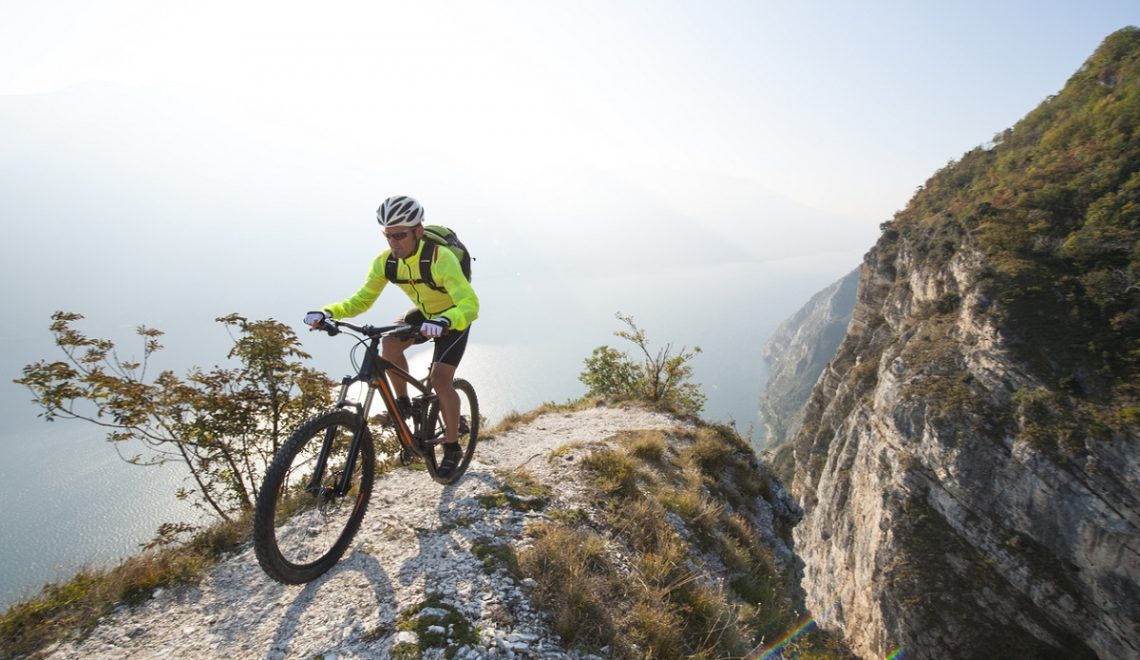
Italo Newsletter
Discount codes and promotions, other posts.

Discover our guides
- Where to eat in Rome
- Where to eat in Milan
- Where to eat in Naples
- Where to eat in Venice
- Where to eat in Bologna
- Best brunches in Italy
- Traveling with pets
- Best itineraries in Italy
- By train to the sea
- By train to the mountains
- Nature Trails
- Train stations in Italy
Our stations

- Subscribe Now
- Digital Editions
- Latest Issue
- The Country Life Podcast
- Country Life's Little Black Book
Palazzo Previtera, Sicily: When is a hotel not a hotel? When it’s also a museum, of course
Hetty Lintell visits the utterly unique Palazzo Previtera in the shadow of Sicily's Mount Etna.
Sicily’s roads are famously hairy, but with just a handful of white knuckle moments (Sicilians love to jostle, but never jostle back) we wound our way from the tourist trap of Taormina — which was heavenly, just don’t go in peak summer — to the sleepy town of Linguaglossa, thrillingly close to Mount Etna.

We very nearly didn’t make it, thanks to Etna’s feisty activity which forced the closure of Catania airport, but did make for majestic and fiery moments, which we watched safely from the serene new pool at Previtera.
The Italian palazzo is the Mediterranean’s equivalent to our stately home, but I’m relieved to report back that there’s nothing glaringly ostentatious about this fascinating home.
The Previtera family originally came from Acireale — a coastal city in the north-east of the island’s Catania region — and journeyed to Linguaglossa at the end of the 1500s. They were administrators of the Princess of Spadafora, part of a noble Sicilian family whose records date back to the 1200s.
Recommended videos for you

Palazzo Previtera is now owned and run by the charmingly calm Alfio Previtera, a cultural economist and academic who studied at King’s College London, and has a visceral passion for art, culture and history.
The young man has brought a refreshing breath of life to the historic building through clever modern touches and an eye for contemporary style (he collects elegant, mid-century furniture which rubs along fabulously with the 17th century elements).

We jumped at the offer of a tour of the private rooms (available to anyone staying; Alfio is on site and always keen to show people around). The house was designed in the Baroque style which arrived in Sicily a century after it hit bigger Italian cities. Why? Because in 1693, swathes of Sicily were all but wiped out in a massive earthquake and, when rebuilding, architects, patrons and residents decided to rebuild in this beautifully ornate style, with all of its requisite curves and flourishes, flamboyant grinning masks and putti.
We danced from room to room, drooling, jaws dropping because everything is (or seems) to be as it was when the rooms were first laid out. Glass cabinets are jammed with precious Murano glass and silver heirlooms. Desks are strewn with documents and important family trees to be poured over.

We stayed in the main house in a room a little like the ones we toured (there were fewer fragile ornaments, thank goodness) and, if at first we took a while to acclimatise, coming straight from air-conditioned modernity the night before, we soon fell head-over-heels for this magical place.
Alfio’s parents still live in the former summerhouse, and you’ll likely spot them darting around, busy with their daily lives, and making the most of the abundant gardens (the family also have homes in Milan and elsewhere, which in my imagination are also very grand indeed).

The gardens were so totally unexpected I thought, for a moment, that I’d wandered into Frances Hodgson Burnett book: wrought iron gates reimagined as decorative elements, choked with English rose plants, exotic palm trees and gnarled olive trees older than the house, archways that lead to tiny, stone hideaways — perfect for shaded respite from the hot summer’s sun.
Eclectic Sicilian and Moorish-style (Sicily was under Islamic rules from from the late ninth to 11th centuries) tiles and some cracked here and there, add to the charm.
Work first started in 1908, inside an old lava cave, and developed further after 1950. It is the antithesis of modern-day hotel and hotel gardens where everything is attributed to a ‘name’, brought in new and overly curated. Previtera has grown organically over years and years — something money simply cannot buy.
The fertile volcanic soil, I conclude, must be why everything here — including a dozen rows of vines — thrives even in the throes of August. ‘Is this the most unique spot on the island?’ I muse whilst enjoying a breakfast of local produce, served in the courtyard. The peaches, avocados and hazelnuts all come from their own farms; a cousin makes the pasta.
A holiday to Sicily is an exercise in constant digestion.

But back to that pool — with its unbeatable views of angry Etna. It’s framed by volcanic rock, bleached to a buttercream hue, and flanked by bamboo sun loungers and khaki green, tasselled umbrellas. This area is overlooked by the hotel’s newest, Art Deco-style suite (above) , furniture sourced from another family member who was about to recycle it. ‘No!’ Said Alfio, ‘I’ll have it for the Palazzo’ — and it works wonderfully.
There are other suites hidden amongst the gardens and some cottages which look charming, but occupied, so I don’t see inside. Out of loyalty, we deem our room in the main house to be the most authentic way to experience total immersion in this astonishing hotel.
Hetty Lintell’s top tips for Sicily
- If Etna is playing ball, land in Catania and head down to the island’s Baroque towns in the south-east. Noto is astonishing. Enjoy cocktails on the rooftop of Gagliardi Hotel for the best views of the town’s architecture. The gin and tonics are excellent too
- Dine at Manna — our favourite meal of the trip
- Avoid Taormina in the busier months, but when you do go, stay at Belmond’s Villa Sant Andrea . This beachside property is a more laid back alternative to their grander hotel up in the town. There’s excellent granita and the best tiramisu in Italy (I know, a big statement!)
- In Linguaglossa town, go for Aperol Spritz’s and nibbles (deep fried olives stuffed with sausage meat) at lowkey Nica Nuci. Alternatively, try the local Messina beer. Dine at Trattoria Linguaglossa — the pesto fuelled pasta monte Etna was perfection — or butcher-cum-restaurant Dei Pennisi
- Drive north to Milazzo port and hop over on a ferry to the laid back Aeolian Islands: Panarea — stay at Hotel Raya — and Salina. The latter stole our hearts and we spent our time there bombing around on rental scooters sniffing out hidden beaches. Stay at Hotel Signum and sample some fare from its captivating Michelin-starred restaurant
Haymarket Townhouse hotel review: Where to stay when out on the town in London’s West End
La réserve ramatuelle review: a st tropez hotel with a detail-oriented approach and slippers to die for, the country life guide to new york: where to go, what to see, where to stay and what to eat.

- NORTHERN IRELAND
- CUSTOM ITINERARY SERVICES
12 Travel Tips for Visiting Naples in Italy You Need To Know
Are you thinking of visiting Naples in Italy and wondering what you should know before you do?
This article will be perfect for you!
Naples is one of my favourite cities in Italy. I’ve visited several times and can simply not get enough. But it’s also important to mention that it’s a very chaotic and a bit overwhelming city.
Some people love it, others hate it. I love it but I do think you need to be prepared and know a bit what you’re getting yourself into if you want to make the best of your time.
Disclosure: This post may contain affiliate links, meaning I get a commission if you decide to make a purchase through my links, at no extra cost for you!
🔎 Table of Contents
1. Avoid visiting in July and August

It’s incredibly hot in Italy in July and August and even more so in Naples. Southern Italy is blessed with beautiful weather but the summer months are really tough in the city since the buildings make it feel even hotter.
While it’s not impossible to visit in July or August (I mean, I’ve done it so you can!), it’s just not comfortable. It’s so hot that you have to stop a lot to drink and it makes your legs and feet swell which is not great.
Also, since it’s the summer holidays, Naples is super busy and everything tends to be more expensive.
If you can visit in May, June or September, you’ll get a much better experience.
2. Get used to the chaos

Naples is a chaotic city. It might very well be the most chaotic city in Europe to be honest. That’s something you need to get used to and embrace.
Yes, people don’t respect the rules, cars don’t stop for pedestrians, people drive scooters without helmets… that’s just the way it is and you need to get on with it.
I know this can feel quite weird when you’re not used to it but the more you try to fight the system (or lack of system) the harder you’ll make it for yourself.
Just accept the chaos.
3. Wear a money belt
There are quite a lot of pickpockets in Naples and theft is quite common. For this reason, it’s better to avoid putting your money in your backpack or in a handbag that doesn’t have a zip.
To keep your money and passport safe, I recommend using a money belt . I know it’s not the most stylish piece of clothing but it’s incredibly practical.
4. Use public transport and walk

Public transport in Naples is honestly quite good. There are only 2 metro lines which means it’s easy to navigate. The metro itself is also very clean and there is AC (which is a huge plus if you are visiting in summer).
Ultimately, you can walk to most places in Naples but if you need to cover more distance, public transport is great.
Also, the tickets are pretty cheap.
I also highly recommend using public transport to go to Pompeii, Herculaneum and Sorrento. From Garibaldi station, you can take the circumvesuviana train which is both very practical and cheap.
5. Don’t rent a car in Naples

There are two reasons why you shouldn’t rent a car in Naples. Firstly, driving in Naples is very chaotic which makes it very hard if you’re not from Naples. You need to get used to the madness and it can be very stressful.
Secondly, there is simply no point in having a car in Naples since you can use public transport and everything is very easy to access. Even if you want to go to Pompeii or Sorrento, it’s much easier with the train.
The only reason why you should rent a car in Naples is if you want to go a bit off the beaten track and outside of Naples.
6. Learn some italian

While a lot of people in the old centre speak some English, it’s always quite handy to know some Italian.
In the Spanish Quarters for example, most people don’t speak English. A lot of them don’t even actually speak Italian much since they only speak Napolitan but knowing some Italian will be useful.
I recommend learning the common words such as hello, thank you, please, coffee, water, toilet…
Also, locals love it when you try to make an effort even if it’s in broken italian.
7. Eat street food

Naples is one of the best places in Italy when it comes to food. Some would even say that it’s the best place, full stop.
It’s the birthplace of pizza as well as many Italian specialties. But the thing that Naples does better than any other city in Italy, it’s street food.
From the fried pizza to the frittata di spaghetti, you’ll find loads of things you can buy from local stands (especially in the Spanish Quarters) and eat on the go.
Also, it’s very cheap so there is no reason to not try it!
8. Do a walking tour in the Spanish Quarters

The Spanish Quarters are the most unique district in Naples. They are colourful, authentic, full of good food shops and where you can find the famous Maradona mural.
They used to be the most dangerous place in Naples and are now a lot more visited by tourists.
Walking around the Spanish Quarters is a unique experience that words can’t really describe. There is nothing like it.

Most of the locals here speak Napolitan, a lot of them don’t even speak Italian so that’s to say how authentic it is.
While it’s not unsafe anymore to visit the Spanish Quarters, you should still be careful. The best way to visit this area is with a walking tour. Being with a guide will give you the chance to truly understand this part of Naples and learn plenty about the football culture and food.
9. Withdraw cash
Cash is king in Naples. A lot of places don’t accept cards and even if they do, they definitely prefer cash.
If you buy street food, you will need cash, for coffees as well. For restaurants, some of them do take cards but it’s better to have some cash at all times.
10. Avoid exploring on your own at night

Technically, Naples is not overly unsafe however it can feel a bit overwhelming and even more at night.
I would recommend avoiding going out by yourself too much at night, especially in the Spanish Quarters.
11. Download Google Translate and the Italian language
People working in tourist attractions usually speak English, so do the waiters in the Old Centre but outside of that, most people don’t speak English.
For this reason, I recommend downloading Google Translate and the Italian language (so you can use it offline) beforehand. That way, language will never be too much of a barrier.
12. Don’t buy a Neapolitan horn for yourself

As you walk around Naples, you will notice there are a lot of Neapolitan horns. This is a good luck charm for the Neapolitans and you can find them everywhere as key rings.
They make for the perfect souvenir however, you shouldn’t buy it for yourself. The horn only brings luck when it’s gifted so you can buy it for your friends and family but shouldn’t buy it for yourself. Someone else should buy it for you.
I hope this article has helped you and you have a better idea of what to expect in Naples.
You may also be interested in:
- 6+ Best Pizza Tours in Naples To Go On
- Day trip from Naples to Pompeii: How to visit Pompeii in one day from Naples, Italy
- 12 Best Food Tours in Naples
Founder of Beeloved City, I am originally from France and have been living in the UK since 2016. I've travelled to 25 countries as a backpacker, travel coordinator and for holidays. I spent a year in Australia before eventually settling down in Manchester, England
- English (EN)
- Español (ES)
- Português (BR)
Is Saint Petersburg Safe? Crime Rates & Safety Report
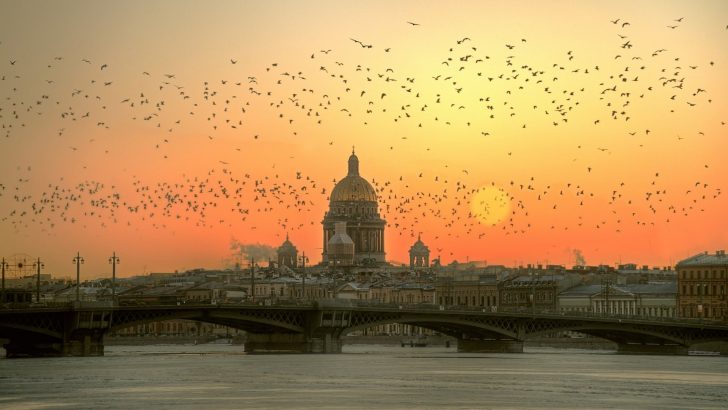
On Feb. 24, 2022, Russia invaded its neighbor country Ukraine, starting a war between these two countries.
This act of invasion caused many Ukrainians to flee their country and seek shelter in places like Poland, Hungary, Slovakia, etc…
At this time, we recommend no travel to Russia or Ukraine, or any neighboring countries for your own safety.
Russia : Safety by City
- Nizhny Novgorod
- Novosibirsk
- Saint Petersburg
- Yekaterinburg
Saint Petersburg is Russia’s second-largest city and one of the main reasons tourists go to visit Russia.
It is located on the Neva River, at the head of the Gulf of Finland on the Baltic Sea and founded by Tsar Peter the Great
It was called Saint Petersburg (Peter’s city) for a while, but in September 1914, its name was changed to Petrograd, then to Leningrad, and finally in 1991 back to Saint Petersburg.
It was also the capital of Russia for a while. This city is filled with history, but Saint Petersburg is also one of the most modern cities in Russia, apart from being its cultural capital.
It also has a couple of Unesco World Heritage Sites, like the Historic Centre of Saint Petersburg and Related Groups of Monuments.
And of course, don’t forget the Hermitage, one of the largest art museums in the world.
- Warnings & Dangers in Saint Petersburg
OVERALL RISK: MEDIUM
Generally speaking, Saint Petersburg today is safe as much as other countries in Europe, despite its problematic history with criminal activity in the 90s. However, if you’re planning on traveling to Saint Petersburg, keep in mind that you should always keep your guard up and remain aware of your surroundings, just in case.
TRANSPORT & TAXIS RISK: LOW
Generally speaking, transportation in Saint Petersburg is safe, but you should bear in mind that kidnappings have been known to happen, mostly in unlicensed taxis, so be careful when hailing one on the streets. Keep in mind that the most dangerous areas where small crime tends to occur are the underground walkways, called “perekhods”. Only use official services like Yandex Taxi, Uber or Gett taxi.
PICKPOCKETS RISK: HIGH
Pickpocketing is very common in Saint Petersburg, and surprisingly it is mostly performed by groups of children. Pay attention to your belongings, don’t leave them in plain sight and be especially careful in crowded places like stations or near tourist attractions.
NATURAL DISASTERS RISK: LOW
Saint Petersburg isn’t particularly susceptible to natural disasters. Some blizzards and snowstorms are possible during winter which can affect the traffic and delay your flights. During winter, be prepared to face the below-freezing temperatures.
MUGGING RISK: MEDIUM
The situation improved drastically when it comes to kidnappings and muggings. Generally, never accept free drinks or food when you’re in a club or a bar. Drink spiking and then attacking and robbing the victim have been reported on numerous occasions.
TERRORISM RISK: LOW
After the recent terrorist attack in the subway in St. Petersburg the probability of this situation happening again is high.
SCAMS RISK: HIGH
There are many scams in Saint Petersburg, usually performed by children trying to distract you and then steal some money from you. Never talk to strange kids on the street. Also, you should avoid playing street gambling games.
WOMEN TRAVELERS RISK: LOW
Women are generally safe in Saint Petersburg, though you should avoid finding yourself alone in clubs or bars, and of course, apply all normal precaution measures like avoiding remote and poorly lit streets and areas.
- So... How Safe Is Saint Petersburg Really?
Saint Petersburg, like the rest of Russia, experienced a rise when it came to crime rates during the 1990s.
Violent crime, as well as petty crime and scams, have increased, but the biggest part of the violence was within the criminal groups themselves, and it didn’t affect foreigners that much.
However, it decreased since the 90s, so right now, for tourists, major cities like Moscow and St. Petersburg aren’t more dangerous than any other European city, they’re even less so.
When it comes to authority officials, you should keep in mind that they usually don’t speak English, so be understanding if someone doesn’t know how to communicate with you.
Speaking about the officials, don’t ever try to bribe them: you will be charged with bribery.
Bear in mind that if you are a member of the LGBT community, there is no reason to avoid Saint Petersburg altogether but you should refrain from any public displays of affection.
As of June 2013, “homosexual propaganda to minors” is prohibited, which means that any discussion of gay rights or homosexuality issues in the presence of minors is punishable by law.
While you walk around Saint Petersburg, you might encounter police officials that may demand to see your papers to check if you have been registered within 7 business days of your arrival into Saint Petersburg.
You shouldn’t have any problems with this, because if you stay in a hotel then you are automatically registered and will be handed a confirmation paper.
- How Does Saint Petersburg Compare?
- Useful Information
Most countries do need a visa to enter Russia, and if you’re a U.S. citizen you must possess both a valid U.S. passport and a bona fide visa issued by a Russian Embassy or Consulate. None of the nationals that do need a visa can acquire one upon arrival, so make sure you apply for your visa in advance. If you are not sure about your visa status, visit www.doyouneedvisa.com which will let you know whether or not you need visa based on your nationality and the country you want to visit.
Russian ruble is the official currency in Saint Petersburg. ATMs are widespread throughout the country and credit cards are accepted everywhere.
Saint Petersburg has a highly continental influenced climate characterized by warm to hot and dry summers and extremely cold, freezing winters with temperatures as low as -30°C – sometimes even lower, with heavy snowfall.
Pulkovo Airport is an international airport serving Saint Petersburg, Russia. It consists of one terminal, Terminal 1 which is located 23 km south of the city center.
Travel Insurance
Just like anywhere else, we advise getting travel insurance when traveling to Saint Petersburg, because it would cover not only medical problems but also theft and loss of valuables.
Saint Petersburg Weather Averages (Temperatures)
- Average High/Low Temperature
Russia - Safety by City
- Where to Next?
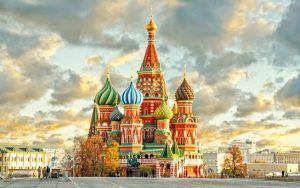
5 Reviews on Saint Petersburg
Took a package tour serveral years ago from Finland through St P and down to Moscow by train. Probably the entire contingent of older Canadian tourists experienced multiple pickpocket incidents, including on crowded Metro cars. One person was sandwiched between two people in a subway turnstile who discretely picked their pocket. Another had a daypack slashed with a razor. Any interesting road scam was when the chartered tour bus (with Finnish plates) was hit by a Russian driver. After police arrived, the hat was passed on the bus to pay the “fine” and settle up with police & driver.
St. Petersburg is one of the safest cities in Russia.
I note the subtle anti Russia statements at the introduction.. Russia’s security concerns are in fact genuine. NATO expansion eastward is seen by Russians as directed against their country. Putin has been clear for many years that if continued, the expansion would likely be met with serious resistance by the Russians, even with military action. The Ukraine military had killed almost 15000 Russian speaking Ukrainians in the east in the lead up to the invasion. No complaints from the west. The usa has been looking forward to this war and preparing Ukraine for many years to fight as their proxy. Problem is that the usa is losing and will ultimately lose. Yet again.
Street scams? I’m a Brit in Saint Petersburg, 12 years, and I’ve NEVER seen any street scams. Yes, there are pickpockets, but nothing like those in Italy or Spain. The above review about a bag being slashed sounds brutal and violent. The tactic is never confrontational and is just a way to enter your bag without you knowing. Again, it’s used in other European countries.
My advice is simple – keep your passport etc. in your hotel room and take photos of your passport, visa, migration card and registration. Keep your wallet in a zipped pocket and remove it if you ever leave your coat. It’s common to hang up your coat etc. in cafes and bars, and common sense should tell you to remove valuables. I’m more cautious in the UK, to be honest.
Guys, avoid girls who want to take you to a bar that seems empty but has a lot of staff. These girls are paid to bring you there, have a few drinks, then when you get the bill, drinks cost about £30 a piece. Only enter bars that have a lot of other people, a mixture of different people.
I recommend that you download Yandex Go, a taxi app, and Yandex Maps, Yandex Metro, and Yandex Eda (food delivery).
Hi Brit, what is it like right now (Feb 2023) for travel ? I want to visit for 4 days. Thanks
Share Your Experience Cancel reply
Your Review
Title of your review
Article Contents
- Saint Petersburg : Safety by City
- Overall Risk
- Transport & Taxis Risk
- Pickpockets Risk
- Natural Disasters Risk
- Mugging Risk
- Terrorism Risk
- Women Travelers Risk
- Weather Averages (Temperatures)
- User Reviews
- Share Your Experience
Popular Destinations

Safety Index
Recent reviews & comments.
- Amy Howard on High Point
- Peggy Long on High Point
- Nicholas Cross on High Point
- Adrian Scott on High Point
- Peter Miller on High Point
Popular US States
- Pennsylvania

13 Things To Do In Saint Petersburg | Russia’s Most Beautiful City
By Author Christian L.
Posted on Published: January 17, 2021 - Last updated: September 11, 2021
Categories Europe , Destinations , Russia
Once known as Leningrad and before that Petrograd, Saint Petersburg, Russia, is the country’s second-largest city. Set next to the Neva River, close to the Baltic Sea, this city is home to over 5 million people.
It’s the world’s northernmost city, founded by Peter the Great and named after Saint Peter the apostle. Once home to the Tsars of Russia, it is today known as the country’s cultural capital.
With iconic sights such as Hermitage Museum, Nevsky Prospect, Peterhof Palace, and so much more, it has a fascinating heritage ripe for exploration. Without further ado, let’s dive into the 13 best things to do in St. Petersburg.
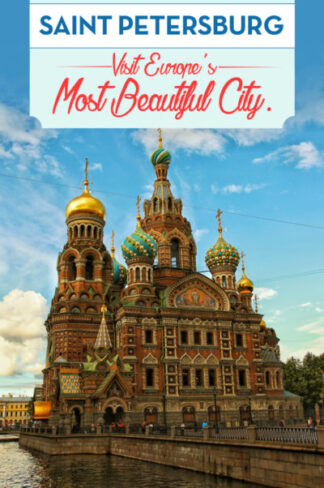
Top Things to do in St. Petersburg, Russia
St. Petersburg, Europe, has grown into one of the top tourist destinations on the continent. Although it might get very cold in winter, there are still plenty of things to do – and the summers are absolutely perfect! Saint Petersburg is one of the prettiest cities in all of Europe .
Keep reading for some of my favorite choices.
1. Visit The World Famous Hermitage Museum

One of the city’s most popular attractions (with over 3 million items in its esteemed collection), State Hermitage Museum showcases everything from fine art to ancient artifacts.
Even if you don’t plan on entering inside, the exterior is an architectural gem in itself. The columns are all in white with green/gold facades that can be viewed from the river or Palace Square.
If you’re visiting St. Petersburg, Russia, your trip would not be complete without stopping past this world-famous landmark. It’s also a great activity to do no matter what time of year you are visiting – and a perfect way to escape those cold Russian winter days.
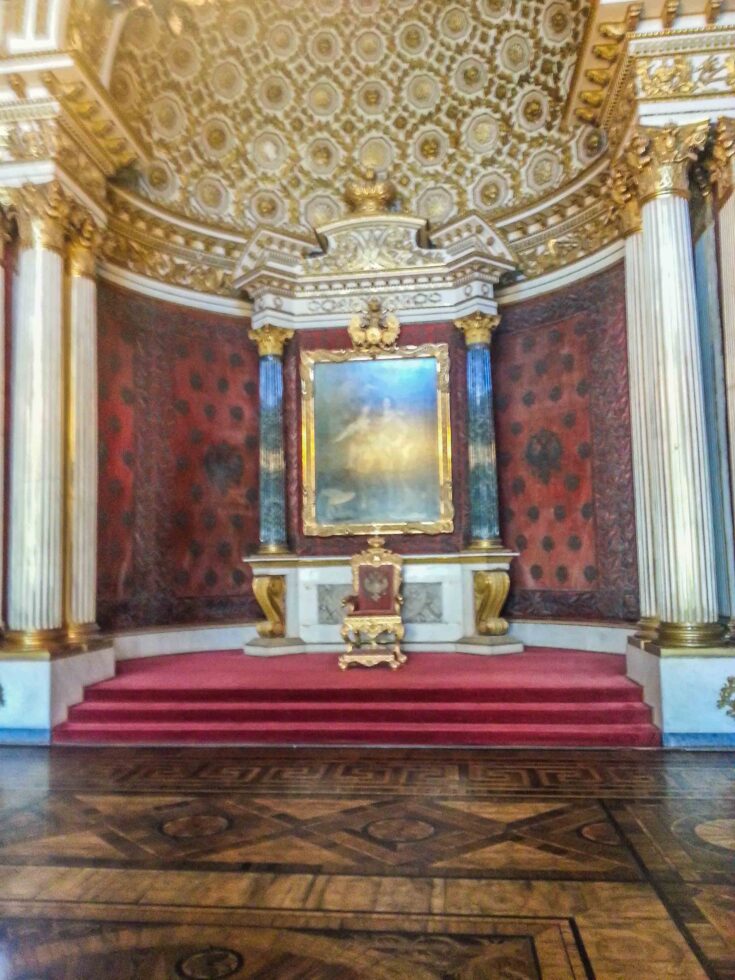
There are six buildings in the museum complex in total. Five of which – Winter Palace, Small Hermitage, Old Hermitage, New Hermitage, and Hermitage Theatre – can be accessed by the public.
Within, you’ll be treated to Egyptian collections, artifacts dating from ancient Mesopotamia, and classical Greek jewelry, pottery, and sculptures. This is any historical culture lover’s dream.
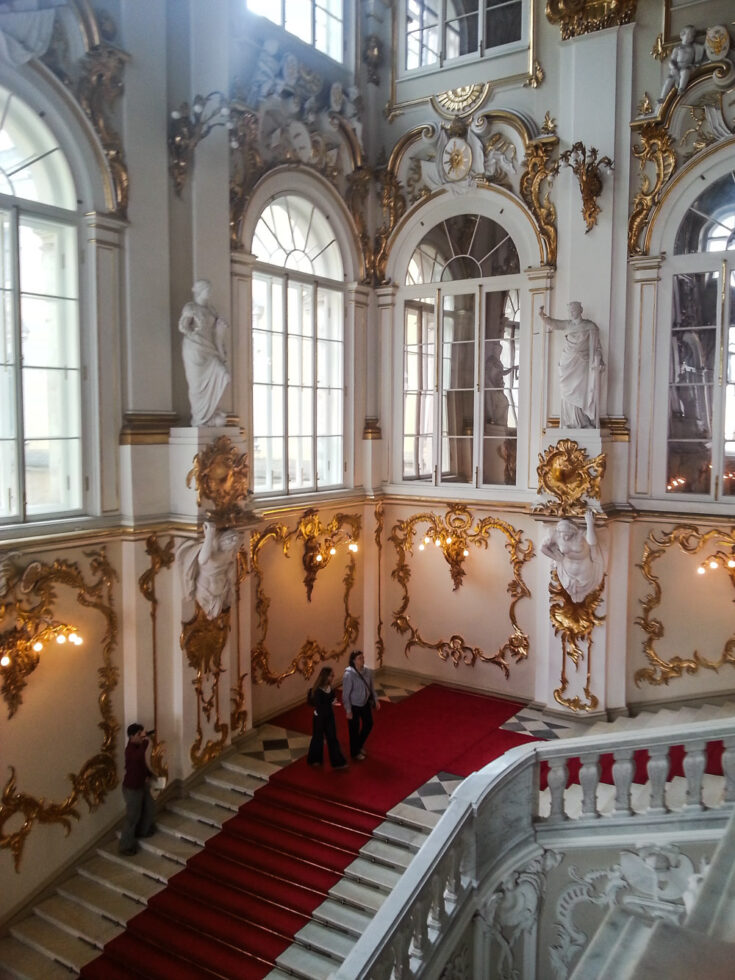
Keep exploring, and you will find collections of prehistoric relics from the Palaeolithic era to the Iron Ages, European fine arts, Impressionist works, Catherine the Great’s personal collections, and so much more.
In fact, you’ll need an entire day or possibly longer to explore this incredible museum complex. If you only have limited time in St. Petersburg, be sure to add this museum to your itinerary! There are also guided tours available if you want a more educational experience.
Did you know? The Hermitage Museum is the world’s second-largest art museum.

2. Take in a Performance at Mariinsky Theatre
The Neoclassical Mariinsky Theatre is home to Russia’s revered opera and ballet companies.
The theatre – named after the wife of Tsar Alexandra II, Empress Maria Alexandrovna – has been here since 1860 when it was known as the Kirov Theatre.
This magnificent building, since it opened, has hosted stage performances and premieres from Tchaikovsky and Mussorgsky and famous ballets such as Sleeping Beauty, Swan Lake and The Nutcracker.
Today, in addition to hosting live performances, the theatre has its own record label, which focuses on releasing music by Russian composers Stravinsky, Tchaikovsky, and Rachmaninov.
If you enjoy the arts and are going to be in St. Petersburg for several days, book tickets to see a world-class performance – you won’t be disappointed.
3. See Jewelled Eggs at the Faberge Museum
The House of Faberge was founded in St. Petersburg in 1842 by Gustav Faberge. Originally a jeweler, he became famous for designing jewel-encrusted eggs for the Tsars of Russia and is arguably the most famous goldsmith of the modern era.
Today, you can view these iconic collection pieces in the Faberge Museum. It showcases 4,000 items in total, including Faberge Easter eggs, jewelry, silverware, home decor, and fantasy-themed objects.
The incredible jeweled eggs are famous all over the world, and there are several museums dedicated to them. But if you want to learn about Gustav Faberge, his family, and how it all began, this is the museum to visit. You can purchase a ticket in person or online.
4. Spend an Hour Canal Cruising
St. Petersburg is built on 42 islands, and once upon a time (before bridges were constructed), cruising was the only way to navigate the city.

On a Golden Ring boat tour, you’ll see some of St. Petersburg’s iconic sights along the Kryukov Canal, including St. Nicholas Cathedral, Saint Isaac’s Cathedral, and the Mariinsky theatre.
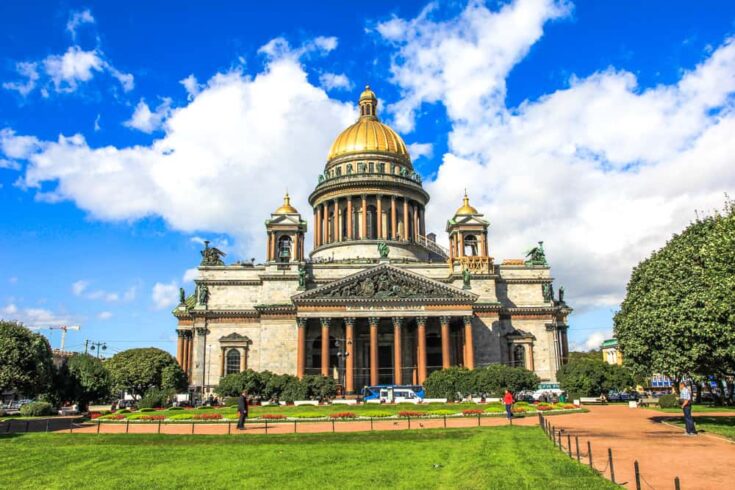
You’ll dip beneath the famous colored bridges on Neva River whilst enjoying views of Peter and Paul Fortress, Vasilyevsky Island, and the Summer Garden. This is truly one of the most breathtaking ways to take in all the beauty that St. Petersburg has to offer.
This tour also only takes around an hour, so you’ll have plenty of time to revisit your favorite spots throughout the day!

5. Discover Church of the Savior on Spilled Blood
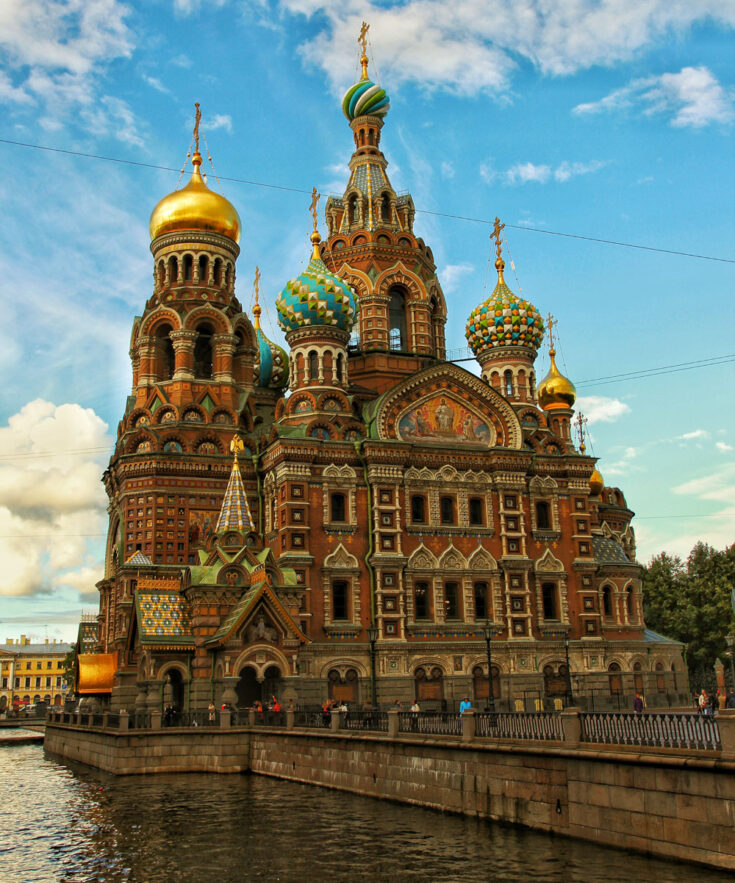
One of St. Petersburg’s architectural masterpieces is the Church of Our Savior on Spilled Blood.
This former Russian Orthodox Church was completed in 1907 and is built in Baroque, Neoclassical, and Russian Revival design. It is one of the city’s main attractions, with ornate domes, intricate frescoes, and 7,500 square meters of mosaics inside.
If you don’t wish to enter, you can gain incredible views from Griboedov Canal. But if you do venture inside, you’ll be rewarded with interior frescoes and mosaic works depicting biblical scenes and figures created by celebrated Russian artists of the time.
The Church of the Saviour of Blood is built on the spot where Emperor Alexander 2 was assassinated in 1881 – hence the name. So, not only will you be able to appreciate the fine architectural designs, but also explore an important part of Russian history.
6. Take a Rooftop Walk-in St. Petersburg
If you have viewed the city from canals and rivers, try it from the rooftops! You can take a guided rooftop walk in the city, seeing streets and skylines from an elevated perspective.
One particular tour to highlight is the Official Rooftops Excursion of St. Petersburg. Just a few minutes from Nevsky Prospect, these sites offer vistas of Fontanka River and Trinity Cathedral – and that’s just the first roof.
The second roof boasts views of St. Petersburg’s old center, St. Isaac’s Cathedral, Kazan Cathedral, and the Church on Spilled Blood.
This is a truly incredible way to see the city in all its glory, plus the tour provides you with binoculars so you can see everything in great detail.
7. Admire Nevsky Prospect’s Magnificent Architecture
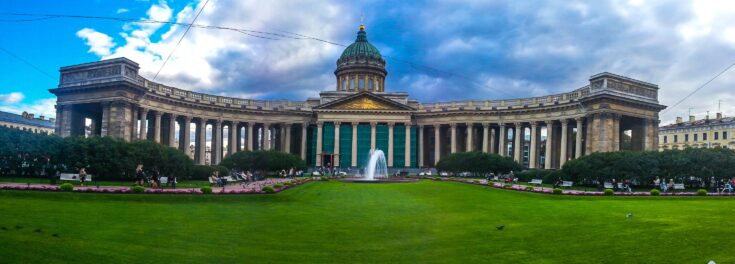
The main street of St. Petersburg is Nevsky Prospect. Begin at the intersection at Stroganov Palace before venturing to Kazan Cathedral. While you walk, take in the monuments dedicated to Catherine the Great and browse goods at The Passage – Nevsky Avenue’s premier department store.
This store was quite the trailblazer. It opened its doors in the late 1840s and was one of the first buildings in Russia to use gas for lighting. Then, in 1900, an electric station was installed on an underground floor.
Once you’ve finished shopping and enjoyed a fresh cup of coffee, continue to the Russian National Library – the oldest public library in Russia – and Alexandrinsky Theatre (which was built for the Imperial troupe of Petersburg).
8. Visit the Island of Peter and Paul Fortress

Set on an island connected by bridges, Peter and Paul Fortress is instantly recognizable from its needle spire, which dominates the skyline. The fortress was originally built to defend the maritime city from Swedish invaders.
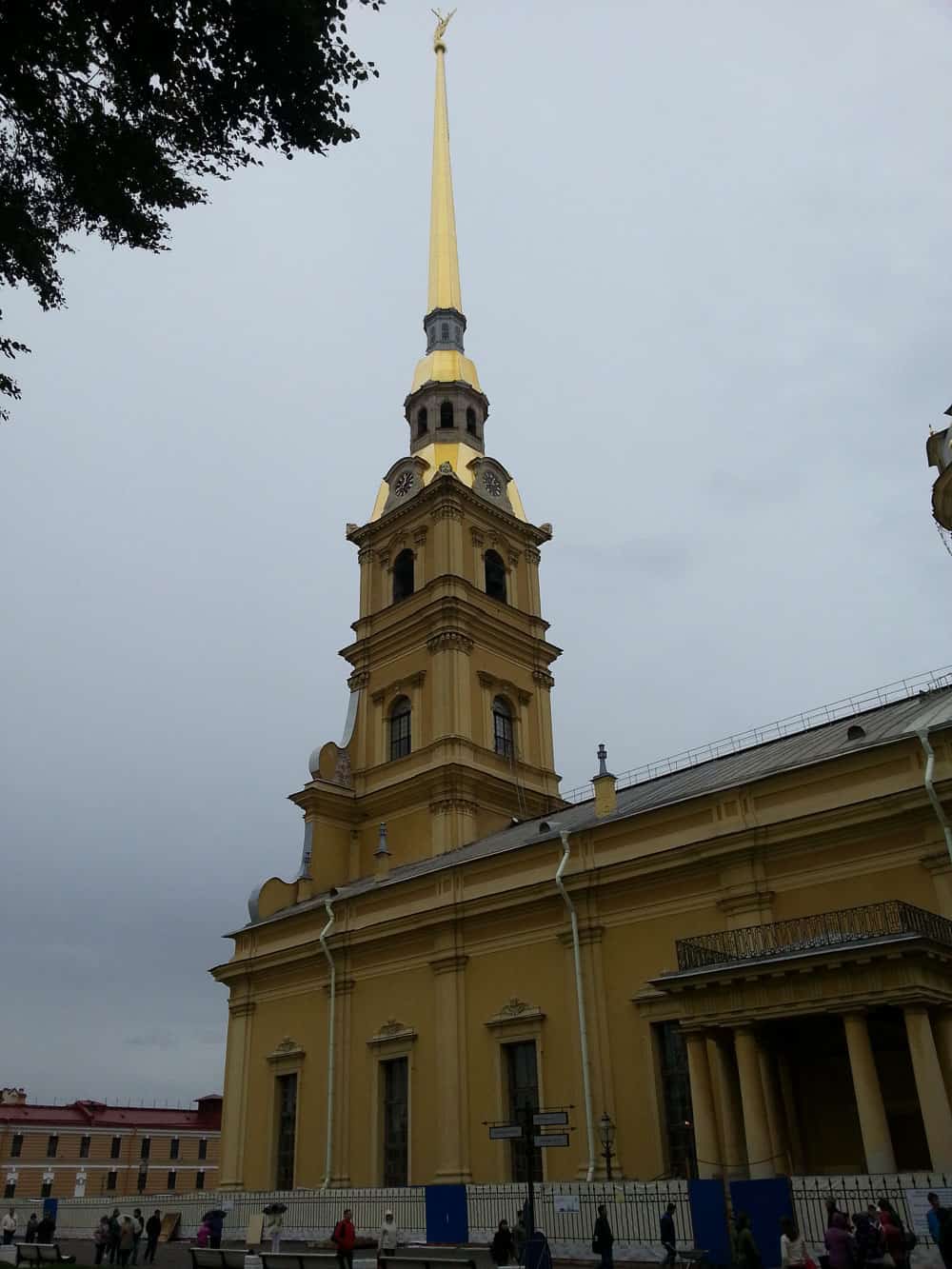
However, Peter the Great defeated the opposition before it was even completed! It has since served as a military center and prison for political dissenters and, latterly, as a museum.
Inside the vast complex, you can see Peter and Paul Cathedral, visit the resting place of the Romanovs, and watch military processions or the firing of the noon-day gun.
It’s a great day trip for anyone interested in Russian, maritime or military history. There are also plenty of group walking tours available.
9. Sample Russian Vodka in a Ryumochnye
A visit to Russia wouldn’t be complete without sampling the local drink – vodka, and the best place to do this is in a Ryumochnye. This is a specific style of 19th-century Russian drinking house that not only offers some of Russia’s best vodka but also a short history lesson.
You could call it a bar, but it’s more than that – most mainstream Ryumochnye have a definite Soviet vibe and are places for working men to kick back and enjoy vodka with their buddies.
Beverages come in bottles or shot form, and some places offer self-service and snacks.
If that sounds too hardcore for your taste, there are updated versions of Ryumochnye in the city, like Mayak in St. Petersburg, where you can gain a similar experience.
10. Enjoy local Saint Petersburg Craft Beer
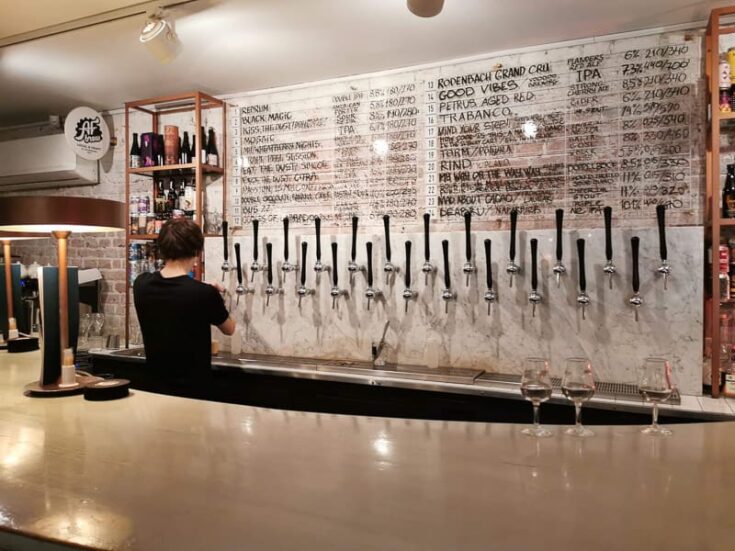
Although most people think of vodka when visiting Russia, you can also enjoy some of the best craft beer in Saint Petersburg . Russia’s second-largest city has an exciting, rapidly growing craft beer scene, in part due to its history and geography.
Historically, the Russian empire was influenced by Northern Europe, and the Dutch & English beer-drinking culture eventually made its way here. Today, Saint Petersburg is home to a growing number of modern microbreweries, cool taprooms, and stylish bars.
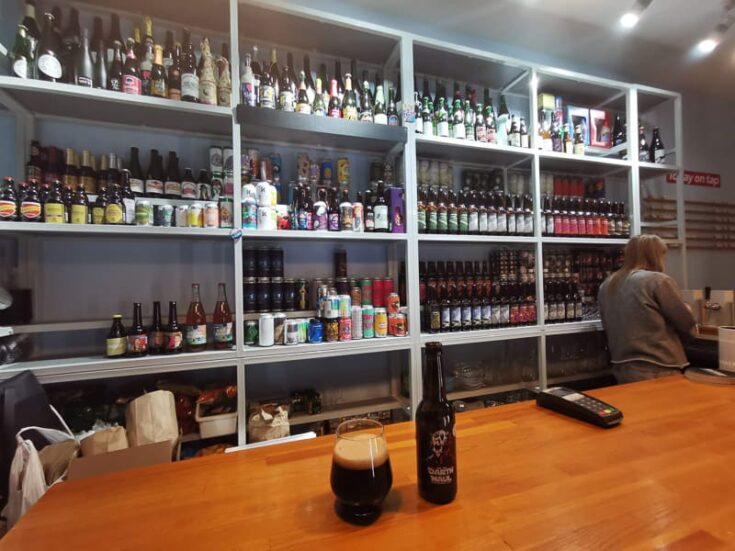
Saint Petersburg is also home to Stepan Razin Brewery, the oldest brewery in Russia (now, of course, owned by Heiniken). It opened in 1795, but today the building is known as the Saint Petersburg Beer Museum, showcasing the history of beer in Russia and the Soviet Union.
Russia’s largest and most popular brewery, Baltika, is also located in Saint Petersburg, and it’s possible to take a tour of their huge brewery.
11. See the Majestic Catherine Palace
A stately palace of blue and gold, Catherine’s Palace is located 26 kilometers south of St. Petersburg. Named after the wife of Peter the Great, this place was originally a two-story modest building commissioned in 1717.
The exterior, which stretches for one kilometer in circumference, is surrounded by woodlands, lawns, gilded balconies, and reliefs. However, the interiors are even more impressive.
With great halls, a white dining room, an amber room, and more. It’s the perfect place to step back into history and discover what life was like as a Russian aristocracy.
12. Explore Peterhof Palace

If you’re going to visit Catherine Palace, you should tour Peterhof too. It’s a 40-minute drive away, but you can even take a hydrofoil speed boat from right behind the Hermitage in Saint Petersburg center.
Sitting close to the Baltic Sea, Peterhof Palace was constructed by Peter the Great to be Russia’s version of Versailles. The opulent residence surrounded by sculptures, fountains, and tiered staircases leading to the grand entrance evokes mystery and the history of a bygone era.
Inside it is lavishly decorated with dazzling chandeliers, one-of-a-kind artworks and beautiful ceiling frescoes.
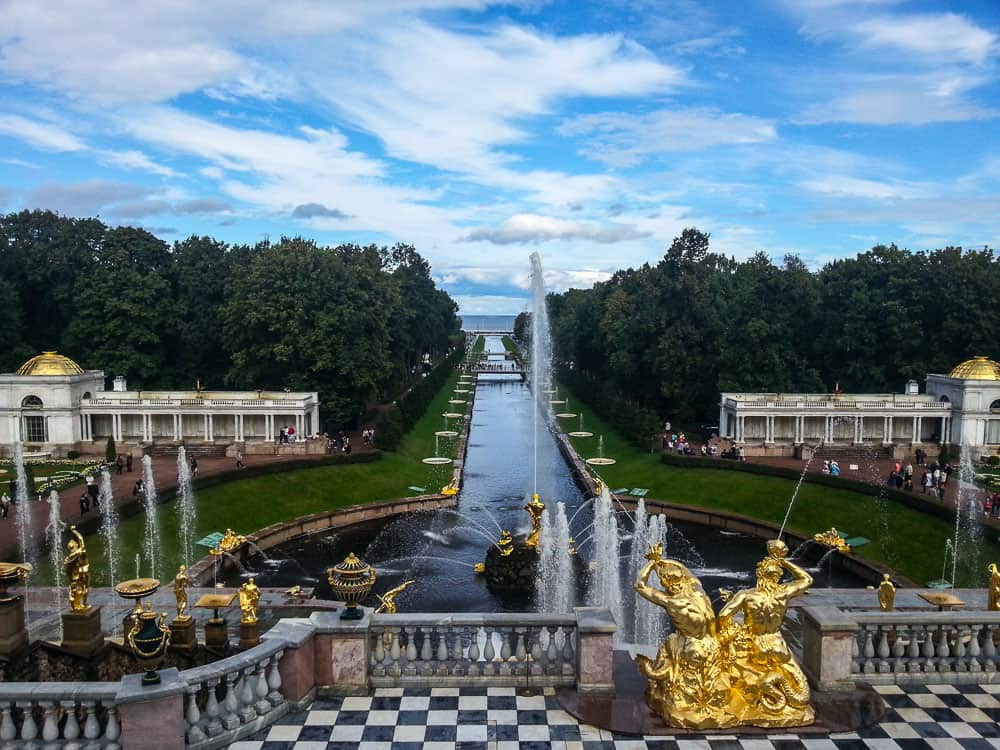
On a guided tour, you can learn more about the palace’s history. Discover the Throne Room, Portrait Hall and Peter the Great’s Oak Study. You’ll see dining rooms set for dinner, grand ballrooms where dancing and gatherings would take place, and décor which defies time.

The palace offers great insight into his life and legacy, and if you are interested in history, art and interior design, you’ll love it.
Want to know more about Peterhof?
13. Spend a Day by the Finnish Border at Vyborg
Just over an hour from central Saint Petersburg by train is the city of Vyborg. It sits on the Gulf of Finland and was first settled back in the 12th century. The city has been occupied by Finnish and German forces and suffered extensive damage during the Second World War. However, it has since been rebuilt.
It’s a charming center to wander around, with narrow cobbled streets, a medieval castle, and Finnish art nouveau structures sprinkled throughout. An easy day trip from St. Petersburg, it can also serve as a stop-off point if you’re crossing into Finland to continue your adventure.
Want to know more about Saint Petersburg?
Where is St. Petersburg | Is St. Petersburg in Europe?
If you want to know “Where is Saint Petersburg?”, you’ve come to the right place. Beautiful St. Petersburg is located in northern Russia. Russia is a massive country, so it is no surprise that many people want to know “Is Saint Petersburg in Europe?”. The answer is yes.
How to Get to Saint Petersburg
The maritime city is well linked to Europe by air, sea, rail and road. Depending on where you’re traveling from and the rest of your itinerary, you can use one of the following ways to arrive at St. Petersburg.
You can fly into Saint Petersburg through Pulkovo International Airport. There are around 1,100 international flights a week and 1,200 domestic flights operating in and out of the local airport.
Although many flights from European cities to Saint Petersburg are direct, you may have to change flights if flying from further afield.
It’s also possible to travel to St. Petersburg by train. The most popular (and most frequent) routes operate from Moscow, Helsinki, and Tallinn. However, there are options to travel from other areas in central Europe, central Asia, and eastern Europe by rail.
There is a central bus station in Saint Petersburg, with services to and from Moscow, Pskov, Novgorod, Vilnius, Riga , Tallinn and Helsinki. Some of these journeys can be long and arduous.
Therefore, thorough research and choosing the right bus company is important.
Baltic Sea Cruises also operate to St. Petersburg as part of a larger itinerary, and St. Peter Line Ferry sails from Helsinki in Finland and Tallinn in Estonia.
Exploring Saint Petersburg, Russia
Saint Petersburg is the 5th most populous city in Europe and also a leading tourist destination. Although people sometimes forget about Russia, this city is breathtakingly beautiful and provides plenty of cultural and historical attractions.
Now that you know where to go, I hope you have an amazing time in Russia’s most beautiful city.
Friday 19th of January 2018
Thank you! So great review about our St. Petersburg!
What to do in St. Petersburg in 1 day - Probe around the Globe
Thursday 11th of May 2017
[…] more about the beauty of St. Petersburg from the Unusual […]
Friday 17th of June 2016
Which hostel did you stay at? I am potentially thinking of going to Russia for World Cup 2018 after my World Cup trip to Brazil two years ago. Saint Petersburg is one of the host cities, and so I am very interested in learning more about this city and recommendations from fellow travellers who have been.
Christian L.
I stayed at Soul Kitchen Junior, and I will go so far and say its by far the best hostel I have ever stayed at!! Anywhere in the world, no other hostels even get close to it:)

3 Days in Saint Petersburg Russia: My Perfect 3-Day Saint Petersburg Itinerary
Saint Petersburg is one of Russia’s largest and most exciting cities, offering visitors thousands of things to do, including museums, palaces, beautiful parks, historical sites, and world-class theatre. Discover all the sights and delights the cultural capital of Russia has to offer with my 3-day Saint Petersburg itinerary.
With all these options, planning a trip to Saint Petersburg can be a bit overwhelming, especially for first-time visitors. I’ve put together a recommended 3-day Saint Petersburg itinerary that will help you see the city’s highlights if you have at least 3 days in Saint Petersburg.
Saint Petersburg is a budget-friendly destination that promises historical immersion and exquisite architecture at half the price of that in Western Europe.
My suggested 3-day itinerary has you visiting all the city’s most famous attractions (e.g., the atmospheric Church of the Savior on Spilled Blood, the Winter Palace, the Hermitage Museum) as well as some of the city’s lesser-known attractions. In addition to the 3-day itinerary, I also provide tips on how to get around Saint Petersburg and tips on where to eat and stay during your 3 days in Saint Petersburg.
If you’re headed to Russia’s capital city, take a look at my travel itinerary for one week in Moscow .

3 Days in Saint Petersburg Itinerary | The Perfect 72 Hours in Saint Petersburg
Saint petersburg, russia in 3 days – day 1.
Start with an early morning walk along Nevsky Avenue from Vosstaniya Square to the Admiralty Building. The first point of interest is the Hero-City obelisk next to the Moskovsky railway station commemorating the victory of Soviet people over the Nazis. The lovely views will put you in a good mood for the rest of the day. Stop for a nice cappuccino at one of the bars near Gostiny Dvor, a Russian alternative to the French Passage. Enjoy the sight of the old Anichkov Bridge, the oldest bridge over the Fontanka River.
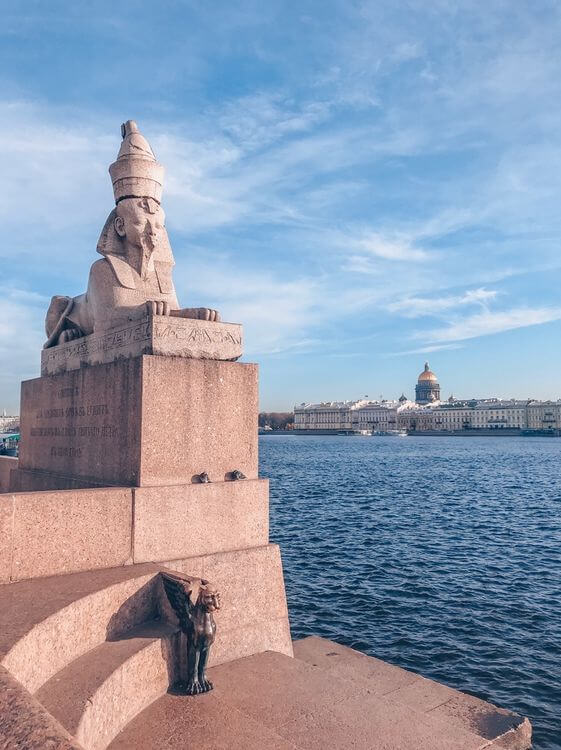
Then make your way to the neoclassical St. Isaac’s Cathedral. It’s a good idea to climb to its colonnade’s observation platform. It means that you get a panoramic view of the St.Petersburg and the refreshing breeze in the summertime.
In St. Isaac’s Cathedral you can admire the interior that boasts more than 300 paintings, mosaics, sculptures, various kinds of precious stones and gilding. The walls of the Cathedral are faced with fine Italian and Russian varieties of marble and other stones: malachite, lapis lazuli, porphyry. St. Isaac’s Cathedral, for example, is otherwise known as the “Museum of stones”.
What Motivates People to Travel
Just a stone’s throw away from St. Isaac’s Cathedral you’ll find the Winter Palace and the Hermitage Museum. These are the most famous attractions in St. Petersburg and you simply can’t miss them. Spend some time taking awesome pictures of the Palace Square, then continue your walking tour of St Petersburg toward the Spit of Vasilevsky Island.
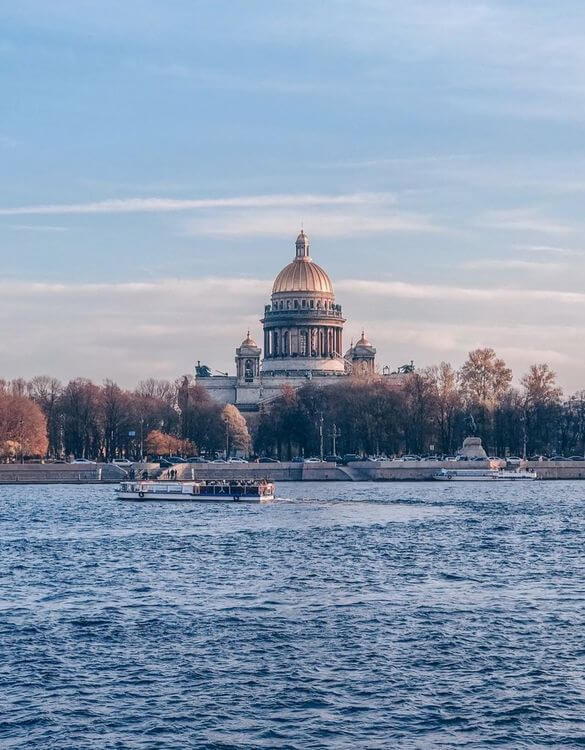
Here you’ll find red Rostral Columns decorated with bronze anchors and four pairs of bronze ship prows. Ah, don’t miss out on visiting the KunstKamera, arguably the weirdest museum in the world.
End your first day in Saint Petersburg exploring the Peter and Paul Fortress. The mighty that never served its purpose to protect the city sits on a narrow strip of land at the mouth of the Neva river. Hare’s island is home to a plethora of various buildings, museums, and exhibitions both permanent and temporary. Although, these do not always reflect the specific history of the fortress itself.
Be sure to make your way down to the Neva River. Here you can have a take a leisurely stroll along the mighty granite walls and mingle with locals.
Saint Petersburg, Russia in 3 days – Day 2
First things first. You can’t visit Saint Petersburg without seeing the real Dutch and Flemish Painting in the Hermitage Museum. It’s worth the trip but book ahead, and allow yourself at least two hours. A good place for a coffee and a pastry is Hermitage Cafe in the General Staff building. Pop over to the Field of Mars to have a look at ordinary people spending their leisure time and the first eternal flame in the country.
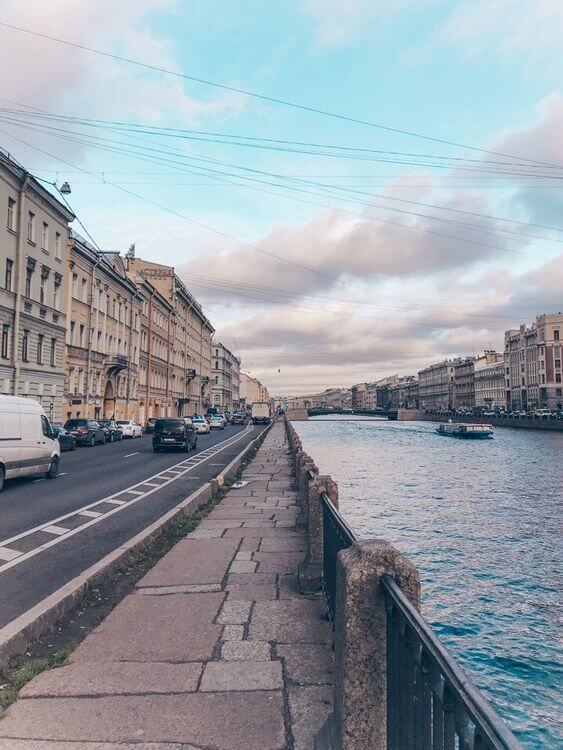
If you are a history buff, visit the Museum of the Defense and Siege of Leningrad. a former monastery filled with atmospheric early Renaissance frescoes painted by Fra’ Angelico. The permanent exhibition features the history of the city during the 900-day Blockade, which lasted from 8 September 1941 to 17 January 1944. It goes without saying that this is a very sobering, and unique place to visit for thought-provoking entertainment.
When Is the Best Time to Visit Russia
Then walk along Moika Embankment towards Chizhyk Pyzhik sculpture (pine siskin), and from there take a stroll through the Michael Garden (Mikhaylovskiy Sad) to reach the Church of the Savior on Blood. Admire the ornate cupolas of the Cathedral, otherwise known as ‘Spas Na Krovi‘. It was built on the very spot that Alexander II had been assassinated on March 1, 1881. You can also admire the Cathedral’s interior from inside – walls and ceilings are completely covered in intricate mosaics and paintings.
Nevsky Avenue and adjoining Griboyedov Canal are full of lovely little shops to browse in. At the intersection of Griboyedov Canal and Nevsky Avenue, you’ll find several cozy restaurants offering a wide array of dining options.
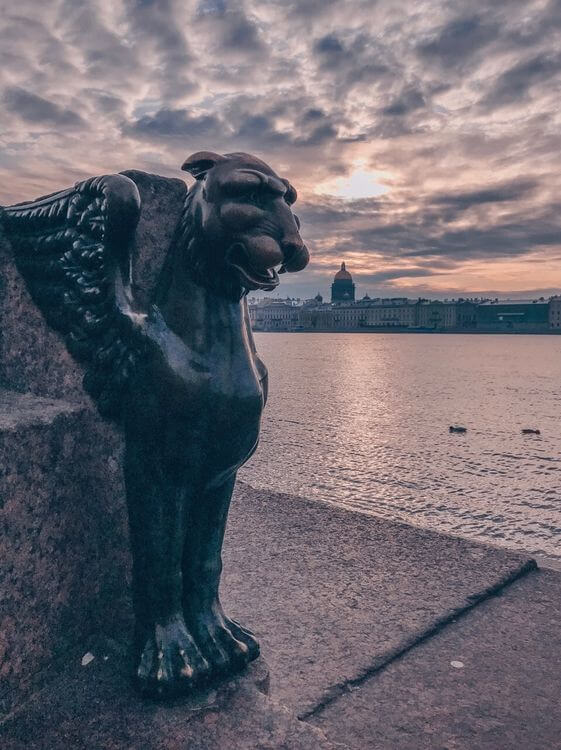
In the afternoon, head along to the Alexander Garden to see the Monuments and the Bronze Horseman; a monument to Peter the Great) next to the Admiralty building. From there take a subway ride (Admiralteyskaya station) and go see the impressive Narva Triumphal Arch. Definitely one of the most underrated attractions in St Petersburg.
This remarkable roman arch is made of bricks and covered with copper sheets for the facades. There are four columns on the front side, two on each side of the arch, chariot on the top and the two statues of ancient Russian warriors. The square around the arch is a lively spot in a summer evening too.
Saint Petersburg 3-day itinerary – Day 3
While St Petersburg is a perfectly walkable city, the main streets can get quite crowded in high-season. However, there is always an escape to one of the royal suburbs.
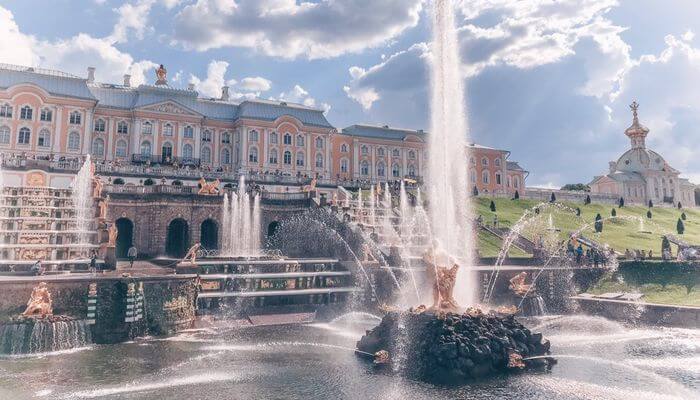
Spend the third day of your 3 days in St. Petersburg taking day trips to Peterhof and/or Pushkin.
Peterhof has many intricate fountains, the highlight being the Samson Fountain with the lion. The sculpture celebrates the Russian victories, especially the victory over Sweden, whose coat-of-arms contains the figure of a lion. Peterhof Park and gardens are a vast area behind the palace where you can spend a few hours to escape the crowds.
Should you choose, I recommend heading to Peterhof in summer. The former royal residence of Peterhof sits some 30 minutes by hydrofoil from the Hermitage Embankment. Peterhof consists of a series of palaces, gardens and the Grand Cascade that makes the city an extremely popular destination in summer. If you are here during the summer, check out the palace’s many fountains. Remember, the fountains are only operational from May to September and aren’t functioning during winter. Peterhof is most quickly accessible via minibus from a St. Petersburg suburb, but most easily accessible via direct train from Baltiysky railway station.
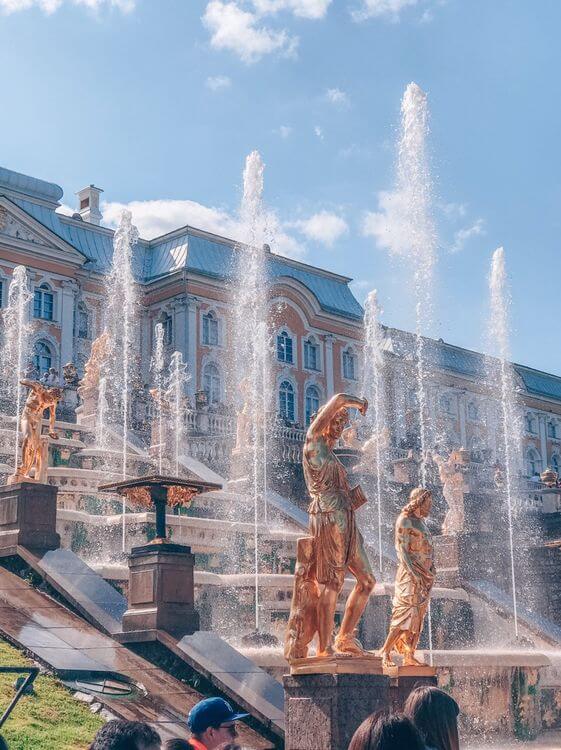
Alternatively, sightseers and culture seekers can visit Pushkin – home to a Catherine Palace and the famous Amber Room. I actually visited both Pushkin and Peterhof and it’s nearly impossible to choose between these two amazing places. Keep in mind, during the public holidays both cities can be quite packed with locals. So you may want to visit the Catherine Palace in autumn or winter when it’s much less crowded.
Where to Stay in Saint Petersburg
You’ll be spoiled for choice among Saint Petersburg accommodation options. The city offers everything from luxurious hotels with their own rooftop bars to more affordable budget hotels that put you within 25 minutes of Moskovskaya railway station. No matter what your budget, you’ll be able to find the perfect St Petersburg hostel within easy reach of downtown. Check Railway Capsules . If you’re looking for someplace a bit nicer, I can personally recommend the WYNWOOD Hotel .
The Bottom Line
You did it! You made it to the end of my itinerary for 3 days in Saint Petersburg, Russia! Hopefully, you’ve discovered some of the best attractions in Saint Petersburg and have maybe even learned about some unique things to do in Saint Petersburg too!
I also hope that you now feel comfortable enough to plan the perfect weekend itinerary in Saint Petersburg. So if you’re ready to begin planning your trip to Saint Petersburg, Russia, then pin this now and read it again later!
How many of these attractions would be on your Saint Petersburg itinerary? If you’ve visited Saint Petersburg, what were your favorite spots in Saint Petersburg? If you have any questions about the itinerary or visiting Saint Petersburg, just ask them in the comments below and as always I’m happy to help!
PIN IT FOR LATER!
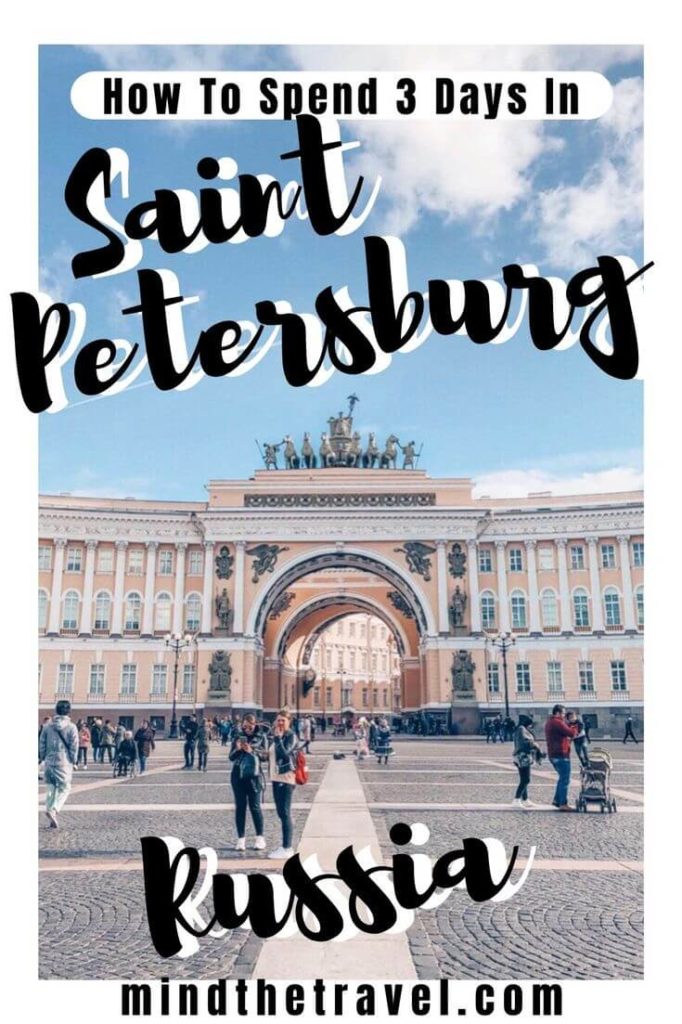
YOU WILL ALSO LIKE:
STOP PROCRASTINATING YOUR DREAM VOYAGE!

8 REASONS WHY TRAVELLING MAKES YOU A BETTER PERSON
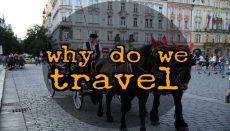
WHY DO WE TRAVEL
I’ve always wanted to travel to Russia. This looks amazing! Your photos are beautiful.
MindTheTravel
Thank you, Sarah! I agree this country should be visited at least once in a lifetime!
Thank you for sharing. I never dreamt about going to St. Petersburg. May change my mind after reading your blog post and seeing your pictures though 😀
Thank you for sharing.We would be in Sankt Petersburg in July 2020,for sure we would use the Guide.Thanks again.
Once this covid crisis is over, I can’t wait to get there — am looking forward to the suggested itinerary!
Save my name, email, and website in this browser for the next time I comment.

- Privacy Overview
- Strictly Necessary Cookies
My website uses cookies so that I can provide you with the best user experience possible. Cookie information is stored in your browser and performs functions such as recognising you when you return to my website and helping me to understand which sections of Mind The Travel you find most interesting and useful.
You can adjust all of your cookie settings by navigating the tabs on the left hand side.
Strictly Necessary Cookie should be enabled at all times so that I can save your preferences for cookie settings.
If you disable this cookie, I will not be able to save your preferences. This means that every time you visit my website you will need to enable or disable cookies again.

IMAGES
VIDEO
COMMENTS
1. There is a time for coffee. 2. You drink your espresso standing. 3. Only go to restaurants that display menus in Italian. I was born in Italy, and although I now consider myself a citizen of the world, I think Italy is one of the most beautiful countries you will ever visit.
Train Travel is Popular. Train travel is one of the best ways to travel around Italy and one of my top travel tips for Italy is to utilize the system. The train networks are extensive and fairly affordable. Fast trains cost between €30 - €70, while regional slow trains can cost €6 - €30 depending on the distance traveled.
If you are planning a road trip, make sure to book your car well in advance. 4. Card payments are now widely accepted, but carrying some cash is a good idea. For a long time, Italy has been a cash-first country. But in 2022, a new law introduced a fine for businesses not accepting card payments.
8. Money-saving tips. While it's normal to make a tourist faux pas or two (especially on your first trip), here are some things you should avoid: Tipping at restaurants if it's already included on your bill (many spots add in a 10% service charge). Heavily tipping taxi drivers (rounding up to the nearest euro is normal).
5. Don't try to do everything in one trip! You've heard the saying, " Roma, non basta una vita " or "Rome, a lifetime's not enough.". It's true for Rome, and Rome's just one part of Italy! While it's tempting to try to do everything in one trip, it won't be pleasant. You can always come back.
FCDO travel advice for Italy. Includes safety and security, insurance, entry requirements and legal differences.
1.2.1 Hire A Car. 1.2.2 Travel Italy by Train. 1.2.3 Metro, Bus + Other Public Transport in Cities. 1.3 Public WiFi Availability in Italy. 1.4 Riposo (the Italian Siesta) 2 Top Travel Tips for Italy: The Fun Stuff. 2.1 Where are the best places to visit in Italy. 2.2 How To Plan Your Budget for your visit to Italy.
Best Italy travel tips. Do build in time for R&R. Don't annoy the locals. Do get off the beaten path. Don't fall into tourist traps. Do be aware of your belongings at all times. Don't expect Italy to work like places do back home. Do dress appropriately, even if you're not planning on visiting a church.
You've come to the right place. This is our ultimate guide to Italy, a resource compiling all of our recommendations and tips, whether Rome, Florence, Venice, Milan, Tuscany, Lake Como, the Amalfi ...
29. Make reservations. For popular restaurants, this is a must. Many restaurants in Italy are small and have a limited number of tables, and unlike in North America, many don't set aside a section for walk-ins. So, if there's a particular restaurant you had your heart set on, booking in advance is key.
Some favorite and famous Italian wines are: Prosecco - a light sparkling white wine from the Veneto region. Chianti - red wine made from 80% sangiovese grapes from Tuscany. Barolo - Italy's most expensive red wine from the Piedmont region. Pinot grigio - a crisp white wine from Lombardy.
One of my travel tips for Italy is to opt for a ski retreat if you are visiting in the winter. My favorite place is Val di Sole, in Trentino. Excellent slopes for all levels and good-quality snow make it a great place to ski, but if you are not in the mood for skiing, there are plenty of other things to do.
Bell'Italia! Italy has Europe's richest, craziest culture. After all, this nation is the cradle of European civilization — established by the Roman Empire and carried on by the Roman Catholic Church. As you explore Italy, you'll stand face-to-face with some of the world's most iconic images from this 2,000-year history: Rome's ancient Colosseum and playful Trevi Fountain, Pisa's Leaning ...
For more tips, don't miss my guide on the best time to travel to Italy. Don't expect air conditioning everywhere. Double-check that your hotel or car rental has air conditioning, as this is not standard and usually it's not available unless specified. When there is air-conditioning, expect it to be weak.
Your ultimate Italy travel guide, with tips, ideas on things to do, and best things to see in Italy. Great for first-time and returning travelers. Located in southern Europe, Italy is a Mediterranean country bordered by three seas (Adriatic, Tyrrhenian, and Ionian). Known as the birthplace of Western culture, Italy is a stunning country ...
Here's a vague schedule to keep in mind: Breakfast of coffee and pastry at the bar when you wake up (pretty flexible, the bars will stay open through the day, though the best pastries can go early-ish). Lunch is between 12-3. Aperitivo is between 5-7. Restaurants open for dinner at 7:30-occasionally 7.
Read the country information page for additional information on travel to Italy. If you decide to travel to Italy: ... Women Travelers: If you are a woman traveling abroad, please review our travel tips for Women Travelers. Health For emergency services in Italy, dial 112. Ambulance services are widely available, but training and availability ...
Read more: 20 Best Things To Do In Italy. 4.) Prepare to eat late. Many restaurants, especially the fancy ones, don't open until 7pm or later. 5.) When browsing menus and deciding where to eat, pay attention to the "Il coperto" (cover charge) The cover charge varies from restaurant to restaurant (usually a few Euros).
40 Best Italy Travel Tips. Story by Susan Moore • 5mo. T here were a few things that surprised me during my first solo trip to Italy. For instance, train strikes are common in Italy. Also, the ...
Untold Italy founder Katy Clarke shares invaluable advice on navigating the Euro, using debit and credit cards, and managing cash in Italy. From the benefits of the Wise card to the quirks of local tipping customs, Katy covers it all to ensure your travels are smooth and stress-free.
More Italy travel guides Puglia travel guides. Driving in Puglia, Italy: essential tips for a road trip; Renting a car in Puglia: what you need to know; Renting a car in Bari: Useful tips; Most beautiful coastal towns in Puglia, Italy; Airports in Puglia: how to reach Puglia by air; Where to stay in Puglia as a base; 2 weeks in Puglia itinerary
There are three main types of trains run by Italy's state-run train operator, Trenitalia: Frecce such as the Frecciarossa are the high-speed trains that go up to 300 kilometers per hour and ...
Italy in winter offers a unique and unforgettable experience. From snow-capped mountains to festive celebrations and culinary delights, there's something for everyone to enjoy. So, bundle up, embrace the magic of the season, and discover the hidden gems of this beautiful country.
Hetty Lintell's top tips for Sicily. If Etna is playing ball, land in Catania and head down to the island's Baroque towns in the south-east. Noto is astonishing. Enjoy cocktails on the rooftop of Gagliardi Hotel for the best views of the town's architecture. The gin and tonics are excellent too Dine at Manna — our favourite meal of the trip
A lot of them don't even actually speak Italian much since they only speak Napolitan but knowing some Italian will be useful. I recommend learning the common words such as hello, thank you, please, coffee, water, toilet… Also, locals love it when you try to make an effort even if it's in broken italian. 7. Eat street food
Set in the old Ostiense Railway Station, Eataly's largest outlet offers multiple floors of high-quality Italian specialities and restaurants. Indulge in authentic Italian cuisine with a delicious plate of cacio e pepe pasta, a creamy pasta dish made with cheese and pepper, and a wood-fired pizza. shop the best travel experiences here
OVERALL RISK: MEDIUM. Generally speaking, Saint Petersburg today is safe as much as other countries in Europe, despite its problematic history with criminal activity in the 90s. However, if you're planning on traveling to Saint Petersburg, keep in mind that you should always keep your guard up and remain aware of your surroundings, just in case.
Purple line: Bukharestskaya, Obvodny Kanal, Mezhdunarodnaya, Zvenigorodskaya, Admiralteiskaya (the deepest metro station in Russia and the second deepest in the world, 102m), Sportivnaya. Map of Top 10 most beautiful metro stations in St.Petersburg. 1 - Avtovo; 2 - Kirovsky Zavod; 3 - Pushkinskaya; 4 - Mezhdunarodnaya; 5 ...
3. See Jewelled Eggs at the Faberge Museum. The House of Faberge was founded in St. Petersburg in 1842 by Gustav Faberge. Originally a jeweler, he became famous for designing jewel-encrusted eggs for the Tsars of Russia and is arguably the most famous goldsmith of the modern era.
Saint Petersburg 3-day itinerary - Day 3. While St Petersburg is a perfectly walkable city, the main streets can get quite crowded in high-season. However, there is always an escape to one of the royal suburbs. Spend the third day of your 3 days in St. Petersburg taking day trips to Peterhof and/or Pushkin.